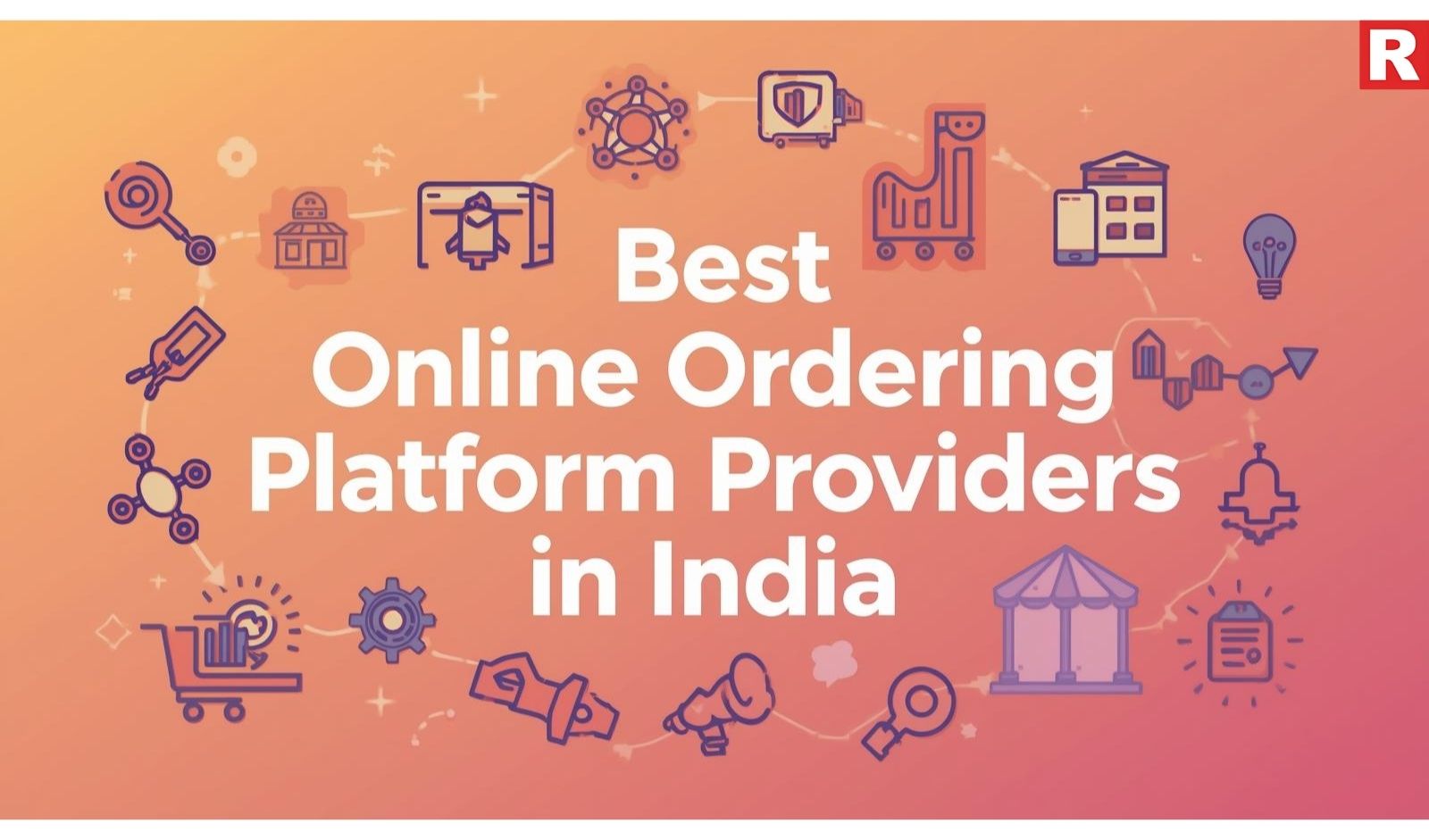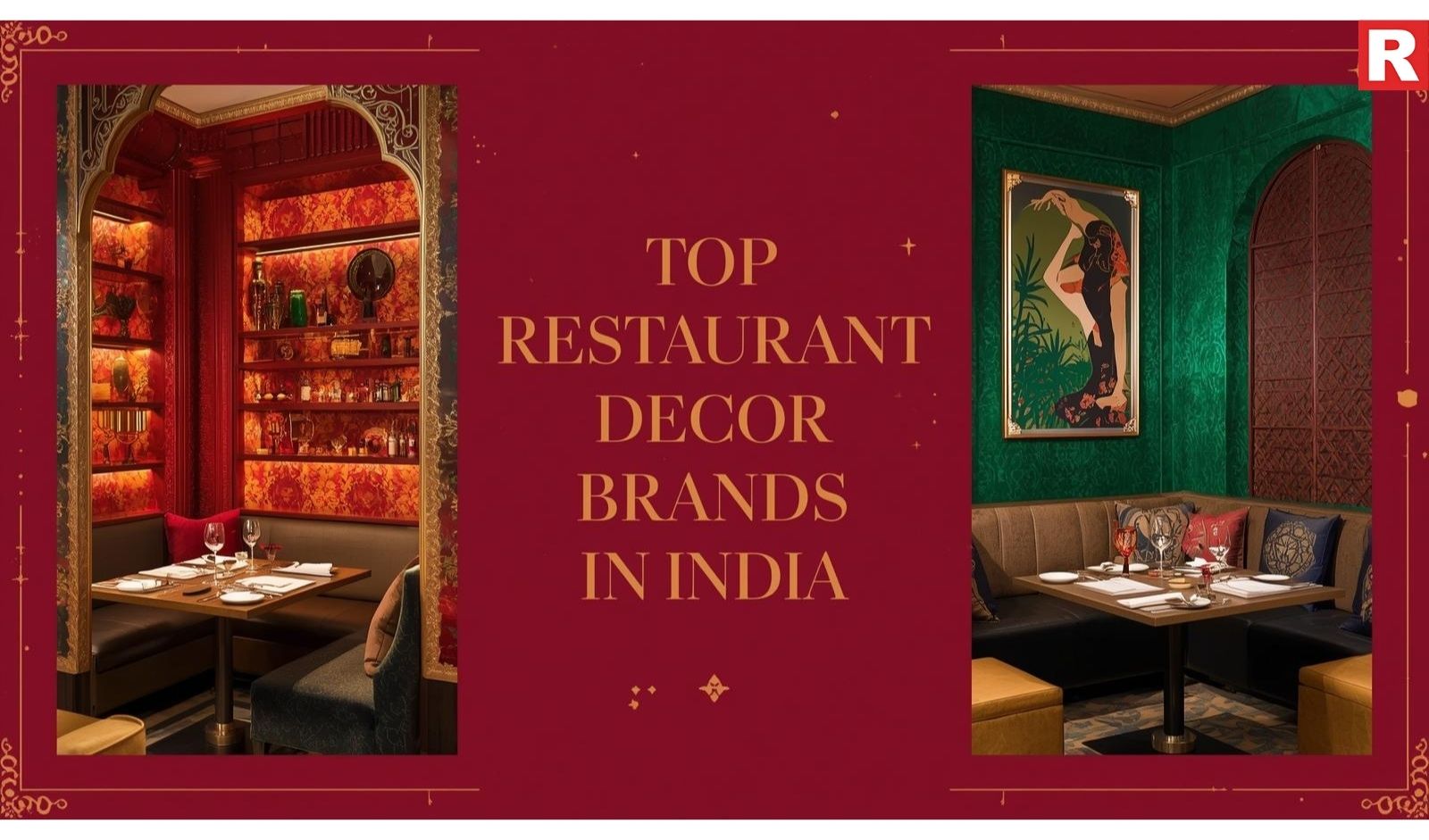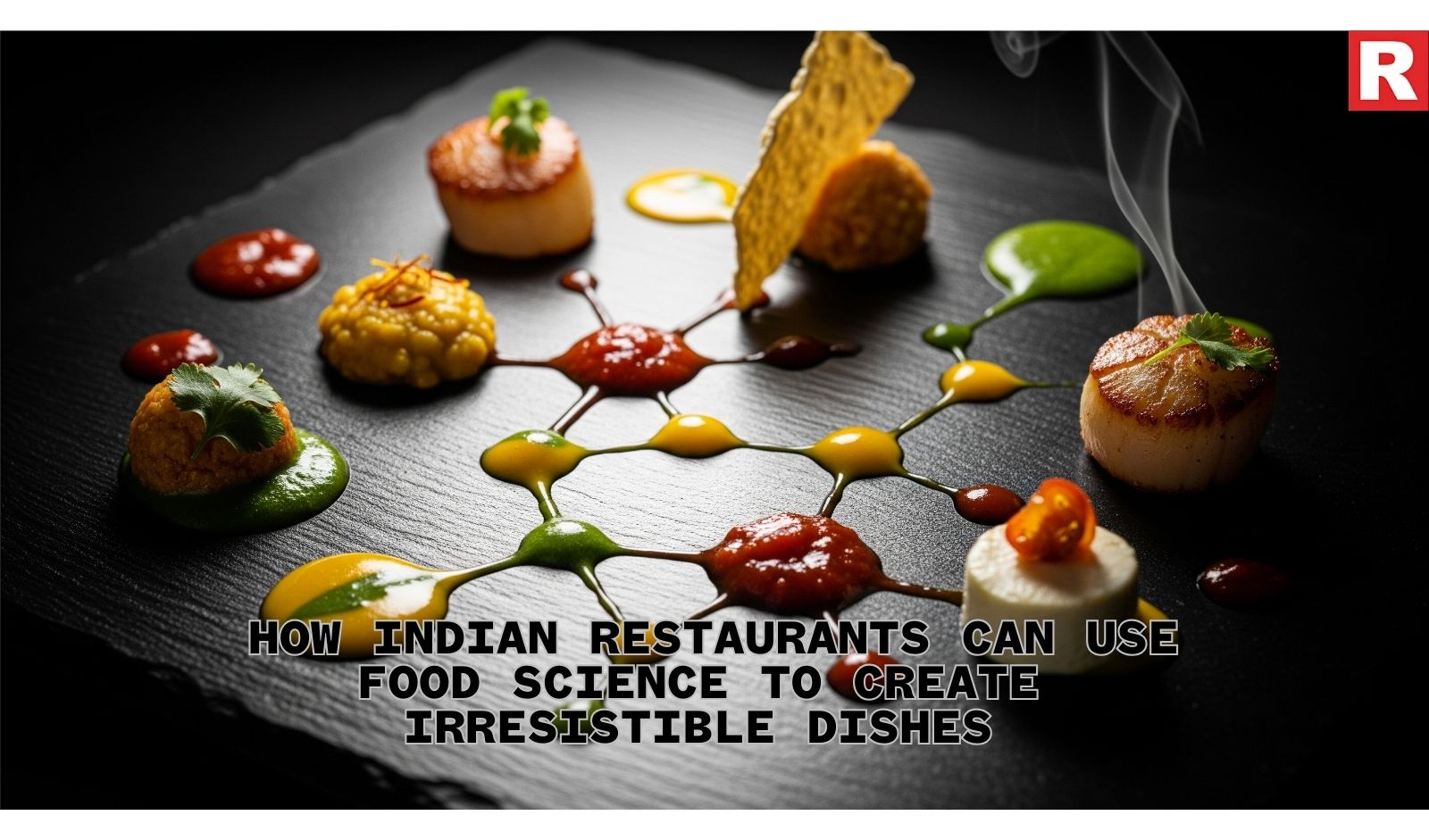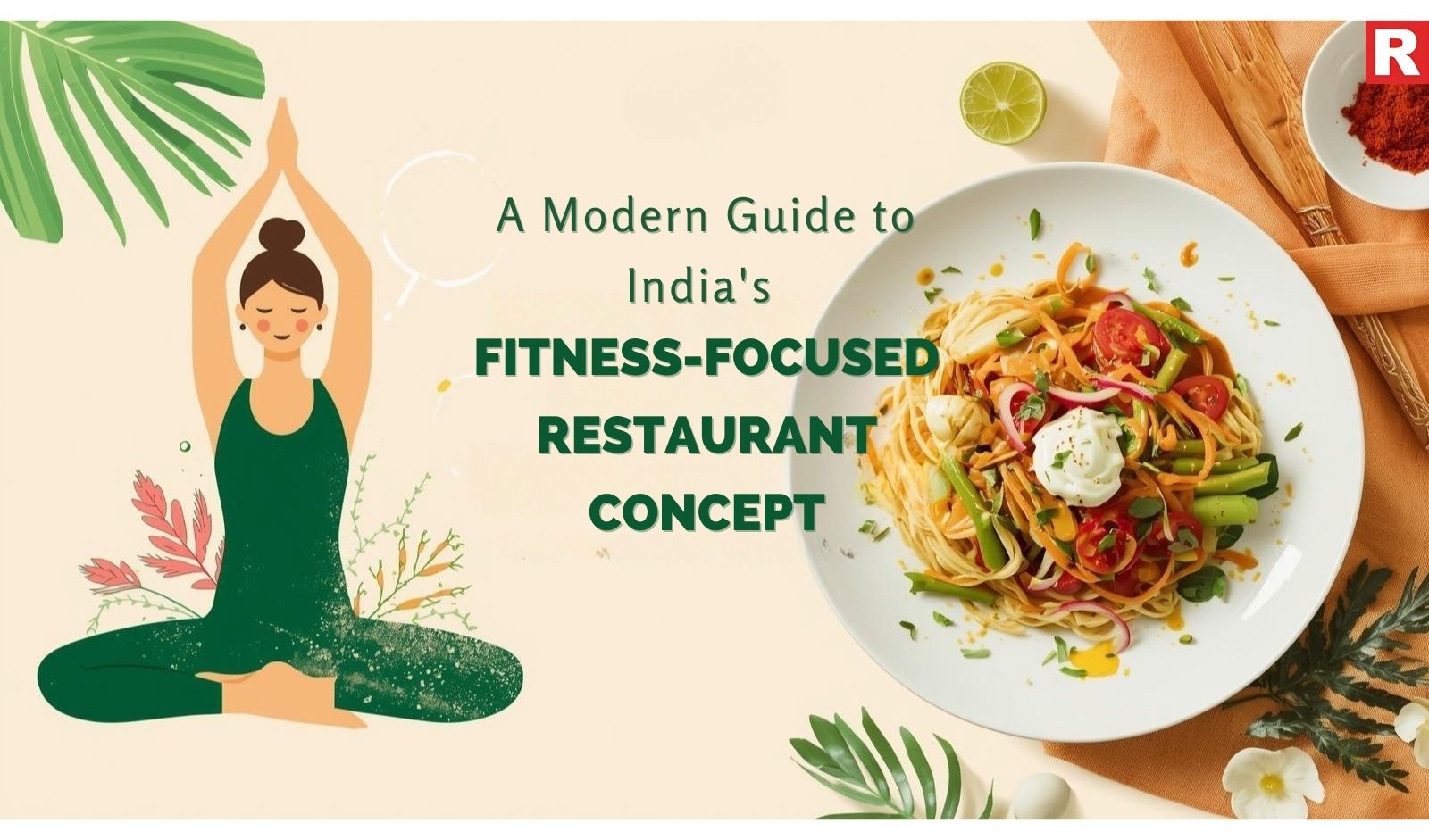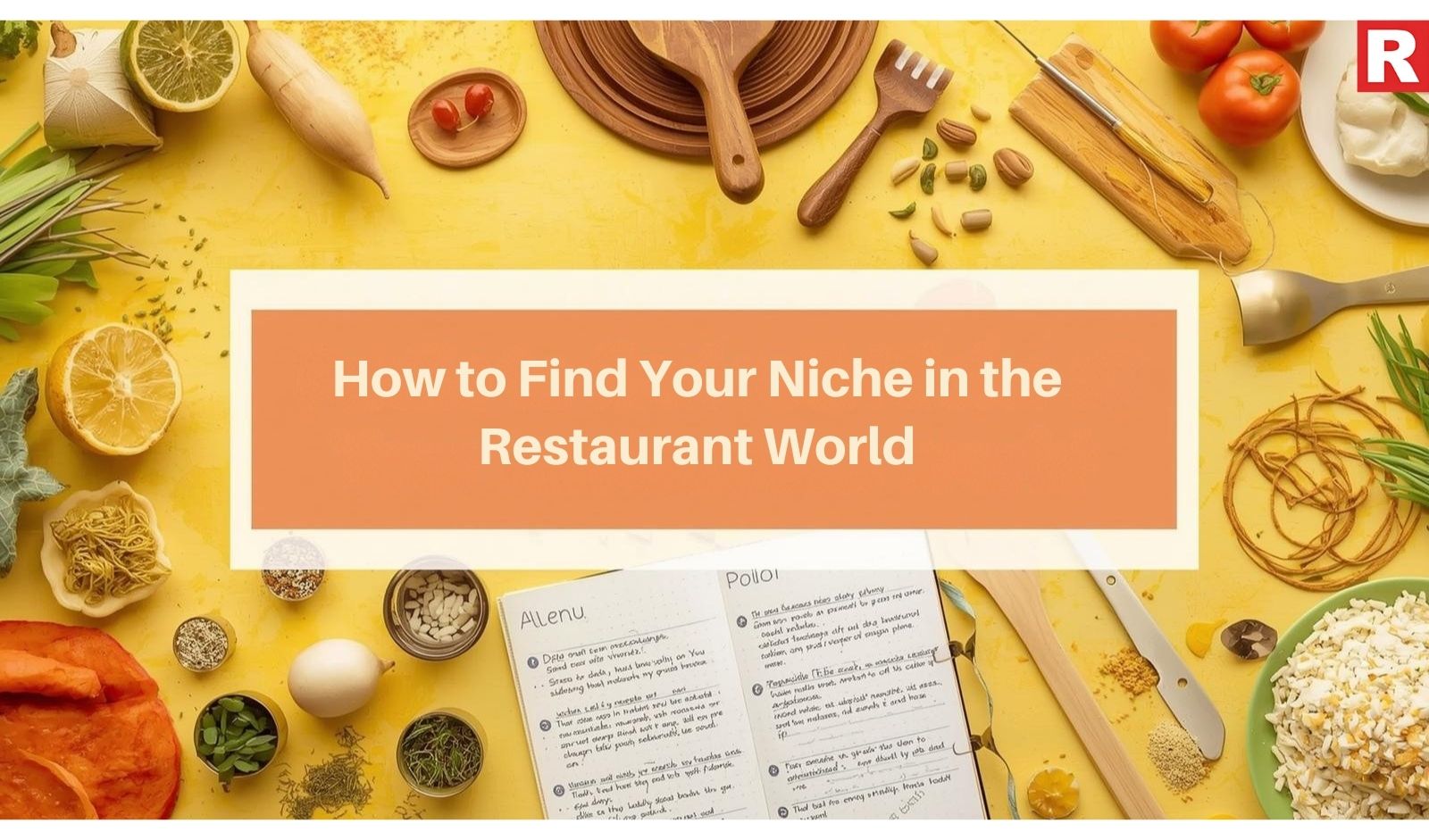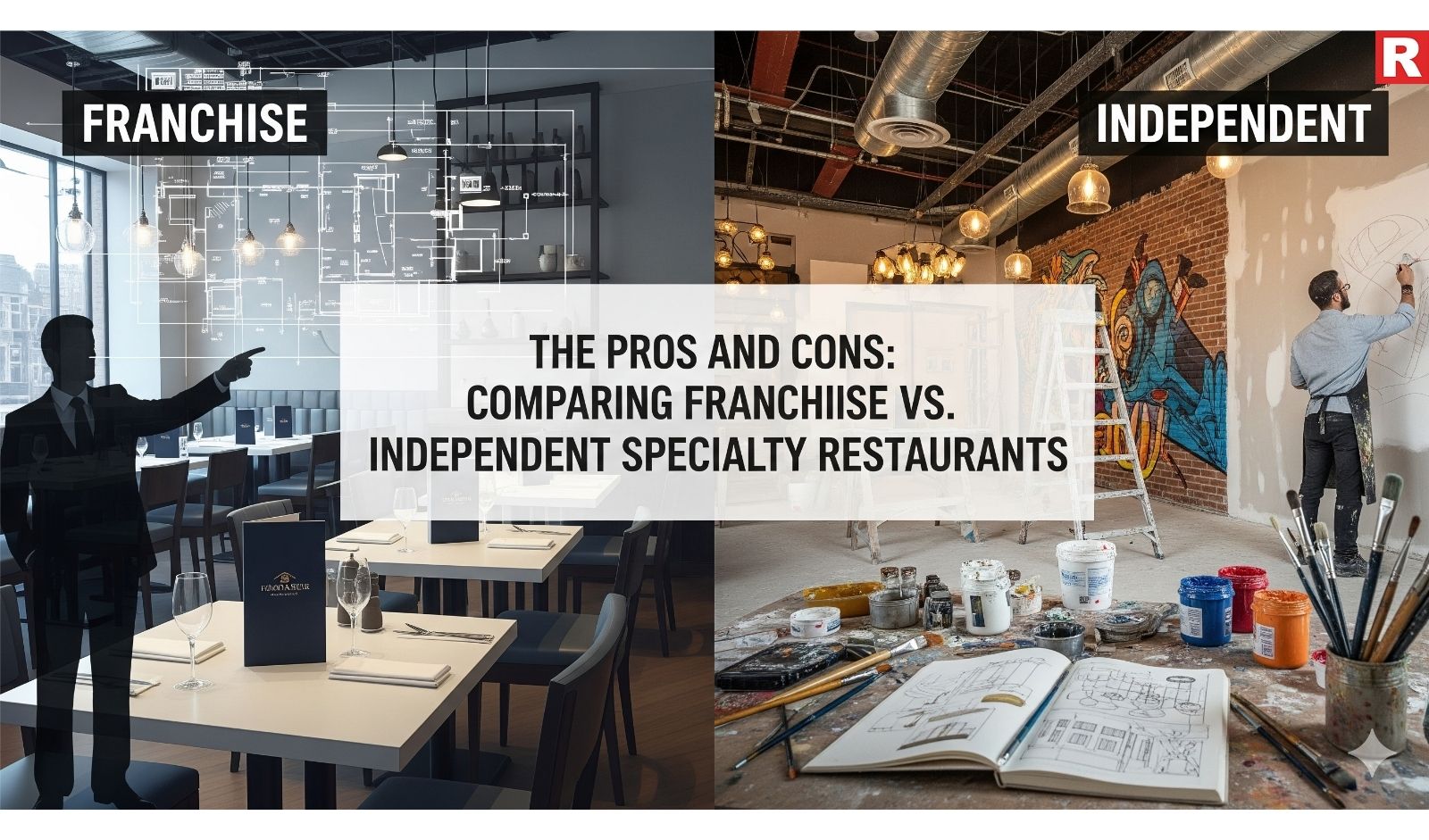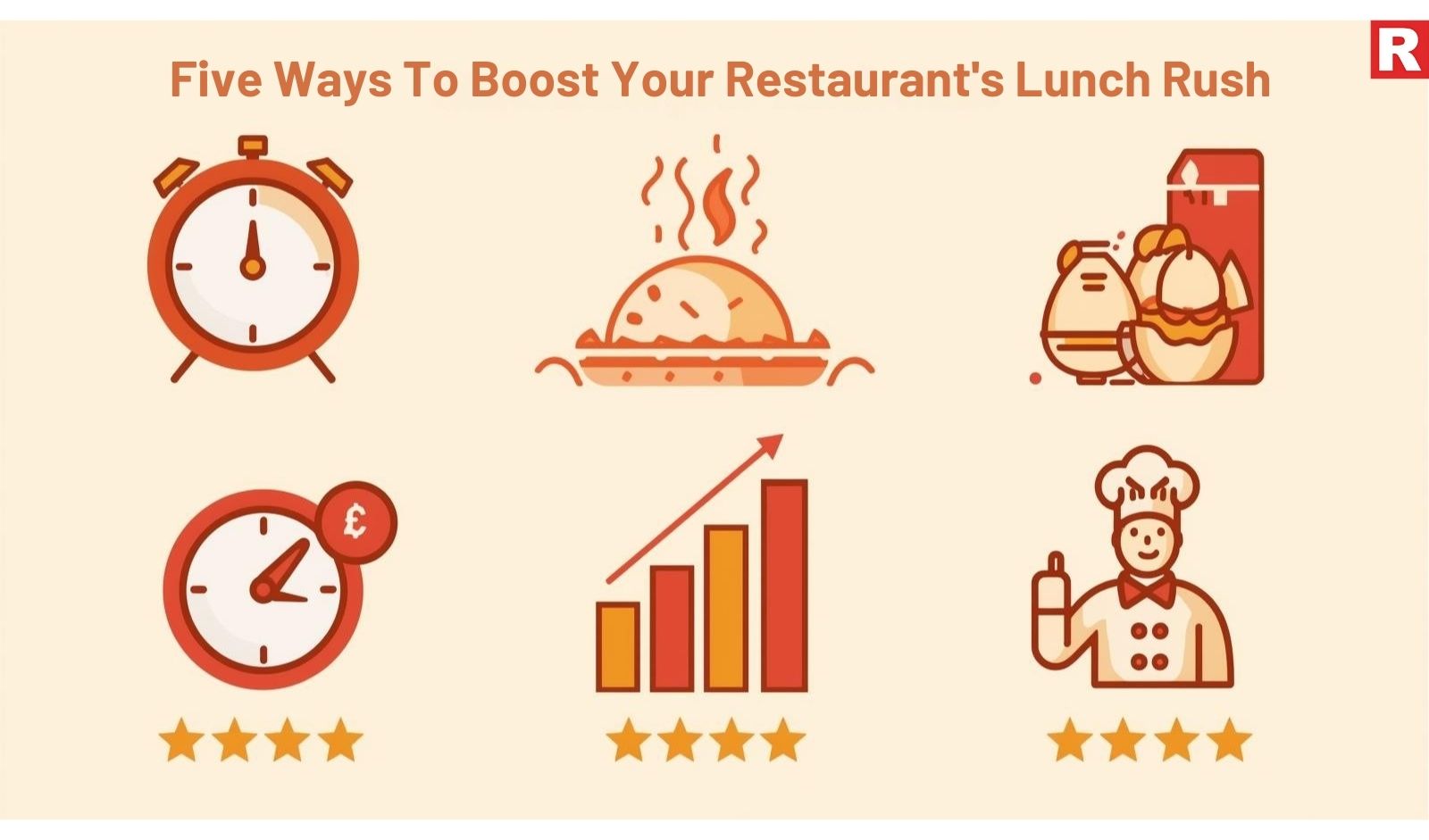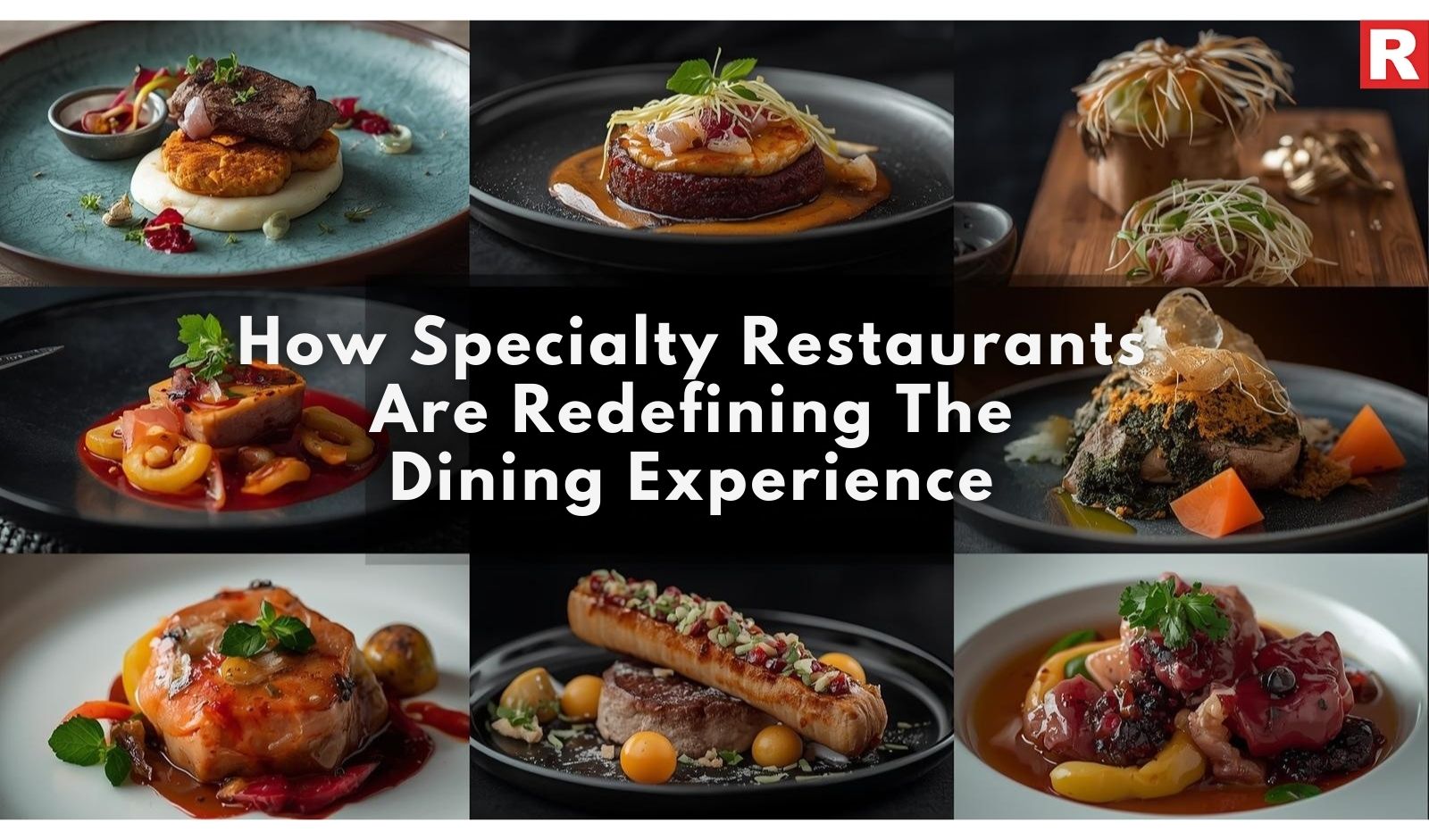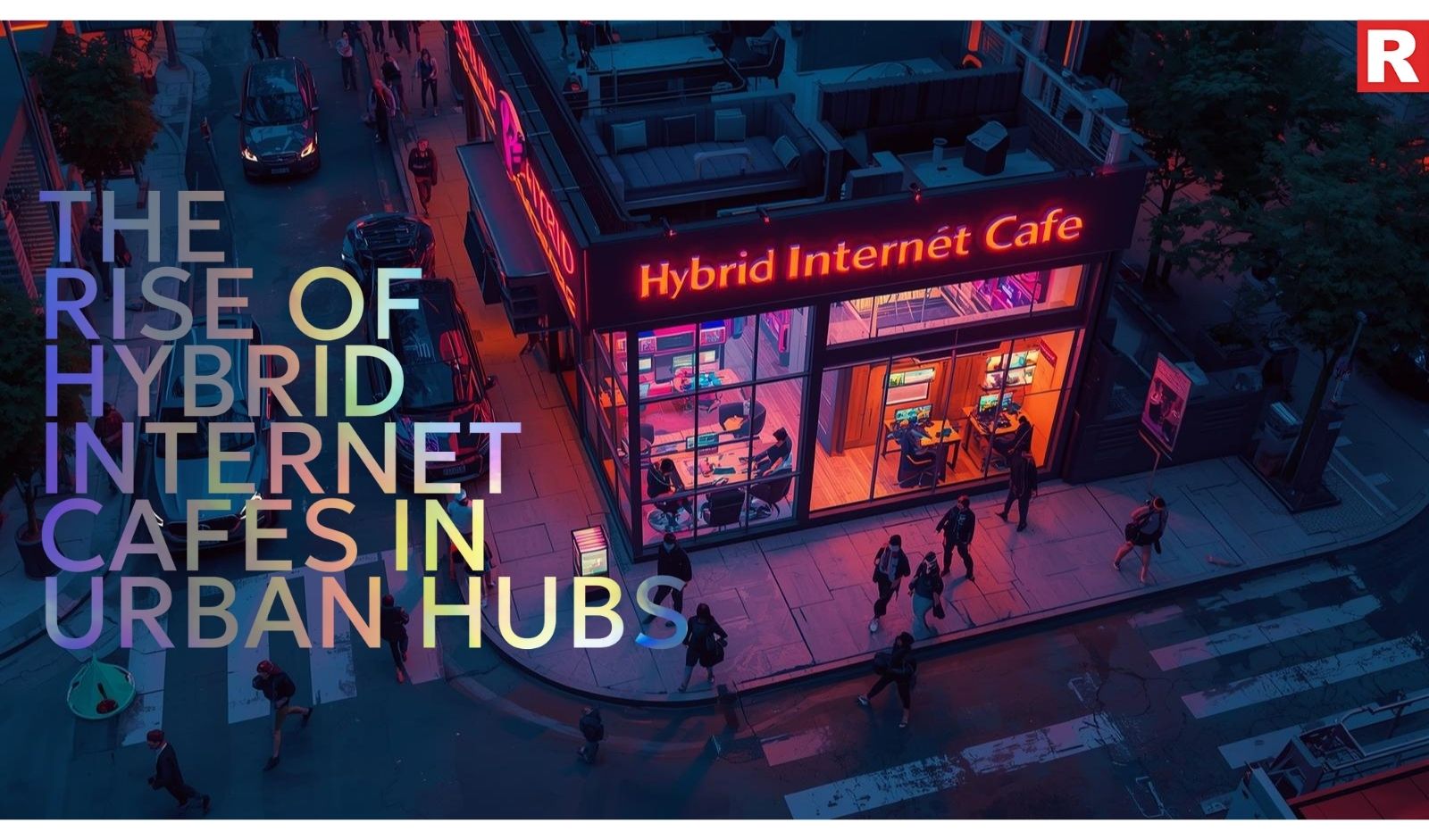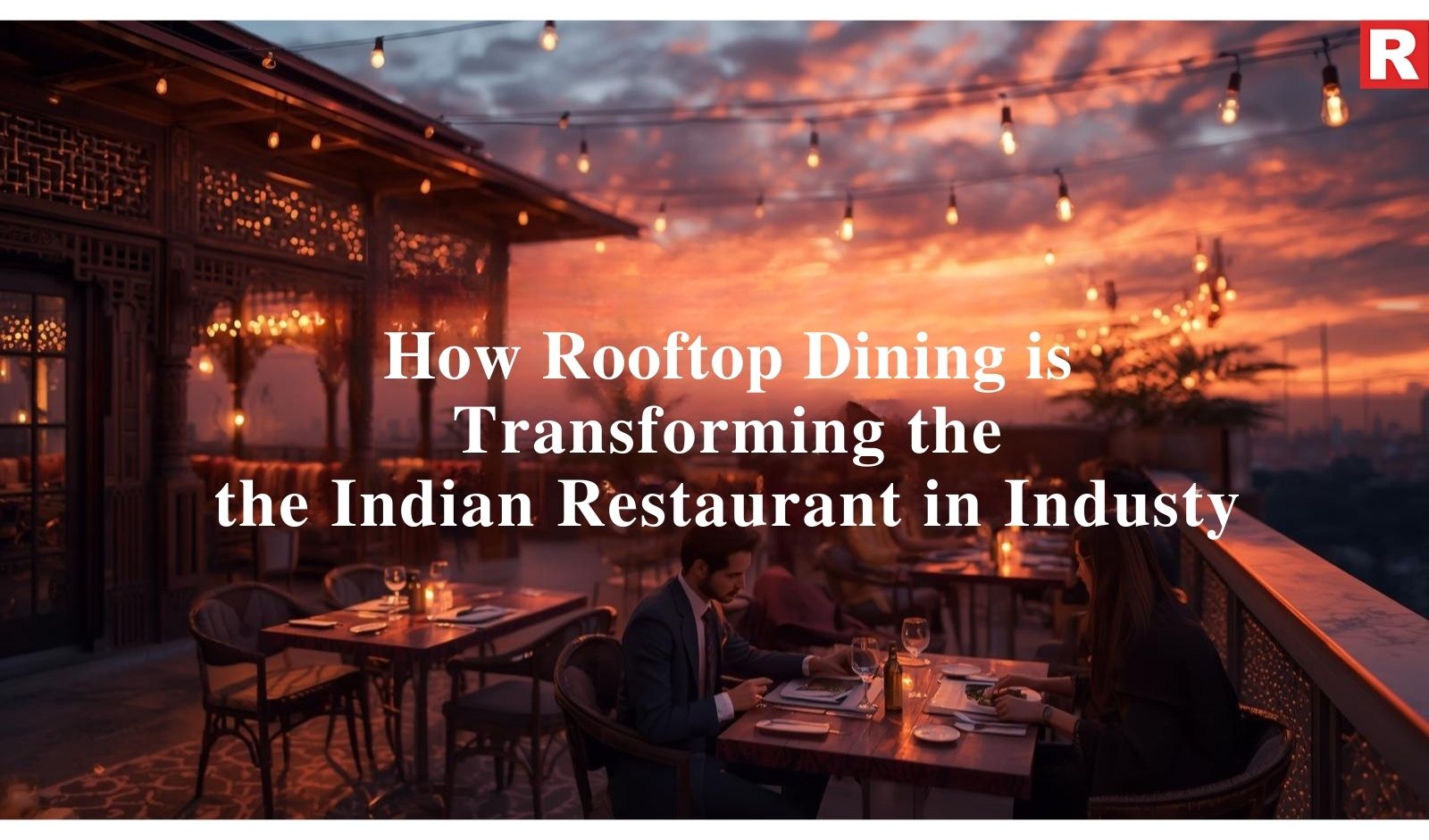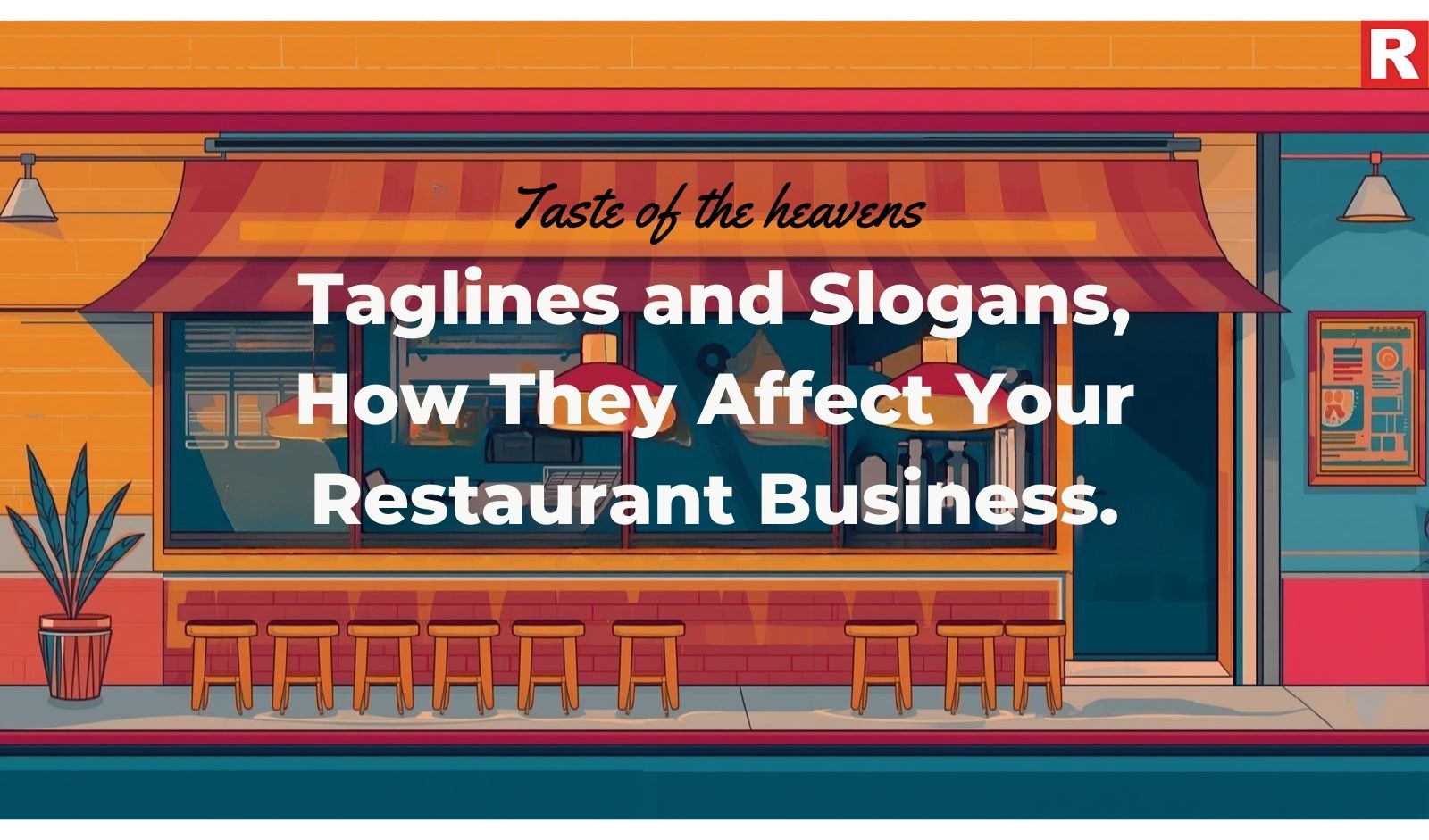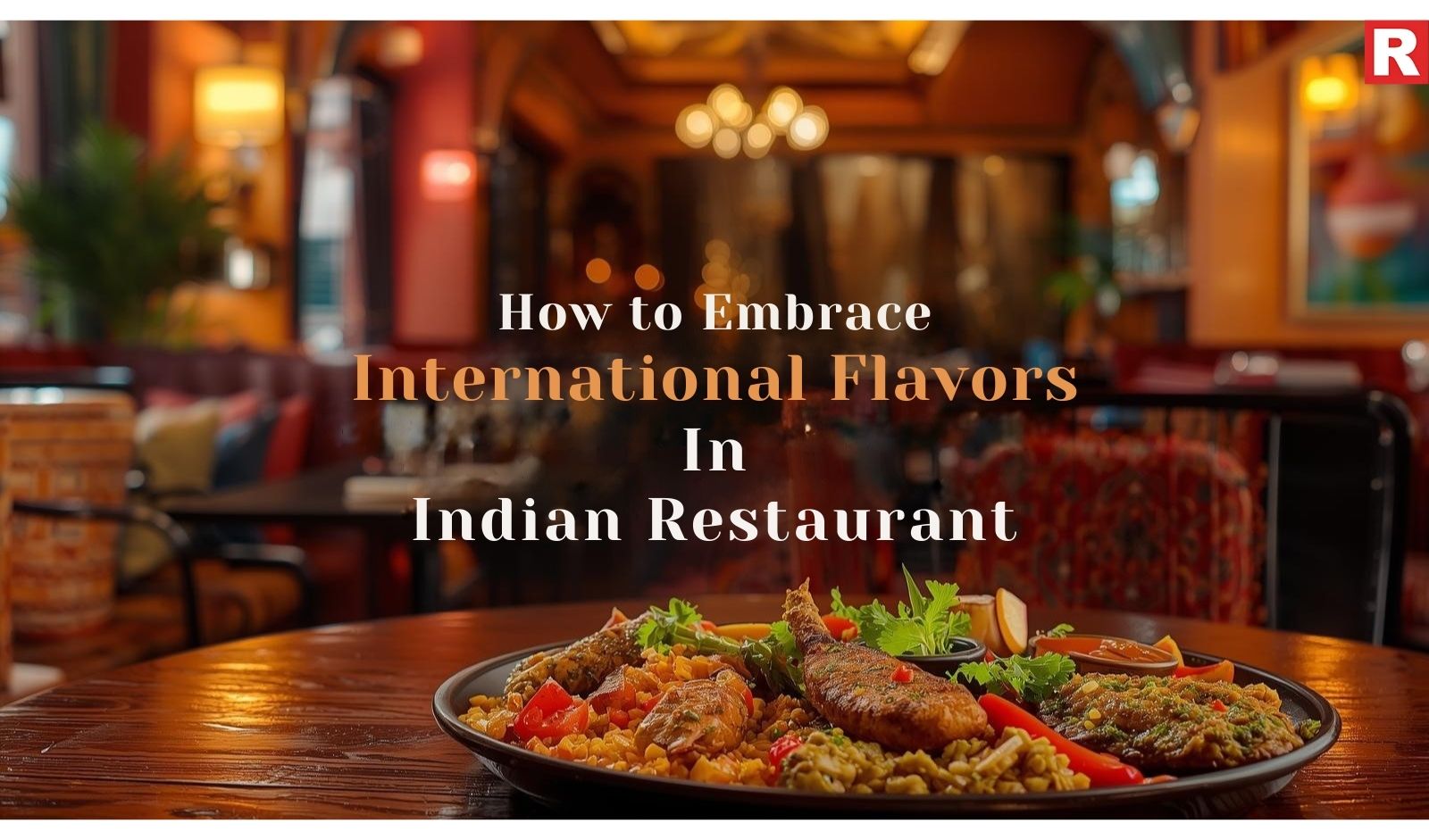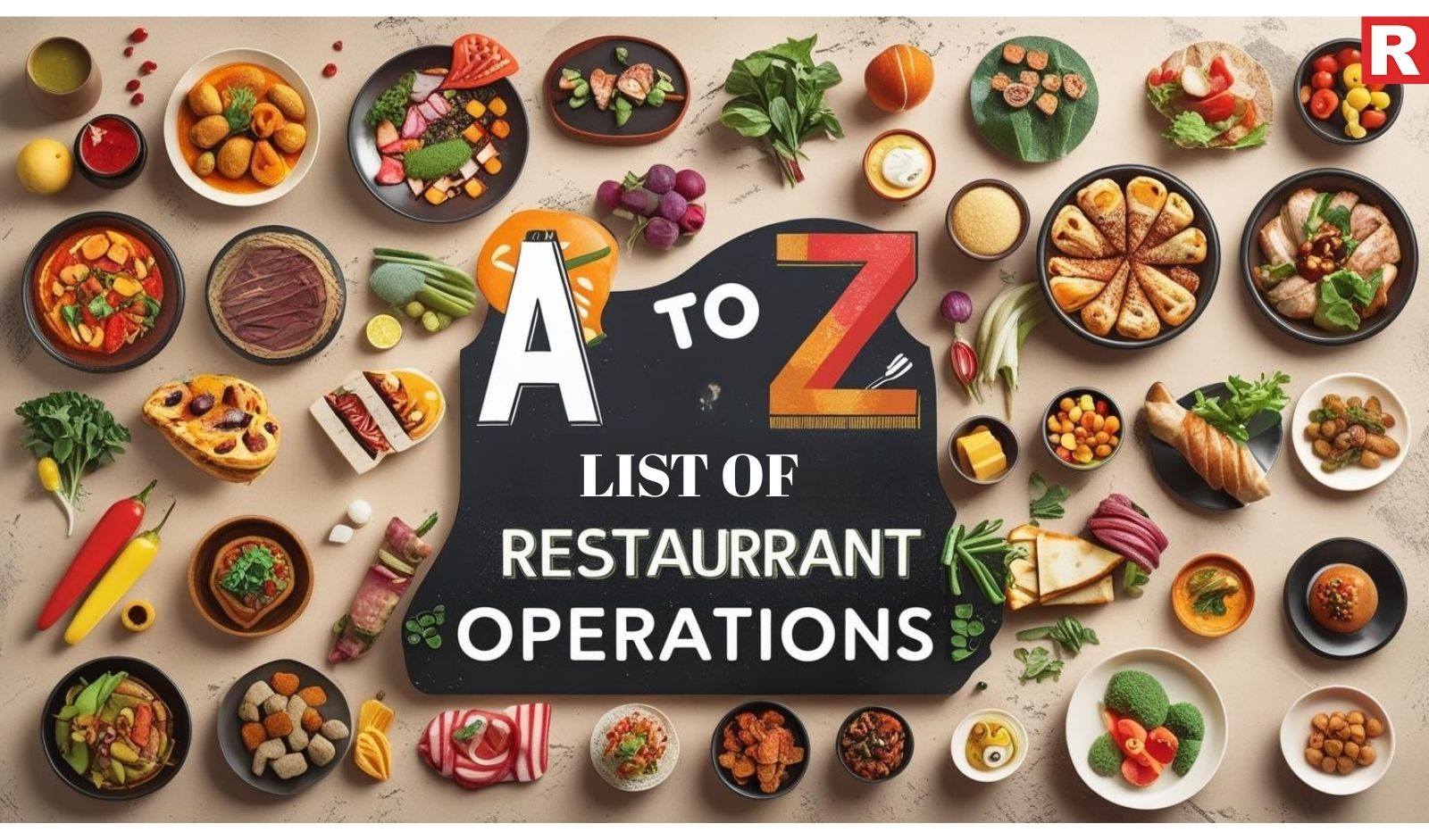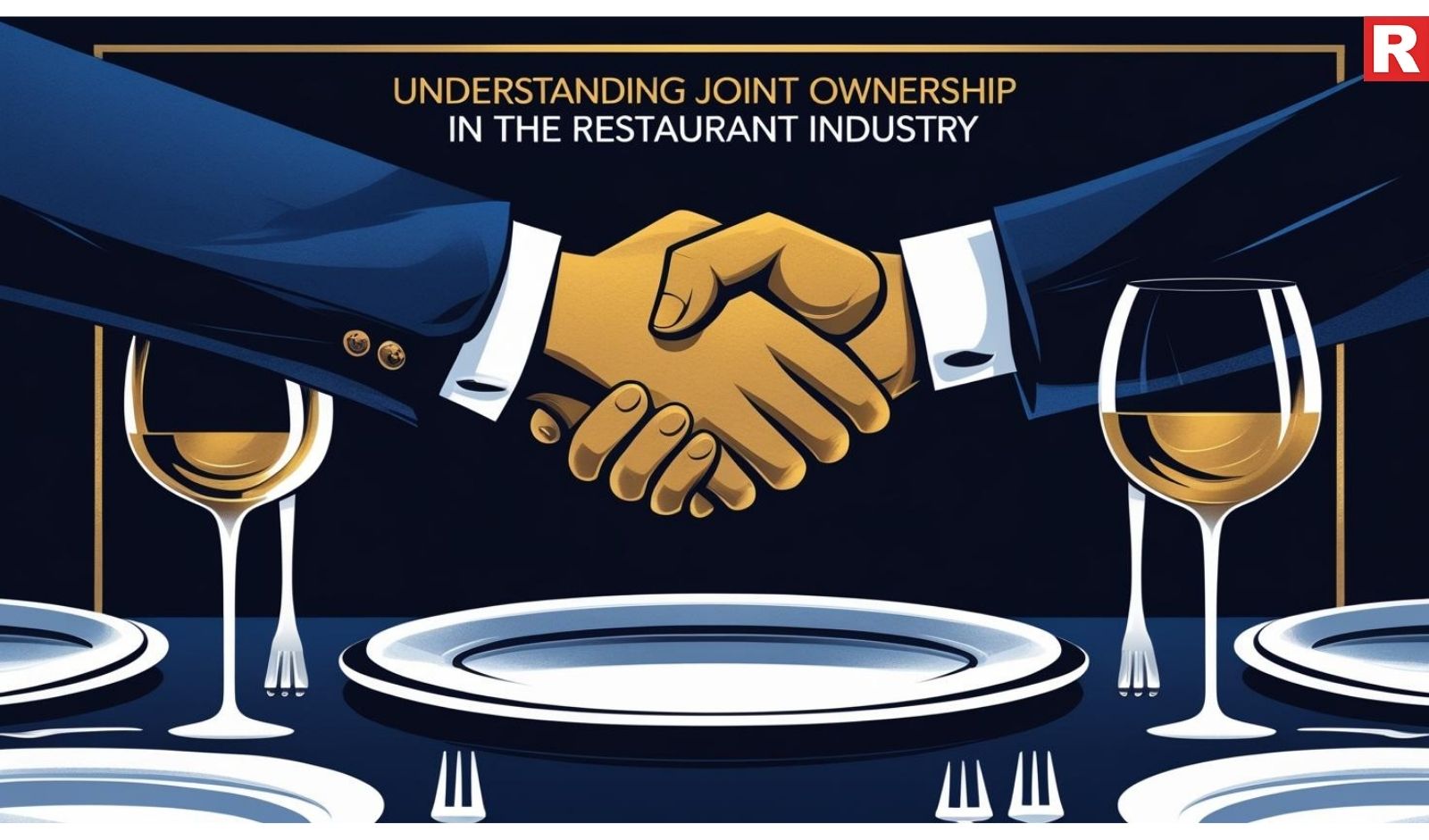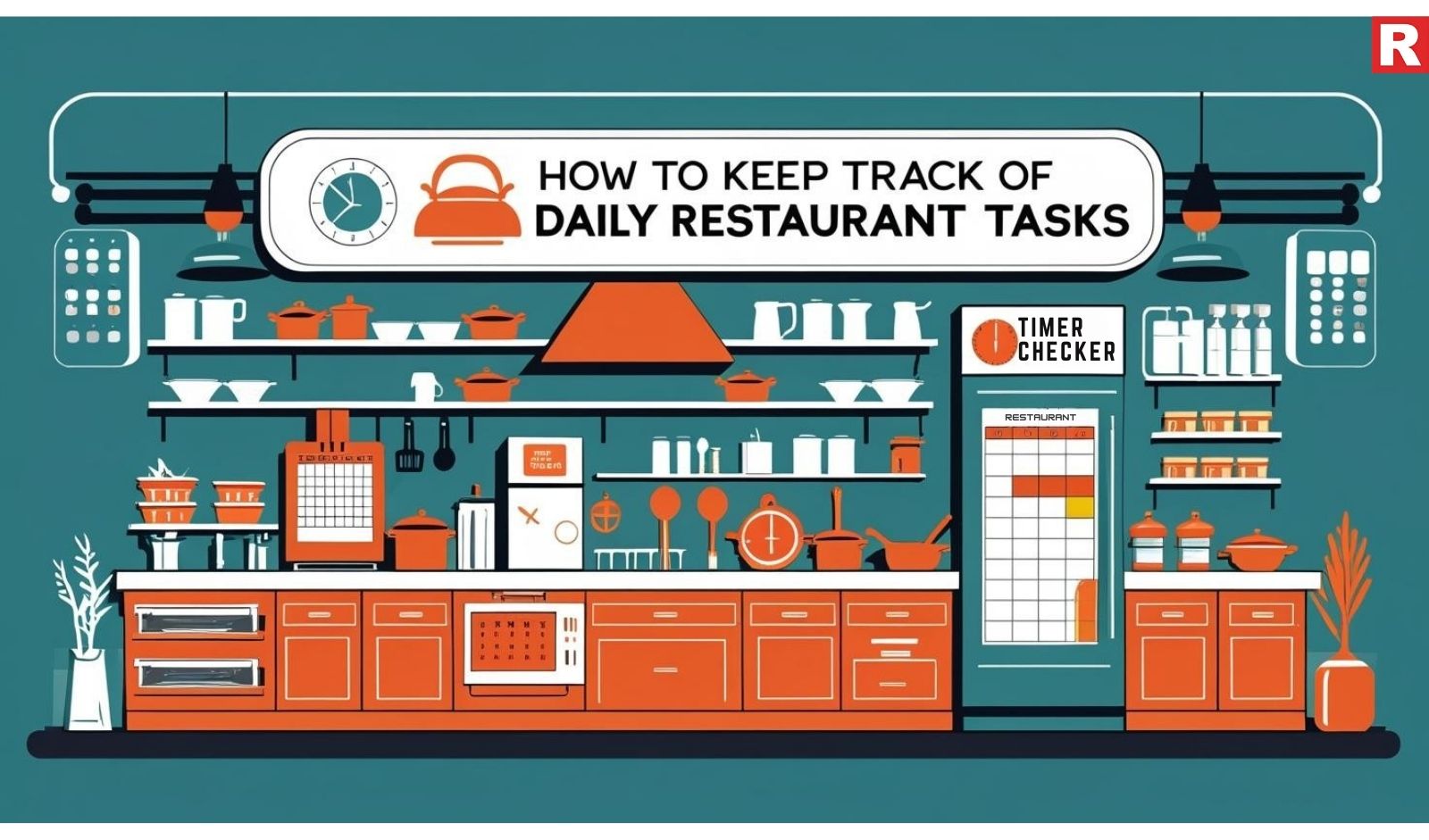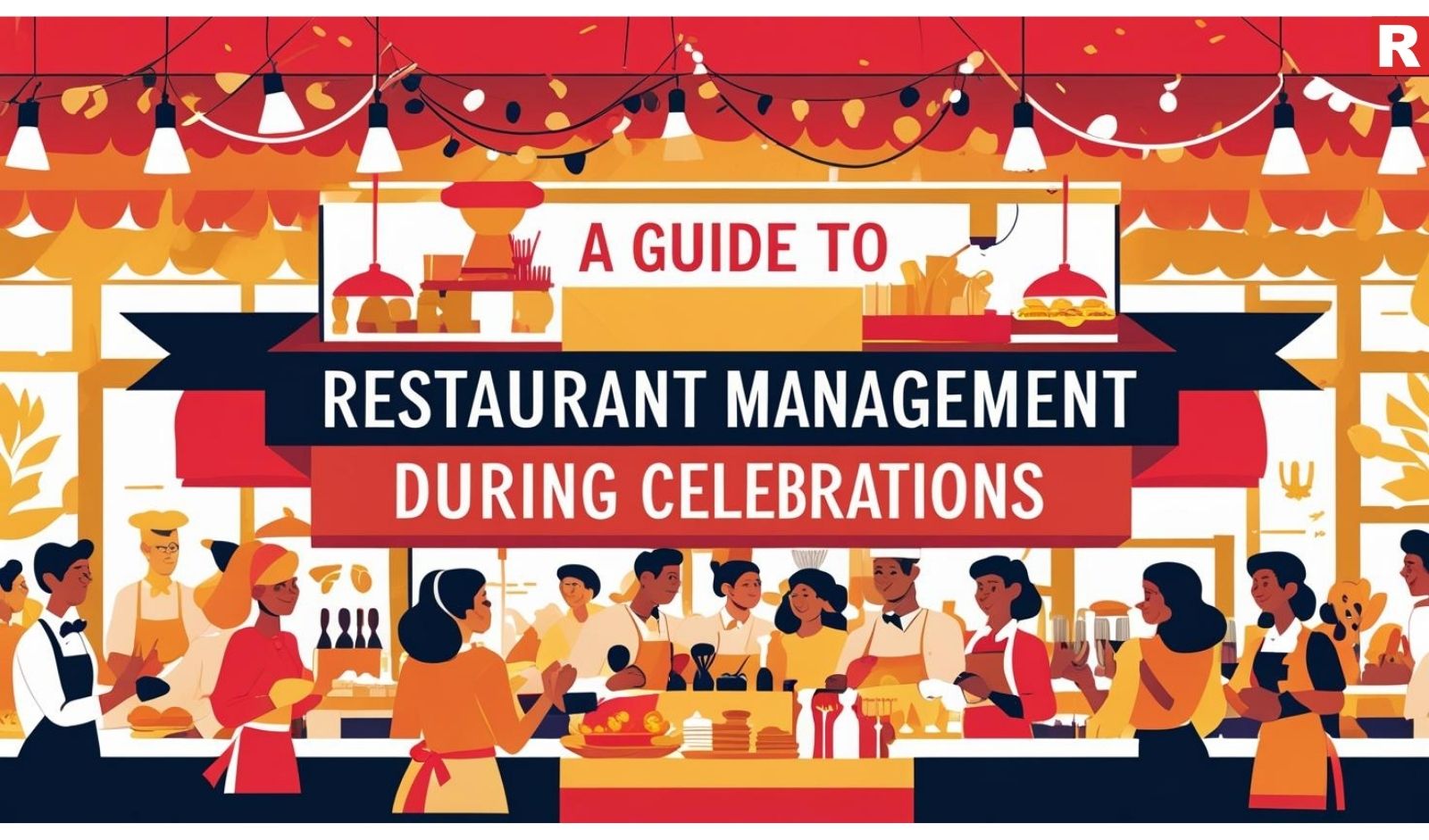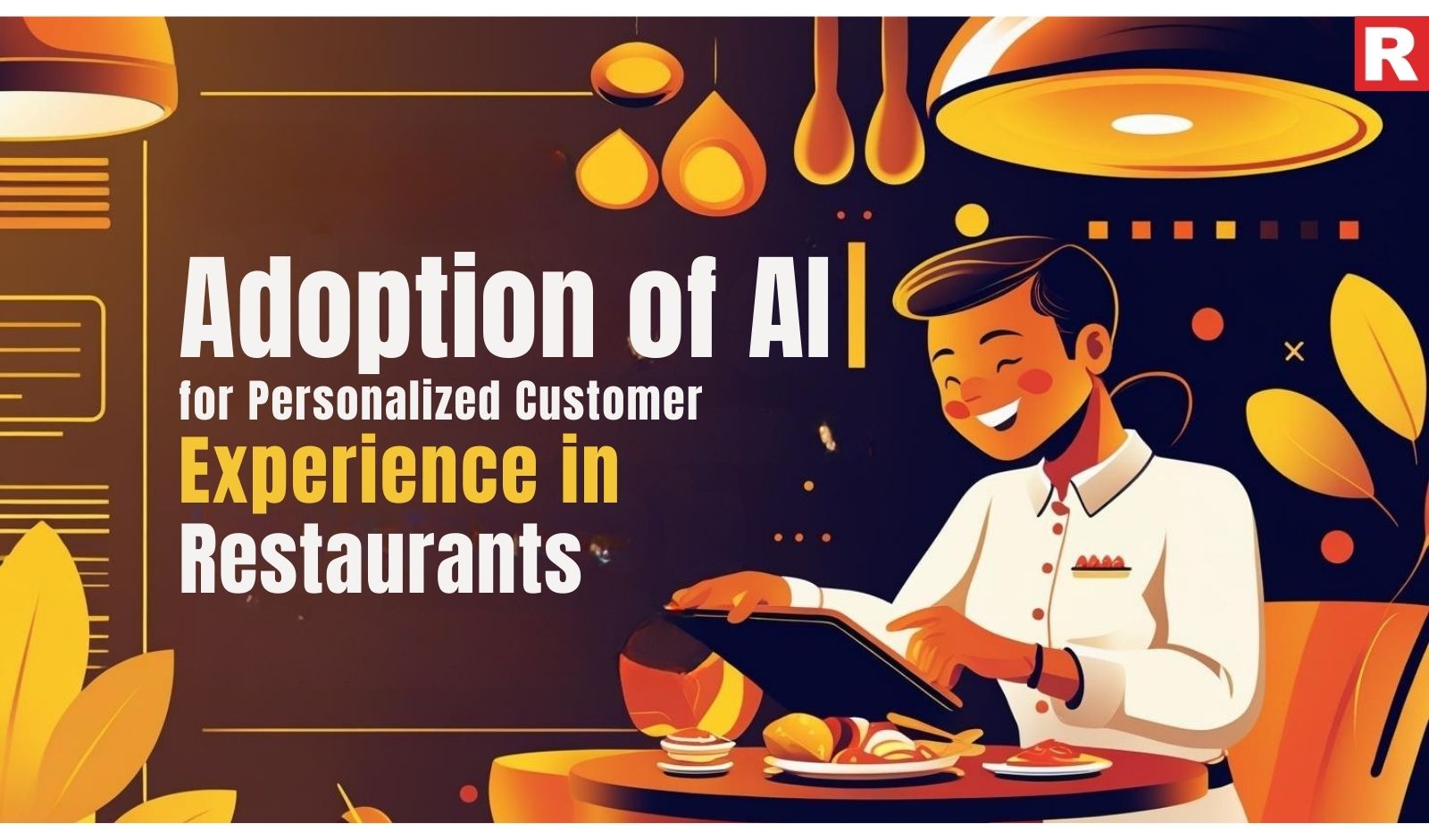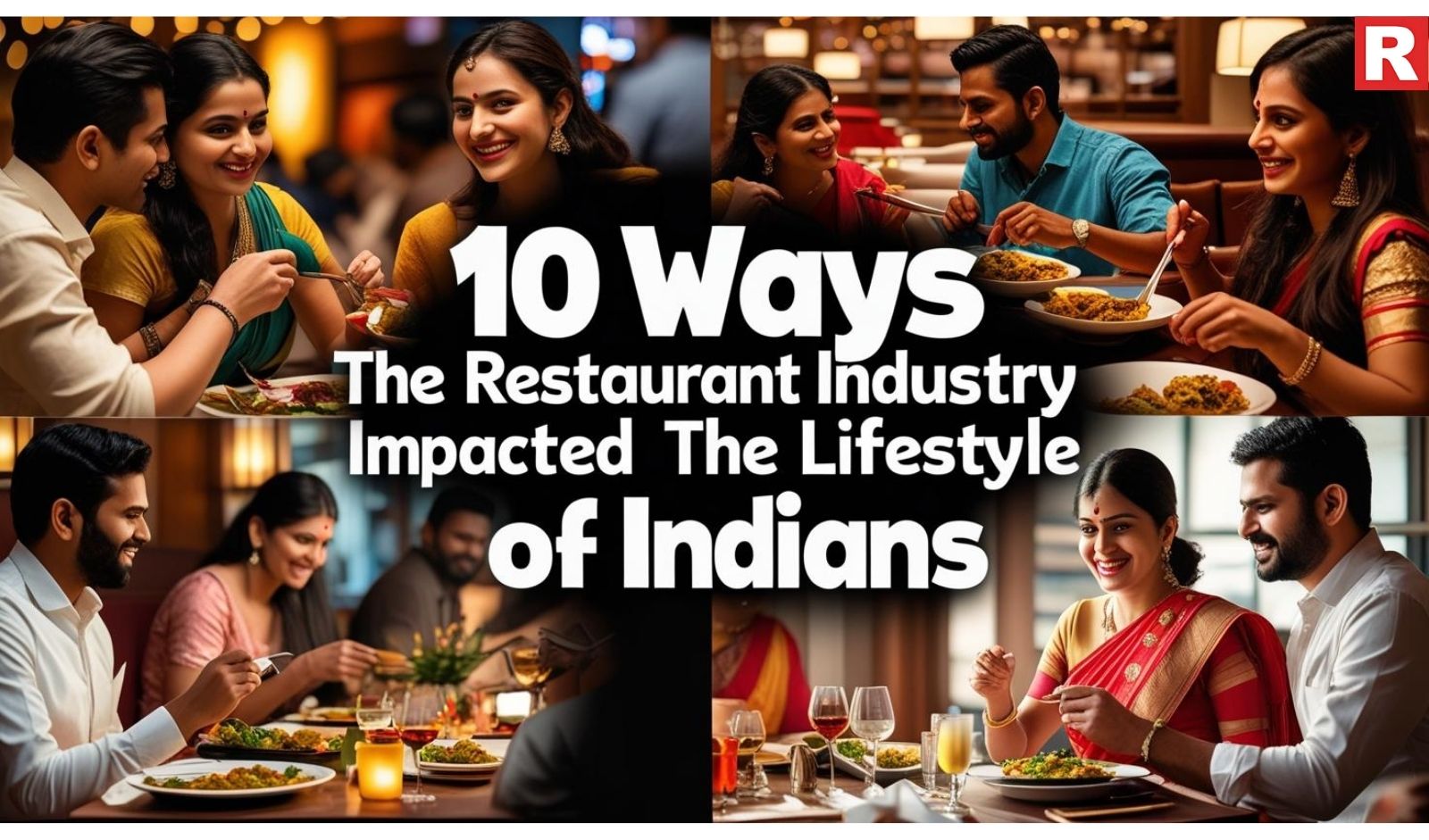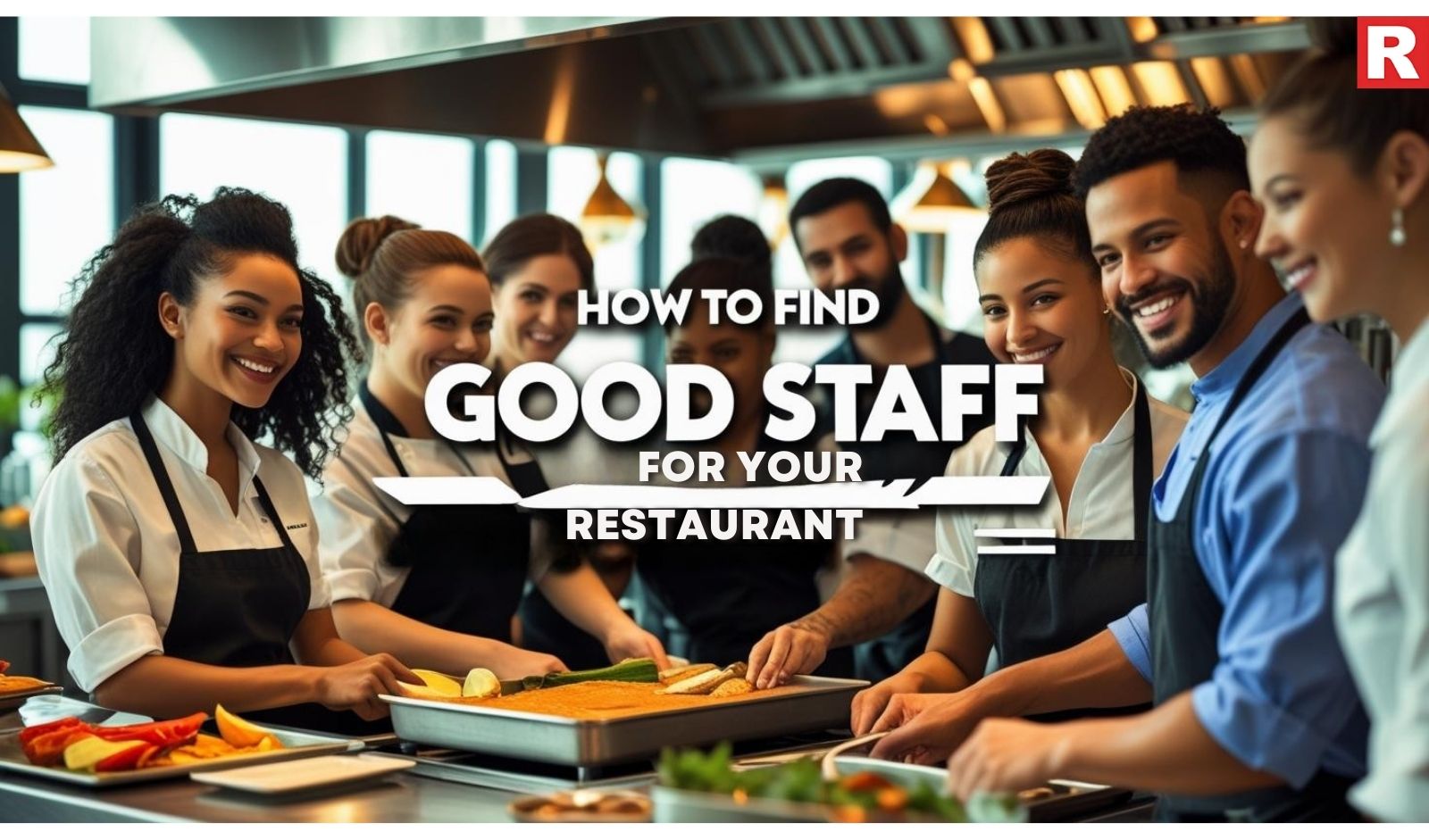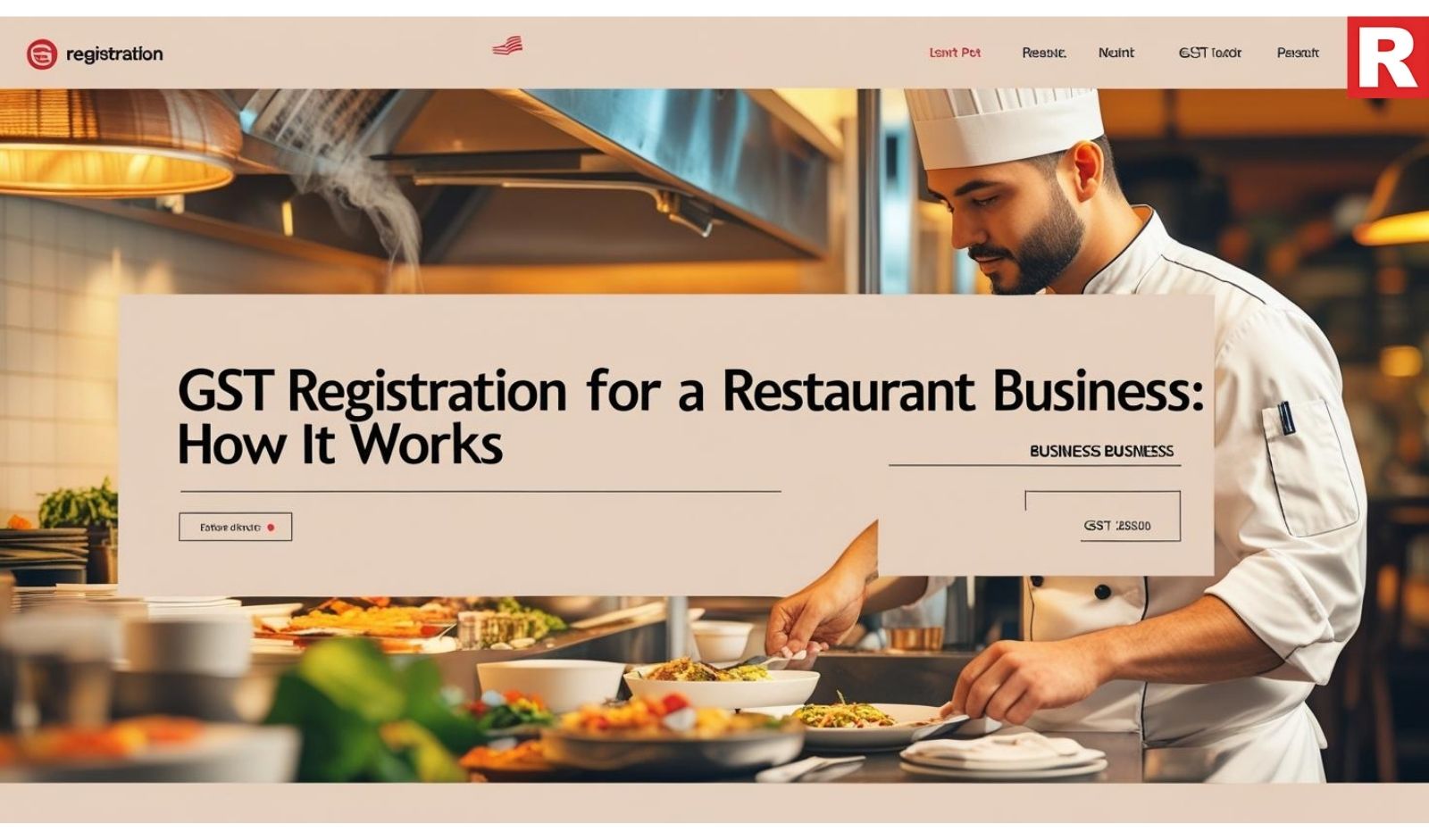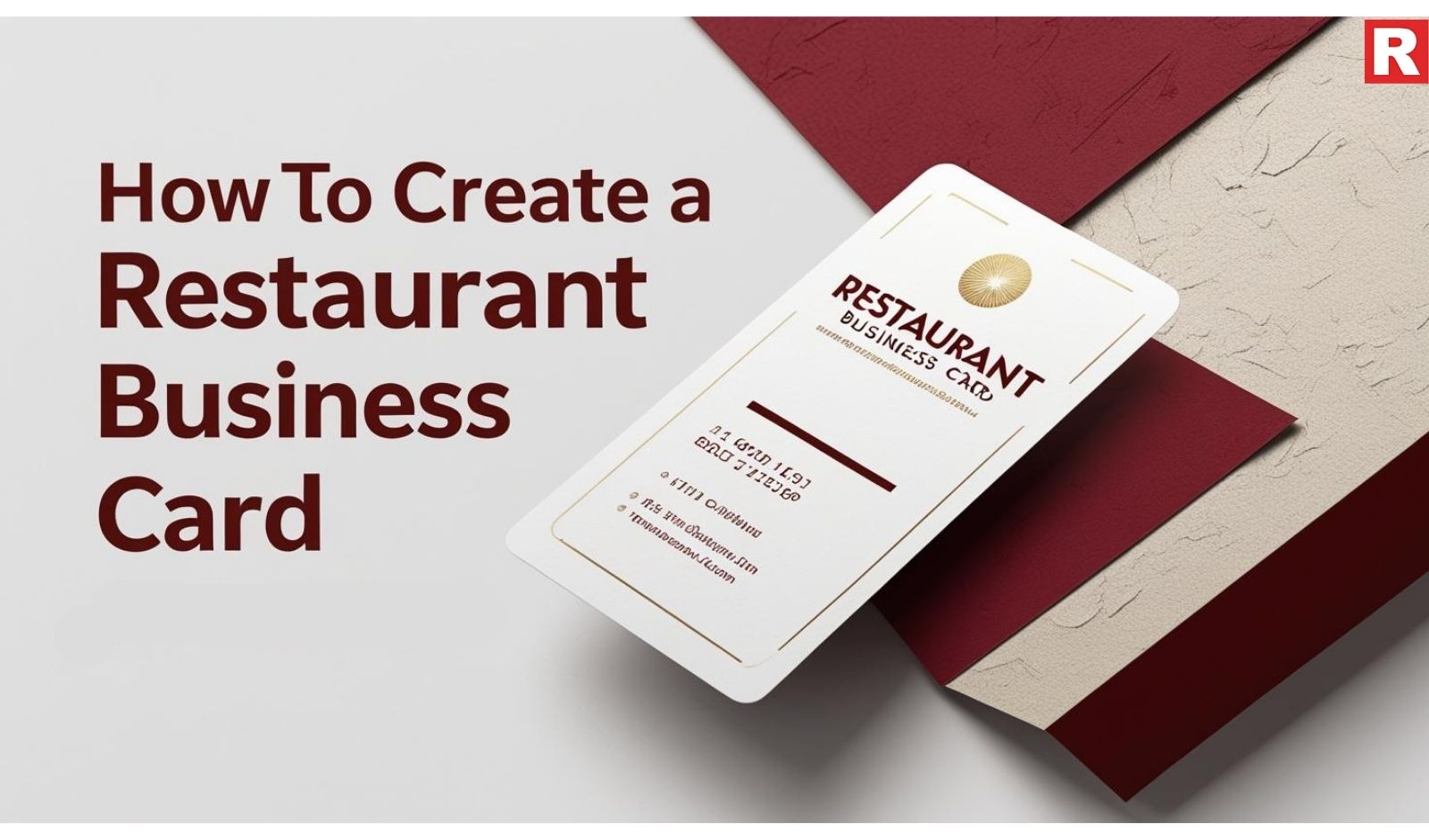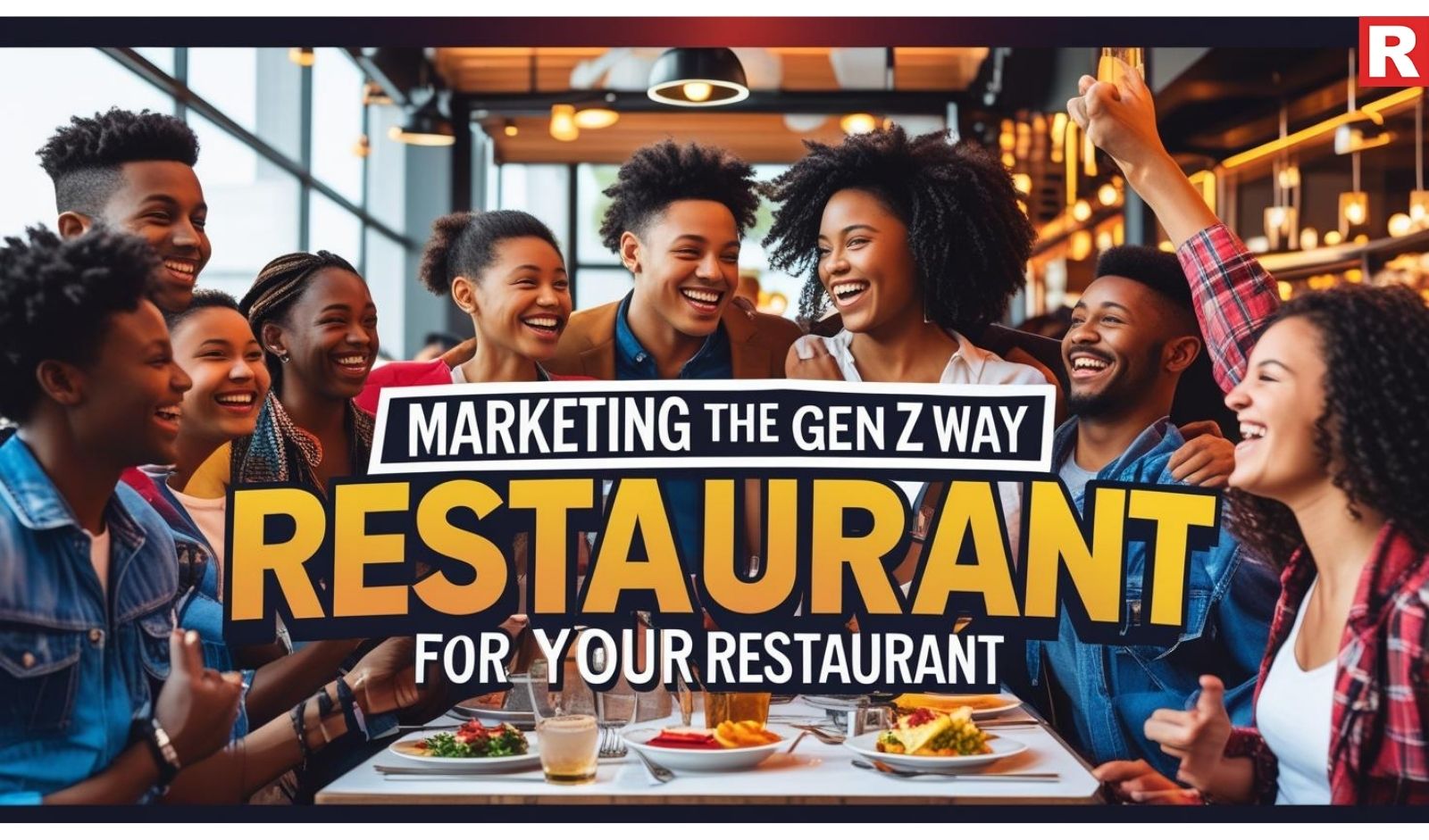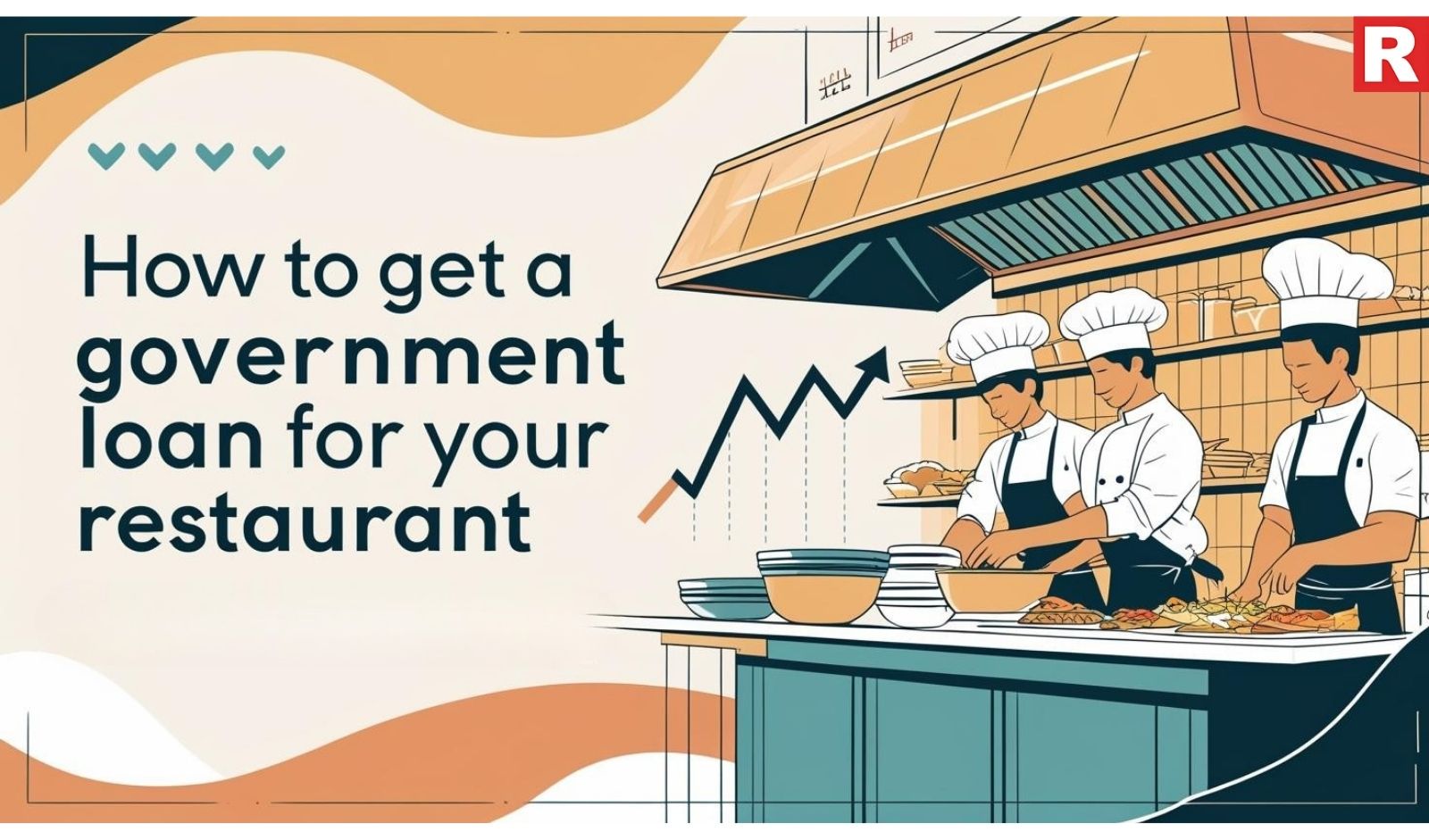
With the growing concern over air pollution, the market for air purifiers has expanded significantly. This includes air purifiers for both commercial and domestic use. This also includes the food & beverage sector. Air quality is an unseen factor that increasingly determines a customer's comfort and sense of hygiene in India's vibrant food culture, where flavors attract and scents seduce. Maintaining a good and healthy indoor atmosphere is no longer merely a gesture of respect for restaurants; it is now essential to customer satisfaction, employee health, and compliance with laws. Commercial-grade air purifiers are now essential equipment for contemporary Indian restaurants, as they can filter out dust, allergens, and airborne pathogens in addition to fighting smoke and cooking aromas. In urban areas with high pollution levels, such as New Delhi, a restaurant's dedication to clean air can make a big difference.
In addition to highlighting the best air purifier brands for Indian restaurants, this detailed article discusses the critical role that excellent air quality plays in the food service industry. In order to help restaurateurs make smart decisions and give their customers and employees a sense of security, we will examine the key features, technology, and suitability of these brands.
Why Air Quality Matters in Restaurants

Many different components make up the air in a restaurant. Even while the aroma of paneer tikka or biryani is delightful, the dining experience can be rapidly ruined by residual cooking smells, tandoor smoke, and other indoor air pollution. There are important operational and health factors in addition to comfort:
- Customer Comfort & Experience: Stuffiness, unpleasant smells, or visible smoke give the wrong impression. The dining experience is improved by clean, fresh air, which promotes longer stays and return visits.
- Health and Hygiene: Restaurants see a lot of foot traffic. By removing dust, pollen, fur from pets (if any), and—above all—airborne bacteria and viruses, air purifiers help create a healthier atmosphere for customers and staff members alike. This factor has become more significant than ever in the post-pandemic period.
- Employee Well-Being & Productivity: Long-term exposure to heat and cooking odors is especially harmful to kitchen staff members. Improved working conditions, fewer respiratory problems, and more productivity are all benefits of cleaner air.
- Preventing Odor Transfer: By keeping strong cooking smells out of the dining room and other areas of the business, air purifiers can maintain a constant and comfortable environment.
- Equipment Longevity: Cleaner kitchen appliances and HVAC systems can last longer due to a reduction in dust and grease in the air.
- Regulatory Compliance & Brand Reputation: Local laws related to indoor air quality may tighten as awareness increases. In addition to compliance, a restaurant with a reputation for having clean air frequently has a better reputation.
Read more: Best Bar Chair and Stool Brands for Indian Bars & Lounges
Key Technologies in Commercial Air Purifiers

Understanding the core technologies helps in selecting the right purifier for a restaurant's specific needs:
- HEPA (High-Efficiency Particulate Air) Filters: The best method for removing airborne particles is to use HEPA (High-Efficiency Particulate Air) filters. Dust, pollen, mold spores, some germs, and viruses are among the 99.97% of particles as small as 0.3 microns that HEPA filters can capture. These are essential for eliminating physical contaminants.
- Activated carbon filters: These are essential for eliminating odors. Because of the amount of pores, activated carbon efficiently absorbs gases, organic substances, and scents from cooking, such as smoke and grease.
- UV-C Light: As air flows through the device, ultraviolet-C germicidal irradiation can destroy bacteria, viruses, and mold spores. It works well as a sterilizing layer, particularly in situations where hygienic conditions are crucial.
- Ionizers/PlasmaWave/PlasmaCluster: To clump particles together and make them simpler for filters to catch or cause them to fall out of the air, Ionizers, PlasmaWave, and PlasmaCluster technologies release charged ions into the atmosphere. Selecting models with little or no ozone emission is crucial since, despite their effectiveness, some may emit ozone.
- Pre-filters: These thick filters prolong the life of the more fragile HEPA and carbon filters by capturing bigger particles, including hair, lint, and large dust.
Factors to Consider When Choosing an Air Purifier for a Restaurant
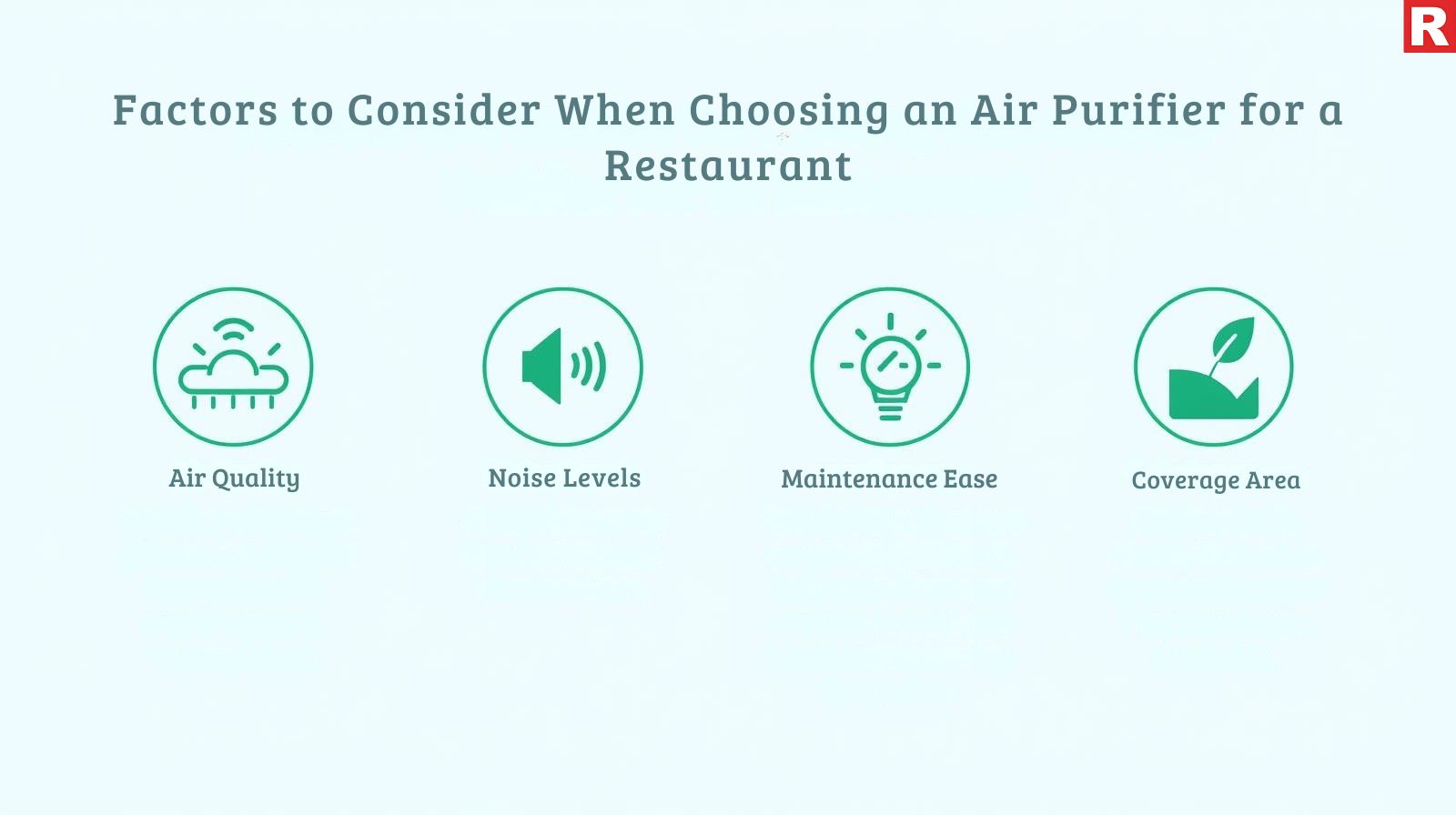
Choosing a brand is only one aspect of choosing the best air purifier. The following are crucial factors for Indian restaurants:
- Coverage Area (CADR): A measure of the purifier's speed at cleaning a room, expressed in Clean Air Delivery Rate (CADR). Larger kitchens and dining areas will require a high CADR. To get an approximate CADR target, multiply the square footage of your room by two-thirds.
- Filter Type & Lifespan: Restaurants are not allowed to use a multi-stage filtration system that consists of a pre-filter, HEPA, and activated carbon. Examine the lifespan and cost of filter replacements, as these add to operating costs.
- Noise Level: Very important in dining rooms. Select models with low decibel ratings, particularly when the fan speed is lowered.
- Commercial Grade & Durability: Restaurant environments are harsh. Select sturdy, commercial-grade devices that are designed to run continuously.
- Maintenance Ease: Replacing a filter should be simple. Pre-filters that are simple to clean reduce overall maintenance effort.
- Smart Features: Air quality sensors, auto mode, app control, and Wi-Fi connectivity can all improve efficiency and convenience.
- Aesthetics & Placement: The device should be discreetly positioned or mixed in with the interior design of your restaurant.
- Reputation of the Brand and After-Sales Service: In India, a robust local presence, dependable warranty, and effective service network are critical for reducing downtime.
Know more: Best Commercial Mixer & Blender Brands For Restaurants
Top Air Purifier Brands for Restaurants in India
Each of the most popular and widely recognized air purifier brands in the Indian food service sector has something special to offer, and this list has been carefully chosen keeping that in mind.
Blueair

The Swedish company Blueair is widely recognized as the leading name in the air purification industry. It has a significant global presence and is expanding in India. Blueair units for restaurants are well-known for their patented HEPASilent technology, which blends mechanical and electrical filtration. This makes them perfect for dining spaces where ambiance is important because they can give high Clean Air Delivery Rates (CADR) with very low noise levels. Their multi-stage filtration usually consists of a main particle filter, a washable pre-filter, and a combination particle and activated carbon filter (commonly impregnated with coconut shell carbon for better odor elimination).
In addition to significantly reducing cooking aromas, smoke, and volatile organic compounds (VOCs) that are frequently seen in restaurant environments, this sturdy system is also good at capturing dust, allergens, and airborne particles. Although Blueair purifiers are more expensive, fine dining venues, high-end restaurants, and health-conscious cafes that value the best possible air quality will find that their longevity, energy economy, and exceptional performance make the investment worthwhile. Additionally, their clean, European style enables them to blend in perfectly with modern interiors.
What's new: Best Online Ordering Platform Providers in India
Honeywell

A well-known American multinational corporation, Honeywell has a sizable manufacturing and service presence in India and also provides a wide selection of commercially usable air purifiers. They are well-known for their dependability, powerful filtration, and excellent value for money ratio. Commercial-grade air purifiers from Honeywell usually use a multi-stage filtering system that includes an activated carbon filter, a high-grade HEPA filter (usually H13 medical-grade), and a pre-filter. This technology is very successful at eliminating smoke, cooking aromas, and other indoor pollutants.
A UV-C lamp is also included in several models to provide additional bacterial protection. Because of its well-established service network and availability of spare parts, Honeywell is a reputable brand for restaurants in India. Their purifiers are built to last and run continuously, which makes them a sensible option for cafés, mid-to-large restaurants, and QSRs (Quick Service Restaurants) that require reliable air purification without going over budget. In order to effectively cover bigger spaces, their commercial series frequently have higher CADR ratings.
Check out: Top Tea Brand options to consider for Restaurateurs in India
How to Choose the Perfect Spooky Theme for Your Restaurant
Coway

The South Korean environmental home appliance manufacturer Coway, which is well-known for its sophisticated design and cutting-edge filtration technology, has made significant progress in the Indian market. They are well-known for their advanced features and extensive filtering systems. Coway air purifiers frequently have an advanced multi-stage filtration system that consists of True HEPA filters that can capture tiny dust particles, activated carbon filters for odor removal, and pre-filters. For better virus and bacteria elimination, some advanced versions even have their exclusive GreenHEPA filter and an antibacterial filter, which is a big plus for hygienic restaurant settings. Their appliances are also known for their energy-efficient, silent operation and innovative features like auto modes that change fan speed in response to air quality and real-time air quality indicators. For contemporary cafés, lounges, and fine dining restaurants looking for a blend of superior performance, elegant design, and clever management to give customers a first-rate experience, Coway is a great option.
Dyson

The British tech firm Dyson has completely changed how people think about a lot of household products, and their air purifiers are no different. Dyson purifiers are well-known for their unique, elegant designs, cutting-edge filtration, and frequently multipurpose (purifying, heating, and cooling) features, making them ideal for premium dining establishments and luxurious lounges. Their larger versions provide strong air purification that is appropriate for smaller, private business venues or as additional units in larger ones, even though they are primarily made for home usage. A fully sealed HEPA and activated carbon filtration system is a common characteristic of Dyson purifiers, which capture allergens, gases, smells, and ultrafine particles. Their innovative airflow projection technology makes sure that the room's cleaned air circulates efficiently. Their innovative design, cutting-edge technology, and frequently extra features are reflected in the high price point. For businesses that value design and innovative technology as components of their brand identity, Dyson provides an intriguing, if expensive, option.
Read this: Top Eco-friendly Packaging Brands for Restaurants
A Breath of Fresh Air for Your Business
In the fiercely competitive restaurant business in India, where every little thing affects the customer's experience, having excellent air quality is quickly turning into a must. Purchasing an excellent industrial air purifier is not only about keeping your space clean; it's also about protecting your health, improving comfort, and confirming your brand's dedication to quality. Restaurant owners can choose the ideal air purification system by carefully weighing elements, including coverage area, filtration technology, noise level, and after-sales service. Offering some fresh air can greatly improve the eating experience and drive customers to stay longer, come back more frequently, and fully enjoy their time in your restaurant.

When it comes to professional baking and pizza, the quality of the finished product depends on the quality of its most basic component, flour. Choosing the correct flour has a significant impact on a variety of aspects for Indian chefs, bakers, and restaurateurs, ranging from the texture and rise of a dough to the final product's flavor profile and shelf life. There are many different flour brands available in the Indian market because of their varied cuisine and rising demand for real Italian pizza and handcrafted baked items. But not every flour is made equally. The ideal flour for a robust sourdough loaf and a light, fluffy croissant is not the same as the one for a chewy Neapolitan pizza.
This comprehensive article explores the science of flour and lists the top flour brands available in India for bakeries and pizza joints. We will look at the qualities that make a flour appropriate for particular uses, analyze the major market sellers, and offer advice to help restaurateurs make a calculated decision that improves their culinary productions.
Read more: Best Online Ordering Platform Providers in India
Understanding the Science of Flour

It's important to comprehend the factors that influence flour's behavior before delving into the brands. Gliadin and glutenin are the two crucial proteins. These proteins come together to produce gluten, the elastic network that gives dough its structure, flexibility, and chewiness, when flour and water are combined.
- Protein Content: The protein content of flour is its most crucial statistic.
- Low-Protein Flours (7-9%): These "soft" flours are perfect for biscuits, cakes, and pastries that call for a crumbly, soft feel.
- Medium-Protein Flours (10–12%): "All-purpose" flours that can be used for a variety of recipes, such as fast breads and cookies.
- High-Protein Flours (12-14%+): "Hard" flours that are high in proteins that produce gluten are known as high-protein flours (12–14%+). These are necessary for breads, pizzas, and other goods that need to have a good rise and a sturdy, elastic structure. We will concentrate on this niche for pizzas and a variety of other baked goods.
- Ash Content: The mineral content that remains after burning flour is referred to as the "ash content." It serves as a measure for the quantity of bran and germ. A flour with a lower ash level is whiter, and one with a greater ash content is more delicious and whole-grain. For instance, Italian Tipo 00 flour is well-known for having a very low ash level, which helps to create a smooth, fine texture.
- W Index: The W index (W), a less widely used but extremely important indicator, measures the strength of a flour. It is a crucial sign of its resistance to fermentation and its water absorption ability. While a lower W index (e.g., 180-250) is appropriate for doughs that respond more quickly, a higher W index (e.g., 300-400) suggests a very strong, elastic flour perfect for long-fermented doughs like Neapolitan pizza.
Know more: Best Bar Chair and Stool Brands for Indian Bars & Lounges
Top Flour Brands in India for Pizza & Bakery Restaurants
After laying the theoretical groundwork, let's examine some of the leading brands in the Indian professional food sector.
Caputo

Protein Content: 12.5%
W index: 220-240
Perhaps the most well-known flour brand in the world, particularly in the Neapolitan pizza industry, is Caputo. Despite not being an Indian brand, many experts choose it because of the vast importation of its products and the availability of specialty suppliers in India. A Tipo 00 flour with a protein content of about 12.5% and a W index of 220-240, Caputo is well-known for its Antimo Caputo Pizzeria (blue bag), which is ideal for a light, supple, and flawlessly blistered Neapolitan crust. For prolonged fermentation and bread-making, they also provide a stronger Caputo Cuoco (red bag) with a higher W index (300-320) for longer fermentation and bread-making. A benchmark for quality and consistency, the brand's reputation is based on generations of milling knowledge. This is important for restaurants that require their dough to perform well consistently.
Pillsbury

Protein Content: 10-11%
W index: Not Specified
With its Pillsbury Atta and other flours, Pillsbury, a brand that has long been connected to home baking, has also made a big entry into the commercial market. Pillsbury is well known for its whole wheat goods for rotis and chapatis, but it also sells maida, a refined flour that is frequently used in tiny cafés and bakeries. The brand is well-known for being widely accessible, high-quality, and reliable. Their refined maida flour has a decent medium-protein content, usually between 10 and 11 percent. Although the W Index is not formally defined, it is typically lower than professional bread flours, making it appropriate for a variety of uses, including general-purpose bread and cakes, and biscuits. Although it might not possess the unique qualities of imported Italian flours for a genuinely authentic Neapolitan pizza, a premium refined maida from a reputable company like Pillsbury can be a dependable and affordable option for a wide range of bakery goods, especially for businesses that require a flexible flour for a varied menu.
What's new: Top Air Purifier Brands for Restaurants in India
Ashirvaad
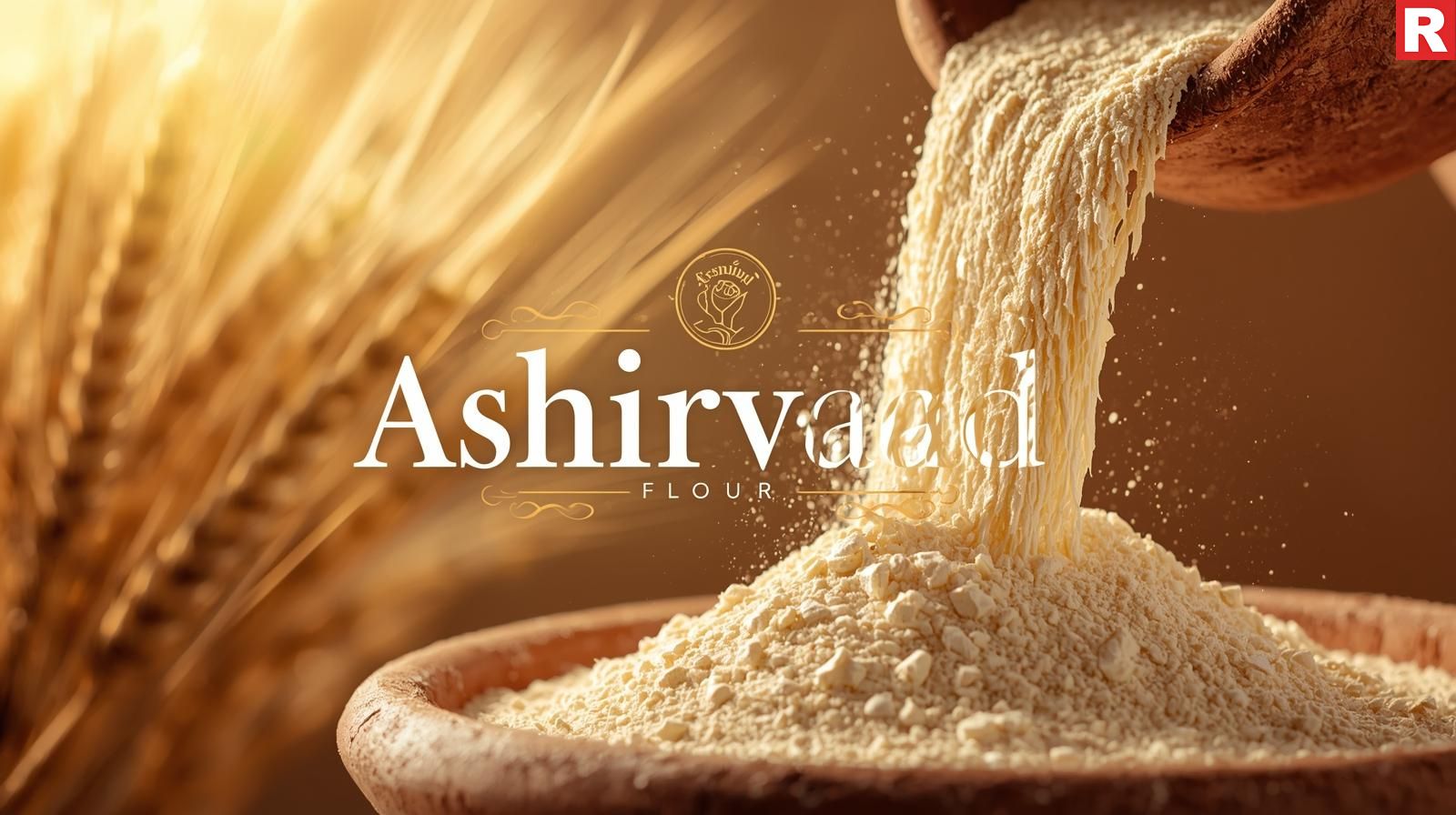
Protein Content: 11-12%
W index: medium-high strength
Ashirvaad, which is well-known in India for its atta (whole wheat flour), has similarities to Pillsbury. Nevertheless, the professional kitchen has also adopted its maida, or refined flour of commercial grade. For high-volume bakeries, Ashirvaad's well-known brand awareness and reliable quality are important. Bread, pastries, and general-purpose baking are just a few of the many uses for their maida flour, which is dependable and versatile. Ashirvaad refined flour's protein content is often between 11 and 12%, which is higher than average for an all-purpose flour. This makes it a flexible choice for both naan and kulchas as well as regular bread. The W Index is not explicitly mentioned, but its performance shows it has a medium-high strength, making it a dependable pick. Businesses that require a flexible and reasonably priced flour for various purposes can use it because of its dependability and reasonable pricing.
Baker's Choice
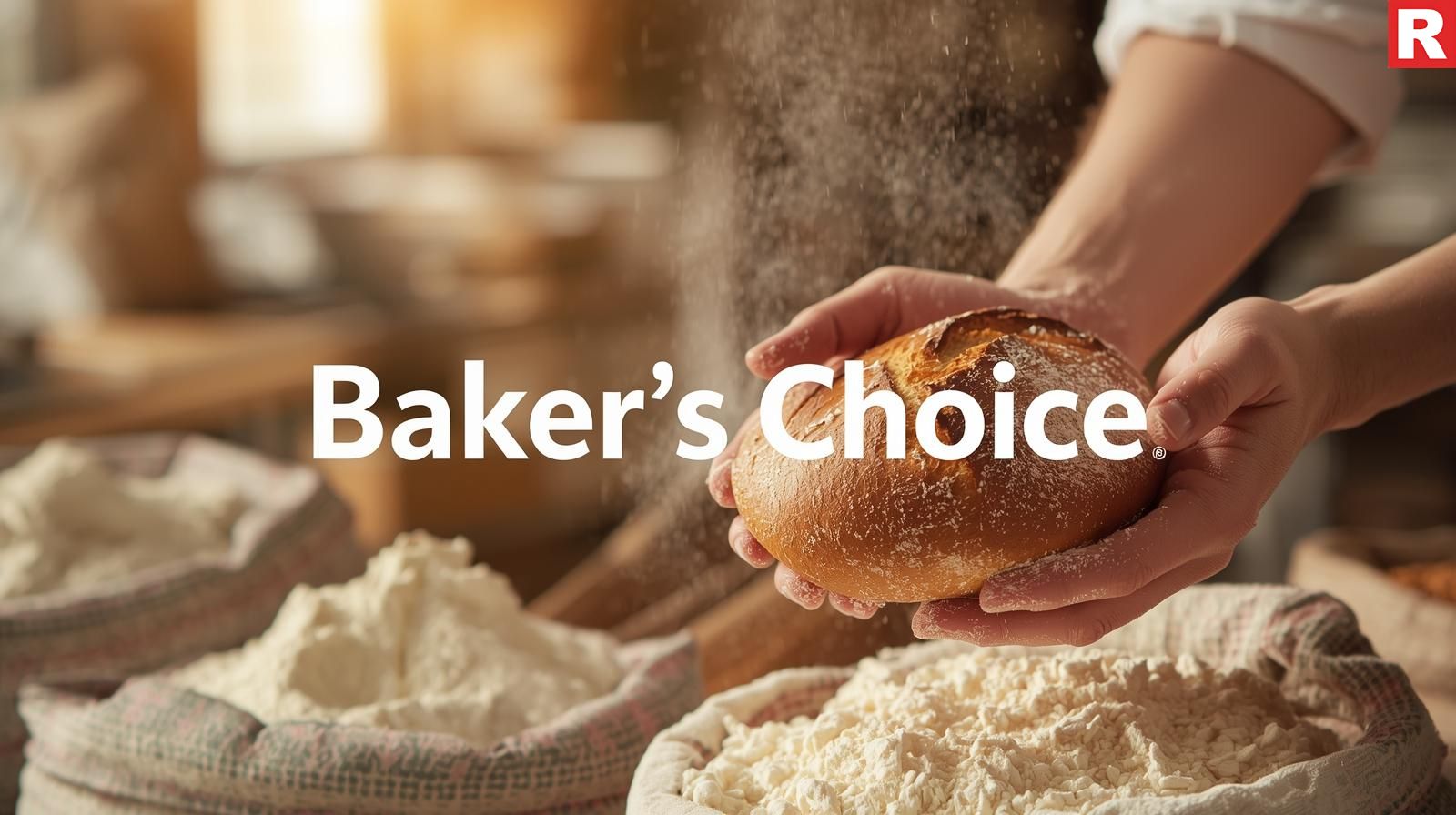
Protein Content: 13–14%
W index: can range from 250 to 300+
In addition to the well-known brands, there are an increasing number of smaller Indian companies serving the professional pizza and baking market. Companies such as Baker's Choice have established themselves by providing high-protein maida that is especially developed for pizza and bread. These companies are well-known for offering a domestic substitute for pricey imported flours. Their professional-grade flour usually has a protein content of 13–14% and a W Index that, depending on the product, can range from 250 to 300+. They are, therefore, a good option for many goods that need a strong gluten structure. Additionally, a lot of these businesses have specialty flours for use in pastries, croissants, and other kinds of bread, so professional bakers can select a product that suits their requirements. Their increasing presence suggests that the Indian market is growing and that there is a higher need for high-quality ingredients.
Check out: Best Commercial Mixer & Blender Brands For Restaurants
Top Tea Brand options to consider for Restaurateurs in India
Weikfield
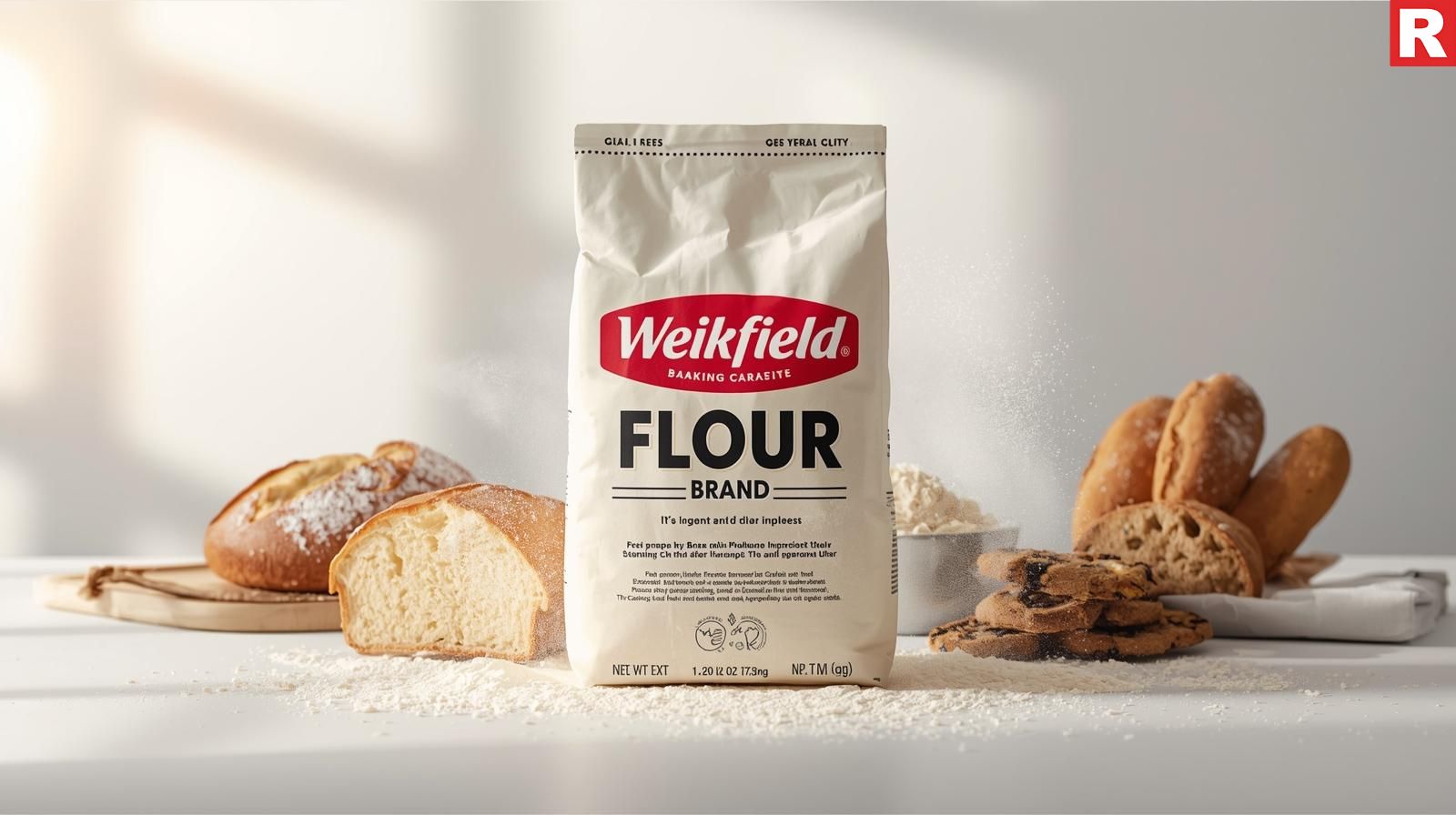
Protein Content: 11-12%
W index: not officially published
Another well-known brand in the Indian market is Weikfield, which is mostly associated with baking supplies like yeast and baking powder. They do, however, also provide a variety of refined flours and other bakery-related items that are utilized in industrial cooking facilities. Many skilled bakers trust Weikfield's flour because of its reputation for dependability and constant quality. Their medium-protein refined maida is appropriate for a variety of baked goods, including bread and cakes, and pastries. Their products are a reliable option for a bakery that needs a diverse, consistent, and reasonably priced flour, even though they might not have specific flours for different kinds of pizza. Although the W Index is not formally recorded and the protein content is typically between 11 and 12%, it works well as a general-purpose baking flour.
The Strategic Choice: Beyond the Brand Name

Selecting flour for a professional food business is a strategic choice that extends beyond brand loyalty. Getting the correct flour for the proper product is the key.
- For authentic Italian pizza: It is important to purchase imported Tipo 00 flour from a company such as Italica or Caputo. The qualities of this flour are closely related to the texture, flavor, and chewiness of the crust, and there is no alternative for a pizzeria striving for genuine authenticity.
- For General Bakery & Bread: Commercial products from Pillsbury or Ashirvaad, or even a robust, high-protein maida from a reputable domestic brand like Bakers Choice, might be excellent options. These flours work reliably for bread and pastries, and they are widely accessible and reasonably priced.
- For Artisanal Sourdough & Specialty Breads: In order to produce the ideal open crumb and robust flavor, many professional bakers are now choosing to use specialty domestic flours or even import particular types of flour.
Read this: How to Choose the Perfect Spooky Theme for Your Restaurant
Conclusion
In the end, the ideal flour for a restaurant is the one that is regularly accessible, affordable, and yields a high-quality product. From the high-end, specialty flours for fancy pizzerias to the adaptable and reliable options for busy bakeries, the brands featured in this article provide a variety of solutions. Selecting the appropriate flour is the first and most crucial step in producing a culinary masterpiece in a market where quality is the key to success.

In the highly competitive and quickly changing Indian food service sector, having a digital presence has become essential rather than optional. The days of just walk-ins and orders placed by phone are long gone. Customers today are accustomed to a smooth ordering process via their smartphones, tech-savvy, and convenience-driven. For restaurants, coffee shops, and cloud kitchens, this has meant adopting online ordering systems that are ideal for data-driven growth, customer interaction, and brand building, in addition to facilitating transactions. For a food business, selecting the appropriate platform can be the most crucial choice, affecting everything from profitability to operational effectiveness.
This in-depth article explores the essential purpose of these platforms and lists the top Indian suppliers of online ordering systems. In order to assist restaurateurs in making a strategic choice that will enable their business to prosper in the digital era, we will examine the key characteristics, unique selling points, and target market of these major names.
What are Online Ordering Platform Providers?

An online ordering platform provider is a tech business that provides restaurants with software to set up and run their own branded online store. They provide a private label service, in contrast to food aggregators such as Swiggy and Zomato, which function as a broad marketplace for multiple restaurants. This means your logo, colors, and unique menu presentation are all fully branded to your restaurant, giving customers a smooth and consistent brand experience. These platforms offer a mobile-friendly page, a separate website, or a complete mobile application that allows customers to place purchases with you directly. From order placing and safe payment processing to customer service and order tracking, they manage the full digital transaction process.
Read more: Top Draft Beer Dispenser Brands in India for the Perfect Pour
How They Help Restaurants
Restaurants benefit greatly from online ordering platforms, which solve some of the most important issues in the present-day food industry.
- Increased Profit Margins: Restaurants can avoid paying the hefty commissions that food aggregators demand by having their own direct ordering channel, which enables them to keep a far higher portion of their earnings.
- Direct Customer Relationships & Data Ownership: You are in complete control of your customers' names, order histories, and other data when you have your own platform. With the help of this data, you can directly and consistently connect with your most loyal customers and customize the marketing efforts.
- Total Brand Control: You have total control over the digital identity of your brand when you use a private platform. The appearance and user experience can be customized to precisely fit the theme of your restaurant, guaranteeing that every digital interaction captures the essence of your brand.
- Enhanced Marketing & Loyalty Programs: To promote repeat business and cultivate a community of devoted customers, you may develop complex, data-driven marketing campaigns, send customized offers, and establish your own loyalty programs.
- Operational Efficiency: A restaurant's current Point of Sale (POS) system can be easily integrated with a number of online ordering systems, which simplifies the order management procedure and lowers the possibility of human mistakes.
What to Look for When Choosing an Online Ordering Platform Provider

Selecting the best online purchasing platform is a crucial business choice. Locating a partner who shares the unique requirements and objectives of your business is more important than simply choosing a service.
- Usability: The platform needs to provide a user-friendly interface on both sides. Customers should be able to place orders quickly and easily. The back-end dashboard should have a short learning period and be easy to use for your employees.
- Pricing Structure: Find out if there is a fixed monthly subscription charge or a commission based on a percentage of each order. Ask about any possible hidden costs, including setup fees or further payments for marketing tools.
- Integration Capabilities: Your current technology, especially your point-of-sale system, should be able to connect easily with a genuinely successful online ordering platform. This is essential for optimizing processes, guaranteeing order correctness, and offering an overall view of your business's success.
- Customization and Branding: Your brand is reflected in your online ordering system. Choose a supplier that gives you extensive customization options so you can manage the menu layout, color scheme, design, and images.
- Customer Service and Dependability: Pick a supplier who has a solid track record of providing exceptional customer service and dependable platforms. To reduce downtime and guarantee that your digital activities are always operating efficiently, you need a responsive support staff.
Know more: Best Commercial Mixer & Blender Brands For Restaurants
The Best Online Ordering Platform Providers in India
Now that you know what to look for, let's examine some of India's largest and popular suppliers of online ordering platforms, each with unique plans for digital transformation.
Thrive: Commission-Free Ordering

Consider a platform that pays you for the money you have been donating to aggregators. That's the promise of Thrive, a brand that has swiftly established itself as a symbol of helping restaurants go direct. Thrive, a Bengaluru-based company, has made a name for itself as a major force because of its smooth, commission-free platform that gives restaurateurs back control. Their main product is an ordering system that is fully branded and accessible online and on smartphones, which seems and feels like a natural extension of the restaurant's own brand. Businesses with large quantities to order find Thrive's fixed monthly fee pricing model appealing since it enables them to precisely forecast their costs and save a substantial amount on commissions.
The seamless connection of Thrive with well-known POS systems like POSist, Petpooja, and Gofrugal is what makes it a great option. This eliminates errors and manual entry by ensuring that orders placed by customers on your Thrive-powered website appear immediately on the POS screen in your kitchen. With its wide range of marketing tools, which includes creating promo codes and running SMS/email campaigns, this robust and user-friendly platform does more than just handle orders; it also helps you cultivate customer loyalty and promote repeat business. Thrive provides a free and lucrative option for any restaurateur who has been annoyed by aggregator fees.
What's new: Best Bar Chair and Stool Brands for Indian Bars & Lounges
Dotpe: The Simplicity of the QR Code

A straightforward approach is frequently the most appealing approach when it comes to online ordering. With its straightforward yet effective QR code-based approach, Dotpe, which has its headquarters in Gurugram, has completely transformed the digital ordering industry. Their strategy is simple and brilliant: customers are directed immediately to the restaurant's customized menu for ordering by scanning a QR code that is displayed on the dining table, on fliers, or on a social media website.
Because of its well-known zero-commission policy and remarkably simple setup process, Dotpe is especially appealing to small and medium-sized businesses looking to launch their websites rapidly without having to deal with the hassles or excessive expenses of a traditional platform. Dotpe provides a central order management interface, a variety of safe payment methods, and insightful customer data for delivery, dine-in, and takeout. Its emphasis on providing local businesses with an affordable and easy-to-use solution has made it a national favorite, particularly for those seeking a quick yet effective entry into the world of digital ordering.
Petpooja: The All-in-One POS Solution

For a business searching for a complete IT solution, Petpooja stands out. Known primarily as one of Ahmedabad's top providers of point-of-sale software, it has developed into a full-fledged digital ecosystem with an integrated online ordering platform. This means allowing online ordering for current Petpooja users only requires turning on a switch.
The ability to manage online orders, inventory, reporting, and paying from a single, centralized dashboard is a huge benefit of seamless connectivity. A crucial part of Petpooja's offering is its online ordering capability, which lets restaurants design their own branded website and application. It is a strong and practical option for businesses seeking a single platform for all of their operational requirements, from front-of-house to back-of-house, since it offers crucial capabilities for order administration, customer relationship management (CRM), and analytics.
Check out: Top Tea Brand options to consider for Restaurateurs in India
How to Choose the Perfect Spooky Theme for Your Restaurant
Blinkit: The Speed & Simplicity of Delivery

Blinkit began as a local delivery service but has since grown to offer an advanced and easy online ordering system for restaurants. Blinkit, which is now a part of Zomato, is well-known for emphasizing simplicity and quickness. The platform is made for businesses that wish to go online with the least amount of hassle. It focuses on fast delivery management, has a clear interface, and is quick and simple to set up.
Restaurants that use both platforms can have a smooth experience because of the strong connection that Blinkit and Zomato have built. Blinkit is a strong choice for companies seeking a simple, uncomplicated online ordering system with a dependable delivery network that can quickly get you up and running.
UrbanPiper: The Connecting Master

For a busy restaurant, navigating the many screens and dashboards from many aggregators can be a nightmare. This issue is resolved by Bengaluru-based UrbanPiper. This connecting technology is well-known for its capacity to link a restaurant's point-of-sale system with both its own branded website and all of the main online food aggregators. This eliminates the need for several tablets and tedious data entry by allowing a restaurant to receive and manage orders from Swiggy, Zomato, and its own direct channel on a single screen.
Additionally, UrbanPiper offers restaurants a toolset to create their own websites for online ordering. Their system is incredibly flexible and adaptable, making it suitable for both major chains with complex online ordering systems and single-outlet restaurants. UrbanPiper is an amazing business-grade solution that serves as a central nerve system for all of your digital orders, giving much-needed efficiency to a hectic kitchen. It is ideal for restaurants looking to optimize their online order processes while also developing a direct ordering channel.
Read this: Top Eco-friendly Packaging Brands for Restaurants
Conclusion
Selecting the best online ordering platform is a calculated decision that requires carefully balancing the platform's features with the objectives of a restaurant. While a tiny café or cloud kitchen would favor a simpler, less expensive solution, a large, well-established restaurant with a lot of customers might prioritize an all-in-one solution or advanced middleware to speed complex operations.
In addition to cutting expenses, businesses that establish a direct channel are gaining loyal customers and an immense amount of data that can be used to boost future expansion. The success of a restaurant is fueled by the appropriate online ordering platform.

The effectiveness and dependability of a restaurant's kitchen equipment are just as important to its success in the fast-paced, highly competitive Indian food service sector as the chef's talent. Commercial mixers and blenders are among the most important of these devices. These powerful appliances are far more useful in professional kitchens than in homes, and they are necessary for everything from making velvety purees and creamy milkshakes to making the basic gravies and batters that characterize Indian cooking. A commercial blender or mixer with great performance guarantees consistency in quality, reduces preparation time, and enables a kitchen to manage the enormous amount of orders that a profitable restaurant generates.
This is why having a great commercial mixer & blender is a necessity. But how does a restaurant find a good mixer and blender for them? What are the best brands? What does a good commercial mixer and blender need to have? In this article, we will be answering these questions. We will explore the vital role of this strong equipment as well as the top brands of commercial mixers and blenders for restaurants, examining what makes them a popular option for Indian chefs, kitchen managers, and restaurateurs. We'll look at their key characteristics, uses, and things to think about before investing wisely in these essential instruments.
Read more: Celebrate Onam with 41 Sadya Menus Across India
Why a Commercial-Grade Appliance is a Non-Negotiable Investment?

Every professional kitchen needs a commercial-grade blender or mixer. It is not only a luxury to choose one over typical residential equipment. The operating efficiency of a restaurant is directly impacted by the wide variations in engineering and design.
- Motor Power & Durability: Heavy-duty, continuous operation is the design of commercial motors. With greater RPMs (Revolutions Per Minute) and stronger construction, they can handle challenging ingredients like ice, frozen fruits, and spices without overheating or degrading.
- Capacity: Chefs can save time and work by preparing big batches of a product at once with commercial blenders, which come with larger jars that range in size from 1.5 to 4 liters.
- Material of Blade and Jar: The blades are composed of stainless steel that has been toughened to endure continuous wear and tear. Usually composed of Tritan or high-impact, shatterproof polycarbonate, the jars are meant to withstand harsh conditions.
- Advanced Features: A lot of commercial models have noise reduction enclosures, pre-programmed settings for particular activities, and easy-to-use controls that make operation simple and guarantee consistent results for any user.
Key Factors to Consider Before Buying

Make sure the commercial mixer or blender you choose fits your restaurant's needs and budget before making the purchase.
- Menu & Usage: For what purposes will you use it most frequently? A high-speed blender with a strong motor is essential if smoothies are a major part of your menu. It is better to use a heavy-duty planetary mixer for batters and doughs.
- Volume: While a major hotel kitchen or catering service will need numerous units with high capacity, a tiny café with a limited menu of shakes might do well with a compact, single-serving blender.
- Noise Level: A loud blender can cause a lot of noise in a small café or an open kitchen. Models with noise-reducing coverings are accessible in certain brands.
- Service & Warranty: One of the most important factors in the Indian market is service and warranty. Make sure the company has a strong market presence, a dependable service network, and a thorough warranty to reduce downtime in the case of an issue.
Know more: 5 Key Strategies to Focus While Rebranding your Restaurant
Top Commercial Mixer & Blender Brands for Restaurants
Each of the most well-known and popular industrial mixer and blender manufacturers is included below, each adding something special to the professional kitchen.
1. Vitamix
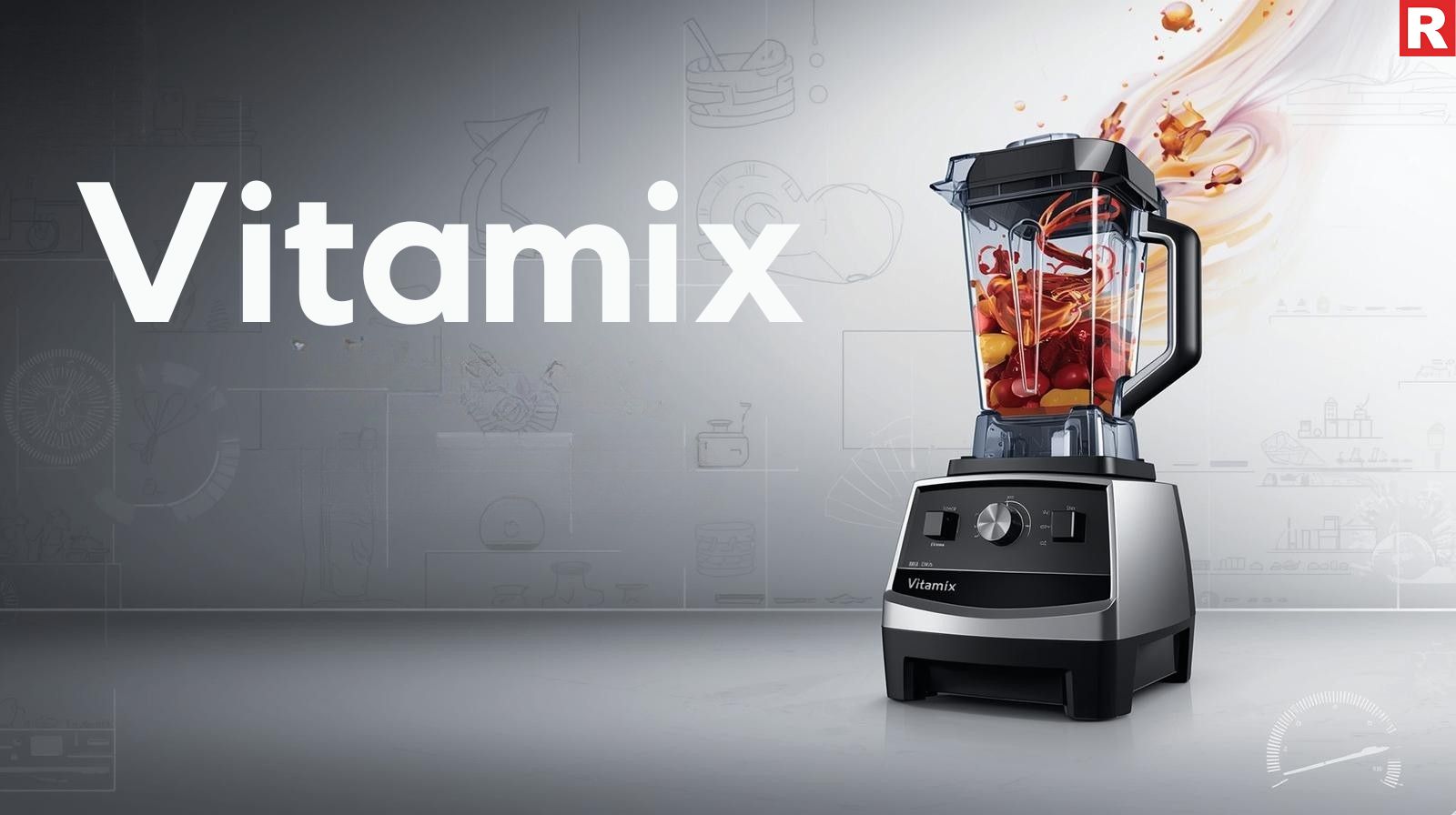
One brand that is widely associated with the highest quality of industrial blending is Vitamix. High-end restaurants, cafes, and hotels all around India choose Vitamix since it is regarded as the industry standard. Their devices are well-known for their unmatched strength, remarkable robustness, and consistent production of wonderfully smooth blends. Even under the most difficult circumstances, they are designed to persist for years. Hardened stainless steel blades, high-impact containers, and strong motors (up to 3 HP) are included on Vitamix blenders.
Their equipment can be used for anything from making silky smooth purees, hot soups, and even batters to smashing ice for drinks and blending frozen fruits for smoothies. Even though their price range is on the upper end, their performance, dependability, and long-term minimal maintenance expenses make the investment worthwhile. Because Vitamix consistently produces results of a professional standard, many renowned chefs and restaurant chains rely on it.
2. Blendtec
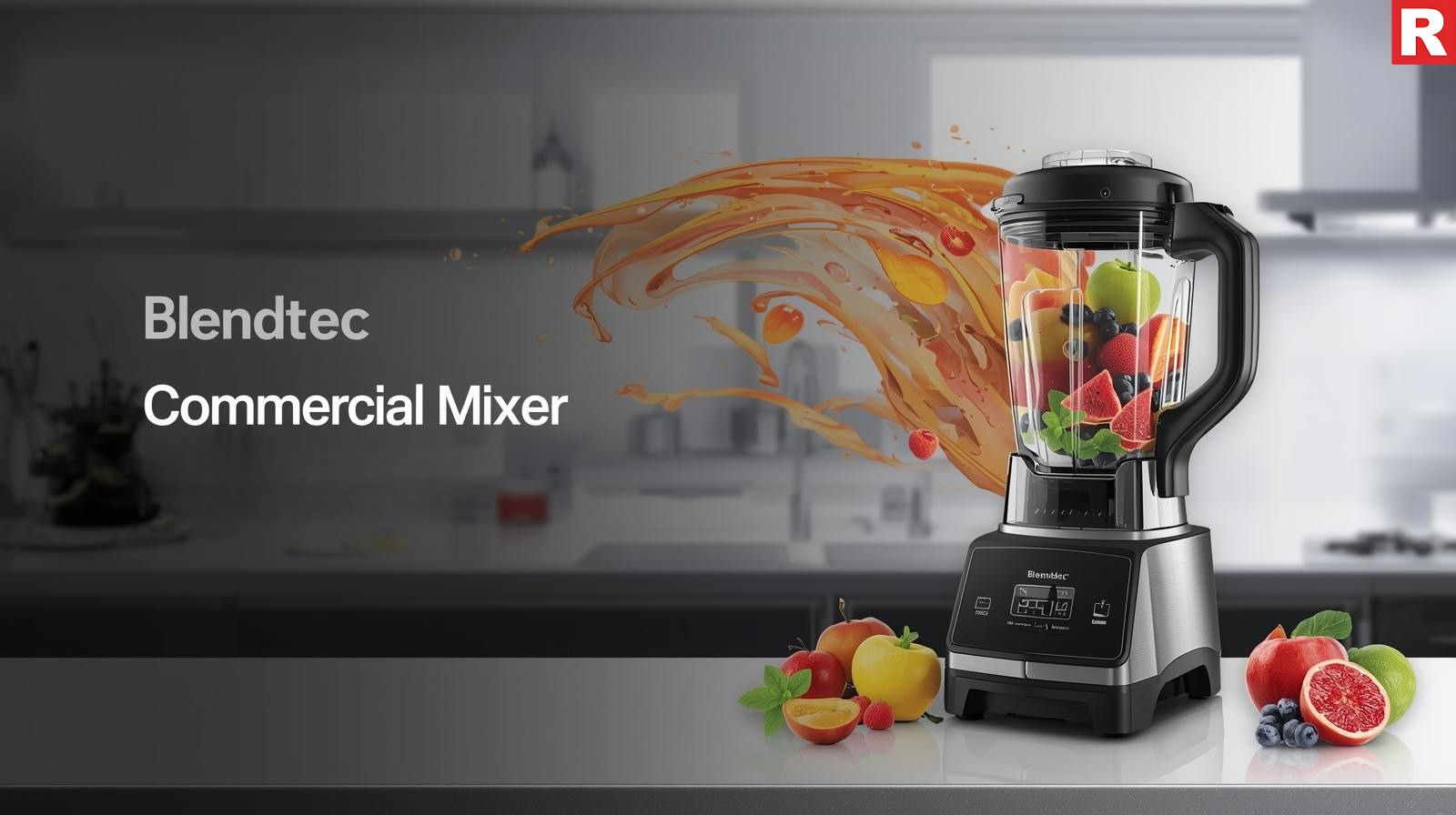
Blendtec, another industry leader renowned for its innovative designs and pre-programmed cycles, is a direct rival of Vitamix. Their distinctive soft blades, which are safer and more durable than conventional sharp blades, are a hallmark of their commercial blenders. The main selling feature of Blendtec is its "pre-programmed" settings, which let a chef choose a particular cycle for a task (such as making soup, milkshakes, or smoothies), and the machine automatically modifies its duration and speed to always produce the ideal blend. A busy kitchen can greatly benefit from this automation since it guarantees consistency and eliminates the need for manual monitoring. Additionally, Blendtec has models with sound barriers, which makes them an excellent option for cafés with open kitchens or where minimizing noise is a top concern.
What's new: Top Tea Brand options to consider for Restaurateurs in India
3. Hamilton Beach Commercial
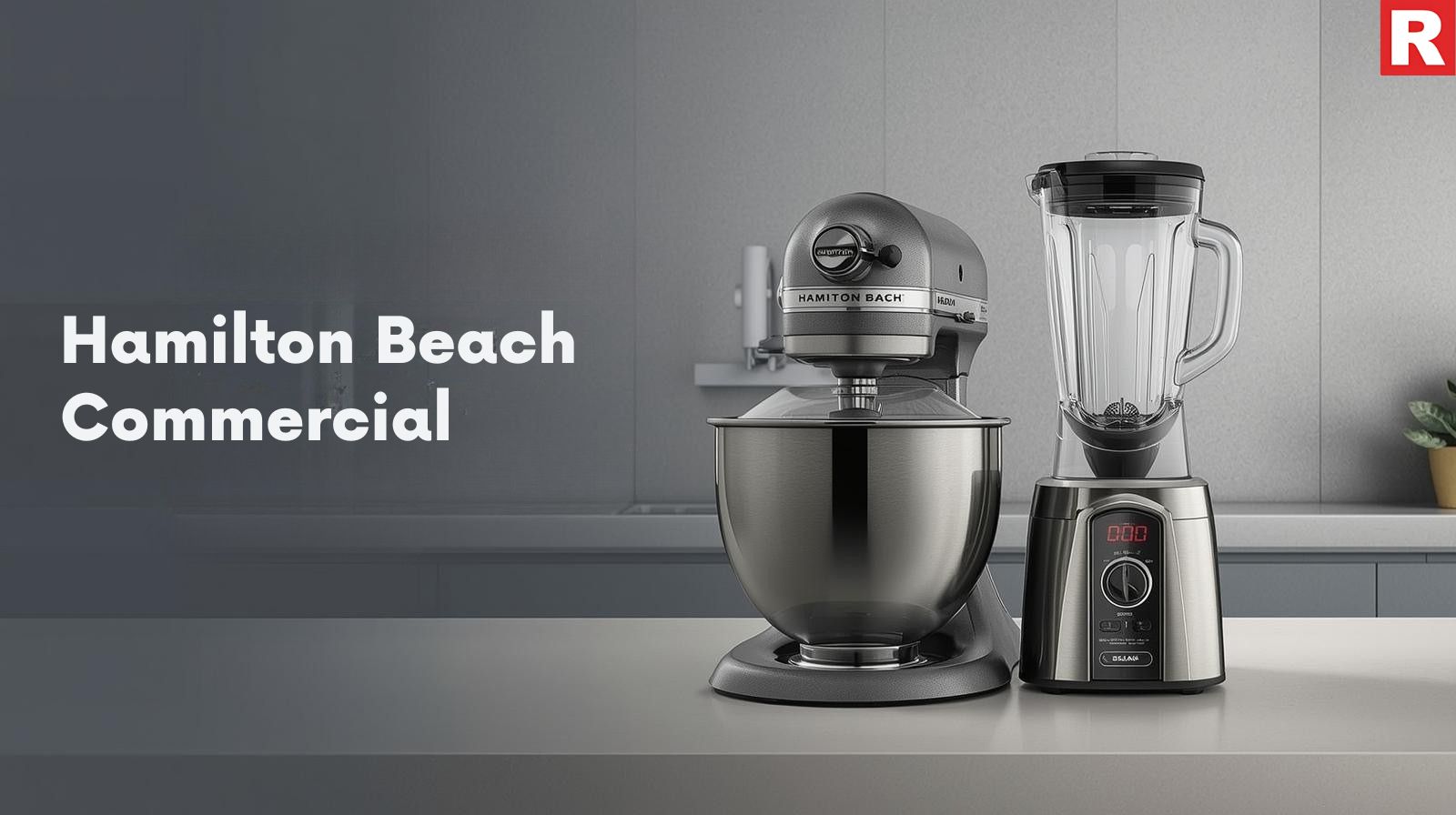
Many mid-to-high-range restaurants in India, like Hamilton Beach's commercial line, which is a well-known brands in the worldwide hospitality sector. They have a wide range of mixers and blenders that strike a fantastic balance between price and functionality. The brand is well-known for being dependable and adaptable. Their product line ranges from compact versions for bars and cafés to high-volume blenders made for busy smoothie shops. Products from Hamilton Beach Commercial are renowned for their strong motors, tough parts, and logical designs. They provide a range of jar models and sizes, including ones with a sound enclosure, so a business may easily choose the ideal equipment for its demands and price range. They are also a popular option for many restaurants, providing peace of mind due to their broad supply and service network in India.
4. Preethi
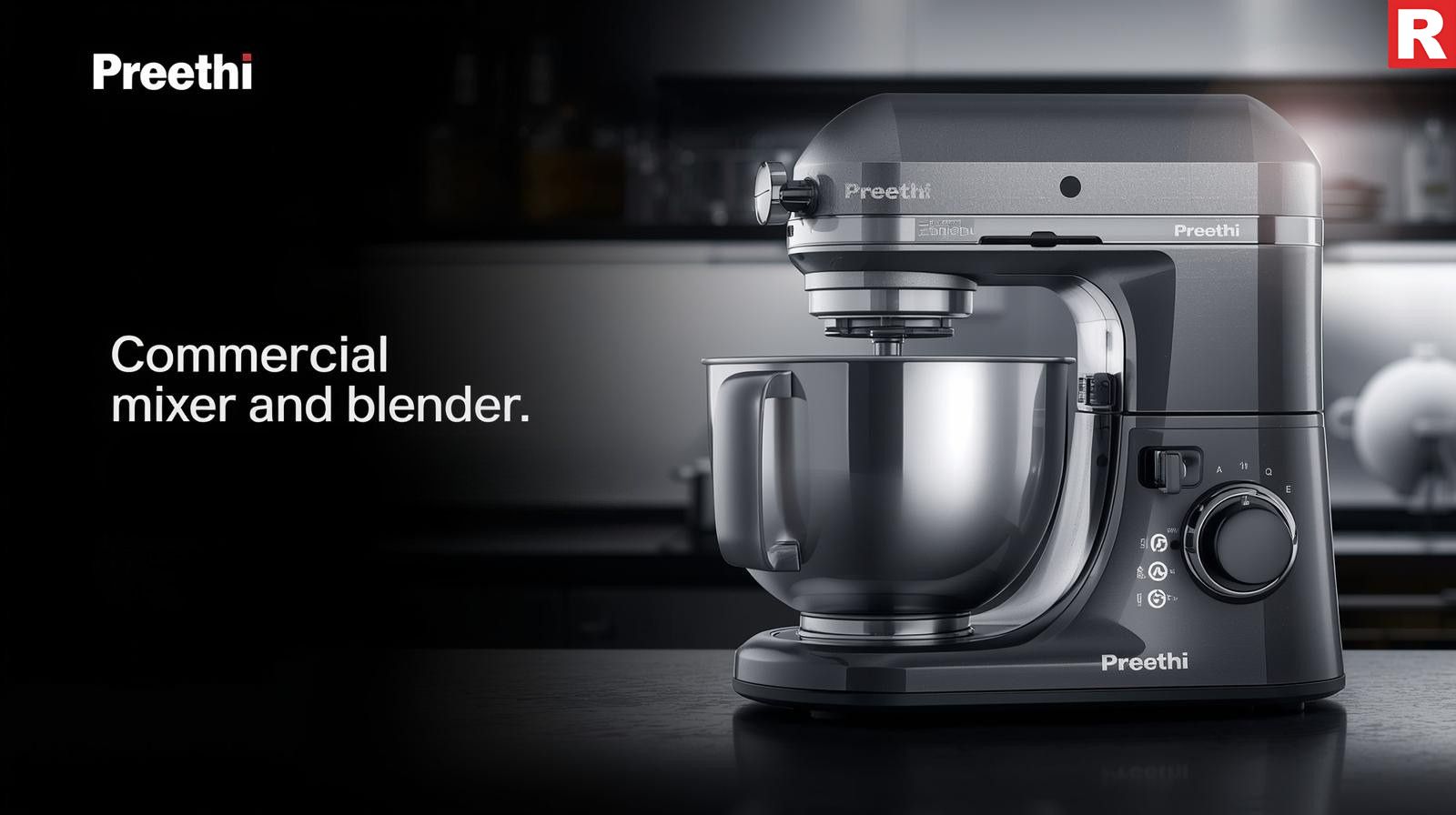
In the Indian market, Preethi is well-known and especially popular for its strong and long-lasting mixer grinders. Their commercial-grade models are made for the rigorous conditions of a restaurant, even though they are a common fixture in many Indian homes. To tackle the demanding tasks of grinding spices, preparing batters (such as dosa or idli batter), and producing thick purees, Preethi's commercial mixer grinders are constructed with sturdy jars and heavy-duty motors. Being able to handle traditional ingredients is crucial for Indian restaurants, which makes them a popular option. A major benefit of Preethi is its wide service network and strong local presence throughout India, which makes maintenance and repairs easily accessible. This is essential for reducing a restaurant's downtime.
Check out: How to Choose the Perfect Spooky Theme for Your Restaurant
Top Eco-friendly Packaging Brands for Restaurants
5. Bajaj Electricals & Philips
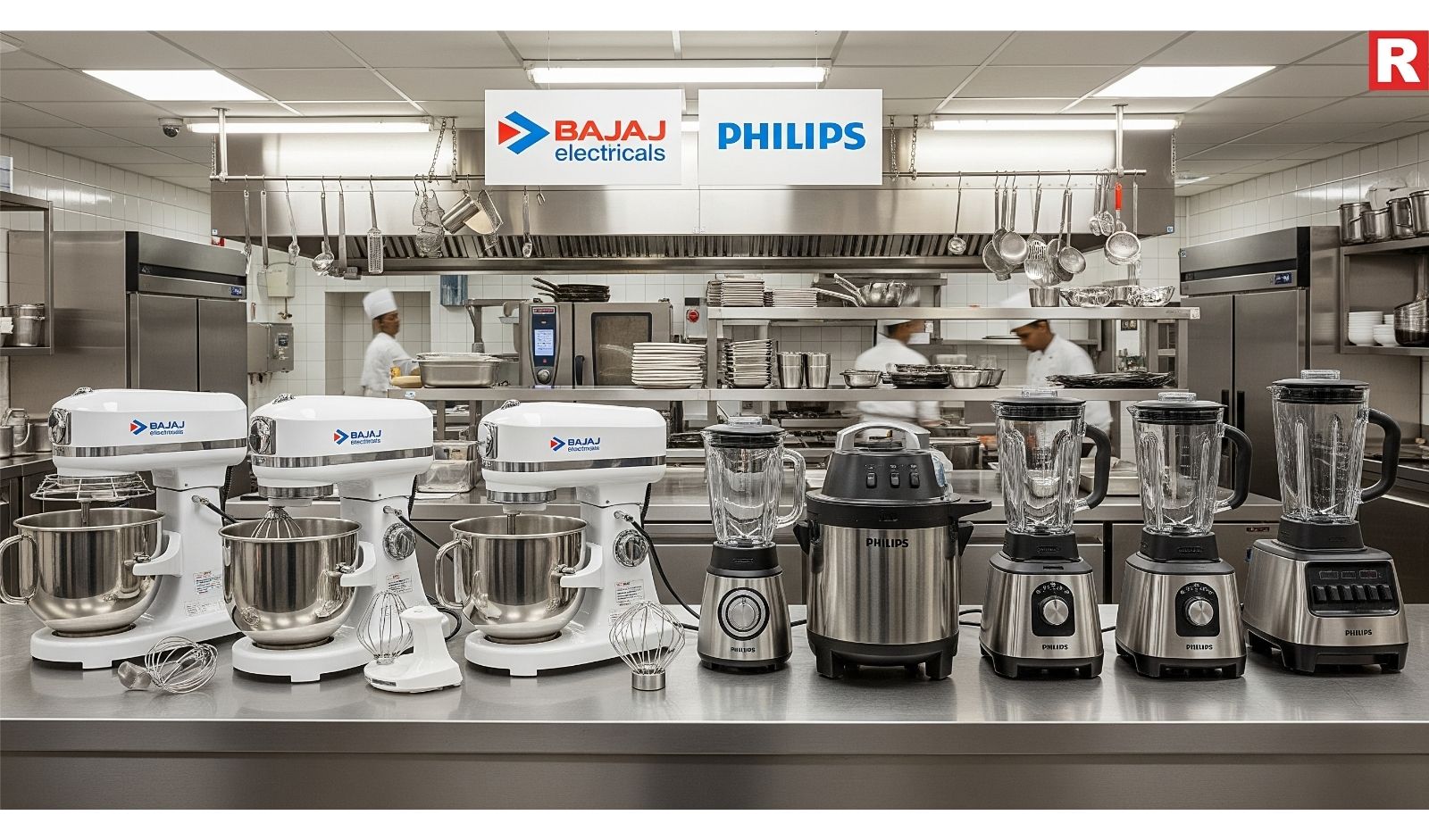
Two additional well-known companies with a significant following in India are Bajaj and Philips. They provide a variety of blenders and mixer grinders that are used in many commercial kitchens. Small to mid-sized cafes and restaurants frequently use their heavy-duty models, even though their main target market is mostly consumers. They are well-known for being dependable, reasonably priced, and widely accessible. Their strong blenders can do a wide range of jobs, from grinding spices to creating milkshakes, and their mixer grinders are adaptable enough for everyday prep work. These companies, supported by their wide service networks, offer a dependable and affordable entry point into the world of commercial-grade cooking equipment for a new restaurant or a business with a tight budget.
Choosing the Right Blender for Your Restaurant's Menu
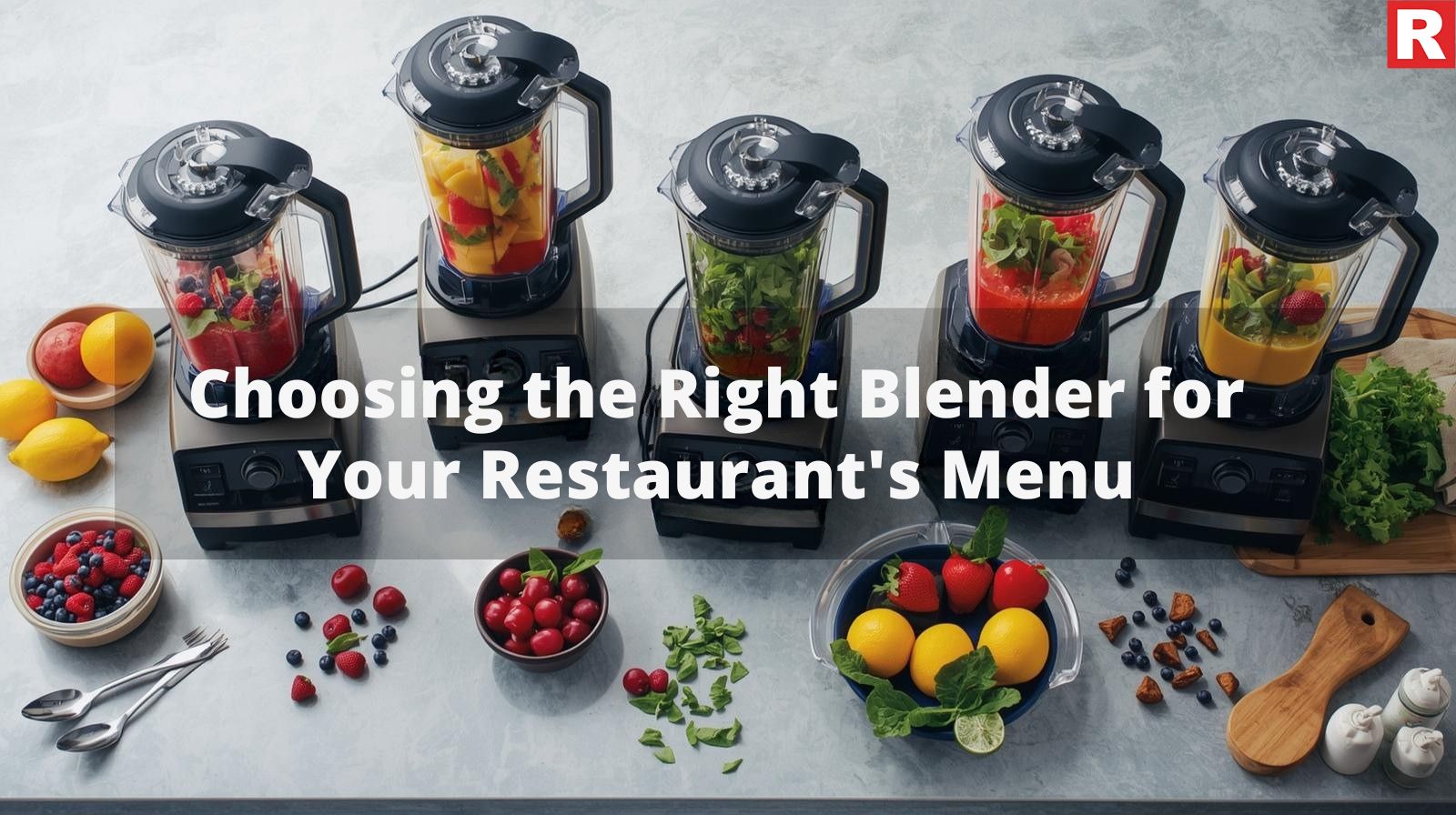
The menu and the particular uses of the blender will determine which one is best for your restaurant.
- For Smoothie & Juice Bars: If your business specializes in smoothies and juices, you'll need a powerful engine and a large jar for your high-speed blender. Because they can easily smash ice and fibrous fruits, brands like Vitamix and Blendtec are the best option for creating a smooth, uniform beverage with little air pockets.
- For Fine-Dining & Gourmet Kitchens: Texture and consistency are crucial in a gourmet setting. For making smooth, lump-free gravies, purees, and sauces without any grainy texture, a Vitamix or a high-end Blendtec is ideal. Chefs can always obtain the ideal consistency thanks to their precise controls.
- For Indian Restaurants: A sturdy mixer grinder from Preethi or Bajaj is necessary for a classic Indian restaurant. These devices are designed to manage the demanding tasks of preparing batters for dosas and idlis, grinding spices for masala mixes, and creating thick chutneys. Their robust jars and strong motors are made especially for these jobs.
- For Cafes & Bars: A mid-level commercial blender from Hamilton Beach Commercial is a fantastic option for a tiny business that needs a multipurpose tool for a number of jobs. They can be used to prepare soups, milkshakes, and cocktails without spending a lot of money.
Read this: Best Frozen Food Brands for Quick Service Restaurants
Conclusion
Every piece of equipment is essential in the tough game of managing a profitable restaurant. Investing in a high-quality industrial mixer or blender is not an extravagant purchase; instead, it is a strategic investment in efficiency, consistency, and the overall quality of your product. Every brand mentioned in this article has a different value proposition. You can choose the ideal gadget that will not only satisfy the needs of your kitchen but also serve as an enduring companion on your culinary adventure by carefully weighing your menu, volume, and budget. A modern kitchen's engine is a good blender or mixer, which allows chefs to concentrate on their creativity while maintaining the constant quality that attracts repeat business.

Given how popular coffee has become, it might be impossible for any other competitor to compete at all. However, tea continues to be the undefeated winner in India, making coffee a second-choice beverage. A daily morning ritual, a conversation starter, and an emotion, tea is more than just a beverage. It is so ingrained in Indian culture that you can obtain a cup of tea or chai from large restaurants to little street vendors. Also, tea lovers visit restaurants just in search of the highest-quality tea. Therefore, locating the highest-quality tea leaves is like discovering gold for restaurants. Because the more satisfied customers are, the more important it is for their brand's reputation. Given that restaurant and cafe owners wish to succeed in their business, choosing the best tea brand is crucial for them.
Therefore, in this article, we will be listing some of the famous and most used brands in Indian restaurants and cafes. It highlights what makes them a favorite among customers and an ideal choice for business owners. We will look at each brand's strengths, from their varied range of goods to their supply chain dependability and their role in turning the common chai into a gourmet offering.
Read more: 5 Key Strategies to Focus While Rebranding your Restaurant
The Evolving Tea Market in the Indian Hospitality Sector

In India, there are two levels to the enormous tea market. One side consists of the typical loose-leaf tea granules that are used to make the traditional masala chai. However, due to the influence of global tea culture and health-conscious customers, a new market has formed. This category covers a broad range of herbal infusions as well as specialized teas like white tea, oolong tea, and green tea. It is now expected of modern cafés and fine-dining venues to provide a varied tea menu that satisfies customers' interest in international flavors as well as their fondness for classic chai.
As a result of this demand, specialized businesses that target the business-to-business (B2B) hospitality market have grown in popularity. These companies are aware of the particular requirements of cafés and restaurants, which include reliable quality, bulk packaging, affordable prices, and a stable supply chain.
The Top Tea Brands in the Indian Market for Restaurants
This is a carefully selected list of the most well-known and popular tea brands in the Indian food service sector, each of which offers something special.
1. Tata Tea

With its headquarters located in Mumbai, Tata Tea is a dominant force in the Indian tea market and a household name that is closely associated with quality and trust. Due to their huge scale, they are the preferred choice for busy cafés and restaurants that require a dependable and reasonably priced supply of tea for their everyday operations. With well-known flavors including Tata Tea Premium and Tata Tea Gold, Tata Tea's wide range of products suits a variety of palates and price ranges. The standard for making traditional masala chai is Tata Tea Premium, which is renowned for its steady, potent flavor and CTC (Crush, Tear, Curl) leaves.
Many people like Tata Tea Gold, a blend of CTC and long leaves, as a premium brew because it provides a richer, more aromatic taste. Tata Tea has an affordable price range that makes it a top option for a wide number of restaurants around the nation, from little chai stalls to massive industrial kitchens, even though specific pricing varies depending on bulk orders. For companies of all sizes seeking a tea renowned for its consistent taste and consistency, they are a safe and dependable partner due to their well-known brand and easy accessibility.
Know more: Best Food Festivals Every Foodie Must Attend
2. Taj Mahal Tea (Brooke Bond)
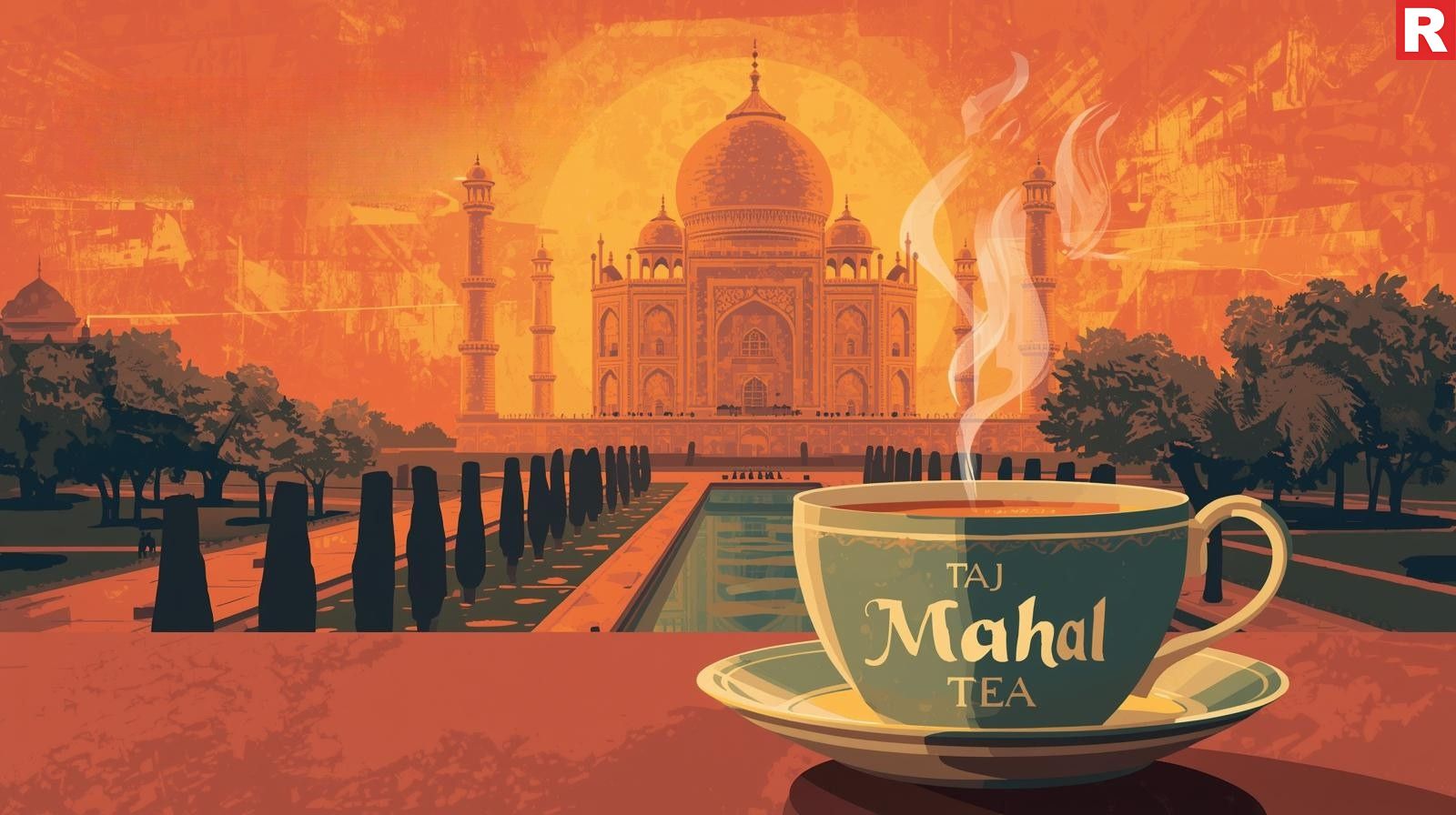
Mumbai-based Taj Mahal Tea is the signature product of the Brooke Bond family, known for its recognizable "wah Taj" advertisement and a heritage in the luxury tea industry. For cafes and luxury restaurants looking to market their chai as a high-end product, this brand is the selection. Sourced from carefully chosen, premium leaves from Assam and other premier tea-growing locations, Taj Mahal Tea is well-known for its distinct scent and rich, full-bodied flavor. When brewed with Indian spices, its long-leaf formula offers it a superior taste that holds its own, making it the ideal base for a spicy ginger tea or an aromatic masala chai. Although it costs a little more than other mass-market teas, its exceptional quality makes it worth the money for businesses looking to give their customers a unique and elegant tea experience.
3. Organic India

Organic India, based in Lucknow, Uttar Pradesh, has distinguished itself in the market by emphasizing sustainability and well-being. For organic restaurants, yoga centers, and health-conscious cafes that serve customers who value ethical sourcing and well-being, this brand is a great option. Their Tulsi Tea line is well-known and a favorite among customers looking for a caffeine-free, healthful beverage. The company's certified organic goods come in a range of infusions, including ginger, lemongrass, peppermint, and chamomile, and are prepared from leaves cultivated on their own sustainable farms. These herbal infusions are ideal for a varied menu and make a fantastic substitute for regular tea. Although their products are more expensive than traditional teas, their value in terms of health advantages and brand alignment with a socially aware image make them an attractive partner for companies trying to build a name for themselves in the wellness market.
What's new: Top Eco-friendly Packaging Brands for Restaurants
4. Wagh Bakri Tea

Wagh Bakri Tea, a well-known name in the Indian tea market, has a century-long history and is based in Ahmedabad. For cafés and quick-service restaurants that require a premium, flavorful tea for daily use, this brand is a popular option. Chai enthusiasts instinctively trust Wagh Bakri's steady blend and well-balanced flavor profile. Their name, which means "tiger and goat," represents a perfect combination that all people, regardless of their social status, can enjoy. Their leaves are expertly chosen to offer the ideal mix of strength and aroma, and they are sourced from premium tea gardens. To meet the changing needs of the market, they provide a range of herbal mixes and green teas in addition to their traditional black tea. Many restaurants throughout the nation use this brand because of its dependability and reputation for providing a traditional, flawless cup of chai.
5. Lipton Tea (Unilever)

Lipton Tea, an international business with a significant following in India and a Mumbai headquarters as a division of Unilever, is well-known for its convenience and diversity. Hotels and restaurants that need to provide a large assortment of teas in a single-serve size favor this brand. Popular tastes, including traditional black tea, lemon tea, and several green tea infusions, are among Lipton's products, which are mostly sold in tea bags. The brand is a flexible option for a varied menu because it also offers particular herbal blends, such as Lipton Green Tea with Mint. Because it speeds up the brewing process and saves space, this product style is perfect for quick-service counters, in-room dining, and breakfast buffets. Lipton is an important and dependable partner for businesses looking to offer customers a speedy, hassle-free tea service because of its extensive availability and reputation as a tea bag model holder.
Check out: Top Tea & Coffee Brewer Brands in India These Days
Top Eco-friendly Packaging Brands for Restaurants
6. Goodwyn Tea

Known for its premium, fragrant blends and direct-from-garden sourcing, Goodwyn Tea is a rising powerhouse in the specialty tea market, with its headquarters located in Kolkata. By using a farm-to-cup business strategy, they guarantee that the tea is as fresh as possible when it is delivered to the customer. For cafés and tea lounges looking to provide a carefully selected and elegant tea experience, this brand is a great option. They have a large selection of black, green, white, and oolong teas in addition to a well-liked line of herbal and flavored infusions. Their unique flavors, which are ideal for a non-dairy tea menu, include Moringa Mint, Hibiscus Cinnamon, and a traditional chamomile tea. The premium quality and freshness of the leaves are reflected in the mid-to-high price range. Goodwyn is a great partner for businesses trying to further develop their tea options and satisfy a selective customer base because of its dedication to providing a premium, fresh product.
7. Vahdam Teas

A pioneer in the Indian tea market, Vahdam Teas was established in New Delhi and is well-known for its creative e-commerce strategy that sends fresh, single-origin teas straight to consumers all over the world. Luxury hotels, premium restaurants, and specialized cafes that value excellence, openness, and an original narrative are ideal matches for this brand in the Indian B2B market. Delivering garden-fresh products, Vahdam draws its teas from India's finest gardens, such as those in Darjeeling, Assam, and the Nilgiris. They have a wide selection of medicinal and flavored teas, as well as rare and single-region teas. Popular kinds of Vahdam include a pure Chamomile Herbal Tea, Lemon Ginger Masala Chai, and Turmeric Spiced Herbal Tea. They are a great option for companies looking to develop a really special tea menu since, despite their higher price range, their better quality and premium packaging offer an unmatched luxurious tea experience.
Read this: Top Restaurant Decor Brands in India
Conclusion
India's fondness for tea is unchanging, even in the face of international coffee dominance. The contemporary Indian restaurant and café recognizes that a properly prepared cup of tea is a crucial component of the welcoming atmosphere. From the heritage of Taj Mahal and Wagh Bakri to the inventiveness of Organic India, Goodwyn Tea, and Vahdam Teas, the brands featured in this article are the unnoticed collaborators that enable businesses to create success. One cup at a time, restaurateurs can create an engaging brand story in addition to serving an excellent beverage by carefully selecting their tea supplier. With the ideal balance of quality, innovation, and tradition, tea's future in Indian hospitality is bright.

In the competitive restaurant market of India, where new restaurants keep popping up every now and then, keeping up with the competition becomes tough. And more tough is attracting customers to your restaurants from the sea of many. This is why you need to distinguish your restaurant from the other ones so that customers can find your restaurant easily and be impressed by it. One such way of doing this is to open a themed restaurant. Themed restaurants are all the rage these days, where people who are looking for a new and unique experience come. If you are confused about what theme would suit your restaurant, then we have an idea for you. How about opening a spooky theme restaurant? This will surely attract a lot of horror enthusiasts and provide a magnificent experience to the customers if executed properly.
So, how does one create a spooky theme restaurant? That aside, how to actually choose a spooky theme that is perfect for you? This is what this article is all about. From the design to the food, menu, and attire, every factor contributes to the narrative of your restaurant. So, in this article, we will be helping you choose the spookiest theme for your restaurant and also tell you how to execute it properly.
Read more: Best Frozen Food Brands for Quick Service Restaurants
Defining Your Spooky Theme

The term spooky doesn’t refer to any specific genre or decoration. It is a vast and diverse universe. So, to create a perfect spooky theme, you need to think about the conventional ghosts, cobwebs, or pumpkins, and pinpoint a specific niche. A theme that is well-defined and identified is much easier to market, more attractive to customers, and much simpler to execute. Below are some sub-genres of the spooky. Let’s take a look at them and their potential for your restaurant:
Classic Gothic Horror

Taking cues from works of literature such as Mary Shelley's Frankenstein or Bram Stoker's Dracula. Dark, dramatic aesthetics—think elaborate chandeliers, velvet curtains, antique furniture, and candlelight—are what define this type of design. It is ideal for a fine-dining or cocktail bar concept and creates an air of mystique from the past.
Know more: Top Tea & Coffee Brewer Brands in India These Days
The Haunted Asylum

A darker, more dramatic concept that capitalizes on psychological terror is The Haunted Asylum. Chipped paint, corroded metal fixtures, and dim, flickering lights would make for a harsh and unsettling interior design. "Unhinged" or "experimental" foods can be on the menu. This theme appeals to a specialized, thrill-seeking audience since it is high-risk, high-reward.
What's new: Top Eco-friendly Packaging Brands for Restaurants
Witchcraft and Folklore

A more magical and enchanted approach is provided by witchcraft and folklore. Crystal balls, apothecary bottles, magic books, and organic elements like moss and twisted branches can all contribute to this theme's visual richness. It enables a creative menu featuring foods with magical names and beverages that resemble potions. This is a fantastic option for a bohemian-style restaurant or a whimsical café.
The Zombie Apocalypse

A contemporary topic with elements of pop culture. Boarded-up windows, improvised barriers, and caution tape would all be part of the post-apocalyptic, industrial décor. With "brain-matter" cocktails and "survival-kit" platters, the menu might be lighthearted. For a themed pub or casual eating restaurant looking to draw in a younger, social media-savvy customer base, this concept is perfect. Dr. Zombie - Restaurant and Beyond in Connaught Place, New Delhi, is also a restaurant based on this theme.
Indian Folklore and Paranormal

For a local market like India, the theme of Indian folklore and the paranormal has tremendous potential. In India, the word "spooky" refers to an entire universe that is home to a wide variety of supernatural beings. Consider the following sub-genres of the spooky and their potential for a restaurant concept:
- Indian Folklore: The most powerful and culturally significant theme is Indian folklore. A profoundly dramatic and culturally unique experience can be produced by drawing inspiration from the stories of bhoots (ghosts), pret (vengeful spirits), chudails (female demons), and pishachs (flesh-eating demons). A "Haunted Haveli" restaurant, which tells the narrative of a maharaja and his malevolent spirit, or a "Jungle of the Pret" restaurant, which focuses on spooky forest spirits, are two possible restaurant themes.
- The Chudail's Den: Inspired by tales of tantrics and dain (witches), the Chudail's Den is a more magical and enchanted theme. Rudraksha beads, yantra symbols, antique patras (scrolls), and shelves brimming with mysterious jars and concoctions would all contribute to the visually stunning décor.
- The Gufa of the Yaksha: This subject, which is based on the legendary and much-feared nature spirits, can be carried out with an emphasis on pure, natural elements and cave-like constructions. Dim lighting, stone-like textures, and a menu that seems like a "hidden treasure" from a vanished civilization would create an intriguing and prehistoric atmosphere. This is a high-concept theme that appeals to those looking for a genuinely immersive and one-of-a-kind dining experience.
Decide on the spooky theme first before moving towards the ambiance of your restaurant. Like Halloween The Dark World in Sitapuri, New Delhi has a Halloween theme.
Check out: From Flavor to Emotion: The Future of Experiential Restaurants
Top Restaurant Decor Brands in India
The Art of Ambiance

The next step after selecting a topic is to make it come to life through a multisensory experience. Just hanging a few Halloween decorations isn't enough. A permanent, realistic world is key to a great eerie theme.
- Lighting: The most effective weapon in your toolbox is lighting. For a frightening vibe, lighting must be strategically dimmed. To add depth and drama, combine task, ambient, and accent lighting. Flickering lanterns and antique candlesticks are ideal for a Gothic theme. Use flickering sconces, classic mashaal (torches), and ancient diyas (oil lamps) for a Haveli feel. Use spotlights or stark, single bulbs to generate shadows for a more contemporary horror vibe. Blood-red or eerie-green colored LED lights can be employed for effect.
- Props and Décor: Each item of furniture and prop should contribute to the story. Purchase props from specialty prop makers, flea markets, or antique stores. Consider faded tiles, rusty chains, and ancient hospital beds for a spooky asylum theme. Use boiling pots, mortar and pestles, and shelves brimming with mysterious jars to create a witchcraft vibe. Purchase goods from Puranan Bazaar marketplaces, Indian antique stores, or specialized prop creators. Consider brass trunks, antique charpais (rope beds), elaborate wooden carvings, and old photographs featuring ghostly figures for a haunting Haveli theme.
- Soundscape: Sound is an important but frequently disregarded component. A diner can get chills with the proper sound. Stay clear of generic eerie sound effects. Make a soft, multi-layered soundscape instead. This might be anything from a classical raga played on a loop, the sorrowful tune of a bansuri (flute), the faint sound of ghungroos (anklet bells), or a distant temple bell. The music should never overshadow discussion but should be a persistent, unsettling presence.
- Scent: Emotion and memory are closely linked to the sense of smell. An eerie aroma might be an effective weapon. Think of a subtle scent that suggests ancient rites, such as moist dirt, old manuscripts, or a special blend of spices. Steer clear of strong smells that could dominate the food's aroma. Like the smell of a rotten corpse would be great, but it might be too unsettling for your customers.
Haunted Restaurant in Mylapore, Chennai, has a perfect combination of all these elements that make its ambiance truly spooky.
Menu, Staff, and Storytelling

Decor is something that stages the narrative. But the menu, staff, and storytelling are what will fuel the narrative.
- Menu: The main purpose of the restaurant is to serve food. The food menu is where you can truly appreciate the concept. There should be a name and description for each dish and cocktail that corresponds with the theme. Dishes like "Kali's Brew" (a dark, rich coffee-based beverage) or a "Bhoot Jolokia Curry" could be on a menu with a gothic theme. A "Brain-Eating Burger" or a "Zombie Antidote" cocktail might be served with a zombie theme. The Just Behind You restaurant in Rajouri Garden, New Delhi, gives a welcome drink in test tube glasses to its customers.
- Employee Uniform and Training: Your employees serve as the face of your spooky business. The costume should include their uniforms. Employees could dress in old-fashioned maid or butler uniforms for a haunted home theme. They could dress in mystical-looking clothing or dark cloaks for a witch theme. Above all, teach your employees to behave honorably. They ought to be familiar with the restaurant's history, its "hauntings," or the folk tales behind the concept. They can turn a delicious dinner into a memorable performance.
- Interactive Storytelling: A spooky theme restaurant needs its own spooky storytelling. This can be as easy as including a brief, entertaining story on the menu or as complex as having actors go around the restaurant and engage with customers. Like an old man on the front gate of your restaurant that warns customers about the danger ahead. The feeling of surprise and interaction make the encounter social media-worthy and viral. Like in Scary Mansion Lounge And Bar in Malviya Nagar, Jaipur, Rajasthan, customers can have drinks on top of a fake coffin.
Read this: How Farm-to-Table Restaurants Have Become Trendy These Days
Marketing Your Spooky Restaurant

A great spooky theme is useless if no one is aware of it. Your theme needs to be as creative as your marketing plan.
- Visual-First Marketing: Excellent photography and videography should be a major part of your marketing campaigns. The primary selling aspect of your restaurant is its appearance. Showcase the staff in character, the food with unusual names, and the décor with expertly taken pictures and films. This visual material is ideal for viral platforms like Facebook, Instagram, and Twitter.
- Influencer Partnerships: Join forces with lifestyle influencers, food bloggers, and content creators with a horror theme. Organize a launch party or a special "sneak peek" for them. Their real reviews and interesting material have the power to create a lot of talk and increase foot traffic.
- Promotions and Themed Events: Arrange unique activities centered around your topic. This may be a "Paranormal Investigator's Night," a "Murder Mystery Dinner," or a Halloween-themed party (which ought to be a regular occurrence for you). These gatherings give customers a reason to return and support the development of your brand as a destination for thrilling experiences.
Conclusion
Selecting and implementing a spooky theme for a restaurant in India is a big task that calls for creative thinking, careful preparation, and a solid understanding of your target market. When executed well, this daring decision has the potential to turn a modest dining restaurant into a well-known entertainment destination. The choices are boundless, ranging from the fun anarchy of a zombie-themed cafe to the chilling beauty of gothic horror. Restaurant owners in India can establish a unique market niche by painstakingly creating an engaging atmosphere, a dramatic menu, and an interesting story.

It's been about 118 years since the discovery of plastic. And since then, the total production of plastic waste has accumulated up to 6.3 billion tonnes. This has turned into a big issue that needs to be solved as soon as possible. A recent study showed that a big chunk of plastic waste is created by the food and beverage industry (F&B). To reduce the use of plastic and help the environment, the government imposed strict laws on the usage of plastic by the food and beverage sector. This led to a big problem for the industry, as the industry needs plastic as a packaging source for many products. In fact, the restaurants suffered the most because they needed a good packaging source for deliveries and takeouts. But a solution has been discovered for this problem and has been actively used by many restaurants. That is, eco-friendly packaging.
The eco-friendly packaging is made from materials that are biodegradable and also durable. Many brands are creating eco-friendly bags and containers that can preserve food for a long time. In this article, we will be looking at the top brands that are the driving force in this sector. These brands are not just providing an alternative to plastic; they are innovating this industry and gradually bringing a change to the restaurant industry.
Read more: Best Frozen Food Brands for Quick Service Restaurants
The Importance of Sustainable Packaging in the Food Industry
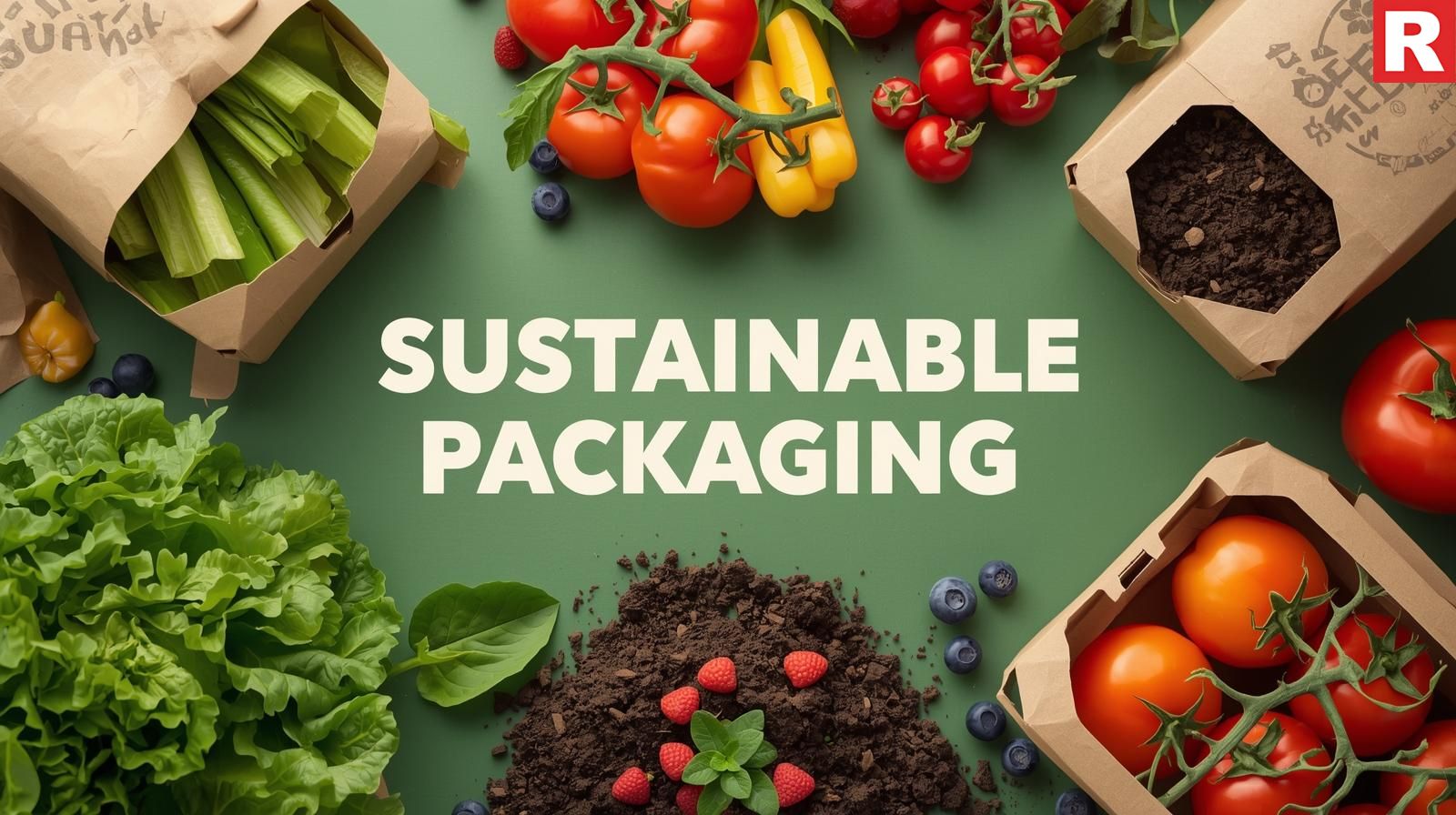
The rise of food-delivering platforms like Swiggy and Zomato has created a situation where the convenience only comes at the price of the environment. As much as modern dining is popular, so is its impact on the environment. There is a mountain of non-biodegradable plastic containers, cutlery, and bags that have become a byproduct of modern dining. And the customers who are environmentally conscious are not happy with it. They need a restaurant that aligns with their restaurants and uses eco-friendly packaging only. Therefore, there are multiple benefits of a restaurant can gain from moving towards sustainable packaging:
- Improved Brand Image: It draws in a loyal customer base by projecting the business as responsible and progressive.
- Regulation Compliance: Since single-use plastics are now prohibited by governments and localities all over India, sustainable packaging is now required instead of being a choice.
- Customer Loyalty: According to a Nielsen study, 66% of consumers worldwide are willing to pay more for goods from environmentally friendly businesses.
- Decreased Environmental Footprint: The biggest advantage is the decrease in resource usage, carbon emissions, and plastic waste.
Making the switch to eco-friendly packaging is a difficult task that requires restaurants to strike a balance between price, durability, and aesthetics. Thankfully, an entirely new generation of Indian companies has stepped up to the opportunity, providing creative answers to these problems.
Know more: Top Tea & Coffee Brewer Brands in India These Days
Understanding the Materials: A Guide to Sustainable Packaging

Before we look into the top brands, it is crucial to understand the materials they work with. The definition of the term "eco-friendly" can refer to a variety of categories, each with distinct characteristics and effects on the environment.
- Compostable Materials: Plant-based materials such as bamboo, maize starch, and bagasse (sugarcane pulp) are used to make these items. In a commercial composting facility, they decompose in a matter of months, producing nutrient-rich soil.
- Biodegradable Materials: Microorganisms can break down biodegradable materials over time, although the process can be sluggish and may result in the formation of microplastics. Compared to compostable products, it's a less desirable choice.
- Recycled Content: Packaging composed of recycled plastic, cardboard, or paper helps keep materials out of landfills and lowers the need for new resources.
- Edible Packaging: Although it's still a relatively new trend, several businesses are experimenting with packaging that may be consumed with the meal, such as seaweed or rice flour.
The listed brands offer a wide variety of products to meet various restaurant needs, specializing in a mix of these materials.
Top Eco-friendly Packaging Brands for Restaurants in India

Below are the top brands that lead the eco-friendly packaging industry. They are the first to offer the restaurant industry creative and eco-friendly packaging options.
Ecoware

Location: Noida, Uttar Pradesh, India (Headquarters)
Specialty: Producing and distributing packaging that is entirely biodegradable and compostable using renewable resources.
Type of Material: Bagasse (sugarcane fiber)
Usage/Good For: Disposable bowls, plates, cutlery, portion cups, and food containers (such as clamshells and meal trays). Great for dry, damp, hot, and cold foods. Safe for the freezer and microwave.
Degradability: Compostable
Price range: Larger containers may cost between ₹8 and ₹20, while disposable plates might cost between ₹3 and ₹5 per piece.
About Ecoware:
Since its founding, Ecoware has built a solid reputation as a reliable brand, making it a pioneer in India's compostable packaging market. Their main resource, bagasse, is a relatively abundant and sustainable byproduct of processing sugarcane. According to international standards like ASTM D6400 and EN 13432, Ecoware's products are 100% biodegradable, which means they entirely decompose into natural components without leaving behind any harmful residue. This is a crucial difference from "biodegradable" polymers, which might not completely break down or require particular environmental conditions.
What's new: Top Restaurant Decor Brands in India
Pappco Greenware
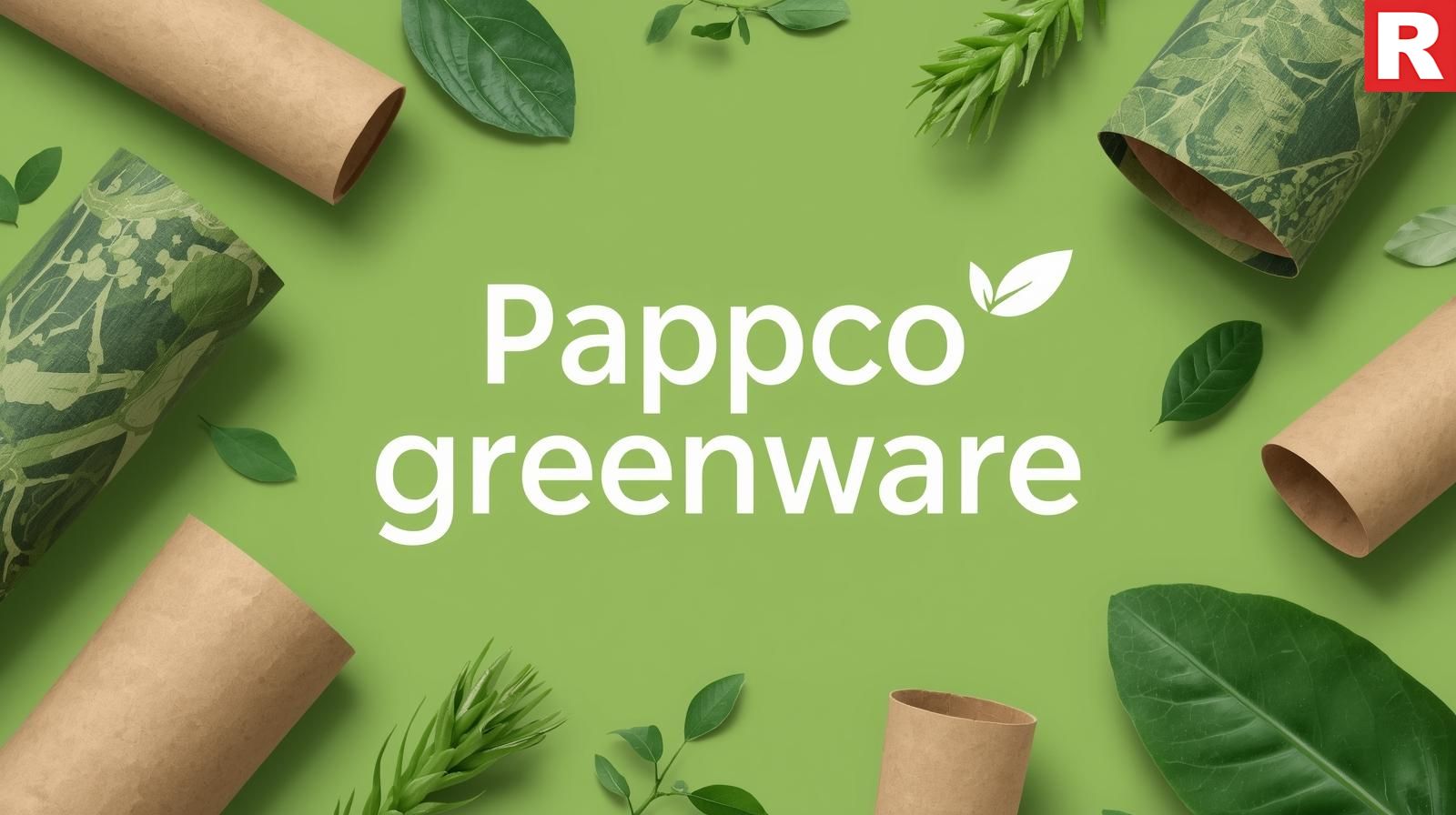
Location: Mumbai, Maharashtra, India (Headquarters)
Specialty: Providing a wide range of eco-friendly and compostable disposable products.
Type of Material: Bagasse (sugarcane pulp), Corn Starch (PLA), Bamboo, Paper
Usage/Good For: A broad variety that includes food trays, whisks, bowls, clamshells, glasses, cutlery, and plates. It works well with a variety of food types and temperatures.
Degradability: Compostable
Price range: A pack of 50 bagasse bowls can be around ₹250-₹350, while clamshell containers might be priced from ₹10-₹25 per unit.
About Pappco Greenware:
With its wide range of products, Pappco Greenware has swiftly emerged as a significant force in the sustainable packaging sector. Their goal is to "make plastic disposables history" and provide a range of options to meet the needs of various restaurants. They are an important component of the sustainable economy since their goods are made from renewable agricultural byproducts, particularly sugarcane and maize starch. For some product lines, they also use paper and bamboo, providing a wider range of environmentally friendly choices.
Pappco stands out due to its emphasis on providing a comprehensive solution. They offer a variety of specialty items, including coffee cups, stirrers, and portion cups, in addition to basic plates and containers, enabling a business to completely switch to environmentally friendly disposables.
Chuk

Location: Ayodhya, Uttar Pradesh, India (Headquarters)
Specialty: Manufacturing and supplying 100% compostable tableware.
Type of Material: Bagasse (sugarcane fiber)
Usage/Good For: Superior containers, lunch trays, bowls, and plates. All meal varieties can be prepared using this oven-safe, microwave-safe, and long-lasting product.
Degradability: Compostable
Price range: Plates and bowls are priced per piece or in bulk packs, typically ranging from ₹5 to ₹15 per unit.
About Chuk:
A member of the CK Birla Group, Chuk is a cutting-edge brand from the famous Orient Paper & Industries. Chuk has an advantage thanks to its support in terms of scale, technology, and quality control. Their commitment lies in creating a variety of dinnerware that is not only safe and practical, but also visually appealing. Even for a takeout lunch, their goods' sleek, simple design improves the dining experience.
Their products are a popular option for cafés and fine-dining establishments that wish to preserve a high-end brand image because of their reputation for robust construction and luxurious feel. They are free of plastic coatings and dangerous chemicals, and they are resistant to leaks and a broad range of temperatures (from freezer to microwave/oven).
Check out: How Farm-to-Table Restaurants Have Become Trendy These Days
Best International Cuisines You Should Try Once
Naturapack

Location: Gurugram, Haryana, India (Headquarters)
Specialty: Supplier and distributor of a variety of environmentally friendly food packaging options.
Type of Material: Bagasse, Paper, Wood (cutlery), PLA (lids, cups)
Usage/Good For: Compostable containers, paper bags, food wraps, corrugated boxes (like pizza boxes), wooden cutlery, and clear PLA cups and lids are all part of this versatile collection. Perfect for a variety of restaurant requirements, providing personalized branding.
Degradability: Compostable (for bagasse, PLA, wood) / Recyclable (for paper/cardboard)
Price range: Varies based on the source and the product. Paper bags and compostable containers are often in the inexpensive to mid-priced category.
About Naturapack:
In the supply chain for environmentally friendly packaging, Naturapack is an essential component. Rather than producing their own goods, they focus on locating and offering a wide range of environmentally friendly products from reputable manufacturers. This business approach enables them to provide a wide range of packaging supplies and solutions in one location, giving eateries of all sizes a practical and flexible choice.
They have a wide variety of products, including wooden cutlery, corrugated boxes for pizza and other baked items, several kinds of paper food wrappers and bags, and compostable bagasse containers. Additionally, they provide customized printing services, which enable restaurants to use their logo and design as a branding strategy on their packaging.
Bio-Lutions

Location: Headquarters in Germany, with a significant manufacturing facility in India (near Bengaluru).
Specialty: Utilizing agricultural waste to develop an innovative self-binding natural fiber material for environmentally friendly dinnerware and packaging.
Type of Material: Agricultural waste (e.g., straw, bagasse, cotton stalk, rice husk)
Usage/Good For: Strong and long-lasting containers, dinnerware, and overall packaging. Ideal for both hot and cold food, it provides a high-quality and durable substitute for plastic.
Degradability: 100% Compostable
Price range: Since the company works with big businesses and on specialized projects, their pricing is usually project-based.
About Bio-Lutions:
A well-known worldwide brand with a sizable presence in India, Bio-Lutions stands out for its innovative production method. They have created a patented process that produces a special self-binding natural fiber from agricultural wastes, including cotton stalk, bagasse, and straw. Because no chemical binders are used in this technique, the goods are entirely natural, chemical-free, and certified compostable. Their goods are renowned for being incredibly strong and long-lasting, competing with conventional plastic and providing a luxurious feel.
Their concept, which addresses waste management and sustainable product creation, has a particularly significant impact on the Indian market, where agricultural waste is abundant. Restaurants and major food service businesses that are dedicated to a completely sustainable and chemical-free supply chain choose Bio-Lutions as their partner because of their creative approach and reliable goods.
Read this: How Indian Restaurants Can Use Food Science to Create Irresistible Dishes
The Future of Food Packaging
India's transition to a sustainable food business is growing. Although these innovative brands offer great substitutes, it is also the duty of customers and companies, ranging from neighborhood restaurants to large franchises, to embrace and encourage these practices. Making the move to environmentally friendly packaging is a smart business move for restaurants that will benefit their long-term environmental sustainability, customer loyalty, and brand reputation. It is an effective technique to demonstrate a sincere concern for the environment and to contribute to the solution rather than the issue.

If mouthwatering food is the heart of a restaurant, then the ambiance and decor are its soul. In the competitive world of Indian hospitality, determining the success of a restaurant is not decided by the menu alone. Nowadays, the restaurant needs to have a good decor to stay and compete with others. Customers have urbanised now, especially the social media-driven millennials and Gen Z people. They seek more than a meal; what they are looking for is a brand new experience. One that captivates them at first glance and keeps them coming for more and more. Every component of the restaurant’s ambiance, from furniture to lighting and design, should contribute to a story that distinguishes a restaurant.
This article explores the potential for transformation of restaurant décor and features some of India's leading restaurant décor brands that are influencing the country's culinary scene going forward. From custom furnishings and cutting-edge lighting to eco-friendly materials and creative displays, these businesses are the hidden talents behind some of the nation's most recognizable and breathtaking restaurants.
Read more: A Modern Guide to India's Fitness-Focused Restaurant Concept
Key Elements of an Irresistible Restaurant Ambiance

It's crucial to understand the fundamental elements of a great restaurant interior to appreciate the work of these décor brands. Every component is essential to the whole sensory experience.
- Furniture: Bar stools, tables, and seating are not just functional pieces; they also determine flow and comfort. Commercial-grade seats from a company need to be long-lasting, comfy, and visually appealing. They set the atmosphere, whether it's the sleek elegance of metal frames or the rustic appeal of wooden tables.
- Lighting: Perhaps the most potent weapon in a designer's toolbox is lighting. Drama, warmth, or lively energy can be produced by it. Lighting-focused brands provide anything from task and ambient lighting to ornamental fixtures like pendant lamps and showpiece chandeliers. It is about creating a multi-layered lighting design that improves the area.
- Flooring and Wall Décor: Wall décor and flooring serve as the backdrop and base of any design and have the power to define an area. These companies offer the supplies and know-how required to achieve a vision, whether it is the raw, industrial appeal of polished concrete floors or the beauty of delicate tile work, or the textural simplicity of exposed brick walls or colorful, artistic murals.
- Art and Installations: A restaurant's custom artwork and installations frequently contribute to its unique personality. A custom sculpture at the entrance, a collection of well-chosen paintings, or an interactive wall that brings nature indoors are all examples of this.
Know more: Fundraising For A Restaurant: How it Works?
Top Restaurant Décor Brands in India
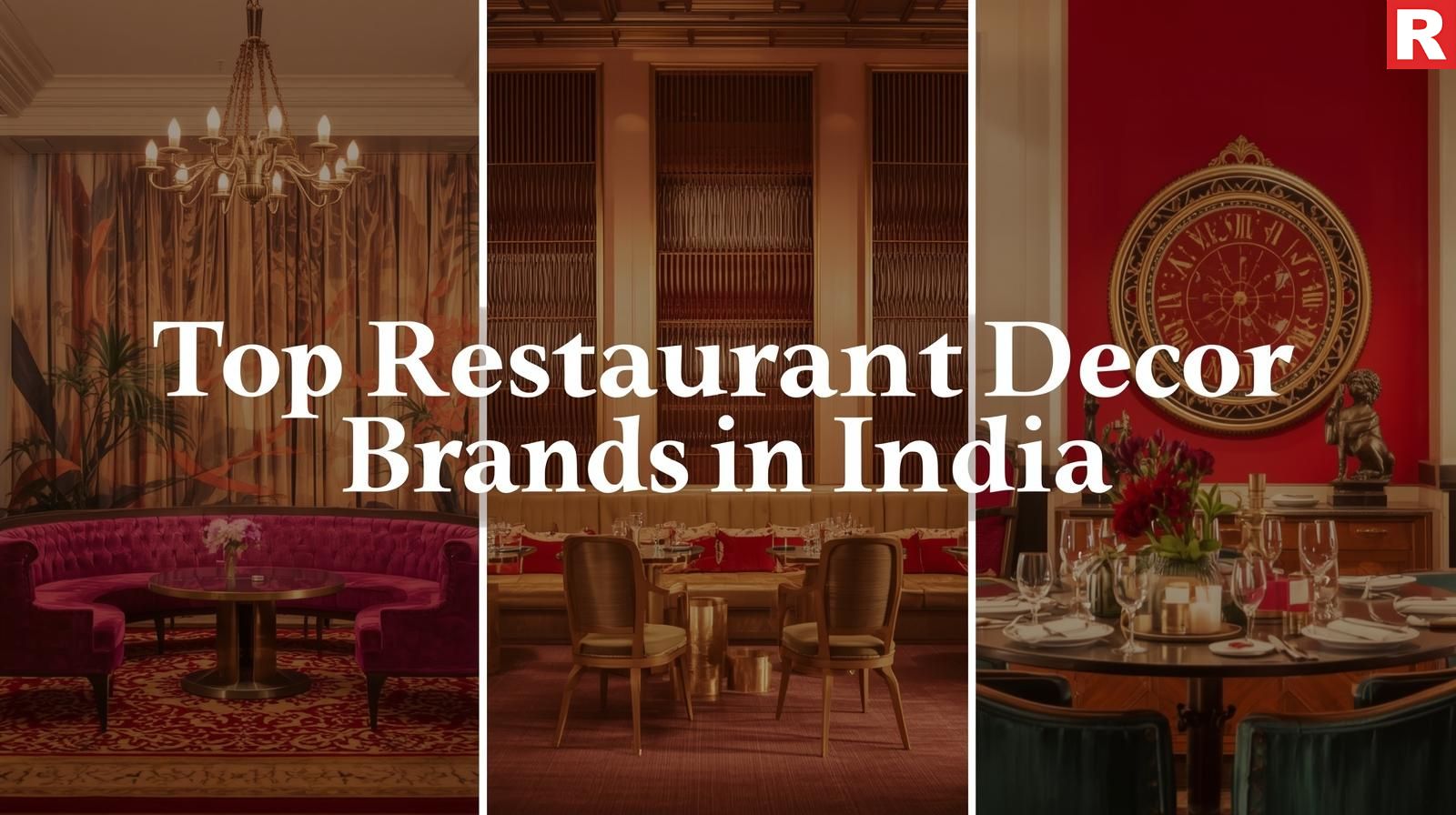
1. Suren Space
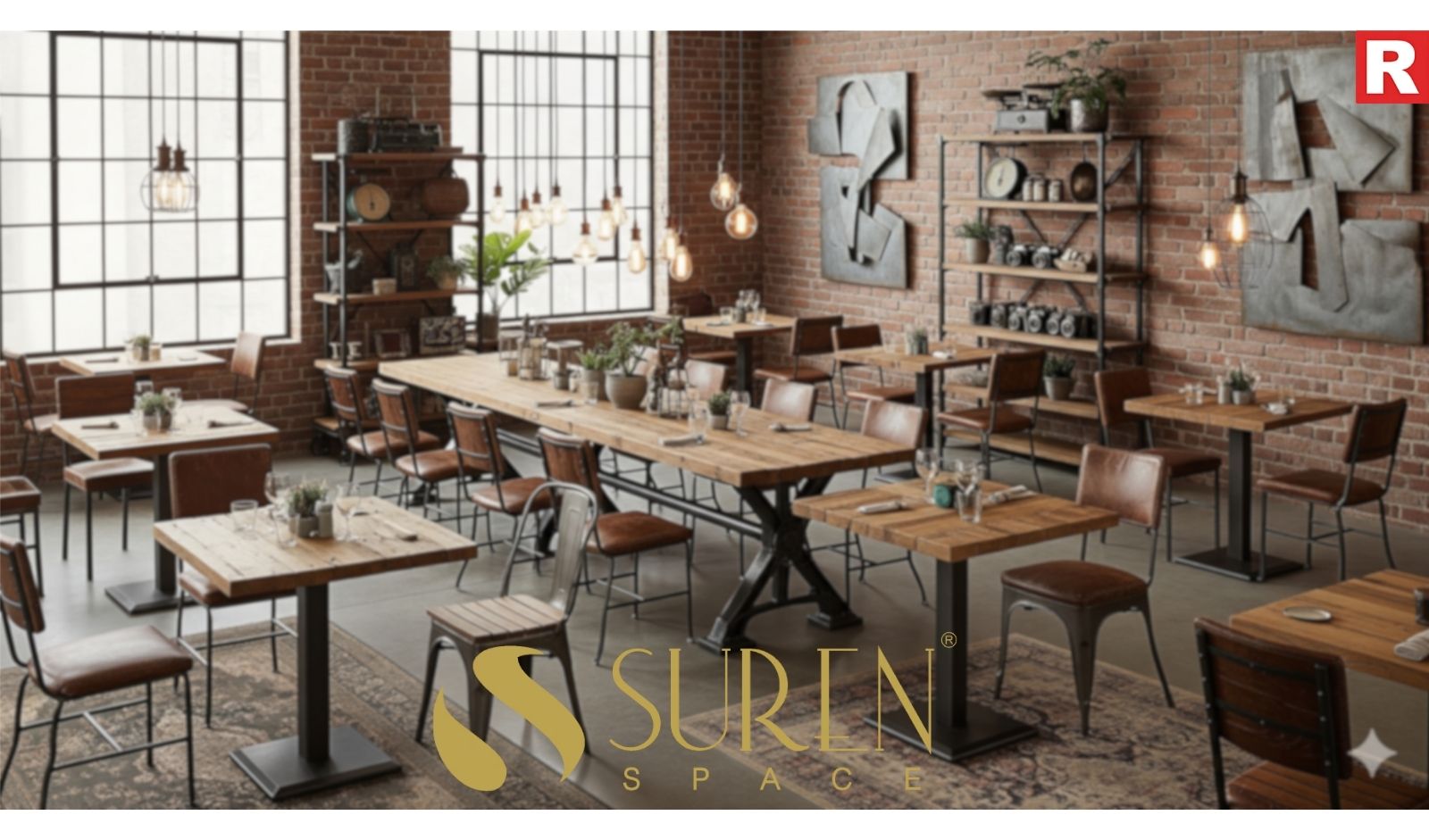
Website: https://www.surenspace.com/
Location: Jodhpur, India
Specialty: Handcrafted, wide variety of furniture designed to cater to diverse tastes and preferences
Price range: ₹1,200 for a bar stool to over ₹1,000,000 for a large furniture set
About Suren Space:
With over 15 years of experience under their belt, Suren Space is a big international exporter, manufacturer, and supplier, shipping their products worldwide.. They specialize in a broad variety of furnishings for both residential and commercial properties, with a particular emphasis on the hospitality sector, which includes hotels, resorts, restaurants, coffee shops, and bars. They provide a wide range of furniture, including handcrafted, custom, outdoor, hospitality, and commercial pieces. From vintage and modern to industrial and rustic, their portfolio offers a wide range of designs. The business is renowned for utilizing premium materials like leather, metal, teak, mango wood, and Sheesham wood. They blend contemporary design ideas with traditional Indian craftsmanship, especially from Jodhpur.
2. Durian Furniture

Website: https://www.durian.in/
Location: Mumbai, Maharashtra, India (Headquarters)
Specialty: Complete office and home furnishings, including a special collection for hospitality projects, as well as doors, wood veneers, and other construction supplies.
Price range: Depending on size and material, dining tables may cost anywhere from ₹15,000 to ₹50,000+, while restaurant chairs can start at ₹3,000 to ₹5,000.
About Durian Furniture:
An Indian success story, Durian Furniture began as a plywood factory in 1985 and has since grown to become one of the most recognizable and reliable names for complete interior design solutions. With a strong online presence and a network of more than 55 retail locations around India, Durian has made quality and design affordable for a wide range of consumers. Providing long-lasting, aesthetically beautiful, and useful furniture for both residential and business areas is central to their brand philosophy.
Durian offers restaurants a harmonious blend of modern styles, sturdy construction, and a wide range of material options. They are well-known for their timeless and contemporary furniture collections, which can be used in a variety of restaurant settings, from informal eating to more formal settings. Their dedication to sustainability, demonstrated by ethical wood sourcing and environmentally sustainable production, also appeals to modern businesses and customers.
What's new: A Comprehensive Guide to In-house Restaurants in the Indian Market
3. The White Teak Company

Website: https://www.whiteteak.com/
Location: New Delhi, India (Headquarters)
Specialty: Chandeliers, pendant lights, floor lamps, wall lights, and outdoor lighting are examples of luxurious and decorative lighting options.
Price range: Larger chandeliers range from ₹30,000 to over ₹1,00,000, while pendant lights start at ₹5,000 to ₹10,000.
About The White Teak Company:
The White Teak Company, which is known for its exquisite design and quality, has quickly become the biggest decorative lighting company in India. They are aware that lighting is about more than just providing light; it's also about establishing the atmosphere, improving aesthetics, and producing a memorable experience. Restaurant lighting fixtures frequently become focal features, giving the dining area personality and refinement.
A variety of outdoor lighting is also available from The White Teak Company, which is essential for restaurants with outside dining spaces or eye-catching exteriors. They are the preferred choice for restaurateurs wishing to enhance their dining experience with outstanding lighting because of their emphasis on premium materials, superb craftsmanship, and creative designs.
4. Pepperfry Business

Website: https://business.pepperfry.com/
Location: Mumbai, Maharashtra, India (Headquarters)
Specialty: Online marketplace and business-to-business (B2B) solutions supplier for modular solutions, furniture, and home décor that serves commercial ventures, including cafes and restaurants.
Price range: Prices can range from inexpensive chairs (₹1,000–₹3,000) to more expensive dining sets and tailored solutions (₹20,000–₹1,00,000+) because of its marketplace model.
About Pepperfry Business:
Although Pepperfry is well-known in India's e-commerce furniture market, its "Pepperfry Business" category focuses only on business customers, such as cafes, restaurants, and hotel accommodations. It serves as a comprehensive online marketplace with a huge variety of furniture and décor pieces, giving restaurateurs a scalable and practical way to furnish their restaurants.
Pepperfry Business's strength is its accessibility and tremendous variety. In a single showroom, restaurants can browse thousands of items from different manufacturers and brands, such as dining tables, chairs, bar stools, lounge chairs, outdoor furniture, and decorative accessories. For new businesses or those wishing to quickly renovate, this makes it a great choice.
5. Wipro Lighting
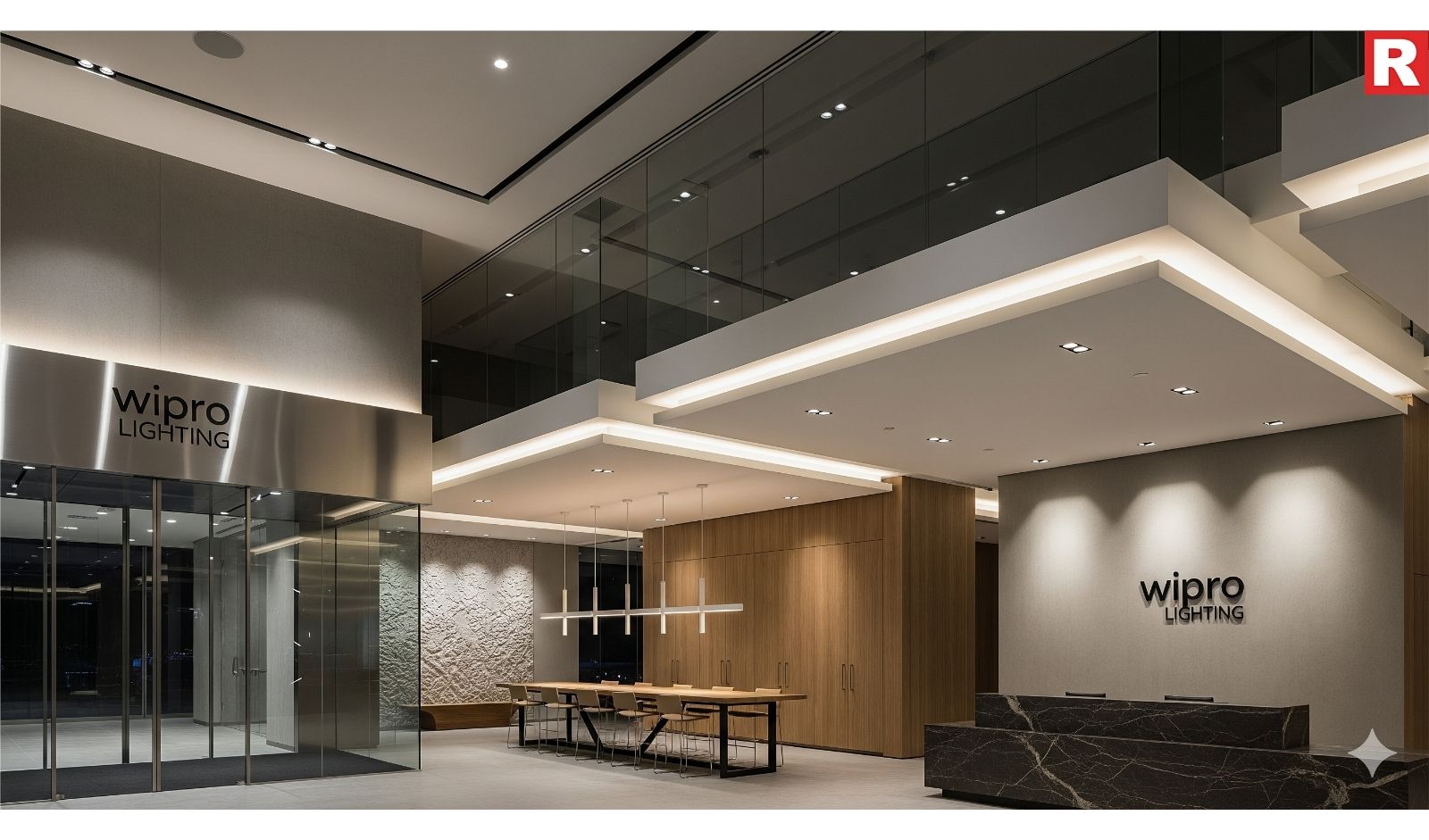
Website: https://wipro-lighting.com/
Location: Bengaluru, Karnataka, India (Headquarters)
Specialty: Smart lighting, LED bulbs, and human-centric lighting are examples of commercial and architectural lighting solutions for a variety of industries, including cafes and restaurants.
Price range: Usually project-based, pricing is determined by the size and particular needs of a restaurant's lighting design. Fixtures might cost anything from ₹1,500 to ₹15,000+.
About Wipro Lighting:
A major force in the Indian lighting sector, Wipro Lighting is a division of the diversified Wipro Enterprises and is renowned for its cutting-edge and energy-efficient products. Wipro Lighting concentrates on the architectural and practical elements, offering complete lighting designs for commercial spaces that are both visually beautiful and functional, whereas The White Teak Company is an expert in decorative lighting.
Wipro Lighting provides a variety of options for restaurants that go beyond simple lighting. Accent lighting to draw attention to decorative features, task lighting for the kitchen and service counters, ambient lighting for the dining area, and even smart lighting systems that enable dynamic mood changes are all included in this. Their proficiency with LED technology guarantees better light quality, reduced operating costs, and energy sustainability.
Check out: How Indian Restaurants Can Use Food Science to Create Irresistible Dishes
How Farm-to-Table Restaurants Have Become Trendy These Days
Choosing the Right Partner for Your Vision

One of the most important company decisions is choosing the appropriate decor brand. Here are some important things to think about:
- Brand Alignment: Do the aesthetics and philosophy of the brand complement the concept and target market of your restaurant?
- Durability and business Grade: Verify that the fixtures and furniture are made for heavy business use as well as household use.
- Sustainability Practices: Take into account companies that place a high value on environmentally friendly products and ethical production.
- Customization Capabilities: Are you limited to their current supply, or can they realize your original ideas?
- Budget and Timeline: Verify that the company can produce high-quality goods within your project's and your budget's limitations.
- After-Sales Support: Verify warranties, maintenance assistance, and part replacement simplicity.
Read this: Best International Cuisines You Should Try Once
Conclusion
The goal of the Indian restaurant industry is to provide a comprehensive experience where the ambiance, food, and service all work together harmoniously. The best restaurant décor companies in India are more than just suppliers; they are innovative collaborators that assist in transforming a culinary concept into a practical, welcoming area. These companies are giving restaurateurs the means to draw in audiences, create strong brands, and prosper in a constantly changing industry by comprehending the science of design and the art of ambiance. Investing in well-considered, high-quality design is now a need for a successful restaurant, not just a luxury.

For centuries, Indian food has captivated people with different palates all around the world with its rich, multi-layered flavors, vivid colors, and complex scents. It is said that only a chef who has mastered the art of dish balancing through generations of knowledge inherited from their predecessors can possess this magic. However, what if we told you there's a science behind this artistry? This is known as Food Science in the modern world.
In an already competitive food sector, simply serving good food is no longer enough. Most of today’s modern restaurants have started using the art of food science to bring magic to their food. This technique can help the restaurants attract more customers who are looking for a great dining experience. Food science is a way of understanding the chemical reactions that can help the food become more delicious. This knowledge can also help to elevate traditional Indian recipes. In this article, we will be exploring the ways that can help the Indian restaurateurs apply the principles of food science to create unforgettable dishes.
Read more: Best International Cuisines You Should Try Once
What is Food Science? How does it work?

The study of food's physical, biological, and chemical composition, as well as the biological foundations of food preparation, is known as food science. It is an art form that enhances food safety, quality, and nutrition by utilizing chemistry, biology, physics, and engineering.
Key Aspects of Food Science
- Food Chemistry: Investigates the components of food, such as the vitamins, minerals, fatty acids, proteins, and carbs. It also investigates the chemical alterations that food goes through while being processed, stored, and cooked, like the Maillard reaction that gives food its savory, browned crust.
- Food Microbiology: Focuses on the microbes that are present in food, both good (such as those that aid in fermentation) and bad (such as those that lead to spoiling or foodborne illness). This area is essential for creating preservation techniques and guaranteeing food safety.
- Food Engineering: Designing and creating systems and equipment for food processing is the focus of food engineering. It enhances food production by using engineering concepts for everything from packaging and quality control to pasteurization and refrigeration.
- Nutrition: The study of food's nutritional content and how it affects human health. This covers the creation of dietary supplements and food supplements.
Know more: Fundraising For A Restaurant: How it Works?
Different Types of Food Science Techniques and How to Use Them
Let us take a good look at some food science techniques and their reactions. We will also see the ways to incorporate them into the restaurant’s kitchen:
1. The Maillard Reaction: The Secret to a Perfect Sizzle

One of the most important chemical reactions in cooking is the Maillard reaction, which is also known as the best friend of a chef. It's what gives a nicely seared paneer a rich, nutty crust, why a tandoori chicken has a lovely, smoky char as it comes out of the oven, and why caramelized onions give a curry such a deep sweetness.
In simpler terms, this is a complex process that involves amino acids and reducing sugars. These compounds react when the food is heated to a certain temperature (typically above 140°C or 285°F). This creates hundreds of new flavor and aroma molecules in the food.
How to use it in your kitchen:
- Tandoori Excellence: The Maillard process performs well in a tandoor oven's high heat. Make sure the marinated meat or veggies are dry on the outside before cooking to improve them. That golden-brown crust can also be achieved with a thin layer of fat, such as ghee.
- Caramelizing Onions: Take your time. The natural sugars in onions caramelize when they are cooked gently over low heat, giving any curry a rich, sweet, and deep foundation. This is an essential step in making a traditional Dal Makhani or a rich Rogan Josh.
- Searing Proteins: Proteins that are seared in a hot skillet before being added to a curry, such as chicken, fish, or even tofu, can maintain their flavor and offer a level of depth that might otherwise be missing.
2. The Art of Acidity: Balancing the Palate

Indian food is renowned for its strong flavors, which are flavorful, spicy, and frequently creamy. In the absence of a complementary acidic component, a dish may feel flat or heavy. A key element that clears the palate, enhances flavors, and encourages you to take another mouthful is acidity. Consider it the high note in a symphony of flavors.
How to use it in your kitchen:
- Final Touches: A dish can be transformed with a dash of amchur (dried mango powder) or a squeeze of fresh lemon juice right before serving. For this reason, a chhole bhature or dal tadka requires a last squeeze of lime.
- Tamarind and yogurt: They are essentials for a reason. In addition to softening meat, yogurt gives a sour taste that balances the richness of korma or biryani. Likewise, tamarind gives South Indian soups like sambar a rich, tangy sourness.
- Pickles and chutneys: These are expertly prepared acidic ingredients that are meant to enhance a dish; they are more than just accessories. While a sweet-and-sour tamarind chutney might cut through the richness of a snack like samosas, a sharp, tangy pickle can balance a fatty meal.
What's new: A Modern Guide to India's Fitness-Focused Restaurant Concept
3. Umami: The Fifth Taste in Indian Cuisine

Umami is a more subtle, savory flavor that gives food a rich, fulfilling depth, whereas salt, sweet, sour, and bitter are all readily identifiable. This naturally occurring element, which is frequently referred to be "meaty" or "broth-like," is what gives a dish its authentic flavor.
How to use it in your kitchen:
- Tomatoes: The umami potency of slow-cooked tomatoes is immense. Glutamates, the chemical ingredient that gives them their umami flavor, are released and concentrated during cooking.
- Mushrooms: A natural source of umami is mushrooms. Their earthy, savory flavor will be enhanced by sautéing them until they are well-browned, which makes them a fantastic addition to vegetarian curries.
- Fermented Foods: The chemical process of fermentation adds taste to food. Idli and dosa batters, as well as buttermilk (chaas), are examples of fermented Indian cuisine that have a mild umami flavor.
- Aged Cheeses: You may add a powerful umami boost to fusion recipes by using aged cheeses like Parmesan (or an Indian substitute).
4. The Role of Texture: A Feast for the Senses

Texture is a key component of the multisensory experience that is food. It is much more intriguing and fulfilling to consume a food with a range of textures rather than one that is continuously mushy.
How to use it in your kitchen:
- Crunch & Crispness: To add a pleasing crunch, finish with a final garnish of roasted cashews, crispy sev, crushed peanuts, or fried onions. The combination of crisp, soft, and moist textures is what makes pani puri and bhel puri tempting.
- Creaminess & Smoothness: To make a silky, creamy sauce for a malai kofta or shahi paneer, use a finely ground nut paste (almond or cashew).
- Contrast is key: Serve a flaky paratha or a crispy dosa beside a warm, tender curry. Additionally important is the contrast between a hard protein (such as a paneer cube or a well-cooked chicken breast) and a silky sauce.
5. Flavor Pairing: Beyond the Basics

Through the analysis of the chemical compounds found in various foods, food science has revealed many secrets of flavor pairing. This enables chefs to create surprising yet delicious pairings that go beyond traditional pairings. For instance, basil shares some of the flavor molecules found in coconut and ginger, so a recipe that combines them can seem both familiar and unique at the same time.
How to use it in your kitchen:
- Spices and Fruits: Spices such as cardamom, nutmeg, and cinnamon have volatile components in common with apples and pears. With this information, you can make elegant desserts with an Indian twist.
- Chocolate and Chili: A well-known example of a scientifically proven combination is chocolate and chili. A surprise and well-balanced flavor experience is produced by the flavanols in chocolate and the capsaicin in chili peppers.
- Mint and Cucumber: These two fresh, cooling ingredients are frequently used in salads or raitas. Knowing the science underlying this combination can lead to new applications, such as cucumber-and-mint chutney or water infused with mint.
Check Out: A Comprehensive Guide to In-house Restaurants in the Indian Market
Making your Restaurant Future Ready: Building Experiential Brands
6. The Science of Spices: From Bloom to Boost

One essential method in Indian cooking is the tempering of spices, also referred to as tadka or chaunk. In itself, this is a scientific procedure. Adding whole spices, such as cumin seeds, mustard seeds, and asafoetida, to hot oil or ghee causes their flavor compounds to "bloom," giving the oil a deep flavor and aroma.
How to use it in your kitchen:
- Timing is Everything: Timing is crucial since every spice has a unique smoke point and ideal release period for its flavor. To keep them from burning and becoming bitter, it's important to add them in the right order. Add the whole spices first, then the powdered spices.
- Control of Temperature: The oil should be hot enough to release the flavors without burning the spices right away. A sizzle is good, a flaming cloud of smoke is not.
7. Temperature and Presentation
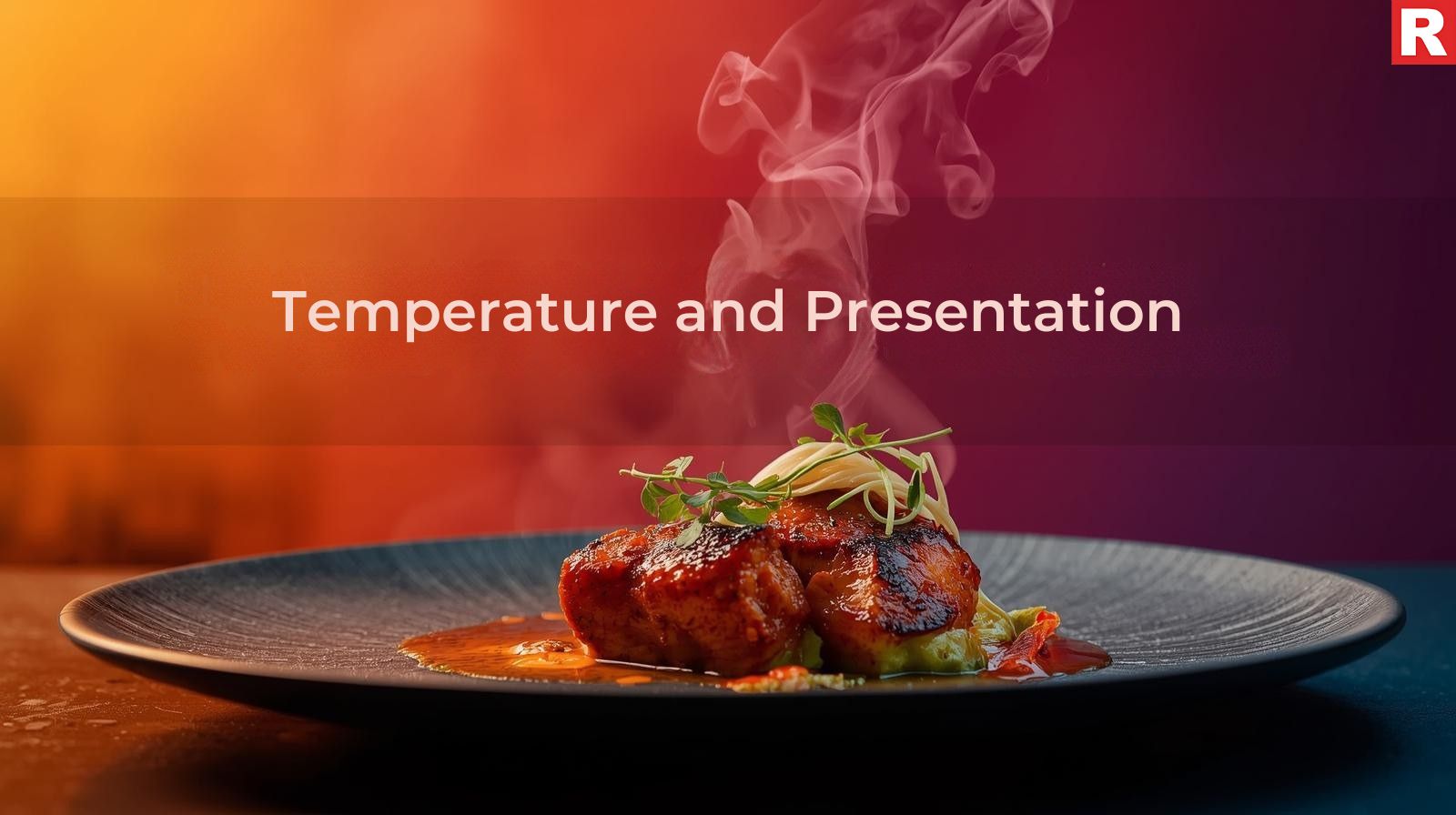
The last two components that can improve a dish are frequently disregarded.
- Serving Temperature: How we taste a meal is significantly influenced by its serving temperature. It is best to serve a raita or salad cold to highlight its refreshing features, and a hot curry hot to enhance its scents.
- Visual Appeal: Our eyes are the first to take in the food we eat. A wonderful meal starts in motion by an elegantly prepared dish, featuring an organized arrangement of garnishes and a balance of colors. An eye-catching garnish, such as a sprinkling of paprika, a spoonful of contrasting yogurt, or fresh cilantro, can enhance the appearance of a dish just as much as its flavor.
Read this: How to Find Your Niche in the Restaurant World
Conclusion
Food science is not about using a sterile laboratory method to replace the natural artistic talents of Indian cooking. Rather, it aims to give a more thorough explanation of the "why" underneath traditional techniques. A new level of culinary perfection can be achieved by Indian restaurants by fusing the knowledge of centuries-old recipes with contemporary scientific ideas.
Indian cuisine's future is in improving upon its traditional dishes rather than merely re-creating them. It's about a chef who knows why a bit of tamarind makes a rich curry delicious, why a nicely charred onion produces a deep umami, and why a pinch of sugar balances a tomato sauce. Indian eateries may create a new generation of genuinely remarkable meals by embracing this blending of art and technology.

As the urbanisation of the Indian population increased, so did the concept of a healthy lifestyle and fitness, especially in urban cities. This notion is not just a passing trend made by social media, but an established movement. Ever since the emergence of COVID-19, Indian people have become actively aware of their health and fitness. A considerable portion of the public is actively seeking food that not only tastes good but also helps them achieve their fitness goals, as evidenced by the skyrocketing number of gym memberships, the rise in marathon participation, and the increased awareness of diet and well-being. This shift in Indian culture has created an opportunity for restaurateurs to transition from traditional Indian concepts to ones that combine delicious cuisine with nutrition for fitness.
This article serves as a guide that dives into the fitness-focused restaurant concept in India. We'll look at how to start a food business that caters to athletes, wellness believers, gym-goers, and busy professionals searching for healthy, transparent, and convenient meal options. From menu planning and smart marketing to creating a community center and cultivating a positive ambiance, this article will provide a detailed plan for success in a rapidly expanding market sector. By helping your customers reach their objectives, you will ensure that your business thrives.
Read more: Fundraising For A Restaurant: How it Works?
Understanding India's Growing Fitness Wave

Knowing your target market well is the first step in creating a profitable restaurant with a fitness theme. India's market for health and wellness is expanding due to several factors:
- Gym Culture's Rise: Even in tier-2 cities, fitness facilities, CrossFit boxes, and boutique studios are common. Their members are actively looking for balanced meals that are high in protein.
- Enhanced Health Awareness: As the relationship between diet and chronic illnesses becomes more widely recognized, more people are choosing foods with caution.
- Dietary Trends: People frequently discuss keto, paleo, vegan, gluten-free, and fasting between meals, and they are searching for restaurants that can accommodate these particular requirements.
- Professional Convenience: People with hectic schedules seek healthy, quick, and pre-portioned food options that work with their busy schedules.
- Sports & Performance: For peak performance and rehabilitation, both professional and amateur athletes need to follow a strict diet.
Keep in mind that your restaurant is offering an answer to these changing requirements in addition to food.
Know more: A Comprehensive Guide to In-house Restaurants in the Indian Market
A Customizable & Macro-Centric Menu for Fitness-Focused Restaurants

The foundation of your fitness-focused restaurant is the menu. It needs to be clear, flexible, and truly tasty.
Macro-Centric Meal Labeling: Labeling macro-centric meals is a non-negotiable requirement. The breakdown of macronutrients (protein, carbs, and fats) and the number of calories in each dish must be prominently displayed.
- For instance: "Grilled Peri-Peri Chicken with Quinoa & Roasted Veggies: 450 Kcal | P: 40g | C: 30g | F: 18g." Customers are then more willing to make choices that support their fitness objectives.
Create Your Own Plates or Bowls: Provide a part that is customizable so that customers can select:
- Proteins: Include light fish (such as salmon and basa), paneer tikka, tofu scramble, grilled chicken breast, and lentil and chickpea patties.
- Complex Carbs: Quinoa, Brown Rice, Bajra and Jowar Millets, Sweet Potato Mash, and Whole Wheat Pasta are examples of complex carbohydrates.
- Fresh veggies: A varied range of raw, grilled, or steamed seasonal veggies.
- Healthy Fats: Nuts, seeds, avocado slices, and olive oil drizzling are good sources of healthy fats.
- Clean Dressings/Sauces: Low-sugar chutneys, hanging curd dips, and mild vinegar dressings.
Targeted Meal Sections:
- High-Protein Power Meals: Recipes created especially to aid in muscle growth and repair.
- Low Carb/Keto-Friendly: Items with just a small amount of carbohydrates.
- Plant-Based/Vegan Delights: Creative and tasty recipes that suit plant-based diets.
- Pre & Post Workout Snacks: Snacks to eat before and after working out include energy bits, protein bars, fruit salads, and hard-boiled eggs.
Alternatives to "Cheat Day" (Healthy Treats): Serve comfort meals in healthier forms. For instance, baked "fries" prepared from sweet potatoes, whole wheat pizzas with lean toppings, or low-sugar treats that are high in protein.
Indian Flavors, Healthy Twist: Add traditional Indian flavors to nutritious foods for a healthy twist. Consider dishes such as "Tandoori Chicken Salad," "Palak Paneer with Brown Rice," or even "Spiced Lentil & Quinoa Patties."
Check out: Best Food Delivery Apps & Quick Commerce Platforms in India
The Future of Food Service At Home
Creating the "Wellness Hub" Ambiance & Space for Fitness-Focused Restaurants
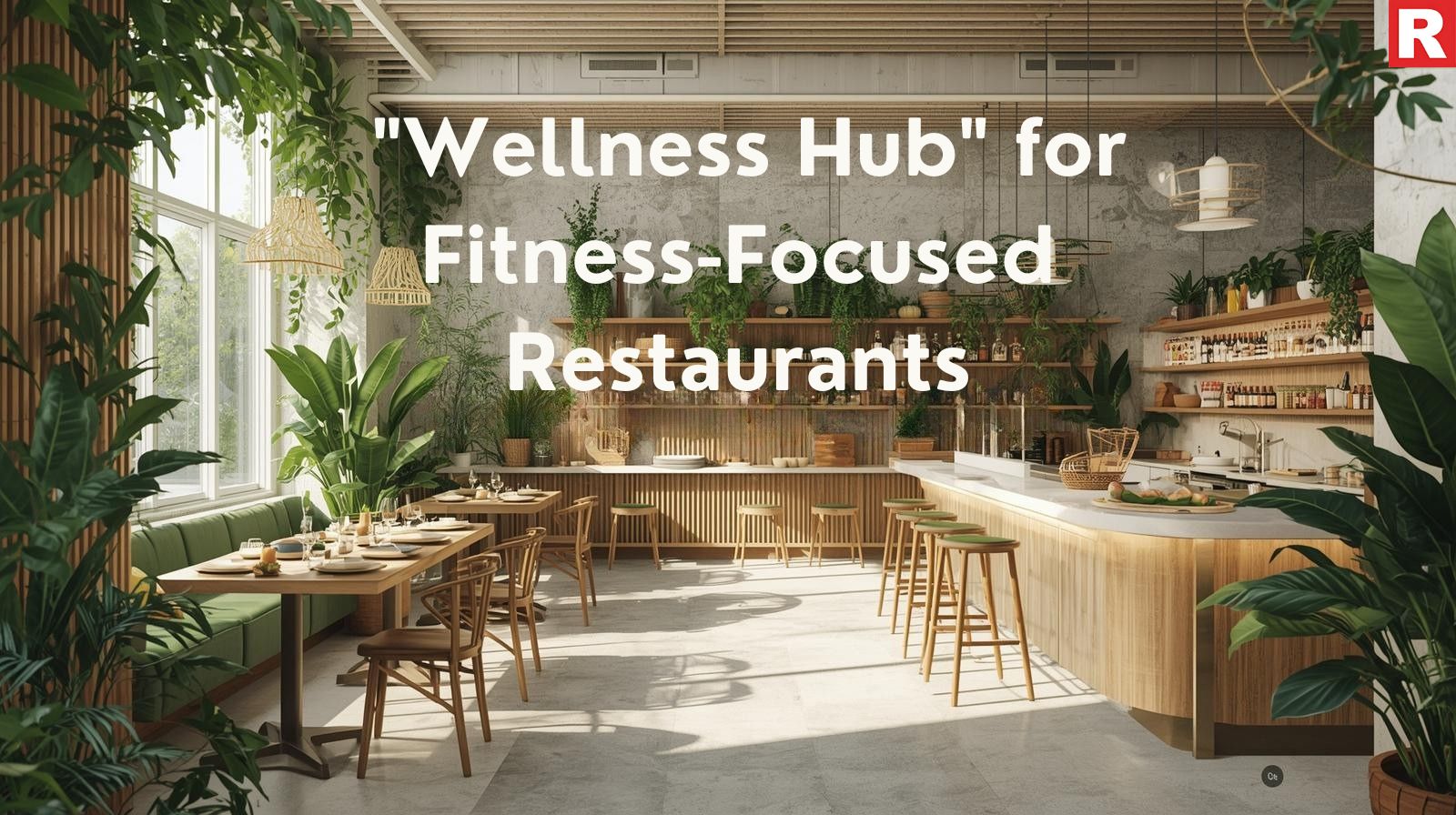
A healthy lifestyle should be encouraged and supported by the physical surroundings of the restaurant.
- Clean & Energizing Design: Go for a contemporary, minimalist look. Make the most of natural light and include wood, stone, and a lot of greenery. Stay clear of clutter.
- Comfortable and Practical Seating: Offer a variety of seating arrangements, such as shared tables for large groups or individual tables for fast lunches. For short bites, think about getting some high stools.
- Positive & Uplifting Vibe: Play uplifting, inspiring background music at a comfortable volume, such as instrumental, light pop, or lo-fi beats.
- Information & Education: Take into account putting up a tiny whiteboard or computer screen that shows off health advice, the advantages of particular foods, or the achievements of nearby exercise enthusiasts.
- Retail Corner: Include a tiny retail area. Collaborate with nearby companies or fitness companies to sell:
- Bars and supplements of protein.
- Nuts, seeds, and dried fruits as healthy snack options.
- Branded goods (t-shirts, water bottles).
- Wellness magazines or cookbooks with a focus on health.
- Hygiene & Transparency: Maintaining flawless cleanliness is crucial. If possible, an open kitchen idea can demonstrate the fresh preparation and hygiene, building trust.
Strategic Marketing: Reaching Your Fit-Focused Tribe

Your marketing must be community-driven and extremely focused.
Hyper-Local Collaboration with Fitness Facilities & Gyms:
- Exclusive Discounts: Provide members of local fitness centers and gyms with exclusive discounts.
- Meal Plans: Work together to provide pre-ordered weekly or monthly meal plans that are customized to the objectives of their members.
- On-Site Promotions: Introduce your food by setting up a tasting stand at nearby gyms.
- Nutrition Workshops: Hold collaborative workshops on healthy eating at your restaurant or fitness center.
Strategic Content Marketing & Digital Presence:
- Instagram & Facebook: Your main visual channels are Facebook and Instagram. Share colorful, high-quality pictures of your cuisine along with macro analysis. Give behind-the-scenes looks, dietary advice, and success tales.
- Local SEO: Make your Google My Business page more visible by using keywords such as "gym food," "healthy restaurant," "keto-friendly," and "vegan options."
- Food Blogging/Influencers: Collaborate with nearby nutritionists, food bloggers, and fitness influencers who share the values of your business.
- WhatsApp Groups: Establish a specific WhatsApp broadcast list for daily deals, new menu items, or exclusive promotions, aimed at nearby fitness centers and health associations.
Events & Workshops in the Community:
- Organize Nutrition Talks: Ask local fitness instructors or dieticians to speak at your restaurant about nutrition.
- Healthy Cooking Classes: Provide courses that emphasize particular dietary cuisines or the preparation of healthful meals.
- Fitness Meet-ups: Give local yoga or running clubs a place to get together before or after their events.
Loyalty Programs: Establish a loyalty program that offers incentives for regular, healthful eating. Use the promotion "Buy 10 healthy meals, get 1 free smoothie."
What's new: How to Find Your Niche in the Restaurant World
Standard Restaurant’s Take on the Fitness-Friendly Meal Trend

The fitness-focused trend is not limited to customized cafes or committed wellness restaurants. Many traditional restaurants across India are using a smart move to capture the attention of a wide audience. They are incorporating healthy dishes into their menu to cater to health-conscious diners. With this method, they can maintain their original identity as a traditional restaurant and also embrace the modern demand for healthier options.
Here are some ways a standard restaurant can effectively combine fitness-friendly meals into its original menu:
- Menu Adaptation, Not Overhaul: Instead of a menu that is created from scratch, standard restaurants can offer lighter and healthier versions of their most popular dishes. For example, classic butter chicken made from less cream and more healthier meal. Biryani made with brown rice instead of white, or a fried appetizer, but grilled instead of fried. This gives customers a choice without altering the menu and creating dishes for only one group of people.
- Strategic Ingredient Swaps: Small changes can have a huge impact. Simple ways to make food healthier include using natural sweeteners like honey or dates in place of sugar, substituting white flour in rotis and bread with whole wheat or millets, and switching from refined oil to olive or coconut oil.
- Honest and Trust-Building Labeling: Including a tiny, obvious label on the menu designating "high-protein," "vegan," or "gluten-free" options shows that the establishment is dedicated to meeting the dietary requirements of a wide range of customers. Listing the calorie and macronutrient content, even if it is estimated, for important health-focused dishes greatly increases customer trust.
- A Dedicated "Healthy & Fit" Section: Restaurants may allocate a specific area on their menu for their healthier options as a "Healthy & Fit" section. Health-conscious customers can now easily locate what they want without having to search the entire menu or request changes. Nutrient-dense bowls, lean protein main courses, and special salads could all be found in this section.
- Seasonal & Special Offerings: Chefs might launch "healthy specials" on a weekly or monthly basis that showcase local, seasonal ingredients and creative, light cooking methods. This allows the culinary crew to try out new flavors and ingredients and keeps the healthy menu interesting.
Read this: The Pros and Cons: Comparing Franchise vs. Independent Specialty Restaurants
Conclusion
The fitness-focused restaurant concept in India is a response to a fundamental change in customer preferences, not just a passing trend. Restaurant owners can attract a highly motivated and expanding customer base by painstakingly creating a clear, adaptable, and delectable menu, creating a location that is motivating and focused on wellness, participating in focused community marketing, and making sure that everything runs smoothly. In addition to being a place to dine, your restaurant will play a significant role in your customers' journeys towards health and wellness by turning their meals into stepping stones to a better, fitter lifestyle and ensuring your own successful future in India's vibrant food industry.

For an aspiring restaurateur, the dream of opening a restaurant is a strong one. There is a powerful combination of business vision, culinary passion, and an ambition to create a place that unites people, which fuels their dream. However, turning this dream into reality requires more than just a great chef and a unique concept. Opening a restaurant also requires capital. For prospective restaurateurs, obtaining the proper capital is frequently the biggest obstacle in India's vibrant and cutthroat food and beverage sector. Understanding the restaurant fundraising landscape is essential for long-term success, regardless of your goals—opening a network of QSRs throughout the nation, a fine-dining restaurant, or a little cafe.
This article will help you to properly understand fundraising according to the Indian market. We will examine several funding options, ranging from conventional bank loans to modern venture capital, and offer a detailed plan on how to get your business ready for investors. By the end of this article, you'll know exactly what your funding options are, what factors to take into account for each, and how to get the money you need to realize your culinary dream.
Read more: Simple Steps To Boost Your Restaurant's Foot Traffic
Why Do Restaurants Need Funding?

Before we start looking into the "how," let's examine the "why." Funding for restaurants extends beyond their grand opening. The approach is multi-stage and consists of:
- Initial Setup Costs: This covers everything from initial merchandise, kitchenware, furnishings, license fees, and rent deposits to interior design. These can be significant and are frequently the main justification for looking for outside funding.
- Working Capital: Before a restaurant makes a profit, it still requires cash flow to pay for ongoing costs such as marketing, utilities, payroll, and raw materials.
- Growth & Expansion: After a restaurant is profitable, money is frequently needed for new location openings, franchises, or technological investments.
- Crisis Management: To deal with unanticipated difficulties, like a sharp decline in sales or a significant repair, an emergency fund is essential.
Know more: How to Choose the Healthiest Cooking Oil for Your Kitchen
Traditional Funding Sources

For many years, these techniques have served as the foundation for corporate financing. Although they have their own set of criteria and limitations, they are frequently more accessible.
Self-Funding (Bootstrapping):
- How it works: The business is financed by your own assets or money.
- Pros: Total ownership over your company, no reduction of debt or stock, and the autonomy to decide on everything without outside interference. It gives prospective future investors a great deal of confidence.
- Cons: May restrict the scope and rate of your expansion and risk your own funds. One mistake could be disastrous if you are not financially sound.
Family and Friends:
- How it Works: Getting equity from your social circle or taking out a loan.
- Pros: Benefits include a higher degree of trust, more flexible repayment arrangements, and frequently less paperwork. Your family and friends have faith in you as a person, not just as a business concept.
- Cons: If the business fails, it can cause serious emotional and legal issues to blur the boundaries between personal and professional ties. Treat it like a professional business deal at all times.
Bank Loans (Term Loans):
- How it works: A bank lends you a certain amount of money, which you then pay back over a predetermined time period with interest.
- Pros: You keep total control over your company. Compared to alternative loan options, interest rates are frequently lower. It's a well-defined and organized financial commitment.
- Cons: Since banks frequently view the restaurant industry as high-risk, it can be challenging for new businesses to obtain loans. You will probably need to have a high credit score along with collateral, such as real estate or fixed savings. The application procedure is time-consuming and requires an in-depth business plan. Startups and small businesses in India frequently find it difficult to comply with these strict laws.
What's new: A Comprehensive Guide to In-house Restaurants in the Indian Market
Modern & Alternative Funding Sources

FinTech and the growth of the startup sector have given restaurateurs new and creative ways to acquire money.
Angel investors:
- How It Works: Rich people give their own funds to early-stage businesses in return for stock. They offer coaching and important industry connections in addition to finance, and they are often veteran business owners themselves.
- Pros: They offer "smart money"—experience, guidance, and a network that can be extremely beneficial to a startup company. They are more inclined to gamble on ideas that haven't been tested.
- Cons: They will invest in your business and influence your strategic decisions. It can be difficult to find an angel investor who shares your goal.
Venture Capital (VC):
- How it Works: In exchange for a considerable equity stake, venture capital firms invest institutional funds (from corporations, pension funds, etc.) in high-growth businesses. Usually, they are searching for scalable concepts, like a delivery-only brand or a proposal to start a chain of restaurants.
- Pros: They can offer a substantial sum of money, facilitating quick growth and market dominance. Their support lends legitimacy and draws in additional funding.
- Cons: Venture capitalists seek a high return on investment (ROI) in a short amount of time (five to seven years). They will seek high levels of control, board seats, and a sizable share. Not every restaurateur should do this, particularly those who wish to operate a single, profitable restaurant.
Crowdfunding:
- How it works: Small amounts of money can be raised through online platforms from a large number of people. It can be either a reward-based model, such as pre-selling meals or providing exclusive benefits, or an equity-based approach, in which investors receive a small stake.
- Pros: It's an effective method of determining consumer interest and creating an engaged customer base before you ever open for business. It enables you to get around traditional gatekeepers, like as VCs or banks.
- Cons: To succeed, it needs a powerful marketing strategy and an engaging narrative. The rewards-based strategy lacks the tactical guidance of an angel investor, and the amount of money raised could be limited.
Leasing:
- How it Works: You can lease costly cooking appliances (such as a tandoor or commercial oven) rather than purchasing them. The equipment is purchased by the leasing business, which then charges you a set monthly rate.
- Pros: Frees up a large portion of your startup funds that may be allocated to other important costs like working capital or marketing. Equipment upgrades are less difficult.
- Cons: Leasing can end up costing more in the long run than buying the equipment altogether, and you don't own the item.
P2P (peer-to-peer) lending:
- How it works: These are online marketplaces that put borrowers and lenders in close contact.
- Pros: Compared to a conventional bank loan, the application process can often be quicker and less complicated. Prices may be more affordable.
- Cons: The amount you can borrow may be restricted, and interest rates may be higher based on your willingness to take risks.
Check out: Five Ways To Boost Your Restaurant's Lunch Rush
The Pros and Cons: Comparing Franchise vs. Independent Specialty Restaurants
How to Prepare Your Business for Fundraising

A professional and meticulous pitch is crucial regardless of the funding source you use. This is your opportunity to demonstrate your business skills and market your idea.
A Perfect Business Strategy: This serves as your base. It ought to contain:
- A short synopsis that will be the executive summary of your idea.
- A thorough market analysis consisting of examination of your rivals, target market (such as office workers), and the gap you intend to close.
- An in-depth discussion of your cuisine, USP, and brand identification is included in the menu and concept.
- How will you manage the daily operations of the company? What will be your operation plan?
- How are you going to draw clients? Create a thorough draft of the marketing plan.
- Who are the important members that make up your management team, and what is their previous experience? Investors invest in people as much as ideas.
Comprehensive Financial Forecasts: Investors want to see that you understand the numbers.
- A detailed account of all the startup costs you expect.
- A forecast for the upcoming three to five years that displays anticipated revenue, expenses, and profitability is called a profit and loss (P&L) statement.
- A cash flow statement is a forecast that illustrates how money moves into and out of the company, demonstrating that you won't run out of funds.
- A precise estimate of when your company will turn a profit. This is called Break-Even Analysis.
A compelling pitch deck: It is a short visual presentation that highlights your business concept and consists of 10 to 15 slides. It should have a strong narrative and be aesthetically pleasing.
A Firm Basis in Law and Compliance: Make sure you have all of your legal paperwork in place, such as your partnership agreements, tax registrations, FSSAI licenses, and business registrations. Due diligence will be carried out in-depth by investors.
Read this: How to Find Your Niche in the Restaurant World
Choosing the Right Funding Source
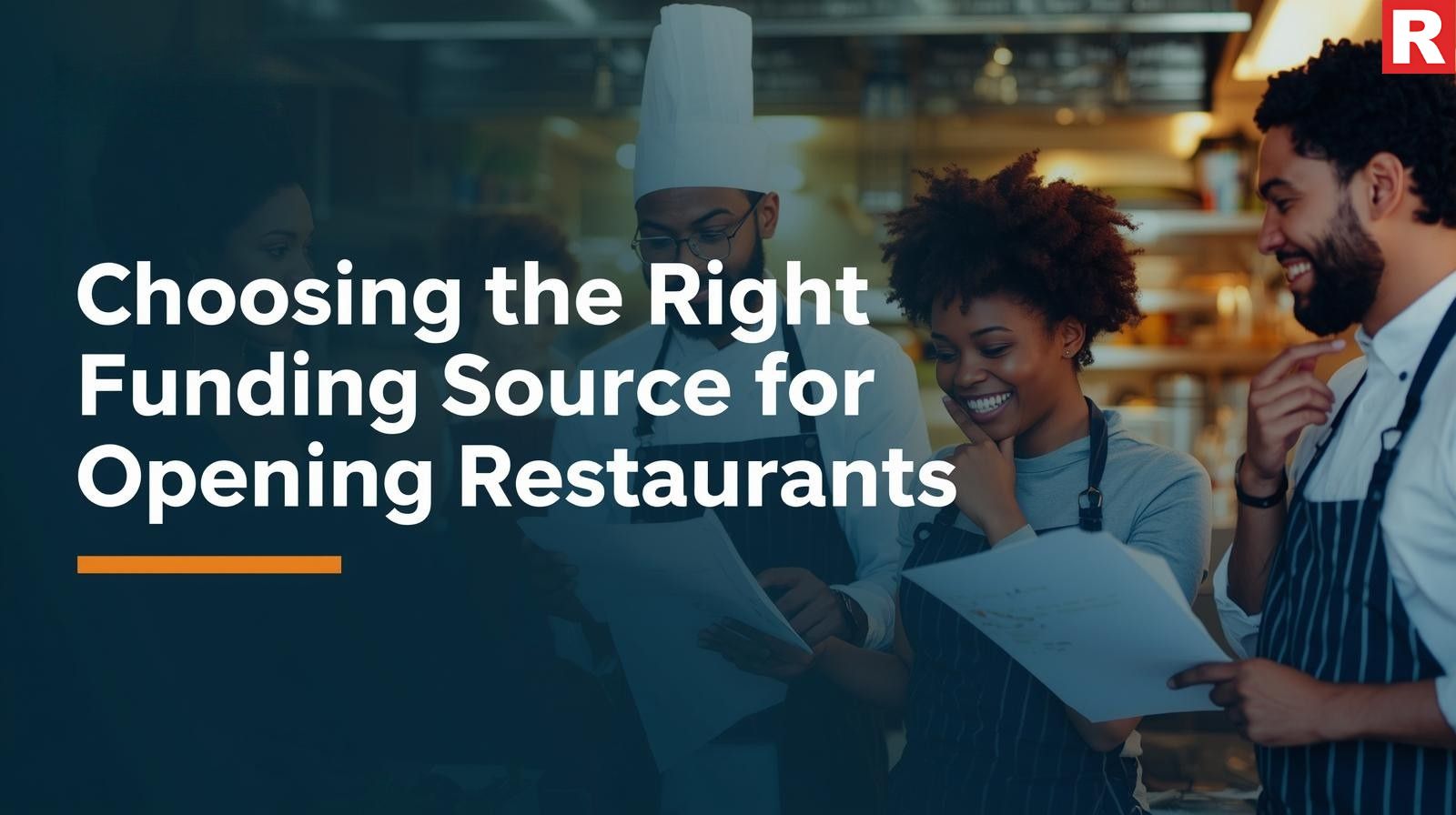
Your particular circumstances and objectives will determine the most suitable funding method for you:
- Funding through friends and family or bootstrapping may be for you if you have a solid personal safety net and appreciate creative control.
- A bank loan is the best option if you have strong collateral and desire a steady, organized financial route.
- Seek out venture capital or angel investors if you have a scalable, high-growth idea and are prepared to give up stock in exchange for strategic assistance.
- Crowdfunding can offer both money and a devoted following if you have a strong brand story and a loyal customer base.
Conclusion
In India, raising money for a restaurant is a marathon, not a race. It calls for careful preparation, a solid understanding of your financial situation, and the courage to accept rejection. You can greatly improve your chances of getting the money you require by being aware of the entire range of funding alternatives, from institutional to personal, and by creating a strong business plan. Keep in mind that having the proper capital will not only allow you to open, but it will also set the stage for a long-lasting, profitable, and popular culinary legacy.

The culture of restaurants in India has increased over the past years a lot. That’s why, with new models of establishments appearing over the years, the traditional models of restaurants are also expanding. While standalone restaurants are doing well continuously, a significant and incredibly profitable market is emerging, which is the in-house restaurant. An in-house restaurant refers to a culinary business that is operating within another main business, such as a hotel, resort, club, mall, hospital, corporate office, or even a retail store. In a market where real estate is highly valued, and consumers seek convenience and personalised experiences, the in-house models work perfectly by offering a compelling route to profitability and brand building.
So, in this article, we will be dissecting the world of in-house restaurants in the Indian market. We will discuss the special benefits and difficulties of this model, describe the different kinds of in-house setups, provide a step-by-step guide for starting and running one, and point out important factors for prospective restaurateurs hoping to succeed in this specialized market, from a corporate cafeteria to a hotel's signature dining room.
Read more: Best Food Delivery Apps & Quick Commerce Platforms in India
What Exactly is an In-house Restaurant? Defining the Model

An integrated dining facility is referred to as an in-house restaurant. This is another type of food and beverage (F&B) activity that plays a crucial role in another company or business. Compared to standalone restaurants, which operate independently, an in-house restaurant's primary function is bigger and frequently goes beyond simply providing customers with food. The in-house restaurant business's primary goals are:
- Enhance the Core Business: The in-house business provides a key service that helps to enhance the guest experience in the hotel. In a corporate office, they provide convenience that helps boost employee morale and productivity in their work.
- Generate Additional Revenue: While it serves the core business, it is also an additional profit center for the business.
- Support Brand Image: The style and quality of the restaurants contribute significantly to the overall opinion of the brand of the host company.
Its symbiotic relationship with the parent company is its primary feature; the success of the whole business is frequently linked to its own.
Types of In-house Restaurants in India

The in-house model is quite flexible and quickly adaptable. So it can be tailored to meet the demands of various primary businesses.
- Hotel Restaurants: The most prevalent and frequently varied are hotel restaurants, which include:
- All-Day Dining: Breakfast, lunch, and dinner are served separately and at buffet-style stations.
- Specialty Restaurants: These are fine-dining establishments that specialize in a single cuisine. Like an authentic Italian restaurant or a regional Indian specialty restaurant within a hotel.
- Cafes/Lounges: These are casual spaces for light snacks and drinks.
- Pubs and bars: Serving customers seeking drinks and pub fare.
- Resort & Club Restaurants: Like hotels, but frequently with more of a focus on casual meals, cafes by the pool, and event catering. Numerous F&B establishments are frequently found in member-only clubs.
- Corporate Cafeterias/Canteens: Large offices, IT parks, and industrial complexes all need corporate cafeterias or canteens to provide their staff with inexpensive or subsidized meals.
- Hospital Cafeterias: Providing meals to patients, employees, and guests, frequently emphasizing diet-specific and healthful selections.
- Food Courts at Multiplexes: In addition to popcorn and drinks, several modern multiplexes now have authentic mini-restaurants serving a variety of cuisines.
- Retail Store Cafes: Often found in huge bookshops, fashion boutiques, or lifestyle stores, these places provide a cozy setting for customers to unwind and refresh.
- Educational Institution Canteens: Faculty and students can eat at schools, colleges, and universities.
- Airport restaurants and lounges: serving passengers, frequently with quick service.
Know more: Five Ways To Boost Your Restaurant's Lunch Rush
Opening an In-house Restaurant in India: A Step-by-Step Blueprint
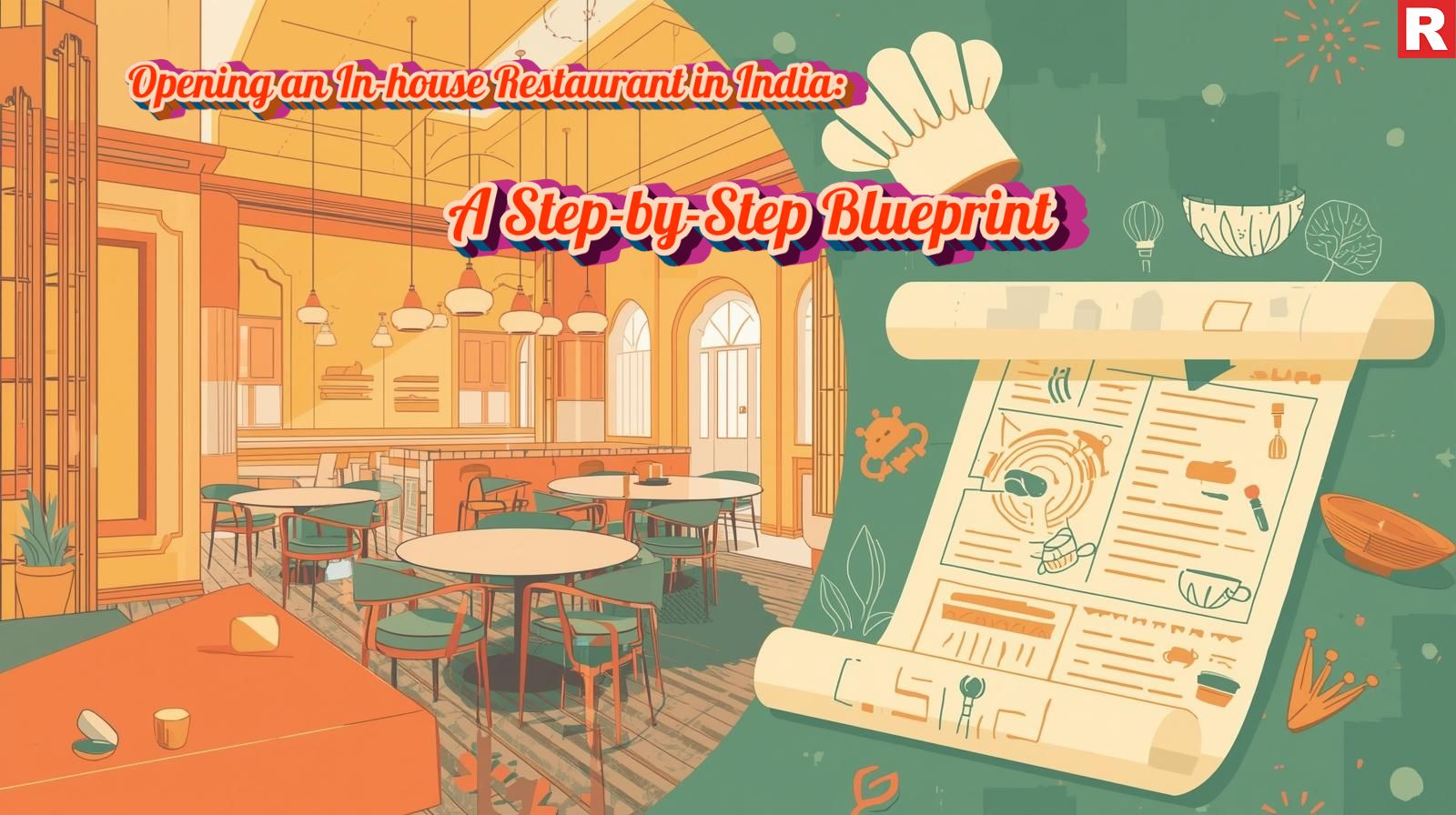
Step 1: Identify the Opportunity & Host Business
- Research on the Market: Examine the demand. Is a F&B partner required for a new hotel that is opening soon? Does an important corporate campus want to contract out its cafeteria?
- Host Business Analysis: Comprehend the target market, brand values, current F&B gaps, and overall operational philosophy of the host company.
- Building Relationships: Make connections with executives in the corporate, retail, and hospitality industries.
Step 2: Develop a Concept & Business Plan
- Concept Alignment: Develop a restaurant concept that precisely fits the target market and brand of the host company. A fast-casual, healthful cafe would be appropriate for a business workplace, whereas a fine-dining specialty restaurant might be appropriate for a luxury hotel.
- Menu Engineering: Create a menu that meets the needs that have been identified (e.g., varied alternatives for hotel visitors, quickness for corporate lunches). Pay attention to operational viability and profitability.
- Detailed Financial Projections: Taking into account the distinct internal cost structure, create reasonable estimates for sales, expenses, and profitability.
Step 3: Secure the Agreement & Legalities
- Negotiate the Contract: Contract negotiation is essential. Provide clarification on the terms of the agreement, including the duration, marketing responsibilities, operational control, rent/revenue split, shared resource costs, and departure conditions.
- Licencing and Compliance: Obtain the required fire safety certifications, health permits, local municipal licenses, GST registration, and food licenses (FSSAI). The F&B division frequently needs its own set of licenses, even in a bigger company. In India, this might be a difficult procedure.
- Insurance: Make sure your F&B operations are fully covered by insurance.
What's new: The Pros and Cons: Comparing Franchise vs. Independent Specialty Restaurants
Step 4: Design & Setup
- Kitchen layout and design: Create a kitchen that complements your cuisine and improves operational effectiveness. The design of the dining room must blend nicely with the aesthetics of the host property.
- Equipment Sourcing: Invest in or rent top-notch dining and kitchenware.
- Technology Implementation: Set up a reliable inventory management program, Point-of-Sale (POS) system, and possibly link with the host's property management system (PMS) for lodging establishments.
Step 5: Recruitment & Training
- Talent Acquisition: Employ F&B managers, seasoned chefs, and wait staff who are aware of the complexities of in-house dining. Seek out people who can positively represent the host brand and your business.
- Thorough Training: Educate employees on the host property's policies, safety procedures, and brand standards in addition to the menu and service. This covers banqueting processes and room service for hotels.
Step 6: Soft Launch & Grand Opening
- Trial Runs: To find and fix operational issues, do trial runs with a smaller menu and fewer employees.
- Soft Launch: To get input, hold a soft launch for management, internal employees, and a small sample of clients.
- Grand Opening: To get the most impact, work with the marketing team of the host company to plan the grand opening.
Check out: How to Find Your Niche in the Restaurant World
How to Choose the Healthiest Cooking Oil for Your Kitchen
Unique Advantages of the In-house Model
- Built-in Customer Base: The most important benefit is the built-in customer base. A corporate office supplies its staff, a hotel its visitors, and a multiplex its moviegoers. Compared to a stand-alone project, this drastically lowers the costs associated with acquiring new customers and initial marketing efforts.
- Reduced Initial Marketing Spend: The interconnected facilities, such as the F&B outlets, are frequently promoted by the host company's marketing campaigns. This lessens the restaurant's need to start from scratch while developing brand awareness.
- Shared Infrastructure & Resources: Depending on the agreement, you may be able to take advantage of shared resources such as cleaning personnel, utilities, security, and even HR assistance from the parent firm, which might reduce operating costs.
- Enhanced Credibility: The restaurant instantly gains credibility and trust when it is linked to a well-known brand, such as a reputable hotel chain or a well-known business house.
- Premium Pricing Potential: Because of the targeted audience and the perceived quality of the host brand, in-house restaurants, particularly in hotels or exclusive clubs, can frequently fetch higher rates.
- Diversified Revenue Streams: In addition to serving meals, in-house restaurants frequently handle banqueting, room service (in hotels), and event catering, which opens up a number of different sources of income.
Navigating the Challenges: The Flip Side of In-house Dining

- Dependency on Host Business: The parent company holds the key to the restaurant's success. Restaurant revenue is immediately impacted by a drop in hotel occupancy, business downsizing, or a drop in moviegoers.
- Brand Alignment & Control: You need to match the host brand's identity with the idea, menu, and service standards of your restaurant. Compared to a restaurant that operates independently, there can be less room for creativity. The host management must frequently approve all operational decisions.
- Operational Stability: Because hotels, for example, are open around-the-clock, there are demands for room service, banqueting needs, and different meal times. This requires an extremely adaptable and staff-oriented business.
- Complex Cost Structures: Unbundling expenses (rent equivalent, shared personnel, utilities) can be challenging, and profit-sharing arrangements require careful negotiation.
- Talent Recruitment & Management: It can be difficult to find qualified employees who can adjust to the unique requirements of an internal setting (e.g., multitasking in a hotel, discreet service in a corporate context).
- Limited External Foot Traffic: Despite having a captive audience, it may be more difficult to draw in outside customers (non-guests or non-employees) because of opinions, distinct entrances, or parking concerns.
Read this: How to Make a Failing Restaurant Successful Again
Critical Considerations for Success in the Indian Market
- Thorough Knowledge of the Host's Clientele: Customize your offers to the exact needs, whether it is a value-driven family, the picky business executive, or the budget-conscious visitor.
- Flexibility & Adaptability: Be ready to modify your menu in response to seasonal demands, special events, and dietary requirements (such as vegan or Jain food).
- Relationship Management: Keep up a great working relationship with the management of the host company. To resolve disputes and take advantage of collaborations, open communication is essential.
- Make Use of the Host's Marketing Channels: Promote the hotel on its website, in-room guides, social media accounts, and its personal assistants. Use internal communication channels for corporates.
- Cost Control & Profit Sharing: Keep a careful eye on all expenses and make sure the profit-sharing arrangement is just and clear. Seek chances to increase your share through operational optimization.
- Technology Interface: For operations to run smoothly, there must be a fluid interface with the host's current technological infrastructure (such as payment and reservation systems).
Conclusion
In the Indian F&B industry, the in-house restaurant model is now a major force rather than a supporting actor. It offers unmatched benefits, including an existing clientele, pooled resources, and increased brand recognition to restaurateurs who are prepared to handle its own unique complications. In the vibrant Indian market, from the busy center to the most remote corners of the hospitality industry, you can achieve substantial growth and establish a genuinely successful culinary enterprise by comprehending the various kinds of in-house establishments, carefully organizing your concept, and cultivating strong relationships with your host company.

If you are an aspiring restaurateur and still think that a standard, multi-cuisine menu is a surefire way to succeed in India’s thriving and fiercely competitive food and beverage sector, then you are completely wrong. The diners of today have become more sophisticated, adventurous, and globalized than ever before. As the era of globalisation has increased, so has the restaurant sector, which has become more crowded. In such a situation, where you have multiple competitors, and the customer wants a unique dining experience, it becomes difficult to meet all standards. Therefore, finding your own niche is a strategic choice that can help you to not just survive, but also thrive. After all, if you try to give everything to everyone, then you might end up being nothing to everyone. Now, the question comes: how to find your specific niche?
This is what we’re going to discuss in today’s article. A restaurant niche is a specialized segment of the market that you serve with a unique concept, menu, or experience. It is one of the characteristics, or you can say, a unique concept that makes you stand out in the crowd. This article will serve as your culinary guide, helping you step-by-step through the process to find your restaurant niche. We'll look at how to examine your own interests, research the market, and turn an innovative idea into a well-known and successful food restaurant.
Read more: How to Choose the Healthiest Cooking Oil for Your Kitchen
Why a Niche is No Longer Optional: The Shift in the Indian Market
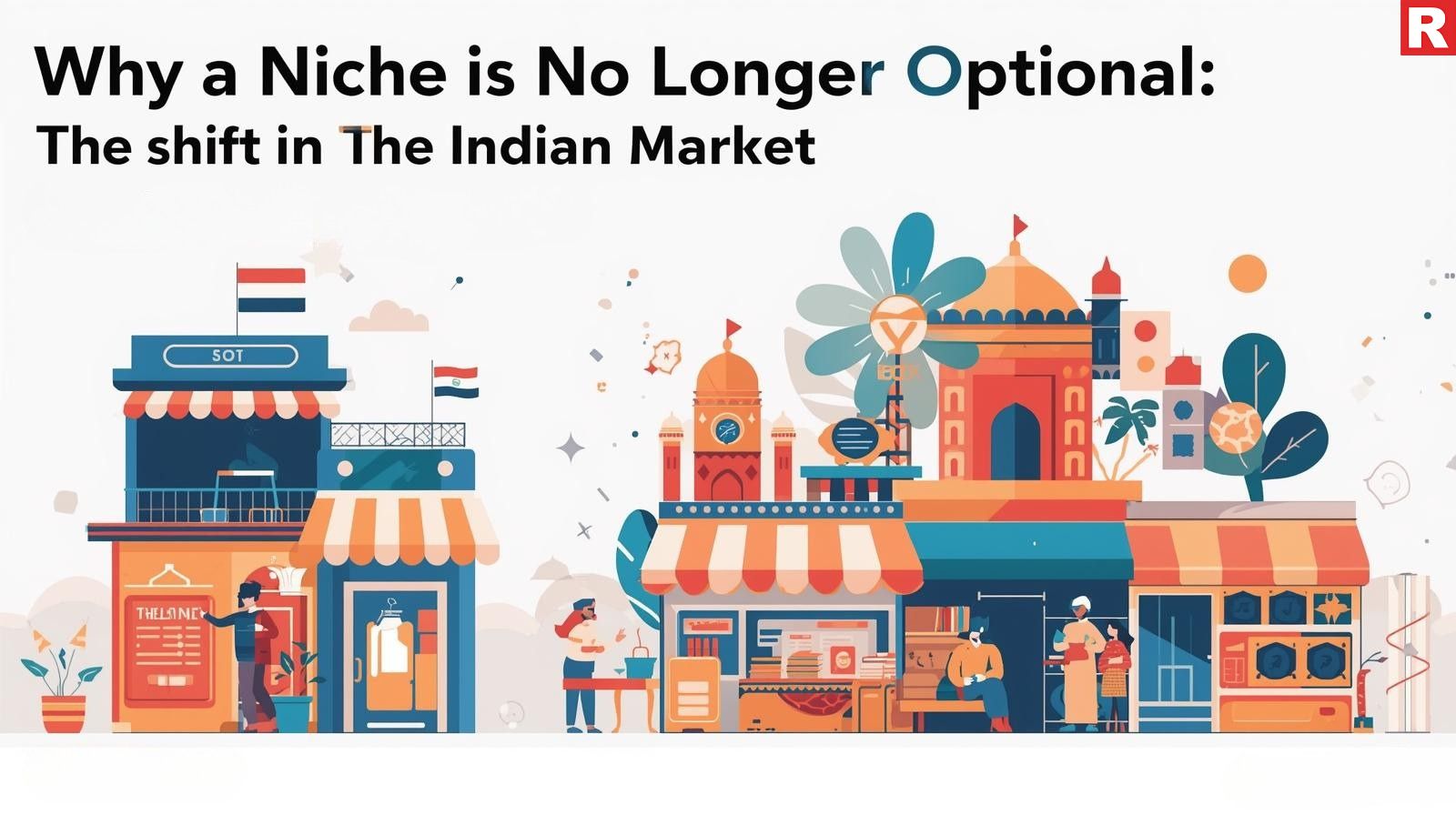
The "anything and everything" restaurant is becoming less popular. One obvious sign of the growth of specialty restaurants is the fundamental change in customer behavior. Here's why having a niche is now essential:
- The Search for Authenticity: Indian diners have become seasoned travellers who are beginning to value real cuisines. A restaurant that advertises that it specializes in both lasagna and biryani is frequently seen as a master of neither. By focusing your knowledge, resources, and enthusiasm on honing a particular dish or idea, you may establish a reputation and confidence in your niche.
- Creating a Powerful Brand Identity: A unique concept stands out in a sea of generic multi-cuisine restaurants. It provides you with a clear and lasting brand identity. A restaurant that serves genuine Goan seafood, for instance, is immediately more distinct than one that is just known as "The Global Kitchen."
- Targeted Marketing: Marketing to a specialized, well-defined audience can be made possible by a niche. Higher acceptance rates and a better return on your marketing effort might result from creating offers and content that appeal directly to their interests.
- Operational Efficiency: Kitchen operations are made simpler with a targeted menu. Less inventory is needed, less food is wasted, and your employees can specialize in a small number of dishes, which improves quality and consistency.
Know more: The Global Diner: Redefining Restaurants Through Quality, Quantity, and Presentation
The Self-Evaluation: Discovering Your Passion by Looking Within

Looking inward is the first and most important step before you ever consider the market. A genuine passion is the foundation of a successful niche. To find your perfect niche and your passion, you only need to ask yourself these three questions.
- What do you have a strong interest in? Does your family have a particular regional cuisine? Is it a specific component, such as sourdough or coffee? Or is it a concept, such as healthy eating or sustainability? You will keep going despite the unavoidable difficulties of running a restaurant because of your passion.
- What knowledge and abilities do you possess? Be practical. Do you have baking skills? An expert in a specific cooking method? Or are you a born host who is skilled at setting a special mood? Make the most of your current strengths in your niche.
- Which tales would you like to share? A story is the foundation of a strong niche. It might be the history of a cuisine, the path taken by a particular ingredient from farm to table, or the tale of your grandmother's recipes. Your brand's core will be this story.
The Market Analysis: Looking Outward for the Gap

It's time to evaluate your niche ideas versus the market once you have a few ideas, depending on your interests. Here's where you find possibilities and gaps in the market.
Determine the Population: Who works and lives in the area you are targeting? Is it a stylish, youthful student crowd? Or is it a mix of office workers and families? It is essential to comprehend their lifestyles, income levels, and preferences. For instance, a business that caters to lunch breaks would have to emphasize value and speed.
Analyze the Competition: Identify your direct and indirect competitors by conducting a competitive analysis. Which markets have become overcrowded already? Does the large number of generic restaurants in your neighborhood present a chance for a unique concept?
Find the Gaps: See what's lacking
- Geographic Gaps: Is there a certain cuisine that is in high demand but not being served in your neighborhood?
- Price Gaps: Does the market have too many expensive restaurants but not a good, affordable niche option?
- Concept Gaps: Is there a lack of health-conscious or vegan options in a market that is showing interest in those trends?
- Occasion Gaps: Is there a need for a late-night cafe or a brunch-focused spot?
What's new: The Pros and Cons: Comparing Franchise vs. Independent Specialty Restaurants
Types of Restaurant Niches
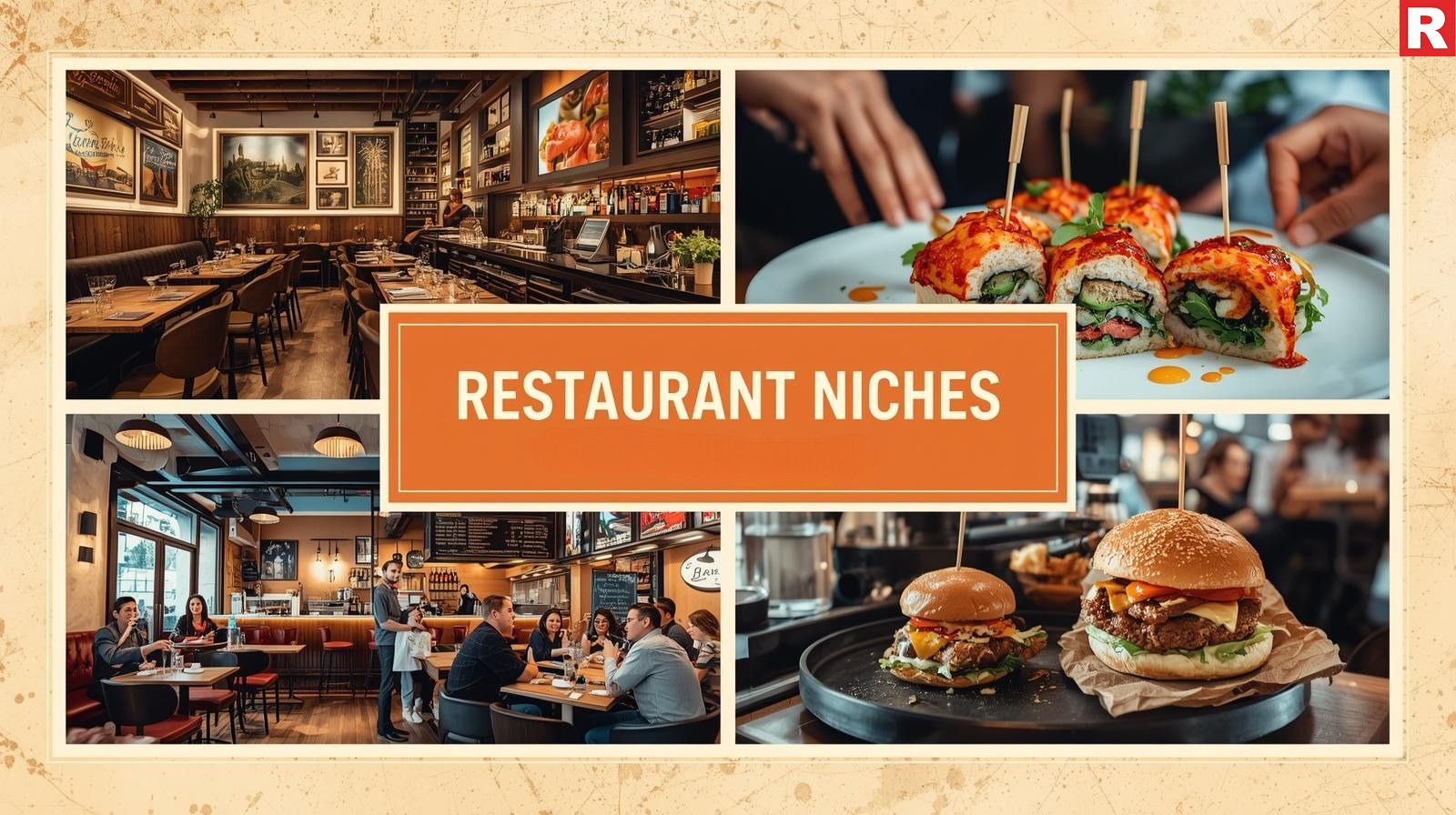
There are various ways to classify niches, and each has particular opportunities and difficulties.
Niche Based on Cuisine: This is the most widespread type of niche in business.
- Indian cuisine by region: Focus on a particular region's cuisine rather than just "Indian food." A Malabari restaurant that specializes in Keralan coastal cuisine, a Chettinad restaurant that serves fiery curries, or a real Rajasthani thali house are a few examples. This approach makes use of the wide variety of Indian cuisine.
- Single-Cuisine International: Authentic Japanese ramen bars, classic Lebanese shawarma joints, or Mexican taquerias are examples of single-cuisine international restaurants that concentrate on perfecting a single international cuisine. This satisfies the rising need for international flavors.
Product-Based Niche: A single notable product serves as the focal point of the entire idea.
- Biryani House: Concentrate on refining this one dish using a range of options (e.g., Kolkata, Hyderabadi, and Lucknow biryani).
- Dosa Bar: Serve a variety of dosas, including inventive fusion dishes and traditional masala dosas.
- Coffee & Bakes: A cafe that goes beyond the typical cafe menu by focusing on handmade baked goods and single-origin coffee.
Concept-Based Niche: A particular theme or idea serves as the foundation for the identification.
- Farm-to-Table: A restaurant that serves a seasonal, constantly evolving cuisine and sources all of its food locally. Customers who are concerned about their health and the environment will find this appealing.
- Themed dining: It refers to a restaurant that has a special theme, such as a historical era, a beloved fictitious realm, or a magical forest. An immersive experience is intended to be created by the menu, service, and décor.
- Health & Wellness: A niche that caters to dietary requirements, like an Ayurvedic-based menu, a gluten-free bakery, or a restaurant that serves only vegan food.
Experience-Based Niche: The actual dining experience is the main attraction.
- Interactive dining: This concept refers to ideas that transform a meal into an entertaining activity, such as live cooking stations, barbecue on the table, or cooking workshops.
- Experiential Cafe: It provides services beyond coffee, such as a reading cafe, a board game café, or one that welcomes pets.
Check out: 10 Restaurant Marketing Ideas That Are Wasting Your Money
The Boom of Quick Dining in Modern Cities
The Niche Validation Test

Before you actually use your funds to open your dream restaurant, validate that your idea is good and profitable.
- Pop-up Restaurant: The final test is the pop-up restaurant. For a brief time, find a tiny area or employ a "cloud kitchen" model and offer your specialty food. This will provide you with practical feedback on your concept and menu.
- Food Festivals & Markets: Hire a booth at a food festival in your area. This is an inexpensive method of determining interest, gathering input, and beginning to develop a customer base.
- Social Media Polls: Find out what your prospective audience wants to see by using Facebook and Instagram. Inquire about concepts, pricing, and menu items.
- Soft Launch: Hold a small gathering or a soft launch for a select group of people before a grand opening. Make final adjustments to your menu and service based on their feedback.
Read this: Five Ways To Boost Your Restaurant's Lunch Rush
Simple Steps To Boost Your Restaurant's Foot Traffic
Building Your Niche's Brand Story

A niche is merely a concept until a strong brand story makes it a reality.
- The Menu as a Story: There should be a story on your menu. Don't merely list foods; describe their history, where the ingredients come from, and their cultural value.
- The Extension of the Decor: Your specialization should be reflected in the way your interior design is done. A contemporary, minimalist sushi bar should have a very different aesthetic from a Rajasthani thali home.
- Staff as Narrators: Your staff members ought to be enthusiastic and informed about your specialty. They are the ones who will tell every consumer about your brand. Teach them to discuss the brand, the idea, and the food.
- Promoting Your Story: Reinforce your niche on your website, social media accounts, and other marketing platforms. Tell behind-the-scenes tales, introduce the individuals who created the recipes, and describe the unique qualities of your idea.
Conclusion
In the Indian restaurant industry, identifying your specialty is a process of self-analysis, market research, and innovative implementation. It is the most crucial choice that will influence the long-term profitability of your business and create its distinct character. You are not just developing a business when you reject the generic and choose a specialized, genuine concept; you are also developing a distinctive food attraction that will appeal to customers, win their trust, and survive over time. Your secret to success in a crowded and cutthroat market is a carefully considered and implemented niche.

Aspiring restaurateurs in India's vibrant and expanding food and beverage industry must make the crucial choice of whether to join an established franchise or launch a specialty restaurant on their own. The decision is not just a question of taste; rather, it is a strategic business option that might impact long-term performance. Both routes have clear benefits and considerable disadvantages. The specialized restaurant model has become more appealing as a result of the rise of the smart Indian diner, who now prioritizes authenticity and unique dining experiences over generic multi-cuisine menus. The dilemma still stands, though: is it preferable to use a franchise's established system and brand power or to create an original brand from the ground up?
This detailed article will compare franchises and independent specialized restaurants in India. We will examine the benefits and drawbacks of each model, examine the important variables that affect this choice, and offer a clear framework to assist prospective restaurateurs in making this important decision. By the end, you will know exactly which path best suits your entrepreneurial spirit, risk tolerance, and business objectives.
Read more: How to Choose the Healthiest Cooking Oil for Your Kitchen
The Franchise Model: The Power of a Proven Blueprint
The franchise restaurants are known for their role in the restaurant industry as a gateway to smooth success. With a restaurant franchise, you can run your own business using an already established brand's name, operating procedures, and intellectual property. This could be anything from a well-known chain like Domino's, Pizza Hut, etc., with an international customer base, to a prosperous domestic brand like Cafe Coffee Day, Haldiram’s in the Indian market.
Pros of a Restaurant Franchise
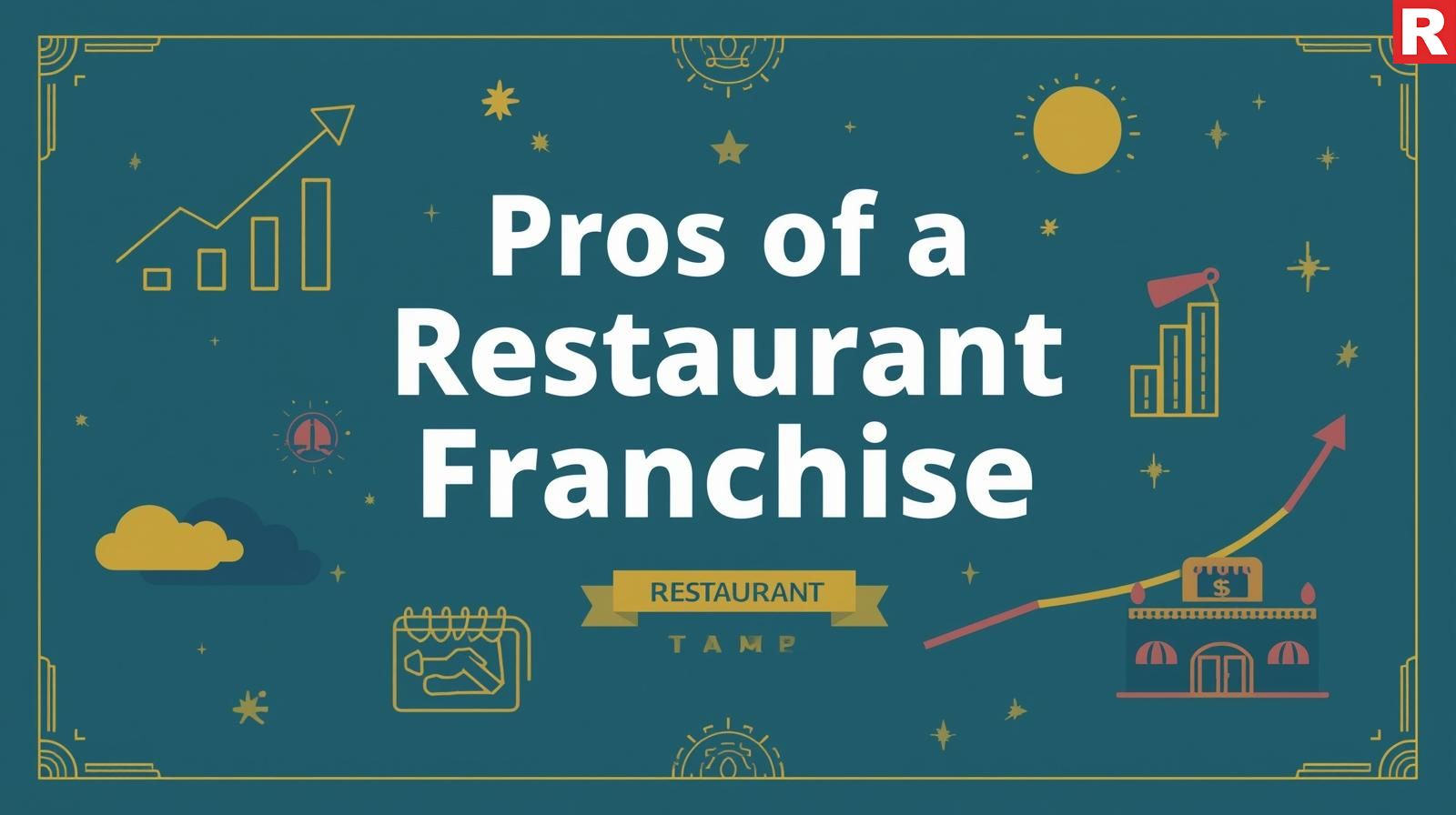
- Brand Recognition and Customer Trust: Perhaps the greatest benefit is customer trust and brand recognition. You have a well-known brand that people are familiar with and trust when you first open for business. Because of the brand's preexisting reputation for quality and reliability, you save a great deal of time and money compared to starting from scratch while building a customer base. This brand recognition is crucial in a crowded market.
- Proven Operations and Business Model: Franchises offer a comprehensive business plan. Everything from staff training and marketing to menu preparation and supplier management is covered in detail in the guides you receive. This removes uncertainty and lowers the possibility of costly operational errors, which are a major hazard for newly independent business owners.
- Established Supply Chain: A network of authorized suppliers and tightly regulated purchasing is are common feature of franchises. This guarantees a continuous supply chain, cheaper pricing because of purchasing power in bulk, and the same quality of ingredients—all of which are crucial in India, where supply can be irregular.
- Ongoing Support and Training: The franchisor provides you with ongoing support as a franchisee. This covers marketing support, operating guidance, troubleshooting help, and basic training for you and your employees. First-time business owners really benefit from this safety net.
- Less Marketing Guesswork: The majority of brand-level marketing and advertising, including digital promotions and national campaigns, is frequently managed by the franchisor. Even if you might donate to a marketing fund, you still gain access to expert, extensive campaigns that would be impossible for you to fund on your own.
Know more: 10 Restaurant Marketing Ideas That Are Wasting Your Money
Cons of a Restaurant Franchise
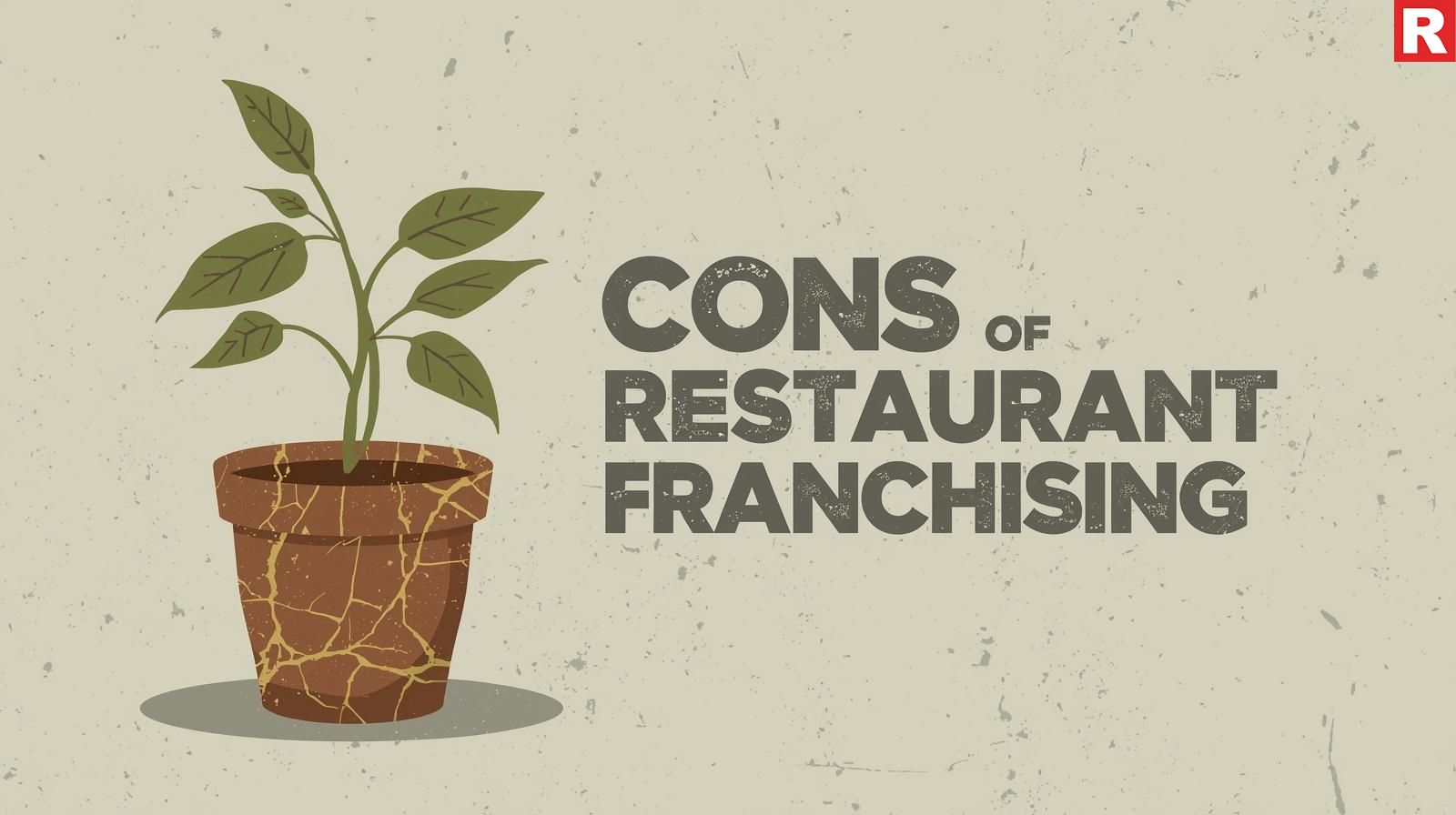
- High Initial Investment and Continuous Fees: Purchasing a franchise might come with a hefty franchise fee, royalties (a portion of sales), and a payment to the brand's marketing fund. Your profitability may be greatly impacted by these recurring expenses.
- Lack of Creative Freedom: The franchise agreement limits your options, regulating everything from the supplier and décor to the menu and prices. Very little space exists for creativity or personalization. For instance, you need corporate clearance before you can launch a new dish to satisfy local tastes. Your creative energy might feel limited by this.
- Operational Limitations: Although a tried-and-true system has advantages, it can also have disadvantages. It may be challenging to adjust the system to local market conditions or a rapid shift in customer preferences due to its lack of flexibility. For a given location, the "one-size-fits-all" strategy might not necessarily be the best one.
- Dependency on the Franchisor's Reputation: Your restaurant's reputation may be damaged without your fault if the franchisor experiences a crisis that damages their brand in another region of the nation. You can lose or gain something as your restaurant is tied to the franchise’s fate.
- Limited Profitability per Unit: Although a franchise model offers stability, it cannot be as profitable as a very successful independent restaurant on a percentage basis because of the continual outflow of royalties and marketing fees.
What's new: Five Ways To Boost Your Restaurant's Lunch Rush
The Independent Restaurant Model: The Path of True Entrepreneurship
An independent specialty restaurant is a business that you start and run completely on your own. You make all of the decisions, including those regarding the menu, marketing, and brand idea.
Pros of an Independent Specialty Restaurant
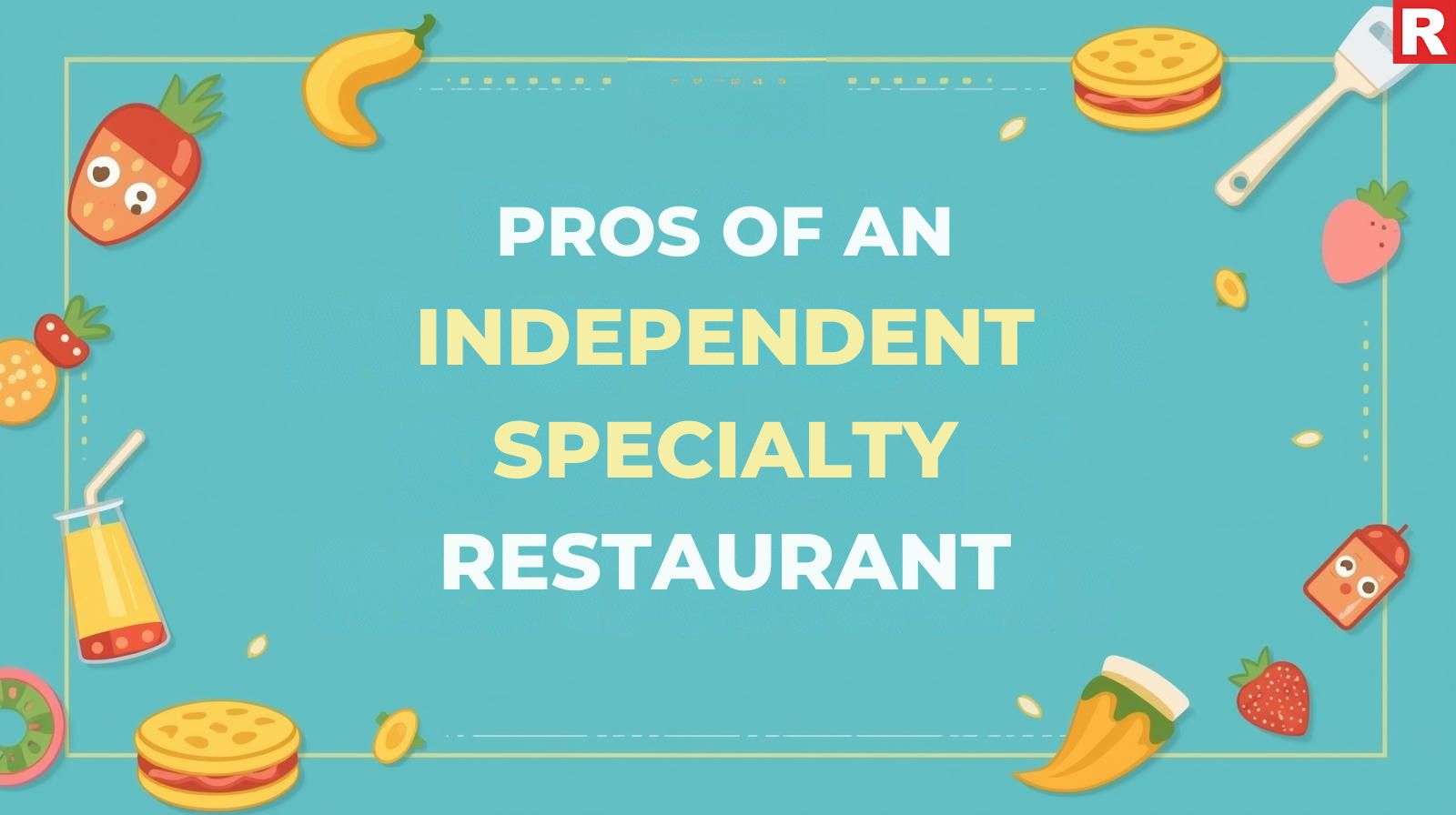
- Full Creative Freedom: This is the biggest advantage. Every element of your business is entirely within your control. You can build a distinctive menu, modify recipes to suit regional preferences (for example, giving a traditional Italian dish a spicy touch for Indian palates), and create a special atmosphere that reflects your personal style. You may create a genuinely unique brand with this freedom.
- Increased Profit Potential: Your profits are completely your own without having to pay royalties, franchise fees, or donations to marketing funds. The potential for larger margins is even bigger than with a franchise if you manage a successful, lean business.
- Flexibility & Adaptability: You can react quickly to customer feedback and changes in the market. You can be the first to add a new cuisine trend to your menu if it appears in your city. In a market that moves quickly, this flexibility is a crucial competitive advantage.
- Personalized Brand Story: The owner's vision and passion are reflected in the brand of an independent restaurant. Customers can develop a strong emotional bond with you through this personal touch, becoming devoted brand ambassadors who take pride in what you've achieved.
- Complete Asset Ownership: You are the owner of all your company's assets, including any value added to the brand. This creates equity that can be transferred, sold, or expanded without the franchisor's consent.
Check out: The Global Diner: Redefining Restaurants Through Quality, Quantity, and Presentation
Simple Steps To Boost Your Restaurant's Foot Traffic
Cons of an Independent Specialty Restaurant
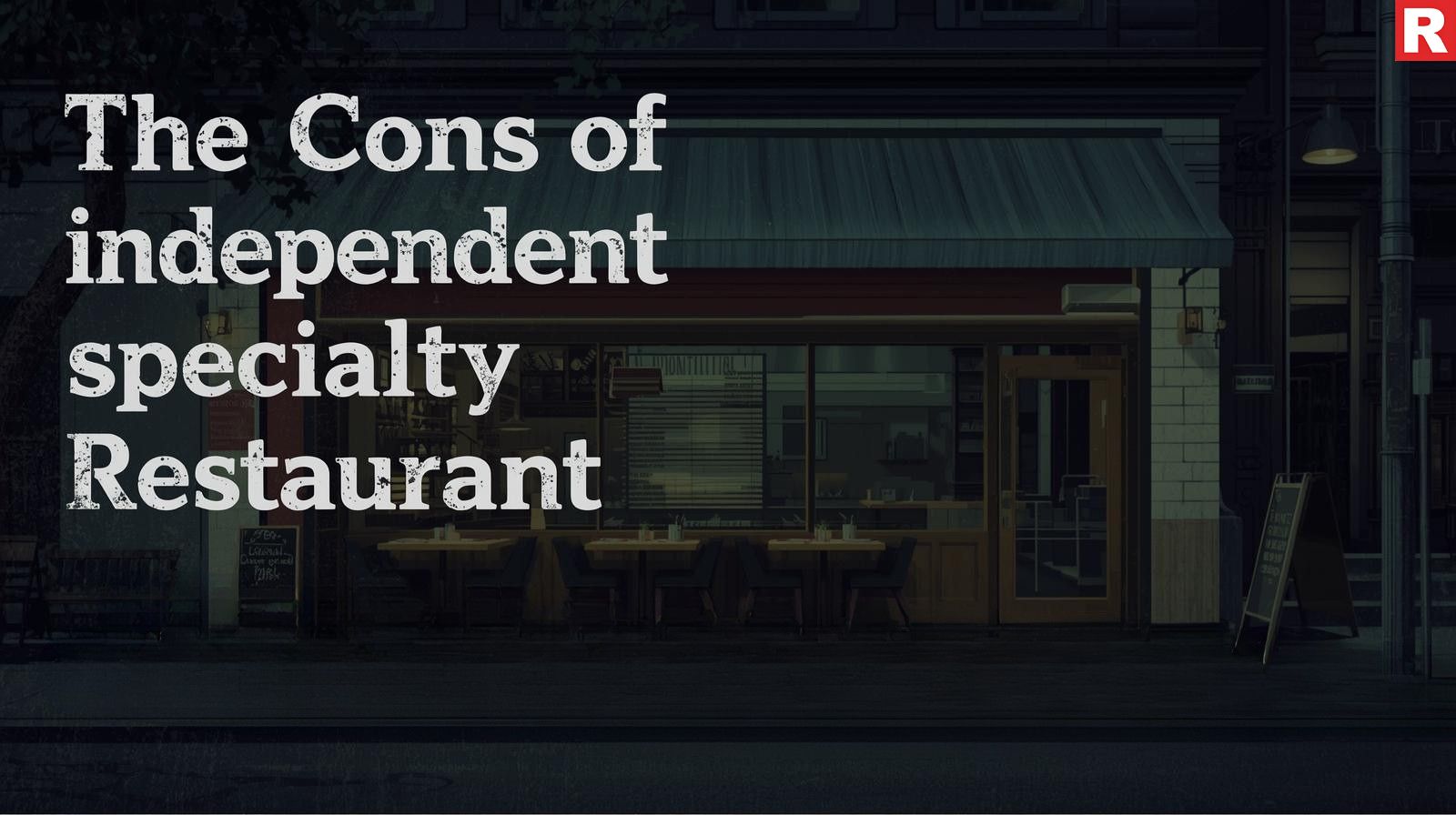
- Significant Risk and Uncertainty: There is a great deal of risk and uncertainty because you are beginning from nothing. There is no recognized brand identity, no safety net, and no tested blueprint. The business's success depends solely on your capacity to develop an engaging idea, carry it out successfully, and attract customers. There is a far greater chance of failure.
- High learning curve and hard work: You are in charge of all business operations, from marketing and finance management to locating suppliers and negotiating contracts. There is a high learning curve, a significant time commitment, and a wide range of skills needed.
- No Centralized Support: You are on your own without centralized support. No marketing crew to assist with promotions, no training manuals to support you, and no one to call for operational problems. You have to start from scratch when building your systems, which is a huge task.
- Building Brand Recognition: You are solely responsible for marketing. Building a brand that stands out and gains the trust of consumers in an increasingly competitive sector may be very difficult and costly. To generate a buzz, you need to make significant time and financial investments.
- Higher Costs: You might have to pay more for ingredients and supplies because you don't have the franchise's bulk buying power. Additionally, you are responsible for paying for any marketing and other support services that a franchise would handle.
Read this: Top Mood-Boosting Foods That Make You Happy
Key Factors to Consider Before Deciding
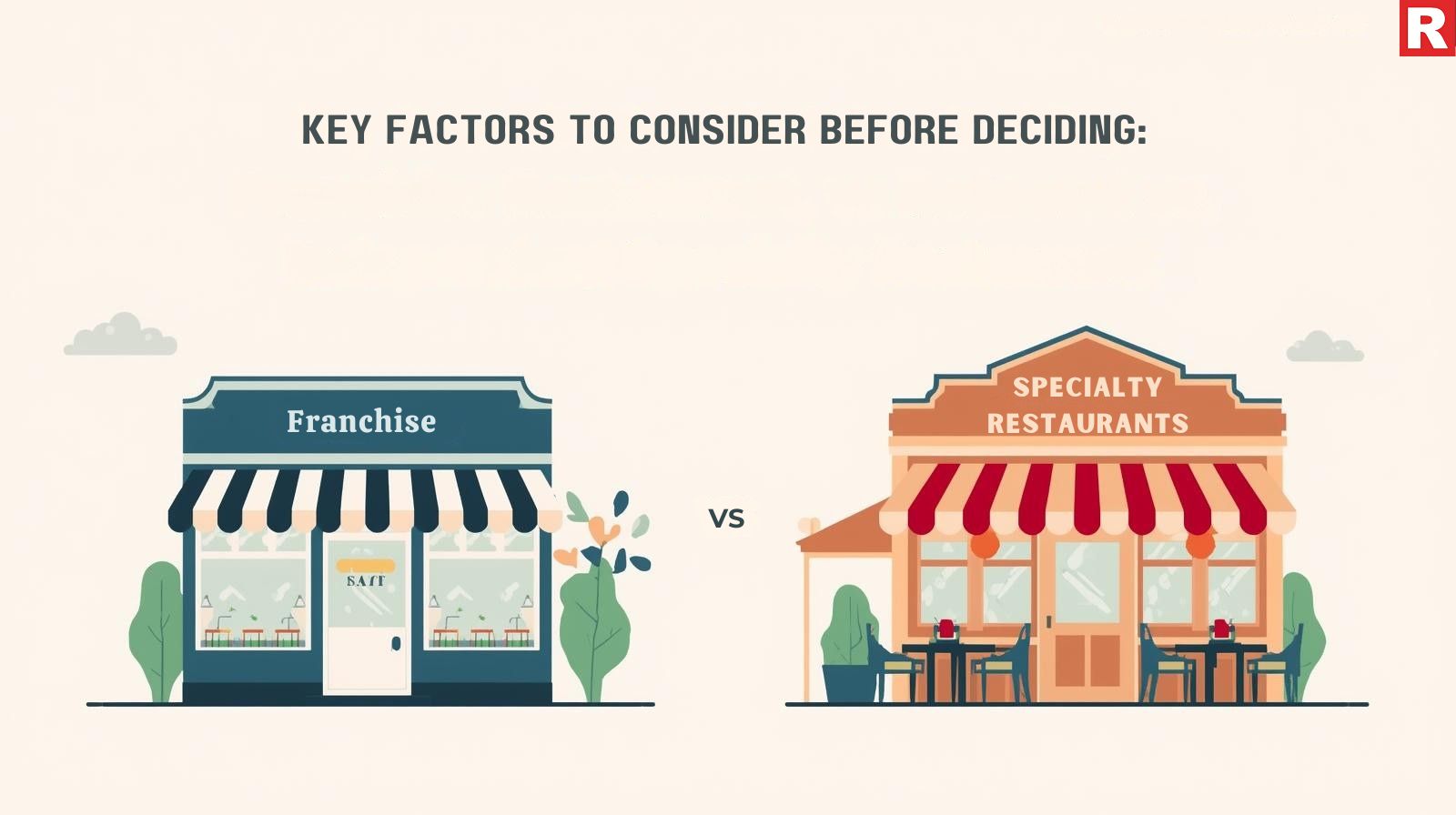
You must consider both the pros and cons in light of your unique financial and personal situation in order to make a wise decision.
- Your Entrepreneurial Personality: Do you enjoy taking chances, being innovative, and the challenge of creating something from the ground up? Or would you rather work in an organized setting with precise rules and a tried-and-true route to success? Which model will make you happier and more productive depends largely on your personality.
- Financial Resources: Do you have enough money to pay a high franchise fee, or would you be better off with a smaller, independent business where you can keep expenses under control? Remember to include an emergency fund and working capital.
- Market Analysis: How does your city's local market appear? Is the industry presently crowded, making a franchise's brand power a required advantage, or is there a niche that an independent specialist restaurant could fill?
- Experience Level: Are you a first-time restaurateur, or do you have experience managing and operating restaurants? While an independent enterprise needs prior experience or a willingness to pick things up quickly, a franchise might offer a helpful crash course in the field.
- Long-Term Goals: Do you want to run a single, successful company that symbolizes your passion, or do you want to own several locations or grow into a major corporation with a well-defined exit strategy? Franchises frequently offer a more stable route to growth.
Conclusion
The decision between an independent specialty restaurant and a franchise is basically highly individual. A franchise provides a more secure, dependable, and organized route to company ownership. For people who wish to be an owner-operator but would rather reduce risk and stick to a tried-and-true method, this is the best option. Stability and support come at the expense of your creative independence.
The independent route, on the other hand, is reserved for the real entrepreneur—the dreamer who wants to create a distinctive brand from the ground up. It is a high-risk, high-reward business that needs a great deal of determination, hard work, and attention to detail. The joy of producing a genuinely one-of-a-kind and customized dining experience is just as rewarding as the money.

During lunch hours, the restaurant sector turns into a major battleground with many potential customers on their way. With locals, students, and office workers looking for a quick, tasty, and affordable lunch meal, the restaurant gets an opportunity to increase its overall profitability and daily foot traffic. But it takes more than just opening the doors to your eatery for the customers to come flooding in and turn them into regular lunch customers. It requires targeted marketing that directly addresses the needs of the midday crowd, effective operations, and strategic planning.
This complete article can help you increase your restaurant's lunch rush by revealing five very successful tactics designed especially for Indian restaurants in urban cities. We'll go over achievable, realistic strategies that can turn a peaceful lunchtime into a bustling, profitable center and guarantee your business gets a piece of the valuable lunch market.
Read more: How to Choose the Healthiest Cooking Oil for Your Kitchen
1. Master the Art of the Lunch Menu: Speed, Value, and Variety
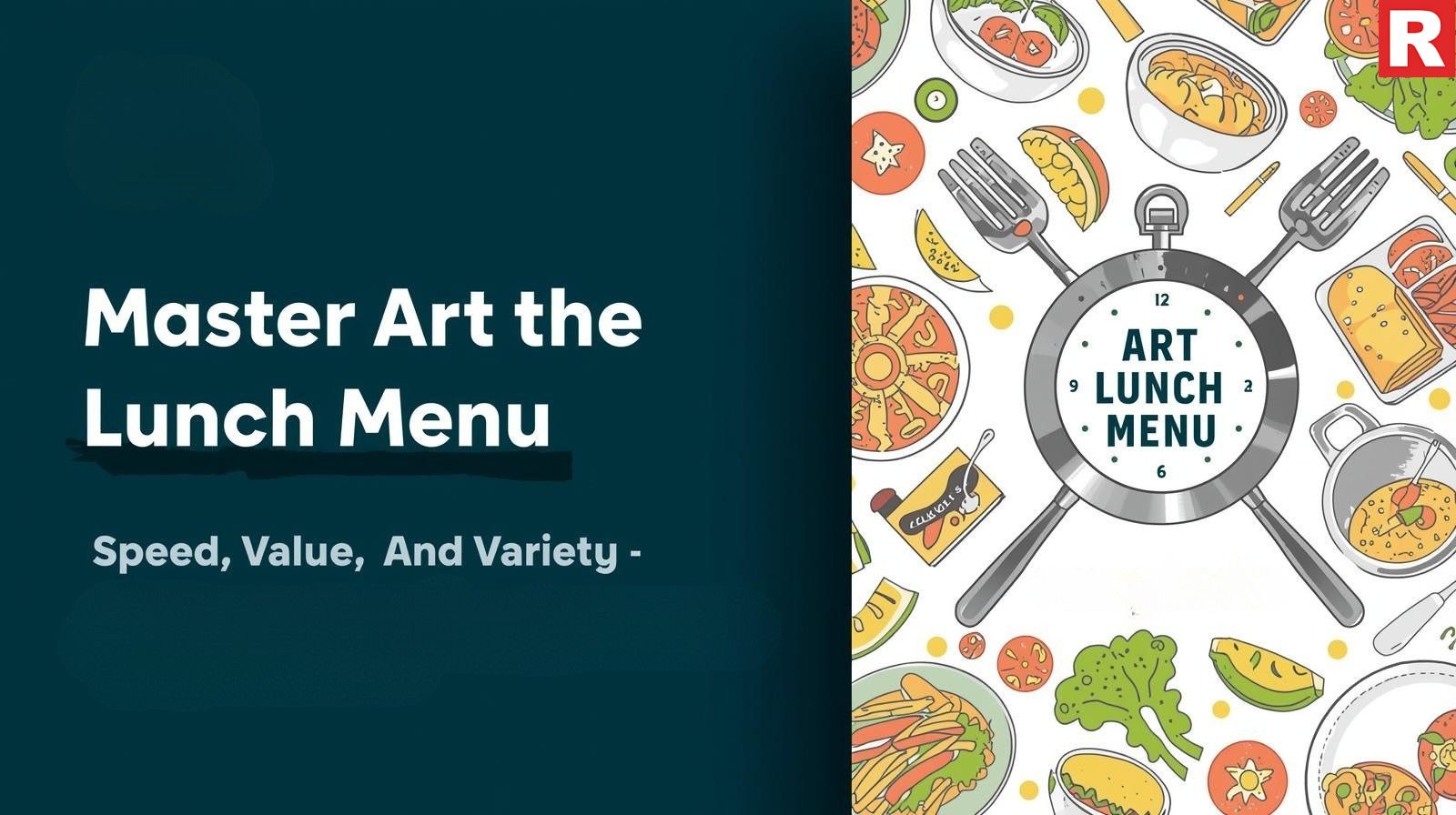
The lunch crowd has specific needs: speed is crucial, variety keeps them coming back, and value is highly regarded. All of this information must be reflected in your menu.
- Speed is King: Fast service is essential since office workers frequently have little time for lunch breaks.
- Pre-Prepped Items: Create recipes that enable a great deal of pre-preparation without sacrificing freshness. This could contain premade sauces, pre-marinated proteins, or pre-chopped veggies.
- "Express Lunch" or "30-Minute Guarantee": Provide a unique, limited menu with a short turnaround time. Promote it as a "Lunch in 20 Minutes or it's on Us!" (i.e., "Express Lunch") that promises to be served within a certain amount of time. This attracts people with busy schedules and develops trust.
- Ordering made easier: Make sure your Point-of-Sale (POS) system is effective and that your staff are properly educated to take orders quickly and precisely. Think of a digital menu that offers quick-order choices.
- Value-for-Money Thalis & Combos: Indian diners are very budget-conscious, particularly around lunchtime.
- Customized Combos: Make eye-catching lunch combo packages that include a main course, bread, a drink, and a side at a discounted cost. A "Butter Chicken Combo" with rice or naan and a soft drink, for instance.
- Traditional Thalis: One of the most traditional lunch options is the Indian thali. Create a variety of tempting thali alternatives that offer a full, balanced meal at a set cost, such as Punjabi Thali, Jain Thali, South Indian Mini-Meal, and North Indian Thali. To encourage return business, make sure your thali's ingredients are diverse.
- Daily Rotating Specials: A "Chef's Special" lunch dish that changes every day can generate buzz and attract regulars to come in more often to sample new dishes.
- Light & Healthy Options: An increasing number of urban workers are concerned about their health. So making a healthy meal combo is a great idea.
- Salads & Wraps: Serve nourishing wraps or fresh, visually beautiful salads with dressings inspired by India.
- Low-Calorie/High-Protein Options: Indicate clearly whether foods are higher in protein or lower in calories.
- Fresh Juices & Smoothies: To go with lighter meals, promote healthy and refreshing beverage options.
- Optimize Menu Presentation: Emphasize these specials on a separate, smaller lunch menu. Make it quick to scan and easy to read.
Know more: McDowell pledged stake in UBL decline by 3.02 per cent
2. Strategize Your Marketing: Reach the Noon Crowd Where They Are

For targeting the specific groups that are active during the midday hours, your lunch marketing campaigns should be different from your dinner promos.
Outreach to Local Offices and Businesses:
- Leaflet Drops/Digital leaflets: Deliver leaflets or send specific digital flyers to Faridabad's business parks, industrial regions, and office complexes. Emphasize your exclusive offers and fast lunch options.
- Corporate Tie-ups: Provide employees of surrounding businesses with exclusive corporate discounts or lunch packages. To make billing easier, think about creating a corporate account.
- "Lunch Meet" Promotions: Promote your restaurant as the perfect location for business lunches, providing a calm atmosphere and effective meeting service.
Using Digital Platforms While Having Lunch:
- Targeted Social Media Advertising: Run ads solely in the late morning and early afternoon on sites like Facebook and Instagram. Target consumers according to their occupation, hobbies (e.g., "office lunch," "quick bites"), and location (e.g., within 5 km of your restaurant).
- Google My Business Posts: To announce daily lunch specials, deals, or express lunch hours, use GMB's "Posts" tool. Local search results prominently display them.
- WhatsApp Marketing: Use WhatsApp in the late morning to distribute daily lunch specials or flash sales to your list of customers who chose to join in.
Strategic Partnerships with Delivery Aggregators: Use websites like Zomato and Swiggy to increase visibility at lunch, but refrain from offering excessive discounts. Instead of offering deep discounts on individual items, use these platforms to showcase your "Express Lunch" options or offer exclusive package bargains. Reach fresh customers with them, then turn them into direct orders.
"Walk-in Specials": Draw customers in by prominently posting "Walk-in Lunch Specials" outside the restaurant. Price and a tempting image can have an impact.
What's new: Simple Steps To Boost Your Restaurant's Foot Traffic
3. Enhance Speed & Efficiency: Operations that Deliver
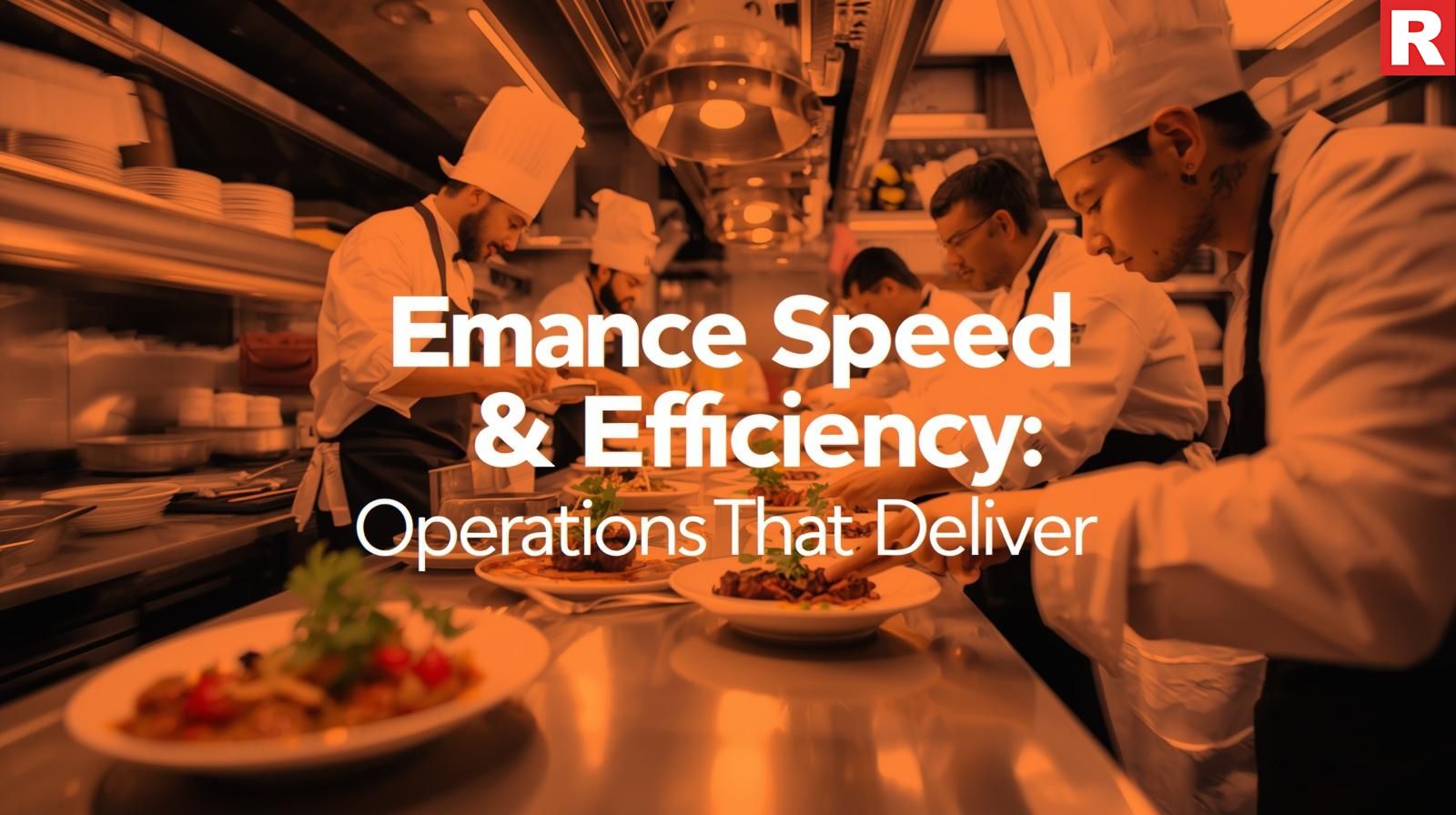
An incredibly efficient operation is necessary for an excellent lunch menu and marketing to be successful. Speed affects the entire service flow, not just the kitchen.
Simplified Kitchen Procedures:
- Prepping: Prioritize careful preparation each day so that food may be put together and prepared fast in the heat.
- Dedicated Lunch Stations: To prevent delays, if at all possible, set up different counters for high-demand lunch items.
- Batch Cooking: Take into account batch cooking for ingredients that can be swiftly finished or reheated, such as rice, dal, or gravies.
Front-of-house (FOH) service optimization:
- Well-Trained Staff: Make sure your front-of-house staff have had outstanding training in order taking, menu knowledge, and managing several tables at once without becoming stressed.
- Fast Seating & Billing: Reduce waiting times for seats and make sure that billing is completed quickly and correctly. This procedure can be significantly accelerated using mobile point-of-sale systems.
- Pre-Set Tables: To save time during the rush, have tables ready with water and simple silverware.
Effective Communication: Encourage open and constant discussion about order status, special requests, and possible delays between the kitchen and front-of-house workers. If possible, use KDS (Kitchen Display Systems).
Inventory control: Make sure your well-liked lunch items are always available. To prevent last-minute sourcing problems, keep high-demand ingredients at appropriate stock levels.
Check out: 10 Restaurant Marketing Ideas That Are Wasting Your Money
The Boom of Quick Dining in Modern Cities
4. Create an Inviting Ambiance: The Midday Comfort Zone

Lunch atmosphere should put comfort, productivity, and an enjoyable rest first, while dinner ambiance can be more romantic and mood-driven.
- Comfy Seating: For a quick meal, make sure your seating is comfy. This means comfortable seats where office-goers can take a quick break.
- Proper Lighting: For lunch, plenty of natural light is best. To create a lively yet cozy ambiance, add artificial lighting that is bright but not harsh.
- Right Music: Playing lively, subtle music at a moderate volume is the right choice. For anyone taking a quick break or working lunch, it should be stimulating without being invasive.
- Hygiene & Cleanliness: As always, maintaining perfect cleanliness is crucial. A hygienic setting, particularly in the restrooms, inspires trust and promotes return business. This assumption is non-negotiable in the Indian environment.
- Convenience & Accessibility: Make sure your restaurant has prominent signs so people can locate it easily. Emphasize parking if you have it, as it may be a big draw for lunchtime visitors.
5. Create a Culture of Regulars: The Power of Repeat Business
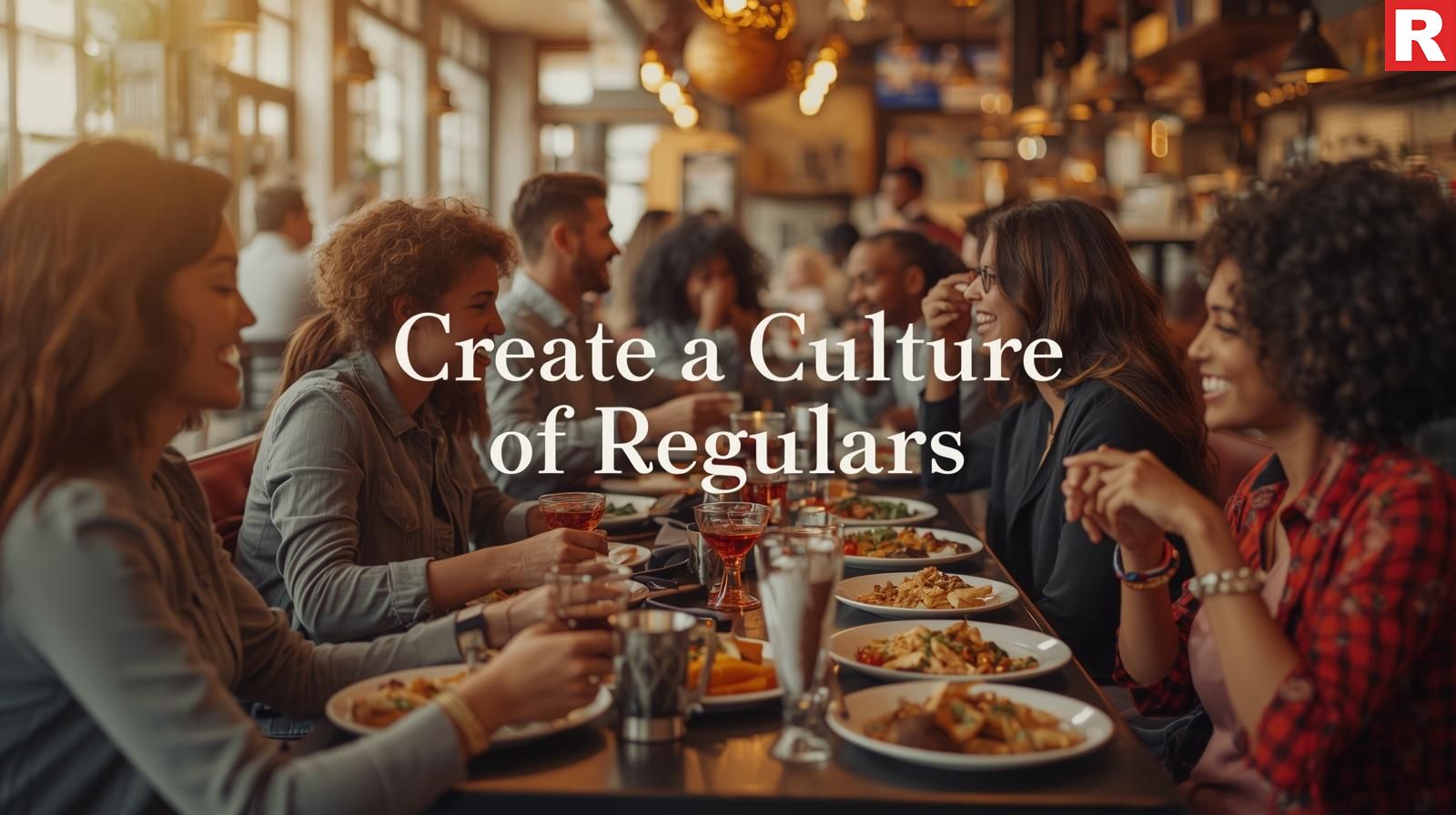
The most sustainable strategy to grow your lunchtime business is to turn one-time lunch customers into committed regulars.
- Personalized Service: Teach your employees to identify and even recall the orders that they prefer. "The usual, sir?" can foster a great deal of loyalty and goodwill.
- Lunch Loyalty Programs: Establish a special lunch-related loyalty program. For instance, a punch card that reads, "Buy 9 lunches, get the 10th free," or points that may be redeemed for a complimentary meal.
- Feedback & Engagement: Make an effort to get input from your lunch customers. You may make them feel appreciated by understanding their requirements and preferences through a brief conversation or a survey QR code.
- Special "Regulars" Perks: From time to time, give your regular lunch patrons little, unexpected benefits like priority seating, a free dessert, or a discount on their next visit.
- Maintain Consistency: Repeating business is based on maintaining consistency. Fast service, consistently delicious food, and a welcoming atmosphere guarantee that customers know precisely what to expect and won't be let down.
Read this: Top Mood-Boosting Foods That Make You Happy
Conclusion
In a cutthroat market of urban cities, increasing your restaurant's lunch rush requires a calculated approach that blends operational excellence, focused marketing, and sincere hospitality. You can turn your lunch service from a quiet time into a major source of income and customer interaction by perfecting your lunch menu for speed and value, strategically marketing to the midday crowd, making sure your operations are incredibly efficient, creating a welcoming atmosphere, and building an engaged base of regulars. Recall that the goal of the lunch rush is to offer a convenient, fulfilling, and joyful experience that encourages customers to return day after day, week after week, rather than only selling food.

In a restaurant, customers visit, and increasing foot traffic is the biggest hurdle in an already tough and competitive market. Just having excellent cuisine with tempting dishes is not enough, as there are many different dining options available. Ranging from street food to gourmet cuisine, if a marketplace has many eateries available, then the chance of standing out gets very low. Therefore, increasing foot traffic requires a comprehensive strategic approach that blends modern marketing strategies with classic hospitality. Gaining the attention of many people is important, as some can even become your potential customers in the future. This is necessary for the survival and expansion of the restaurant, whether it is a long-standing restaurant or a newly built cafe.
Therefore, this comprehensive article will guide you by revealing simple, practical measures created especially for Indian restaurants. We'll go beyond general guidance to offer achievable, affordable tactics that appeal to the local market and assist you in turning empty tables into a bustling, prosperous dining area.
Read more: How to Choose the Healthiest Cooking Oil for Your Kitchen
Become Visible Where It Counts Most By Learning Local SEO

In the current digital era, a phone search is frequently the first step on the way to your restaurant. Gaining customers in your area requires a thorough understanding of SEO.
- Improve Your Profile on Google My Business (GMB): This is perhaps your most important tool and your online marketplace.
- Claim and Verify: Make sure your GMB profile has been claimed and validated.
- Accurate Information: Provide accurate details, including your name, address, phone number (NAP), and website. Make regular updates to your operation hours, including special holiday hours.
- High-quality Photos: Post a ton of expertly taken, delectable pictures of your food, exterior, interior, and even your staff members. For Indian restaurants, aesthetic appeal is important.
- Categorization: Use different categories instead of just "Restaurant," such as "North Indian Restaurant," "Vegan Cafe," and "Biryani House."
- Encourage & Address Reviews: Kindly request positive Google reviews from pleased clients. Every review, whether positive or negative, should be handled professionally and sympathetically. This demonstrates involvement and fosters trust.
- Online Directories: Verify that other important local directories, such as Zomato, Swiggy, TripAdvisor, and Justdial, have an appropriate listing for your restaurant.
Know more: The Boom of Quick Dining in Modern Cities
Create an Eye-Catching Exterior Appeal
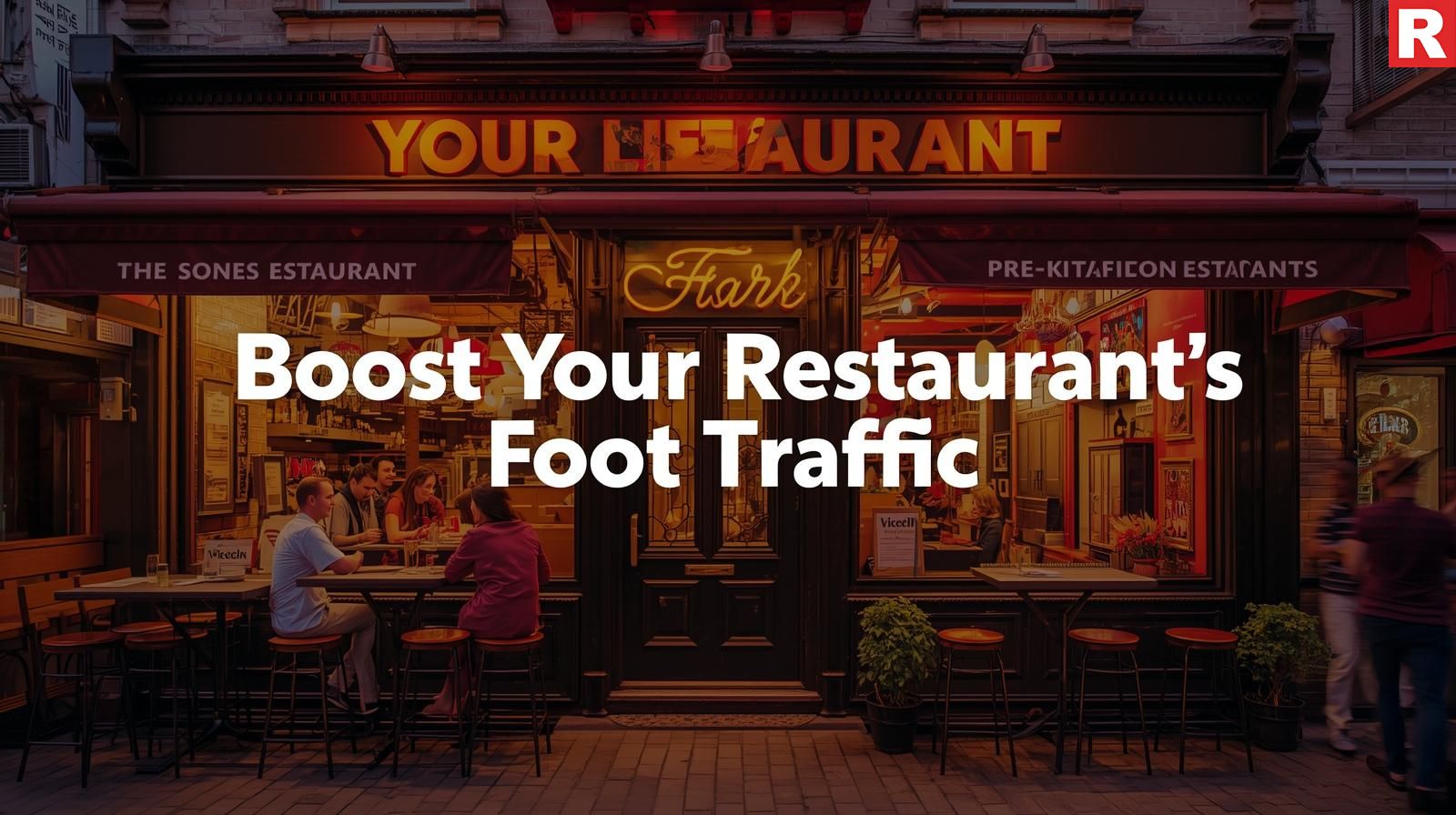
Potential customers evaluate your restaurant based on its appearance before they even try your food. Therefore, first impressions are crucial.
- Cleanliness is Godliness: In India, it is important to emphasize that cleanliness is associated with godliness. Therefore, the customer must walk on a neat hallway, with shining windows, and a clean, well-maintained exterior. By keeping things tidy, even a tiny cafe can project professionalism.
- Inviting Signage: Day or night, your restaurant's name and logo should be easily recognizable and eye-catching. Think about using subtle lighting to draw attention to your business.
- Inspiring Window Displays: If at all possible, use your windows to display your best meals (via clear photographs), daily specials, or a sneak peek at your warm interior.
- Outdoor Seating: If there is space available, a few neatly maintained outdoor tables can greatly improve visibility and give the impression that your restaurant is livelier and friendlier, especially in lovely weather.
- Lighting: In the evenings, use cozy, welcoming lighting. It draws customers and gives your restaurant a homey appearance.
Grip the Power of Local Promotions & Community Engagement
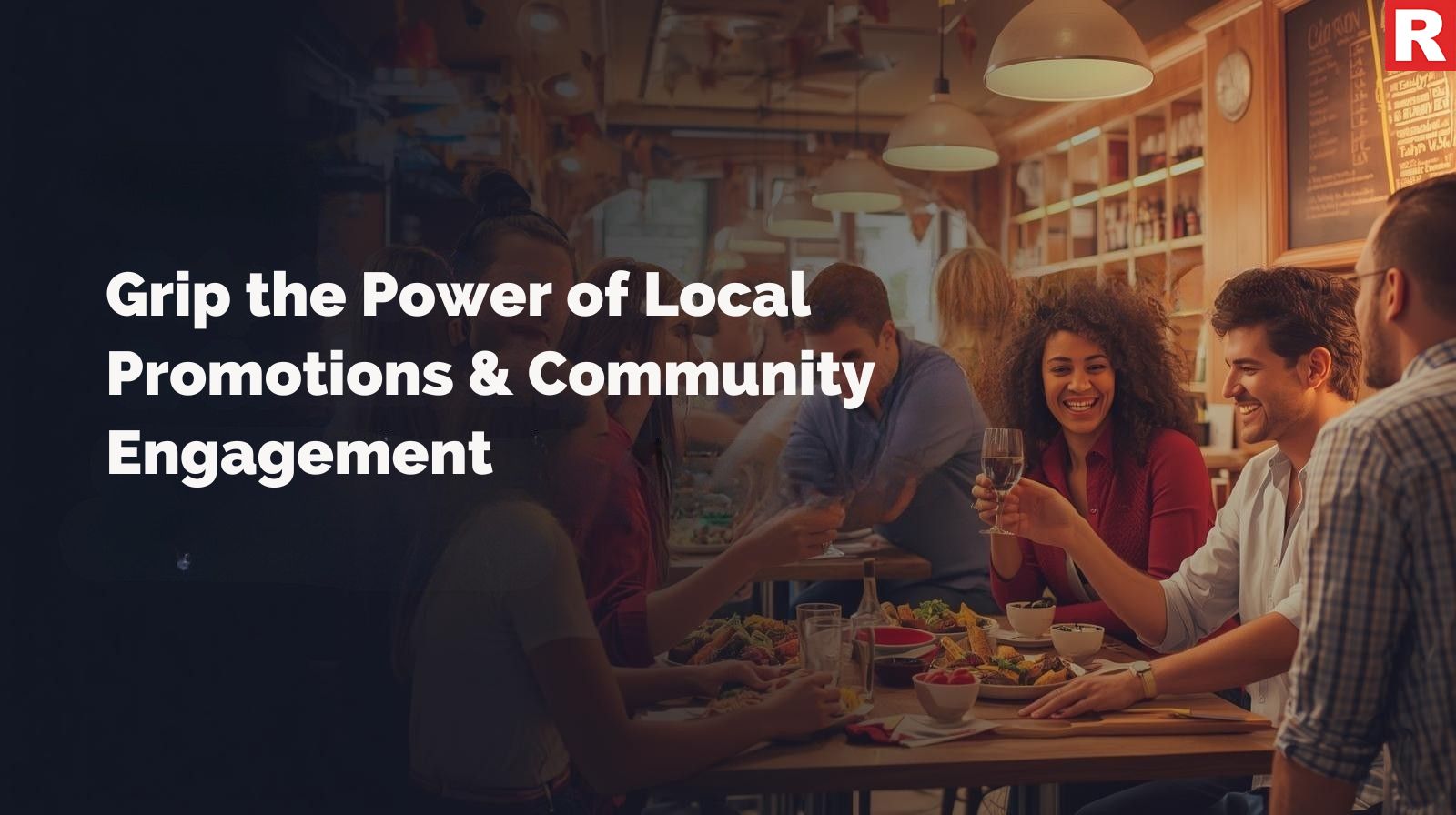
Become an active and well-liked member of your local community. This will give you power over the market in the long term.
- Daily deals & Happy Hours: To attract customers during off-peak hours, provide simple daily deals or a weekday happy hour with drinks and appetizers. Promote these clearly on a chalkboard outside and on your social media.
- Loyalty Programs: Implement a simple loyalty scheme - "Buy 5 get 1 free" for coffee, or a points system for total spend. This promotes return visitors.
- Partner with Local Businesses: Work together with local gyms, shops, or workplaces to provide members and staff with exclusive discounts. Cross-promotion increases your target market.
- Organize Local Events: Take into account organizing small events for the community, such as a book club meeting, a "meet the chef" night, or a showcase for local artists. This presents your restaurant as a community hub.
- Promotions with a seasonal or festival theme: Take advantage of regional celebrations or Indian holidays like Diwali and Holi. To attract groups of people who want to celebrate, provide unique festive cuisines, decorations, and promotions.
What's new: 10 Restaurant Marketing Ideas That Are Wasting Your Money
Boost Your Internet Presence Outside of (GMB) Google My Business

Although GMB is important, your entire internet presence is also crucial. Focusing on just one platform will make you lose customers that you could find on other platforms.
- Social Media Storytelling: Tell the tale of your restaurant on sites like Facebook and Instagram.
- Excellent Visuals: Share mouthwatering pictures and brief clips of your food, behind-the-scenes kitchen activities, and happy customers.
- Participate: To create a sense of community, answer questions, conduct surveys, and reply to comments.
- Emphasis on Staff: Draw attention to your cooks and staff. People in India tend to connect with the faces behind the brand.
- Local Influencers: Work together with food bloggers and micro-influencers. A sincere evaluation from a reliable local source might increase traffic significantly.
- An easy-to-use website (or a strong digital menu): It's essential to have even a basic website with your menu, hours, address, and phone number. Make sure it works on mobile devices. Make sure your digital menu on Zomato or Swiggy is comprehensive and visually appealing, if a whole website isn't practical.
- Online Reservation System: An easy online reservation system makes it easier for customers to organize their visit to more luxurious restaurants.
Create an Irresistible In-House Experience
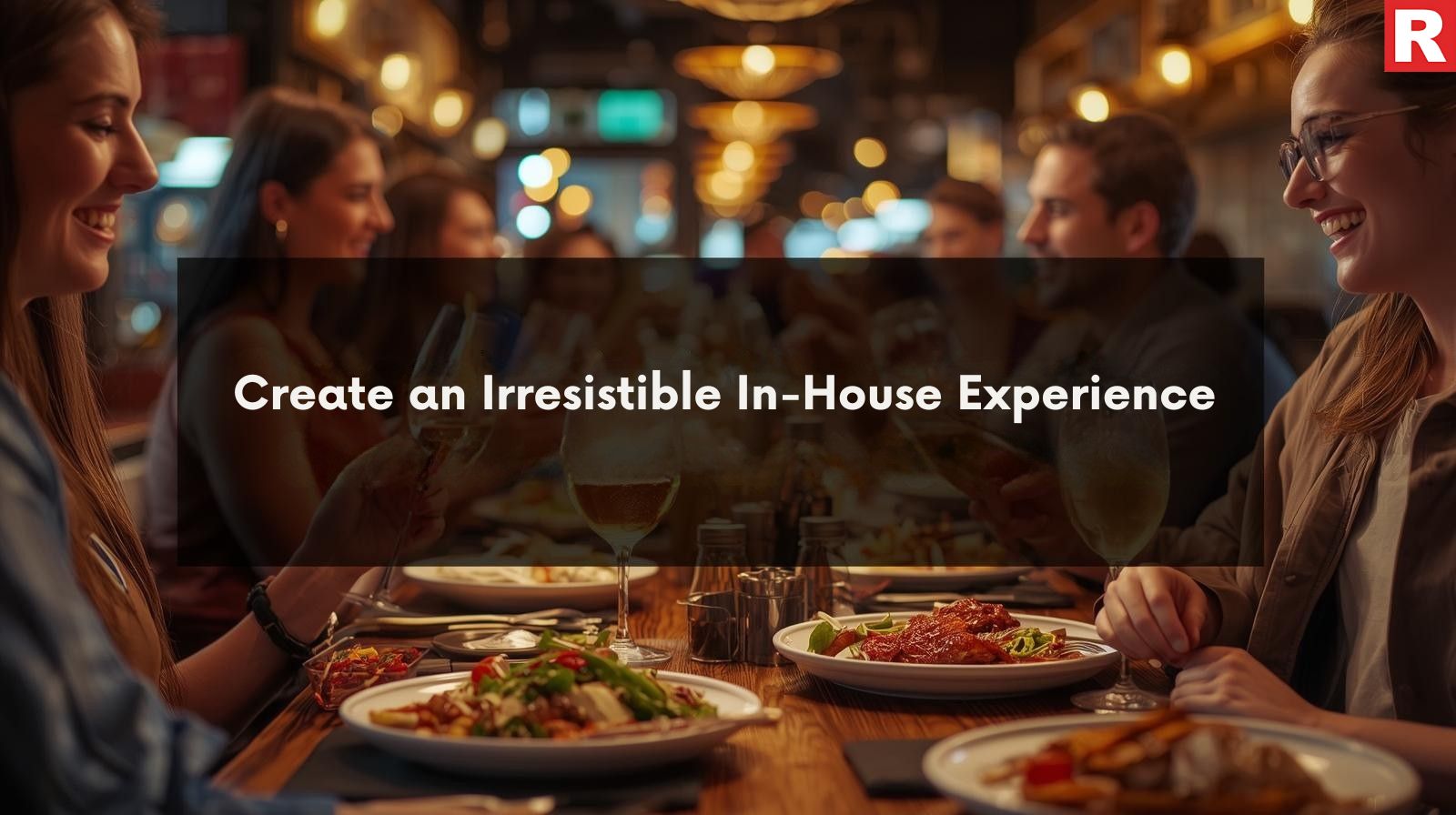
Whether or not customers return and recommend a restaurant depends on their experience once they enter.
- Excellent Service: Teach your employees to be kind, hospitable, focused, and familiar with the menu. Atithi Devo Bhava, or hospitality, is highly prized in India. Fast order processing, timely seating, and effective delivery are essential.
- Food Quality Consistency: This cannot be compromised. Your criteria for quality should always be met by every dish. An easy way to lose clients is to be inconsistent.
- Internal Ambiance & Cleanliness: Make sure your dining space is tidy, well-lit, and welcoming. Take note of your restaurant's music, temperature, and even aroma.
- Upselling and Cross-selling: Teach your employees to kindly recommend appetizers, desserts, or specialty beverages. This improves the customer experience in addition to raising your average check.
- Feedback Mechanism: Conduct a quick survey using a QR code so that customers can easily offer feedback while they are still in the restaurant. Deal with any problems right away.
Check out: Top Mood-Boosting Foods That Make You Happy
McDonalds starts all-day breakfast in Australia
Value-Driven Pricing and Transparent Offers

Value is very important to Indian customers.
- Competitive Pricing: Examine the prices of your rivals to make sure your menu is appropriately positioned for your target market.
- Combo Meals & Thalis: Provide affordable combo meals or classic Indian thalis, which are particularly well-liked for lunch.
- Family Packs/Group discounts: A big attraction in the Indian market, these discounts encourage larger gatherings and family meals.
- Transparency in Offers: To prevent unhappy customers, make sure the terms and conditions of any specials you offer are clear.
Staff as Your Front Line Marketing Team
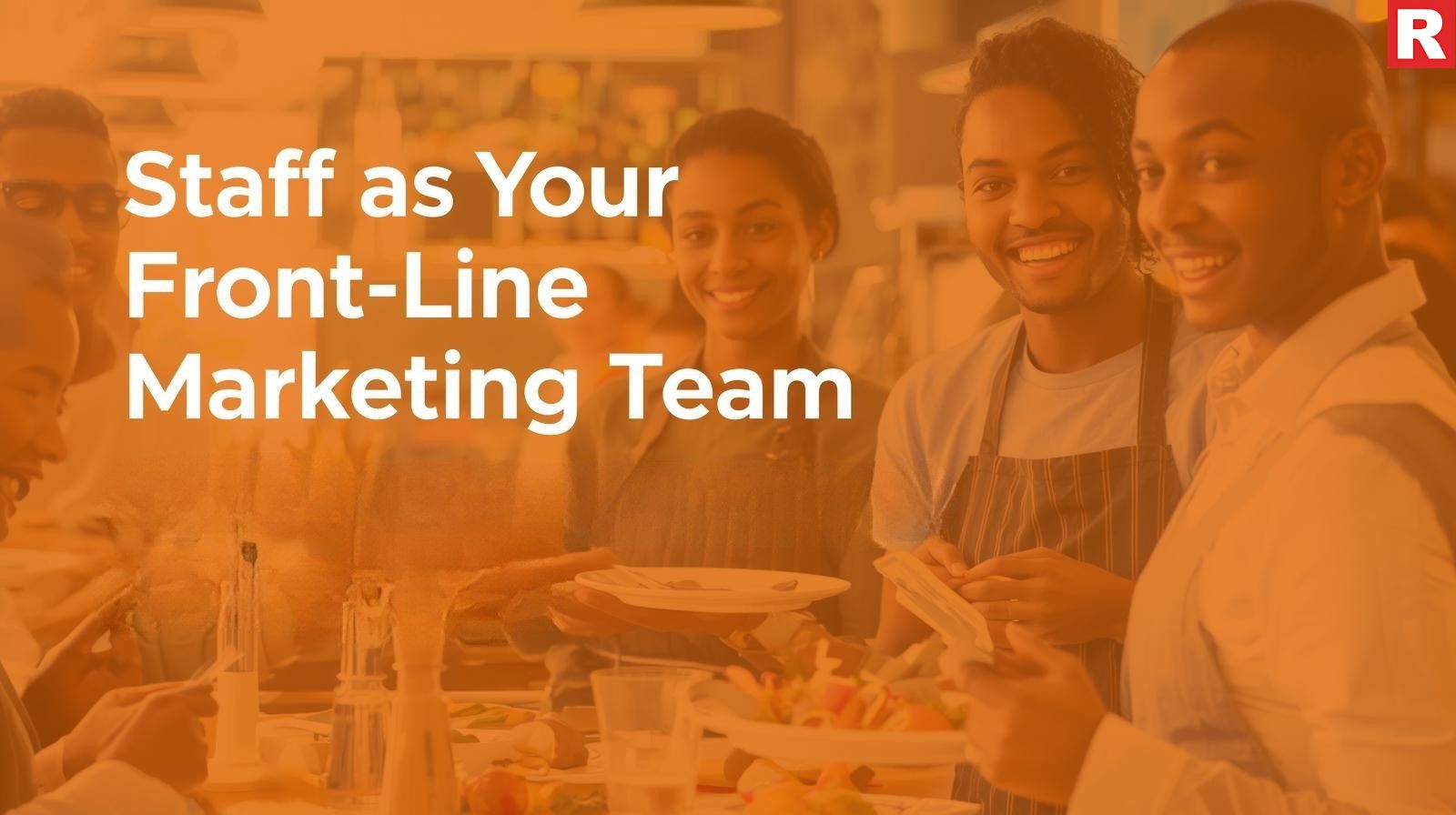
The most effective marketing tool you have is your employees.
- Empowerment: Give your staff the freedom to handle little problems immediately and give clients a sense of special treatment.
- Product Knowledge: Make sure they are able to explain each meal with assurance, suggest combinations, and respond to inquiries regarding ingredients.
- Personalized Service: To foster a feeling of personal care, encourage employees to keep in mind the preferences of regular customers.
- Professional Appearance: The general impression of your restaurant is enhanced by a staff that is well-groomed and presents itself professionally.
Read this: From Bharat to the World: The Rise of home-grown Start-ups
Things NOT to Do: The Foot Traffic Killers
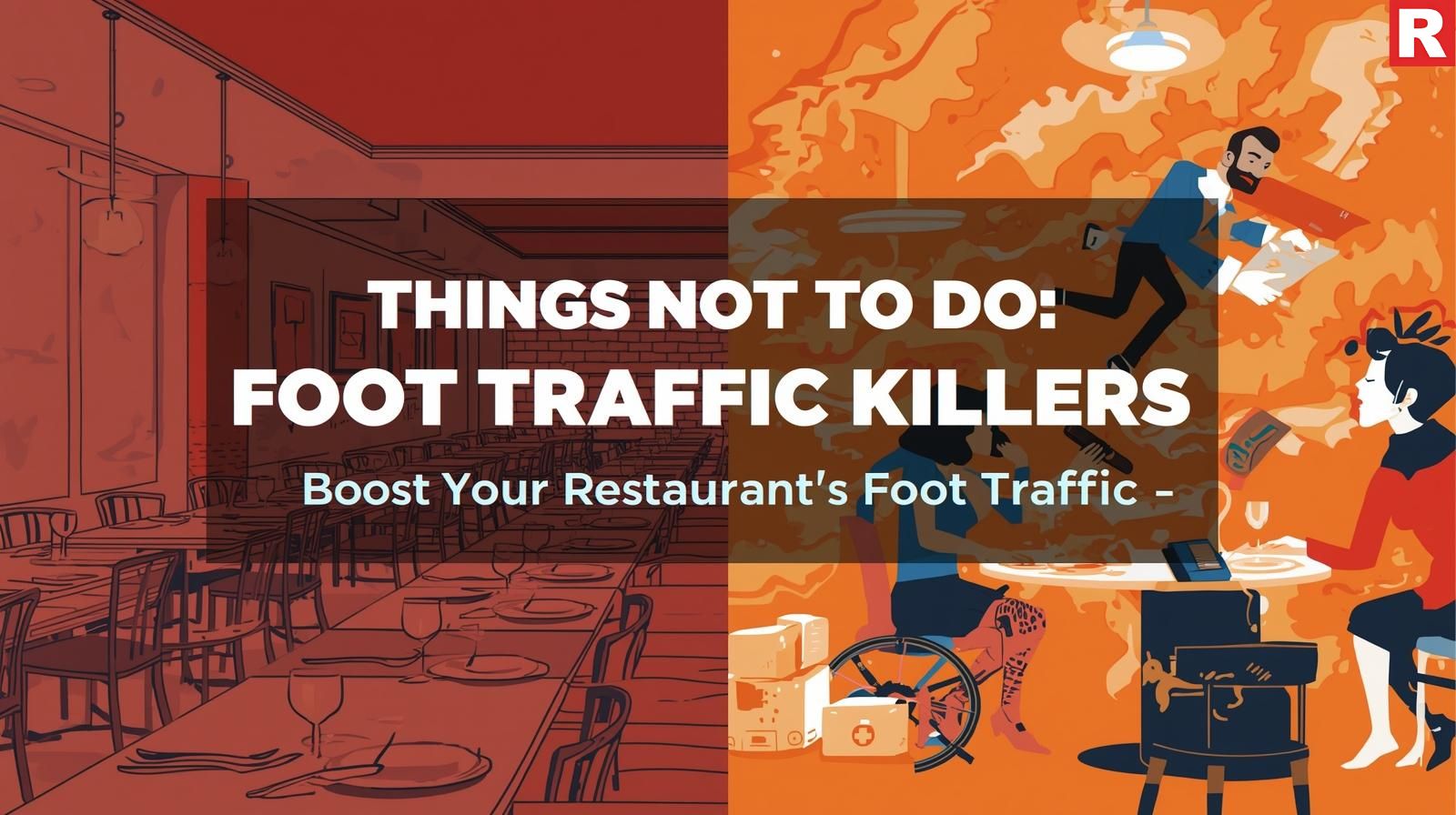
- Ignoring Your Online Presence: If you neglect a Google My Business profile that contains false information or out-of-date hours, you will undoubtedly lose potential customers who will be searching for you online.
- Spending Money on Untargeted Ads: Stay clear of generic, broad-based social media advertising since it is ineffective and does not reach the targeted demographic.
- Making Hygiene Compromises: Indian diners place a high value on cleanliness, thus never make hygiene or cleanliness compromises.
- Over-reliance on Aggregators: You can't develop a direct, enduring relationship with your clients if you just use food delivery aggregators like Zomato and Swiggy. Instead, encourage in-person visits by offering rewards for online orders.
Conclusion
It takes more than just good intentions to increase foot traffic to your business in a vibrant market. It requires a comprehensive strategy that skillfully combines a solid web presence, a welcoming physical location, vibrant community involvement, a superb in-house eating experience, and a value-driven mindset. You can turn your restaurant from a neglected location into a busy center by carefully concentrating on these easy yet effective procedures. Keep in mind that each customer who enters your establishment is an opportunity. Make sure to remember you need to make customers who are not just there for a single order, but for a long-term partnership that supports your business and makes your restaurant a popular dining destination.

Every rupee spent on marketing must yield a measurable return in the fiercely competitive Indian food and beverage sector. However, many restaurateurs, from a tiny cafe to a huge fine-dining restaurant in a big city, fall into the trap of using marketing techniques that actively deplete their cash flow in addition to being ineffectual. On the surface, these tactics frequently appear to be the proper thing to do, but a closer examination shows they are just expensive diversions.
This detailed article will highlight ten typical restaurant marketing strategies that are ineffective and offer practical, affordable solutions that are suited to the Indian market. We will assist you in locating your business's marketing leaks and redirect your funds to strategies that increase sales, foster true client loyalty, and guarantee continuous profitability.
Read more: The Boom of Quick Dining in Modern Cities
1. Excessive Reliance on Aggregator Discounts (Zomato & Swiggy)

The Problem: There is no denying the temptation of a speedy sale on websites like Zomato and Swiggy. However, relying too much on deep discounts (such 50% off or buy one, get one free) might be disastrous for your finances. When combined with steep discounts, these sites' high commissions have the potential to transform a profitable order into a loss. Additionally, this tactic draws in "discount hunters" who aren't committed to a brand and will go to the next restaurant that offers a better bargain. In short, you are teaching your customers that they should never purchase your meal at full price.
The Solution: Instead of using these platforms as your main marketing tool, use them strategically. Offer special combination meals or loyalty points for regular orders in place of major discounts. Converting these customers into direct, loyal customers should be your priority. With each delivery order, include a tiny card with a great offer for their next direct order from your phone number or website. Instead of competing solely on price, concentrate on presenting your own unique value proposition.
2. Generic, Un-Targeted Social Media Advertising

The Problem: It would be like throwing a handful of biryani into a crowd and praying it lands on the right person if you were to invest money in a broad social media advertising campaign without first identifying your target audience. It is a huge waste to display advertisements to every Facebook user if you are a premium dessert shop. You are spending money on views and clicks from consumers who aren't interested in your offering.
The Solution: Ads on social media should be used with extreme care. Facebook, Instagram, and other platforms allow highly targeted advertising. Users can be targeted according to their location (for example, within 5 km of your business), hobbies (for example, "foodie," "fine dining," or "coffee lover"), age, and even actions (for example, often traveling or liking competitor pages). This maximizes your return on ad expenditure by guaranteeing that your advertising is viewed by the individuals who are most likely to become customers.
Know more: Top Mood-Boosting Foods That Make You Happy
3. Paying for Fake Reviews and Bot Followers

The Problem: Given the intense competition on Zomato, Swiggy, and Google Reviews, there is a huge temptation to purchase 5-star reviews or thousands of fake followers. But this is a risky and shortsighted strategy. Consumers are growing more skilled at identifying fake reviews, such as when there is an unexpected spike in 5-star ratings with generic remarks. Additionally, having a large number of followers but no interaction (likes, comments, or shares) makes you appear extremely suspicious and reduces your credibility.
The Solution: Gain followers and reviews naturally. Concentrate on providing a remarkable eating experience. After a delicious meal, teach your employees how to courteously request reviews. To demonstrate that your brand is active and reliable, reply to all reviews, both favorable and unfavorable. Genuine reviews—even ones that include both constructive and positive criticism—create a lot more trust than a series of fake 5-star ratings.
What's new: How to Make a Failing Restaurant Successful Again
4. Lavish Print Ads in Local Newspapers
The Problem: In India's increasingly digital society, placing pricey print advertisements in local newspapers is frequently an outdated and unproductive strategy. The demise of print media is a worldwide problem. You have no method to gauge the ad's efficiency or return on investment (ROI), and the reach and engagement are both extremely low. It's a "spray and pray" strategy that offers less responsibility.
The Solution: Redirecting this budget to digital alternatives is the answer. Make a specialized digital marketing investment. Establish a powerful Google My Business profile, which functions as a free online billboard. To promote your business, work with regional digital news sources or run targeted social media advertisements. These techniques have a far wider audience and, most importantly, let you monitor your progress.
5. Overspending on Interior Design Without a USP

The Problem: It's frequently believed that a fancy, pricey interior design is merely a marketing tactic. Even though creating a visually appealing atmosphere is crucial, investing crores in décor without a strong marketing strategy or unique selling proposition (USP) is a guaranteed way to fail. Customers may come out of curiosity, but they won't come again if the food and service aren't good.
The Solution: Instead of overpowering your concept, your interior should enhance it. If you are a specialty restaurant, it should be reflected in its decor. A restaurant that serves real Rajasthani food, for instance, ought to have décor that evokes the location and culture. Instead of just spending a lot of money, the emphasis should be on establishing a cozy, tidy, and distinctive atmosphere that complements the overall brand story.
6. Ignoring Your Google My Business Profile

The Problem: This is one of the most common mistakes, and since it's a totally free marketing tool, it isn't very pleasant. Claiming and optimizing their Google My Business (GMB) profile is something that many restaurateurs overlook. You are invisible when a potential consumer looks for "restaurants near me" on Google Maps if your GMB profile is not optimized. A profile is a lost opportunity if it lacks a menu, accurate hours, and updated images.
The Solution: The answer is to enhance your GMB profile and claim it completely. Add expertly taken, high-quality pictures of your food and interior. Update your hours, particularly around the holidays. Share daily events or specials using the "Posts" feature. Customers should be encouraged to write reviews, and each one should be answered. GMB frequently serves as a new customer's initial point of contact, and a properly maintained profile can be your most powerful marketing tool.
7. Hiring a Full-Time Marketing Team Too Early

The Problem: Employing a full-time, in-house marketing team is sometimes an unnecessary and costly luxury for small or medium-sized restaurants. Their overhead expenses and salaries can significantly deplete your cash flow, particularly if your company is still in its early stages or you lack specific marketing objectives.
The Solution: The answer is to hire a freelancing expert or a small, reasonably priced organization that handles marketing on a project-by-project basis. Without the commitment of a full-time income, these experts can assist with paid advertising campaigns, website SEO, and a focused social media strategy. As your company expands and your marketing requirements increase in complexity, you may want to think about hiring an inside staff member.
Check out: McDonalds starts all-day breakfast in Australia
Coca-Cola India posts double digit growth in Q1
8. Relying on "Loud" Banners and Street Flyers
The Problem: A loud banner or advertisement shoved into a car's windshield is frequently ignored or, worse, viewed as an annoyance in today's overcrowded urban environment. These traditional methods of advertising are nearly impossible to monitor and offer a very poor return on investment. You have no idea how many flyers ended up in the trash can or how many people noticed your banner.
The Solution: Change the word "loud" to "smart." Make use of targeted digital advertisements that showcase your menu and atmosphere. Work together to provide cross-promotions with nearby companies. For instance, a cafe and a local yoga studio could collaborate to provide members with a discount. This creates a community and guarantees that the right people hear your message.
9. Ignoring Customer Data and Analytics

The Problem: Despite having advanced Point of Sale (POS) systems that gather a lot of data, plenty of restaurants do not make use of it. They are unaware of the best-selling foods, the busiest periods, or the most successful campaigns. All marketing decisions are made based on intuition and speculation in the absence of this data.
The Solution: Examine your POS data on a regular basis. Make use of this information to guide your marketing plan. For instance, launch a social media campaign to advertise your dessert menu if your point-of-sale data indicates that your sweets generate a lot of profit. Make data-driven decisions by using website and social media analytics to monitor the effectiveness of your efforts.
10. The delusion of "Build It and They Will Come"

The Problem: Of all the marketing rumors, this one is the most harmful. It's the idea that people will find you on their own if you simply build a restaurant with delicious food and a pleasant atmosphere. This is just incorrect in the crowded market of today. Even if you have the greatest food in town, your doors won't be filled if no one knows about it.
The Solution: Acknowledge that marketing is a continuous, vital aspect of your business's success and not a one-time occurrence. You should start developing your brand story, interacting with the community, and establishing an online and offline presence as soon as your concept is complete. To survive and grow, any business, regardless of how good it is, must actively sell itself.
Know this: Delight Foods raise second round of funding
Conclusion
Spending money sensibly, rather than excessively, is the secret to restaurant marketing success in India. You can free up important resources and put them toward initiatives that produce a definite, quantifiable result by recognizing and getting rid of inefficient marketing techniques. Prioritize creating a genuine brand, utilizing affordable digital tools, and, above all, delivering a memorable dining experience that makes each customer your greatest voice. Your success will ultimately be determined by the observable growth and loyalty you generate, not by the amount of money you spend on marketing.

For a restaurateur, whether in India or anywhere else in the world, seeing the gradual decline of their restaurant business is the most depressing experience they can have. A restaurant is more than simply a business for all the restaurant members and staff. It is a community center, a creative outlet, and a project to show their passion. In such a situation, it feels tempting to give up your whole business, as your sales stop, the reviews become negative, and the restaurant seems empty day by day. However, failure is nothing more than an escape rather than a destination. It is possible to turn the tables around with a lot of hard work, a smart approach, and a healthy dose of patience. And, in this article, we are doing nothing but help you with achieving just that.
Therefore, the essential steps of a restaurant revival will be covered in detail in this article, from identifying the underlying cause and setting priorities to financial diagnosis, menu redesign, team rebuilding, and re-engaging with the community. We'll go over practical strategies that have worked well in the Indian market to assist you in turning your failing business into a profitable success.
Read more: The Boom of Quick Dining in Modern Cities
The Financial Autopsy: Finding the Root Cause
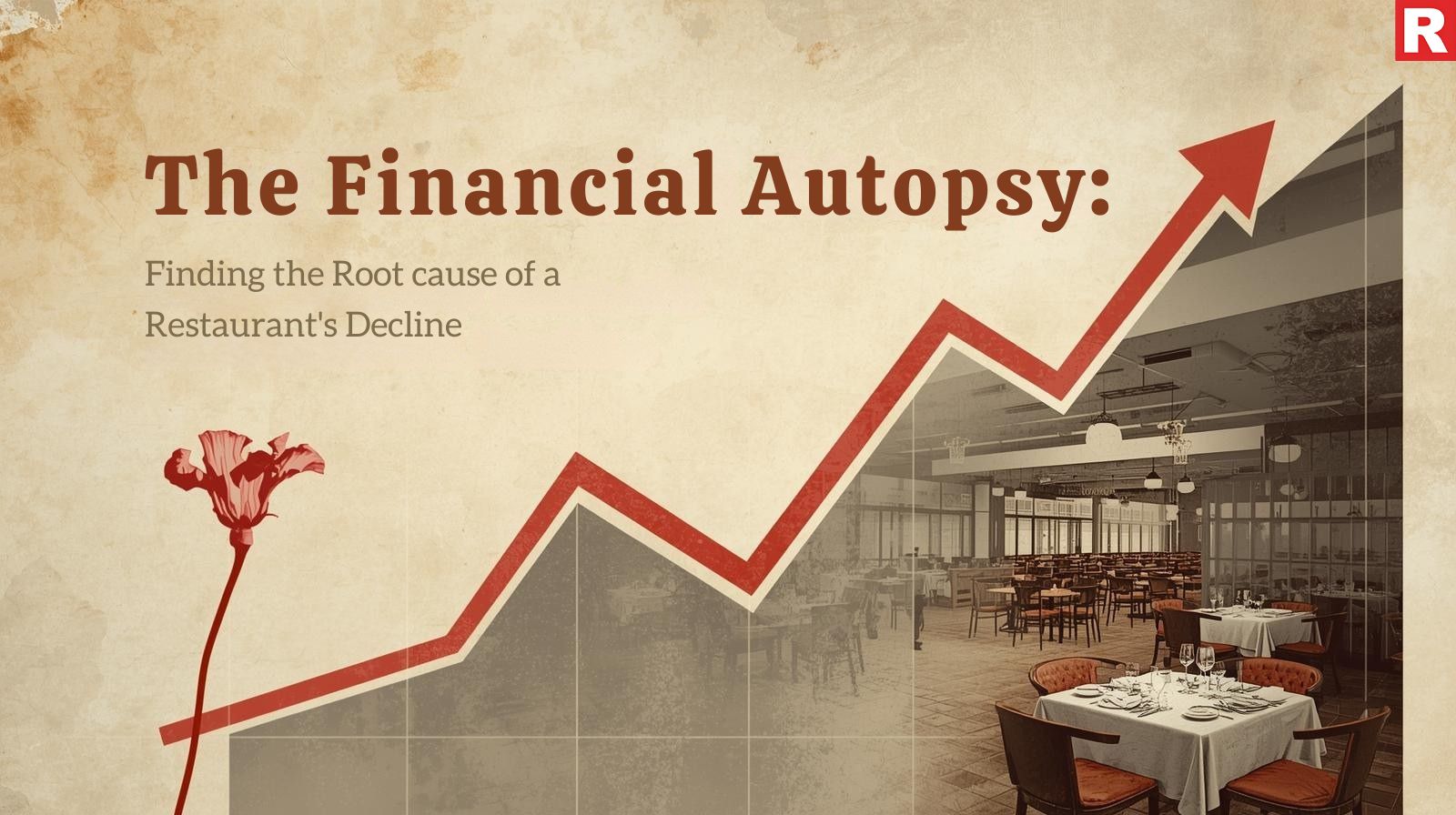
Understanding the root cause of any problem is necessary before you can fix it. The financial problems of a failing restaurant frequently show themselves as problems with money, but this is rarely one of the variables at play. It is a sign of more serious problems with the product, marketing, or operations.
- Examine your P&L (profit and loss) statement: Don't just focus on revenue. Is your food cost % excessively high, suggesting inadequate portion control or ineffective inventory management? Is low productivity or overstaffing causing labor costs to eat into your profits? Are you spending too much money on useless marketing? Examining your P&L in detail will show you where the money is going missing.
- Review Your Cash Flow Statement: Examine your cash flow statement to see how money is actually moving. Do you frequently find it difficult to make on-time rent, salary, or supplier payments? In locations where severe weather affects foot traffic, is there a seasonal decline that you're unprepared for? Survival depends on an understanding of the cash flow, not only profitability.
- Conduct a Break-Even Analysis: Do a break-even analysis by figuring out how much money you must make each day or each month to pay for all of your fixed and variable expenses. This will provide you with a specific, non-negotiable goal and assist you in determining the amount of revenue growth or cost reduction that is required to turn a profit.
- In-depth Analysis of Customer Feedback: This kind of data indicates quantitative problems. Examine comment cards, online reviews (Zomato, Swiggy, Google Reviews), and direct conversations with customers. Are there frequent complaints regarding the atmosphere, food quality, service, or cost? When it comes to pinpointing problem locations, these insights are invaluable.
- Analysis of Competitors: What distinguishes successful rivals? Examine their food, prices, atmosphere, advertising, and customer support. This might show you where your restaurant is falling behind or losing out on chances.
Know more: Top Mood-Boosting Foods That Make You Happy
Making a List of Identified Problems

After the evaluation stage is finished, it's time to compile all of the results into a complete list of issues. Be truthful and neutral, even if the facts make you uncomfortable.
Financial Issues:
- High percentage of food costs (e.g., certain foods producing losses).
- Excessive labor expenses (such as having too many employees at off-peak hours).
- Small check size on average.
- Excessive costs for utilities.
- Ineffective cash flow management, such as having too much money invested in inventories.
Product & Menu Problems:
- A menu that is outdated or unattractive.
- Inconsistent taste or quality of the dish.
- Dishes that don't suit the tastes of the current customers.
- High food waste as a result of big servings or unpopular goods.
- Lacking in USP (unique selling proposition).
Problems with Operations and Services:
- Long wait times or slow service.
- Employees who lack motivation or training.
- Inadequate customer service, such as impolite employees who don't pay attention.
- A lack of cleanliness or hygiene.
- Ineffective procedures in the kitchen.
Brand and Marketing Concerns:
- Bad reputation on the internet (bad reviews).
- Inadequate marketing or lack of awareness.
- Outdated décor or brand image.
- Inconsistent communication.
- No customer retention plan or loyalty program.
External factors and location:
- Declining foot traffic in the neighborhood.
- Nearby are new, fiercely competitive competitors.
- Inability to adjust to changes in the local market.
Check out: McDonalds starts all-day breakfast in Australia
Brewed to Perfection: How Automation is Shaping India’s Café Culture
Giving Priority to Urgent Problems: The Triage Approach

It's simple to become overwhelmed when faced with a lengthy list of issues. Like emergency care, a triage approach is essential. Prioritize the most important problems first, those that pose an immediate threat to closure or have a significant negative influence on the customer experience.
- Financial Leaks: Stop the bleeding first if you're losing money. This could indicate:
- Drastically cutting waste: Strict portion control and improved inventory management for extremely perishable foods are two ways to reduce waste drastically.
- Negotiating with suppliers: Asking for more time or longer payment terms for a temporary period is one way to deal with suppliers.
- Tightening labor schedules: Reducing hours during known slowdown periods is one way to tighten work schedules.
- Temporary pricing changes: To increase cash flow right away for a select few high-demand, high-profit dishes.
- Critical Customer Service Failures: If unhygienic conditions, lengthy wait times, or unfriendly staff are driving away consumers, these issues need to be resolved right away.
- Immediate staff retraining: Staff should receive immediate retraining with an emphasis on speed and basic service manners.
- Deep cleaning: A complete renovation of the space.
- Correction and Apologies: Express genuine regret and promise to put things right with recently dissatisfied clients.
- Resolving Legal/Compliance concerns: In order to prevent penalties or closure, any unpaid licenses, health code violations, or tax concerns must be addressed immediately.
Assign tasks, establish strict dates, and draft a clear action plan for these pressing issues.
What's new: Online Food ordering Zomato Launches Zomato Gold In India
Rebuilding Your Staff
A restaurant's staff members are its greatest asset. Your reputation and customer experience will suffer if your staff lacks motivation or is not properly trained.
Invest in Training: You must invest in training. Your front-of-house employees should receive training on the menu, upselling strategies, and service standards (such as greeting, taking orders, and politely addressing complaints). Educate your back-of-house staff on efficiency, food safety, and innovative recipes.
Encourage a Positive Work Environment: A positive workplace culture lowers staff turnover, which is a significant cost for restaurants. Treat your employees with respect, provide performance-based rewards, and acknowledge their little accomplishments. A respected employee will instill a sense of value in your clients.
Lead with Vision: You need to be the main source of inspiration. Tell your team what you see for the restaurant's revival. Give them the impression that they are contributing to the solution rather than only watching. Encourage them and ask for their opinions.
Marketing for the Modern Age
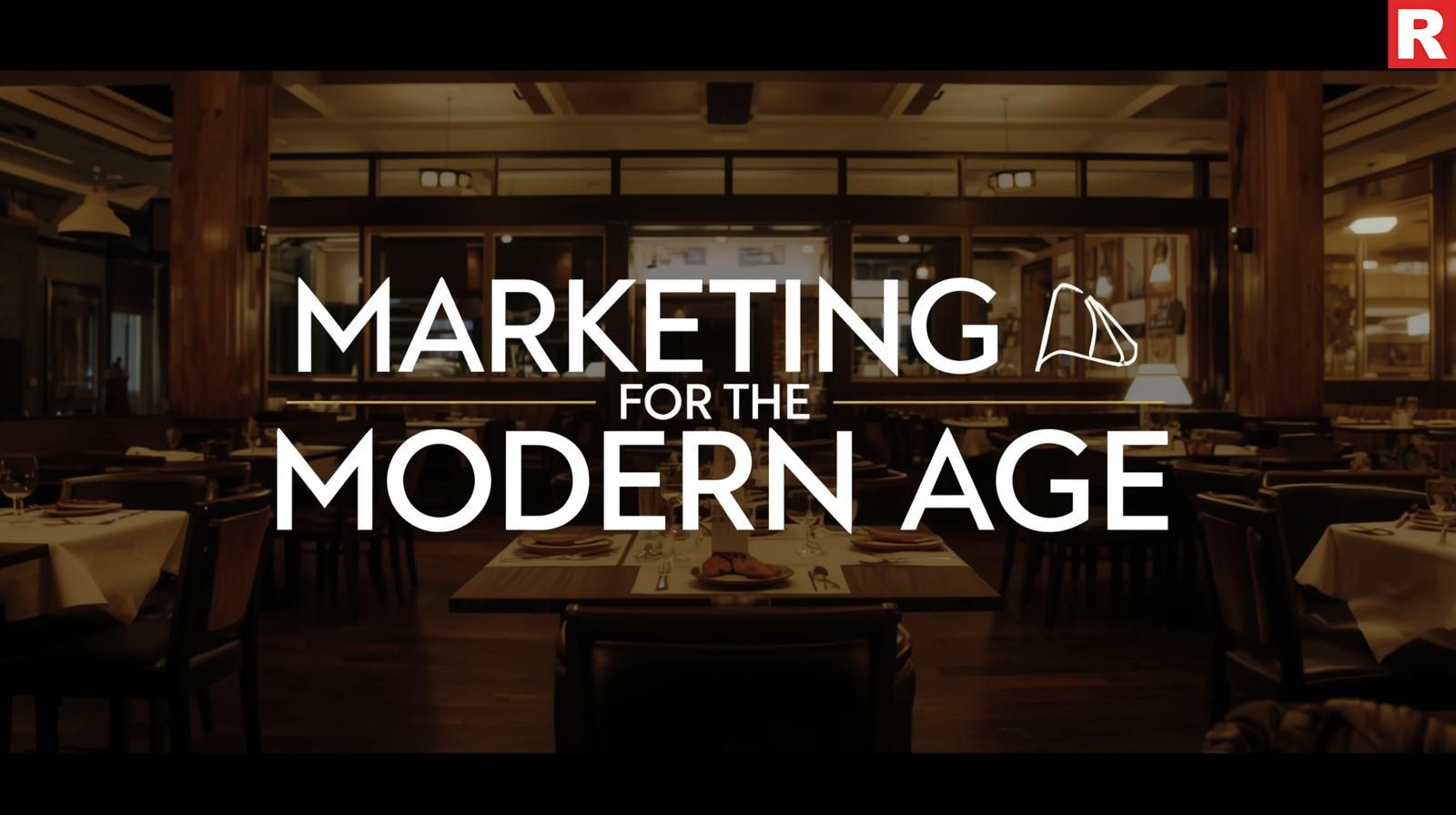
In today's marketplace, a restaurant cannot thrive without a strong online presence, particularly in highly competitive urban areas.
- Learn to Play the Social Media Game: Facebook and Instagram are your new billboards. Make use of excellent images and videos of your food, staff, and atmosphere. To create a community, interact with your followers, hold competitions, and share behind-the-scenes photos. Don't simply talk about your progress; show it.
- Optimize Your Online Listings: Make sure your local listing pages on Swiggy, Zomato, Google My Business, and other platforms are up to date and correct. List your accurate opening hours, use high-quality images, and, most importantly, react professionally and immediately to all feedback, both positive and negative.
- Accept Digital Payments: UPI and other digital wallets are common in India. Make sure your payment mechanisms are easy to use and give them a variety of choices.
Read this: Why SC is concerned over the quality of Maggi noodles again?
Winning Back the Trust and Loyalty of The Customers

Customer loyalty is the foundation of a restaurant's success. You have lost that connection when you're failing.
- Listen to the Feedback & Respond: Pay attention to what customers have to say and act upon it by actively seeking both online and offline feedback from customers. Avoid taking offense. Make a free consulting report out of unfavorable reviews. Show that you're paying attention and acting by giving each review a thoughtful response. This transparency can restore confidence.
- Invest in the Customer Experience: Pay attention to the atmosphere, music, lighting, and cleanliness in addition to the cuisine. A nice lunch can become a wonderful experience in a cozy, well-kept setting.
- Start a Campaign for Relaunch: Don't make adjustments in a quiet way. Make an exciting announcement about them using a fresh brand identity. To highlight your improvements, throw a "relaunch party," invite regional food bloggers and influencers, and run exclusive promotions.
- Create a Loyalty Program: Give loyal consumers rewards. A straightforward loyalty program (such as a free dessert on your fifth visit, 10% off after you spend a specific amount, or point-based systems) promotes repeat business and demonstrates to customers that you appreciate their business.
A New Beginning
It's not easy to turn a failing restaurant around. It necessitates a critical examination of the past, a unique perspective for what lies ahead, and a resolute dedication to change. Rekindling your enthusiasm for hospitality, reestablishing contact with your clientele, and reestablishing an excellence-driven culture are more important than simply modifying your menu or marketing approach. These methods will help you turn a failing business into a successful, profitable, and well-liked part of the community, starting with a brutal financial diagnosis and ending with a full brand redesign. The happiness a restaurant delivers to its customers is ultimately what determines its success, not its furnishings or costs.

A major change is taking place in India's dynamic and constantly changing culinary industry. Specialty restaurants are a new type of establishment that is starting to appear in addition to the common cafes and typical multi-cuisine restaurants. These are not merely dining establishments; rather, they are carefully chosen culinary experiences based on a single theme, such as a particular cuisine, unusual ingredient, or dining idea. In cities throughout the nation, the dining experience is being redefined by this calculated shift from a broad, universal approach to a specific, customized one. These restaurants are setting a new standard for quality, service, and customer interaction by providing depth, authenticity, and an engaging story.
This detailed article will examine the various ways that specialty restaurants are changing the Indian food and beverage sector. We will examine the factors that contribute to their success, the various models they represent, the operational strategies that guarantee their prosperity, and the significant influence they are exerting on consumer demands and the larger culinary landscape.
Read more: Top 10 Calcium-Rich Foods for Stronger Bones
What are Specialty Restaurants?
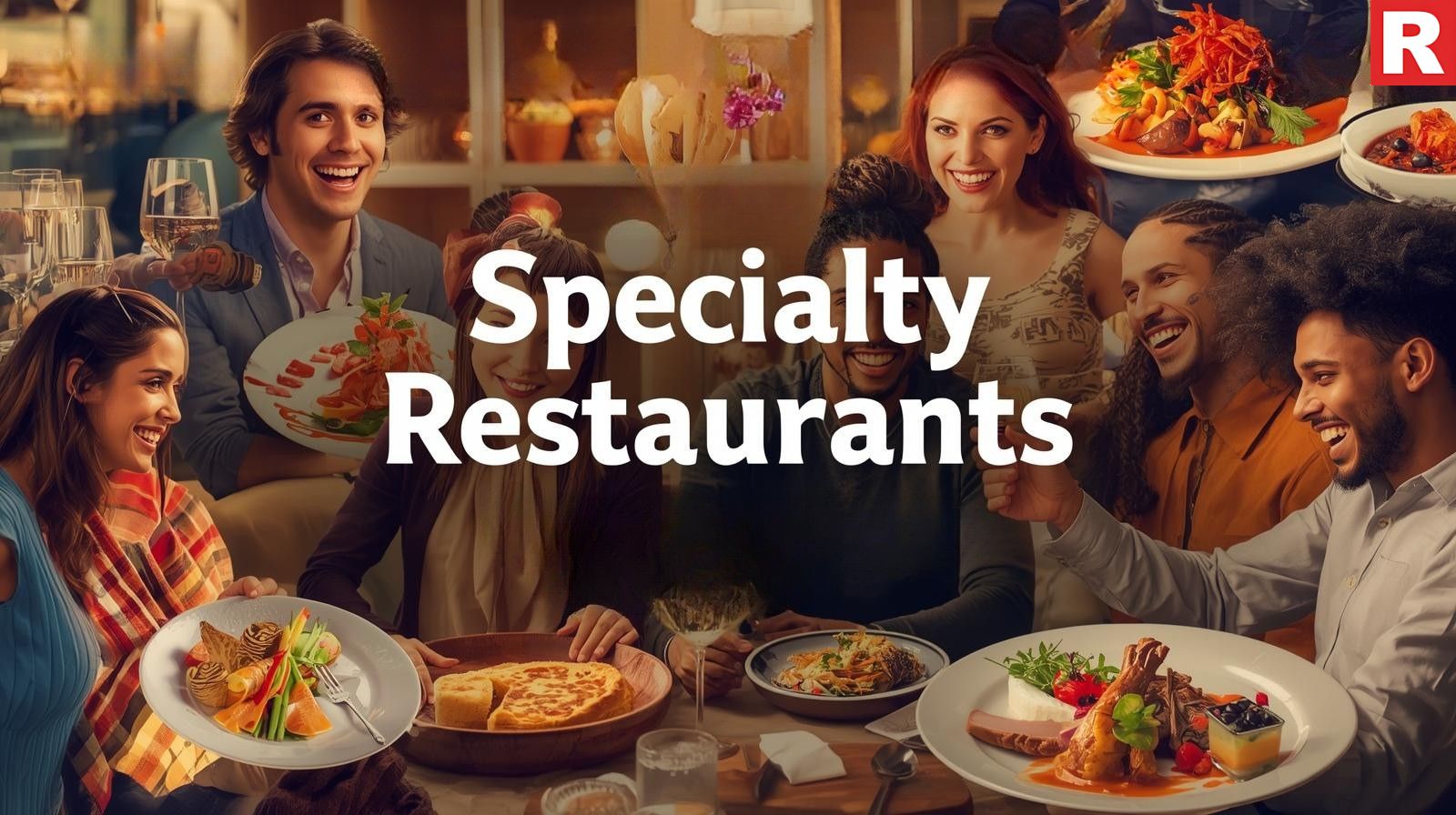
Restaurants that specialize in one particular culinary specialty are known as specialty restaurants. They focus their menu, expertise, and brand identity on a single area, unlike multi-cuisine restaurants. This could be a single dish (like a restaurant serving biryani or dosa), a particular regional food (like Chettinad or Rajasthani), a particular cuisine (like authentic Japanese ramen or traditional Lebanese), or an innovative idea (like farm-to-table or a dessert parlor). They can provide a greater level of authenticity, consistency, and quality thanks to this targeted strategy, which also helps them develop a powerful brand narrative. They can serve more sophisticated customers and provide a more memorable and enlightening eating experience by specializing in just one area.
Specialty vs. Multi-Cuisine Restaurants
Specialty Restaurants: Restaurants that specialize in a single, particular culinary niche are known as specialty restaurants. This could be a single dish, like biryani, a particular regional cuisine, like Rajasthani food, or a particular kind of food, like sushi bars. A more sophisticated menu, improved quality, and increased authenticity are made possible by the focus.
Multi-Cuisine Restaurants: These provide a broad range of meals from several culinary traditions, such as Chinese, Italian, and Indian. Although they serve a wide range of palates and larger gatherings, the originality and consistency of particular dishes may occasionally be sacrificed due to their extensive menu.
Know more: Beyond Borders: Turning Collaboration into Profit
From Jack-of-All-Trades to Master of One

The growth of specialty restaurants can be directly linked to the growing sophistication and globalization of Indian consumers. The following explains why the "master of one" strategy is working so well:
- The Search for Authenticity: Indian diners are looking for authentic experiences as they become more well-traveled and familiar with international culinary trends. Whether it's regional Indian (like Goan or Rajasthani), international (like authentic Japanese ramen or traditional Lebanese), or even a particular dish (like a biryani or a dosa restaurant), a restaurant that focuses on just one cuisine is seen as more legitimate and authentic. This emphasis guarantees that the chefs are well-versed in the complexities, methods, and components of the cuisine.
- Enhancing the Story: A specialty restaurant has an engaging tale to share. It's not just about the cuisine; it's also about the history of a recipe, the path taken by an ingredient, or the cultural background of a dish. This story makes the eating experience more memorable by establishing an emotional bond with the customer.
- Quality and Consistency: A kitchen can concentrate its resources on refining a select few dishes by narrowing the menu. As a result, there is less food waste and improved quality and uniformity. A broad, multi-cuisine menu would make it hard for chefs to find the freshest, most appropriate ingredients and hone their techniques to that level.
- Marketing and Brand Identity: A restaurant's brand identity is evident when it has a specific focal point. In a crowded market, a regional seafood restaurant, a sushi bar in Japan, or a dessert cafe stands out. Customers who are truly interested in that particular culinary experience are drawn in by the more focused and successful marketing that results from this specific market setting.
Check out: Indians becoming experimental with food
Is QSR a threat to hotels?
Models of Specialization
There is no set format for the concept of a specialized restaurant. It is found in several fascinating models throughout India:
- Regional Indian Cuisine Restaurants: From the rich seafood of coastal Kerala to the delicate aromas of Kashmiri Wazwan or the spicy curries of Andhra, these eateries honor India's wide and varied culinary traditions. Beyond the standard "Indian food" menu, they provide a more engaging experience.
- Single-Cuisine International Restaurants: As more people travel abroad, there is a rising desire for real international cuisine. As a result, restaurants that specialize in a specific international cuisine—such as authentic Thai, Vietnamese Pho, Italian spaghetti, or Mexican taquerias—have become more popular.
- Concept-Based Restaurants: Cuisine isn't necessarily the focus of the specialization. It could be about a main ingredient or a specific concept. Among the examples are:
- Dessert Parlors & Bakeries: These establishments only serve a variety of sweets, ranging from traditional pastries to creative fusion delicacies.
- Farm-to-Table Restaurants: These establishments focus on creating a cuisine that is always changing by utilizing seasonal, locally produced ingredients.
- Themed dining: It refers to restaurants that are designed with a particular theme in mind, such as a historical era, a fictional world, or a unique dining experience (like an all-you-can-eat barbecue grill).
- Single-Dish Restaurants: The most concentrated type of restaurant is the single-dish model, which devotes the whole menu to variations of a single meal. For example, a "biryani" or "dosa" restaurant focuses on making one dish into an art form.
What's new: Managing Your Restaurant's Cash Flow Like a Pro
The Art of Operation: Strategies for Success
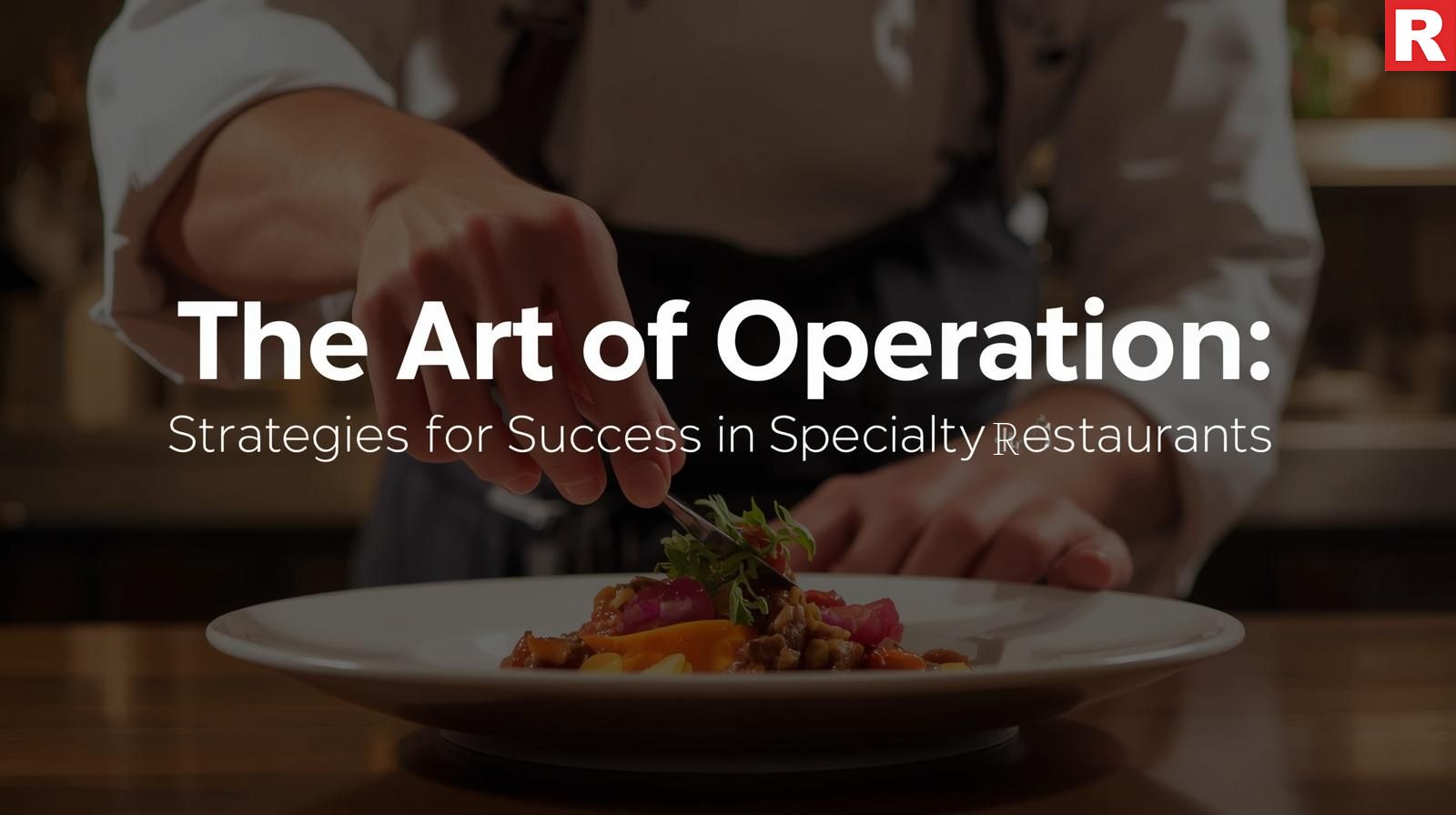
Although rewarding, operating a specialist restaurant calls for a unique set of operational techniques:
- Deep Expertise: A staff with a deep, almost addictive understanding of the area of expertise is the most valuable asset. The chef needs to be a specialist in the ingredients, methods, and history of the cuisine. In order to lead consumers through the menu and narrate the story of the meal, the staff needs to be trained.
- Sourcing and Supply Chain: Specialized supply chains are frequently needed for rare ingredients. A seafood restaurant will need an efficient system for locating fresh, premium goods if it is located in a remote town. This might involve forming alliances with particular vendors, purchasing directly from farmers or fishers, or even cultivating ingredients inside.
- Focused Menu and Inventory: A small menu makes it easier to manage inventory, cuts down on food waste, and frees up the kitchen to concentrate on quality. Better cost control results from the more predictable inventory.
- Experiential Marketing: Marketing is more than just advertising, according to experiential marketing. It involves developing an experience that is symbolic of the restaurant's area of expertise. This may consist of:
- Cooking Workshops: Providing instruction on how to make the specialized dishes.
- Food Festivals: To highlight the restaurant's particular offers, take part in regional food festivals.
- Social media storytelling: It is the practice of sharing information about the ingredients, the chefs, and the cultural context of the food on networks like Instagram reels or posts.
Read this: How will you brand your restaurant?
Redefining the Dining Experience

Specialty restaurants have an impact that goes well beyond their kitchens. They are drastically changing how customers see and engage with food:
- Education and Appreciation: These restaurants are teaching customers about the complexity and diversity of food customs by focusing on a specific cuisine. A customer at a real Vietnamese restaurant may discover the differences between different varieties of pho or the function of particular herbs in the cooking. A greater appreciation for food is cultivated as a result.
- Community and Connection: For fans of a certain cuisine, specialty restaurants can turn into gathering places. They draw people who share their interests, establishing a feeling of community and a venue for mutual passion. For instance, a specialty Korean food restaurant might become a gathering place for Korean cuisine lovers.
- Raising the Bar for Quality: The restaurant industry as a whole is being pressured to improve its standards due to the popularity of specialist restaurants. Multi-cuisine restaurants are having to raise the standard of their food to stay competitive as customers get pickier and want authenticity.
- Encouraging Niche Entrepreneurs: Without having to become experts in a variety of foods, entrepreneurs can launch a firm based on their love of a particular cuisine, thanks to the specialization model. This promotes innovation in the culinary industry and lowers the entry barrier.
Conclusion
Specialty restaurants are becoming more and more popular. As Indian customers' tastes and sophistication grow, this fundamental change is probably going to continue. The need for distinctive and genuine eating experiences will only rise as cities continue to expand and change.
A straightforward yet effective rule holds the secret to success for restaurateurs: identify your specialty and capitalize on it. Specialty restaurants are prospering rather than merely surviving by concentrating on their key strengths, creating an engaging brand narrative, and offering a genuine and superior experience. One meticulously prepared meal and one passionate tale at a time, they are revolutionizing the dining scene and demonstrating that, in the world of food service, a clear vision can be the most potent component of all.

Cash flow is an important aspect of a restaurant business. And if it is not properly managed, then the dreams of many restaurateurs in India will quickly turn into a nightmare. This means that restaurants will not be able to serve good, delicious food because their business will shut down due to improper cash flow. Cash flow, which is the movement of money in and out of a business, is considered the lifeline of any restaurant. Whether you have enough liquid cash on hand to pay your employees, suppliers, rent, and other operating costs on time is more important than your recorded profit. In a sector characterized by narrow profit margins, perishable inventory, and fluctuating demand, efficient cash flow management is not only a best practice but also a key to long-term survival.
This detailed article will give Indian restaurateurs a tactical road map for expertly handling the cash flow of their restaurants. We will examine the particular difficulties that the Indian food service sector faces, provide practical methods for maximizing both inflows and outflows, examine the function of technology, and, in the end, give you the information you need to keep your food business throughout the country operating profitably.
Read more: Top 10 Calcium-Rich Foods for Stronger Bones
What is Cash Flow in a Restaurant?

Before we take a look at possible marketing strategies, let's get to know the two main components that make up the cash flow of any business:
Cash Inflows: All of the money that enters your business is referred to as cash inflows. Among the primary sources are:
- Food and beverage sales (delivery, takeout, and dining in).
- Catering and event reservations.
- Sales of gift cards.
- Any investments in stock or loans.
Cash Outflows: The total amount of money leaving your business is known as cash outflows. Typical major outflows include:
- Cost of Goods Sold (COGS): Ingredients, drinks, and raw materials.
- Operating costs include rent, utilities (gas, water, and electricity), payroll, advertising, repair, and insurance.
- Interest and loan repayments.
- Taxes, such as property taxes and GST.
- Capital expenses (renovations, new equipment).
A positive cash flow indicates sound financial standing since more money is coming in than leaving. Even for a successful restaurant, negative cash flow can soon result in bankruptcy if it is not handled properly.
Know more: Beyond Borders: Turning Collaboration into Profit
Unique Cash Flow Challenges In the Indian Restaurant Landscape

Indian restaurants face specific cash flow issues because of their particular economic and cultural environment:
- Perishable Inventory: Fresh produce, dairy products, and meat make up a sizable amount of the restaurant's perishable inventory. This implies that unsold inventory rapidly becomes a waste of money, which has an immediate effect on outflows.
- Demand Fluctuation: Public holidays, seasonal demand (festivals, wedding seasons, lean times), and even daily weather variations can result in unpredictable shifts in sales, which makes revenue forecasting difficult.
- Credit Culture with Suppliers: Many independent Indian restaurants work with local suppliers on a credit basis, even if larger chains may have more influence. To prevent late fines or supply interruptions, it is essential to carefully manage these payment cycles.
- Labor-Intensive Industry: High labor expenses, such as mandatory contributions, gratuities, and some employees' daily wages, constitute a significant and frequently inflexible outflow.
- Taxes and Regulatory Compliance: Managing local municipal taxes, GST, and other compliance obligations can be difficult, and late payments result in fines that further drain funds.
- Competition and Discounting: Restaurants are frequently forced to provide discounts due to the fiercely competitive market, particularly in the food delivery industry, which has an effect on net cash inflow and gross margins.
Strategies for Maximizing Cash Inflows

In order to ensure a consistent and strong flow of revenue into your restaurant, proactive tactics are crucial.
Upgrade Menu Engineering and Pricing:
- Regular Costing: Determine the precise cost of each dish, taking into account labor, overhead, and ingredients, regularly.
- Strategic Pricing: Set menu prices that are both profitable and competitive. Promote the high-margin products (also known as "stars").
- Menu Layout: Create a menu that gently pushes customers toward things that will bring in the most money.
Diversify Your Sources of Income:
- Catering Services: Provide catering to take advantage of the profitable Indian event sector, which includes corporate gatherings and weddings. In order to improve cash flow, this frequently involves payments in advance.
- Delivery & Takeaway: To cut down on commission expenses, collaborate with food delivery services like Zomato and Swiggy while simultaneously creating your own direct delivery route.
- Meal Kits/Pre-Mixes: Provide clients with meal kits of well-known dishes or packaged spices to prepare at home.
- Cooking Classes: Provide cooking classes to make the most of your chef's experience.
- Merchandise: Offer branded goods such as pickles, spices, and dinnerware.
Accelerate Collections:
- Advance Payments: For major orders, events, or catering, always seek a substantial advance payment.
- Efficient Billing: To reduce wait times and increase table turnover, make sure that the point of sale (POS) bills promptly and accurately.
- Diverse Payment choices: Offer different payment choices (cash, UPI, debit/credit cards, mobile wallets) to cater to all customer preferences and eliminate delays in payment.
- Encourage High-Margin Products: Teach your employees to upsell high-profit products such as desserts, drinks, and specialty foods.
What's new: Are Restaurants Friendly with Facebook?
Smart Spending and Cost Management to Control Outflows

Managing spending is equally important. You keep every rupee that you save in your bank account.
Excellence in Inventory Management:
- FIFO (First-In, First-Out): To reduce waste and spoilage, strictly enforce the FIFO system.
- Frequent Inventory Counts: Check the high-value and perishable items in your inventory every day or every week.
- Supplier Negotiation: Establish trusting bonds with suppliers and work out advantageous conditions for payments and big purchases. Investigate several vendors to guarantee affordable prices.
- Portion management: To cut down on food waste, teach kitchen employees how to strictly manage portion sizes.
Reduce Labor Costs as Much as Possible:
- Smart Scheduling: To prevent overstaffing during slow times, match staffing levels to expected demand. When necessary, use part-time employees.
- Cross-training: Teach employees to perform a variety of tasks to boost adaptability and lessen the demand for specialized workers during slow periods.
- Performance-Based Incentives: Encourage employees with rewards based on cost reductions or sales.
Control operating costs:
- Energy Efficiency: To lower utility costs, make investments in LED lighting, energy-efficient appliances, and routine HVAC maintenance.
- Preventive Maintenance: Keeping kitchen appliances maintained on a regular basis prolongs their lives and helps to avoid expensive malfunctions.
- Discuss Rent and Utilities: Try to work out advantageous lease conditions. Keep a close eye on utility usage and search for places where it might be cut.
- Marketing ROI: To make sure you're spending money wisely, monitor the return on investment (ROI) for every marketing initiative.
- Tax Planning: To minimize penalties and maximize tax outflow, work with a qualified accountant to guarantee timely and precise tax filing, utilizing all allowable deductions.
Check out: How will you brand your restaurant?
Is QSR a threat to hotels?
The Power of Cash Flow Prediction
The foundation of strategic cash flow management is forecasting.
- Create a Cash Flow Statement: Make a cash flow statement, which keeps track of all incoming and outgoing funds over a given time frame (daily, weekly, or monthly).
- Develop a Rolling Forecast: Create a continuous forecast by estimating your inflows and outflows for the upcoming thirty, sixty, and ninety days.
- Historical Data: To project future revenues, use historical sales data, seasonal trends, and forthcoming events.
- Future Costs: Account for known costs such as rent, payroll, and planned supplier payments.
- Contingency: Always prepare for unanticipated costs or declines in sales.
- Scenario Planning: Preparing for various circumstances (such as a poor monsoon season or a spike in demand during Diwali) will help you anticipate potential effects on cash flow and devise preventative measures.
Using Technology As Your Digital Cash Flow Assistant

With the use of technology, managing the cash flow of your restaurant has become easier than before.
- Point-of-Sale (POS) Systems: Modern (POS) systems, such as Zomato POS, are capable of more than just processing orders. They manage consumer loyalty programs, maintain inventory, give real-time sales data, and interface with accounting software. For forecasting and trend identification, this particular data is important.
- Inventory management software: It reduces waste and improves ordering efficiency by tracking stock levels, analyzing consumption trends, alerting you when stock is low, and integrating with POS for automatic deductions.
- Accounting Software: It helps to provide you with an in-depth analysis of your financial health, cloud-based accounting systems (such as Tally, Zoho Books, and QuickBooks) automate expense tracking, generate financial reports, and make tax compliance easier.
- Digital wallets and payment gateways: Combining different digital payment methods lowers the risks associated with handling currency, streamlines transactions, and offers immediate electronic records of inputs.
Read this: Is McDonald's Closure Give Way To Other Brands In India
Conclusion
In India, managing the cash flow of your restaurant is a constant, ever-changing activity that calls for attention to detail, self-control, and strategic planning. It's about the survival and success of your creative dream, not just about the numbers. Restaurant owners throughout the country can successfully navigate the unstable waters of the food service sector by closely monitoring inflows and outflows, utilizing technology, carefully anticipating, and accumulating a sizeable cash reserve. In addition to providing financial stability, a good cash flow enables you to take advantage of expansion opportunities, weather economic downturns, and, in the end, make sure that your love of food continues and delights consumers for many years to come. In the cutthroat world of Indian restaurants, if you can master your cash flow, you can master your career.

The ordinary internet café is changing significantly in the constantly evolving urban Indian landscape, especially in areas that are developing quickly. Previously serving only as practical places to use the internet, these places are evolving into vibrant hybrid internet cafes that skillfully combine internet access with a variety of services, such as fine coffee, co-working spaces, gaming areas, and event spaces. This development is more than just a visual makeover; it is a calculated approach to shifting consumer demands, advances in technology, and the growing need for flexible community areas in busy metropolitan settings. Understanding and embracing the emergence of hybrid internet cafes is essential for businesses hoping to meet the social and digital demands of the country's growing population in order to build a successful and long-lasting business.
This complete article will explore the reasons behind this change, the various hybrid internet cafe models that are popping up in urban India, successful operational and marketing tactics, and why this trend is set to reshape the function of internet-centric companies in the digital era. In this article, we'll examine how these hybrid venues are serving a growing number of remote workers, entrepreneurs, students, and digital natives who need more than just Wi-Fi.
Read more: The Future of Dining: Balancing Authenticity, Drama, and Sustainability
The Evolution of the Internet Cafe
In the early days of the internet, the typical internet cafe became an essential resource, giving people without personal computers or dependable internet connections inexpensive access to the internet. But as cellphones developed and home internet became more affordable, the classic internet cafe's transactional model started to run into problems. This change has led to the creation of hybrid internet cafes, which acknowledge that providing internet connection alone is no longer sufficient to draw in and keep customers. The goal of these new areas is to create a community center that serves a wider range of needs.
Diverse Services of Hybrid Cafes
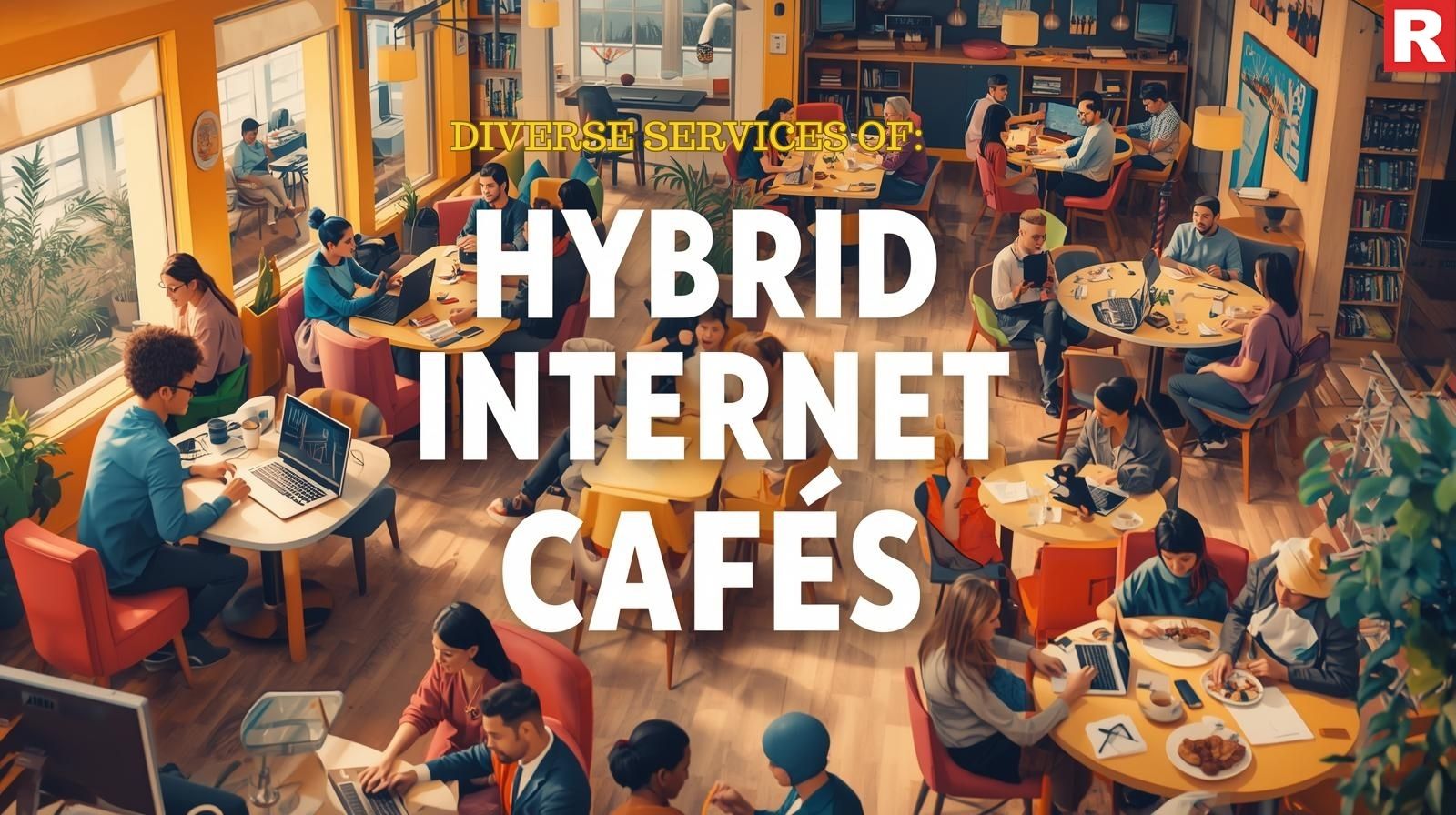
The versatility and wide range of services that the hybrid internet cafe can offer are what make it so appealing. Some well-known models that are becoming popular in cities are as follows:
- The Coffee & Connectivity Hub: Perhaps the most popular model is the Coffee & Connectivity Hub, which combines a fast internet connection with a cozy cafe setting. These cafes draw students, remote employees, and casual users seeking a productive yet laid-back environment since they provide high-quality coffee, tea, snacks, and frequently more substantial food options. With the help of superb coffee and a welcoming atmosphere, the focus is on establishing a space that is ideal for work, study, or leisure browsing.
- The Co-working & Digital Resource Center: This business model is designed with remote workers, entrepreneurs, and freelancers in mind. In addition to providing basic internet connection, they also provide dedicated workstations, meeting spaces, printing and scanning facilities, and frequently hold training and networking events. These places meet the demands of the expanding gig economy by offering a more formal and cooperative setting than a normal cafe.
- The Gaming & Social Lounge: These hybrid cafés, which cater to the growing gaming community, offer fast internet along with powerful gaming PCs, consoles, and cozy seats. In addition to serving casual users, they frequently organize gaming competitions and activities that promote a feeling of community among gamers. This strategy takes advantage of both the need for high-performance gaming systems and the social element of gaming.
- The Education & Skill Development Center: Hybrid internet cafes offer educational resources, including online courses, tutoring, and workshops on digital literacy and other in-demand skills in locations with a sizable student population. According to this approach, the café serves as a center for learning, offering chances for skill development as well as information access.
- The Event & Community Space: Some hybrid cafés include adaptable layouts that may accommodate lectures, workshops, art exhibits, and other community gatherings. By establishing the café as a community hub, this business model promotes a feeling of community and expands its sources of income beyond personal internet use.
Know more: A Strategic Look at India's Evolving Liquor Regulations
The Reasons Behind the Hybrid Revolution
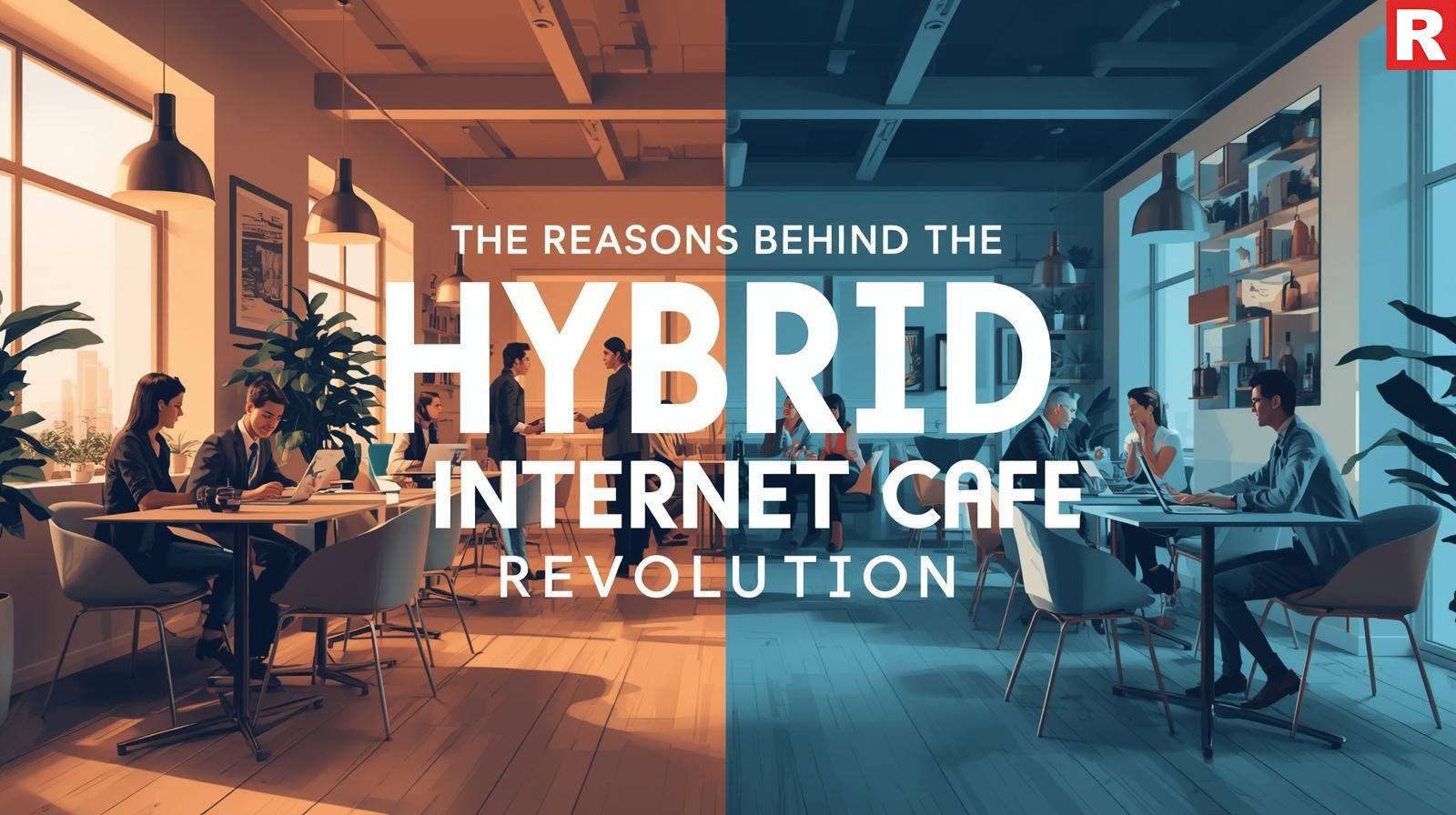
In urban India, several factors are contributing to the growth of hybrid internet cafes:
- Changing Customer Needs: As previously stated, mobile devices are increasingly being used to satisfy the fundamental requirement for internet access. Nowadays, when customers visit an internet café, they are searching for experiences and services that offer value.
- The Gig Economy's Rise: In cities like Delhi, Gurgaon, etc., the number of independent contractors and remote workers is growing, which raises demand for adaptable, reasonably priced co-working spaces with dependable internet access.
- The Increasing Gaming Culture: Online gaming and Esports are growing in popularity in India, which is fueling the need for specialized gaming areas with top-notch gear and a welcoming environment.
- The Need for Communal Places: As cities become more populated, there is an increasing demand for easily accessible and reasonably priced communal places where people may interact, work together, and exchange knowledge.
- Diversification of Income Streams: By providing a variety of services, hybrid internet cafés can lessen their dependency on internet usage fees and increase their financial stability.
- Technological Advancements: High-speed internet infrastructure, powerful and affordable technology, and user-friendly software make it possible to offer a range of services in one place.
What's new: How Rooftop Dining is Transforming the Indian Restaurant Industry
Operational Strategies for Hybrid Success
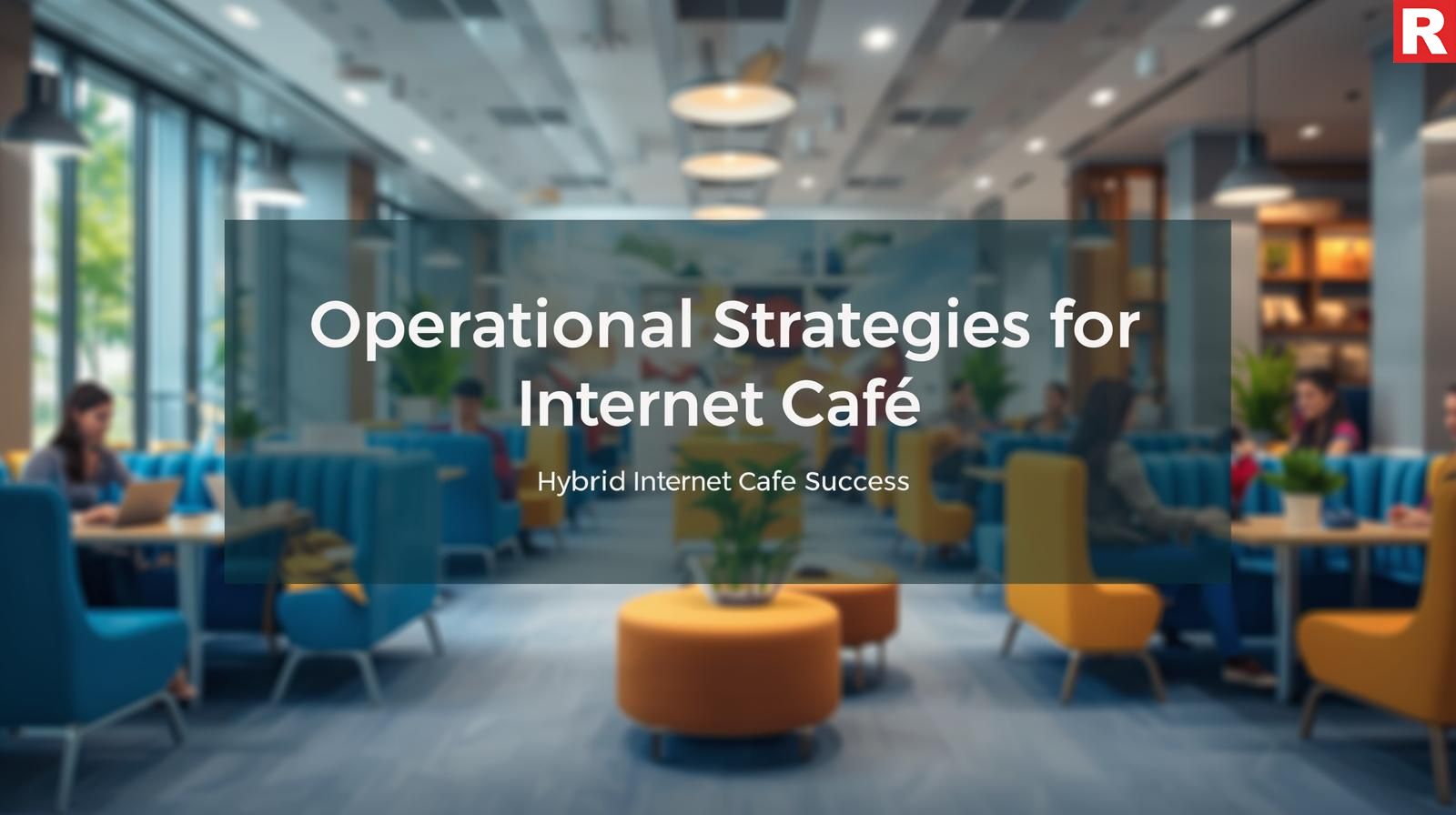
A systematic approach to operations is necessary for the successful operation of a hybrid internet cafe:
- Strategic Location: It's important to pick a site that has lots of foot traffic and is close to the target audiences (gamers, young professionals, students, etc.).
- Infrastructure Investment: It is crucial to make investments in dependable and fast internet access, cozy and flexible furnishings, and the equipment required for each service offering (gaming PCs, co-working desks, coffee makers, etc.).
- Training for Staff: Employees must be skilled and versatile to help customers with internet access, run the coffee maker, oversee game installations, and give information about other services.
- Space Management: It's critical to effectively manage the available space to support various activities and client needs. Optimizing space use can be achieved through adaptable layouts and zones assigned to various services.
- Partnerships: Working together with nearby companies, academic institutions, or gaming communities could be useful to increase service options and draw in new clients.
- Frequent Maintenance and Upgrades: To deliver a top-notch experience, it is essential to make sure that all infrastructure and equipment are kept up to date and properly maintained.
Marketing the Hybrid Internet Cafe

Promoting a hybrid internet cafe requires appealing to a wide range of consumers and emphasizing its special collection of services:
- Effective Branding: Create a brand identity that effectively conveys the target audience and the hybrid aesthetic of the cafe.
- Online Presence: Promoting the cafe's products and interacting with potential customers requires a robust online presence, which includes an easy-to-use website and active social media accounts.
- Targeted Campaigns: Create advertising campaigns that are tailored to each group of customers (e.g., co-working memberships, gaming tournaments, student discounts).
- Local Partnerships: To reach potential clients, work with nearby businesses, colleges, schools, and community organizations.
- Loyalty Programs: To reward loyal consumers and promote regular visits, put loyalty programs into place.
- Stressing the "Community" Aspect: Draw attention to the cafe's function as a gathering place for the community, highlighting activities, seminars, and chances for interaction and cooperation.
Check out: Adoption of AI for Personalized Customer Experience In Restaurants
Understanding Joint Ownership in the Restaurant Industry
Addressing the Challenges
Although there are many advantages to the growth of hybrid internet cafes, there are drawbacks as well:
- Greater Initial Expenditure: Compared to a typical internet cafe, opening a hybrid cafe with a variety of services involves a bigger initial expenditure.
- Managing Several Services: It might be difficult to efficiently manage and coordinate a variety of services, demanding skilled leadership.
- Meeting Diverse Customer Requirements: It might be difficult to serve a customer base that is diverse in terms of their requirements and expectations.
- Competition: As the hybrid model gains recognition, urban centers are seeing a rise in competition.
- Keeping a Consistent Brand Identity: In order to prevent confusing potential clients, it is essential to communicate the cafe's brand clearly when providing a wide range of services.
Read this: 10 Ways the Restaurant Industry Impacted the Lifestyle of Indians
The Future of Digital Hubs
In urban India, the arrival of hybrid internet cafés marks a dramatic change in how individuals access and engage with the digital world and within public spaces. These areas are developing into vibrant centers that meet the diverse demands of a generation that is increasingly connected. Hybrid internet cafés, which provide a combination of community, entertainment, productivity, and connectivity, are positioned to become essential resources for a wide range of people and organizations and to play a bigger part in the social and economic fabric of urban centers. For businesses hoping to prosper in the digital era, the hybrid model provides a robust and flexible strategy as urban lifestyles and technology continue to develop.
Conclusion
The old-fashioned internet cafe model is going extinct. The hybrid internet cafe, a dynamic and adaptable area that meets the changing demands of Indian city people, is the space of the future. Entrepreneurs in metropolitan centers may build successful businesses that act as essential community centers in the digital age by carefully combining internet access with coffee culture, co-working spaces, gaming lounges, educational materials, and community areas. These services' fusion provides an attractive selling point that draws in a wide range of customers and guarantees the long-term sustainability of these cutting-edge digital hubs. Adopting this hybrid strategy will help you become a valued and essential component of the urban landscape, not merely stay relevant.

The restaurant industry is both innovative and dynamic, which means it constantly generates new ideas that are not just changing the food on the plates. It also includes innovation in the entire dining experience, like it did with rooftop dining. Rooftop dining is one trend that has totally swept the culinary scene of the Indian restaurant industry, especially in places like metropolitan cities of Mumbai, Delhi, or Bangalore. Rooftop restaurants are changing the way of dining out by providing an innovative combination of delicious food, cool drinks, and stunning panoramic views, making them popular spots for both locals and visitors. This style takes care of unused spaces on the rooftop and also provides a premium experience to the visitors. This is more than a trend; it represents a strategic shift in the layout of restaurants and service. Recognizing and utilizing rooftop dining's potential can revolutionize the restaurant industry and provide it with a major competitive advantage in a crowded market.
This article will explore the various ways that rooftop dining is changing the Indian restaurant business. We'll look at what rooftop dining is, the main factors that have contributed to its popularity in the country.
Read more: The Future of Dining: Balancing Authenticity, Drama, and Sustainability
What is Rooftop Dining?
Fundamentally, a restaurant or dining space located on a building's roof is referred to as rooftop dining. This might be anything from a laid-back outside arrangement with simple chairs to an elegant inside setting with high-end furnishings and climate control. The elevated setting, which provides customers with an experience beyond the usual ground-level restaurant, is the differentiating feature. Rooftop restaurants frequently take advantage of the surrounding urban environment by offering expansive views of the city, the countryside, or both. They offer a different viewpoint and atmosphere and can be located atop hotels, independent business buildings, or even converted residential complexes. More businesses are seeing the potential of these raised areas to create unique and incredibly appealing dining locations as India's cities grow upwards. Cafes, bars, and even casual dining venues seeking to give an original selling appeal are adopting this idea, which was originally only found in fine-dining establishments.
Why Diners Enjoy Dining on Rooftops?

The attraction of rooftop eating is diverse, appealing to several basic human needs and preferences, which contributes to the significant hype that surrounds these types of restaurants.
- The Experiential Factor: In the experience-driven economy of today, diners are looking for an unforgettable event rather than just a meal. Especially the Gen Z and Millennial population of India, which is influenced by social media. This is readily accessible in rooftop restaurants, which give a unique viewpoint and a feeling of seclusion from the bustling city below. Traditional ground-floor restaurants just cannot match the unique sensation of dining far above the city lights, experiencing a cool breeze, and basking in a breathtaking sunset.
- Ambiance & Atmosphere: The natural components of an open-air location add greatly to the ambiance. A romantic and elegant ambiance is created by the chilly nighttime air, the soft glow of city lights, and the sparkling stars. By adding well-considered lighting design, cozy outdoor furnishings, and possibly even live music, restaurateurs can further improve this and create a genuinely captivating setting. A higher perceived worth and a desire to spend more are frequently the results of this premium ambiance.
- A Feeling of Relaxation and Escape: Restaurants on rooftops provide a brief break from the bustle and intensity of life on the street. They offer a peaceful haven where customers may rest, mingle, and savor their meal in a more laid-back atmosphere. In crowded towns, where finding a quiet outdoor area may be a luxury, this sensation of relaxation is especially tempting.
- Social Media Appeal: Visually appealing Experiences are very shared in the era of Instagram and Snapchat. Rooftop restaurants are naturally photogenic due to their breathtaking views and carefully designed aesthetics. This natural social media marketing can be very helpful in drawing in younger, internet-savvy consumers. A charming cocktail with a view of the city is perfect for social media.
- The "Wow" Factor: Eating in an upscale setting has an indisputable "wow" factor. It gives you a talking point and feels unique and distinct. The excitement around rooftop restaurants is mostly fueled by their uniqueness and natural lasting appeal.
Know more: Best Pre-Workout & Post-Workout Foods for Energy
Celebrating Under the Stars: Events on Rooftop Areas

Rooftop restaurants' unique atmosphere and view make them perfect locations for a variety of events, which increases their appeal and potential for profit.
- Private Parties & Celebrations: Birthdays, anniversaries, and business gatherings are made much more meaningful when they are held in front of a metropolitan skyline. Compared to traditional dining rooms, rooftop venues provide a unique and frequently more private setting.
- Corporate Events: Rooftop restaurants provide a chic and striking setting for team-building exercises, client dinners, or product debuts.
- Live Music & Entertainment: With its lively and captivating ambiance, the outdoor venue is ideal for live acoustic performances, DJ evenings, or even small-scale theatrical performances.
- Sunset Cocktail Hours: Making the most of the breathtaking vistas and drawing in customers seeking a classy after-work experience are two benefits of serving special drink and food menus during sunset.
- Holiday & Festive Celebrations: With customized menus and packages for certain events, rooftop restaurants provide a unique perspective for taking in fireworks displays and citywide celebrations.
- Networking Events and Seminars: To diversify revenue streams, rooftops can be converted into unique venues for networking events, yoga classes, or seminars during off-peak hours.
What's new: A Strategic Look at India's Evolving Liquor Regulations
Managing and Operations in A Rooftop Restaurant
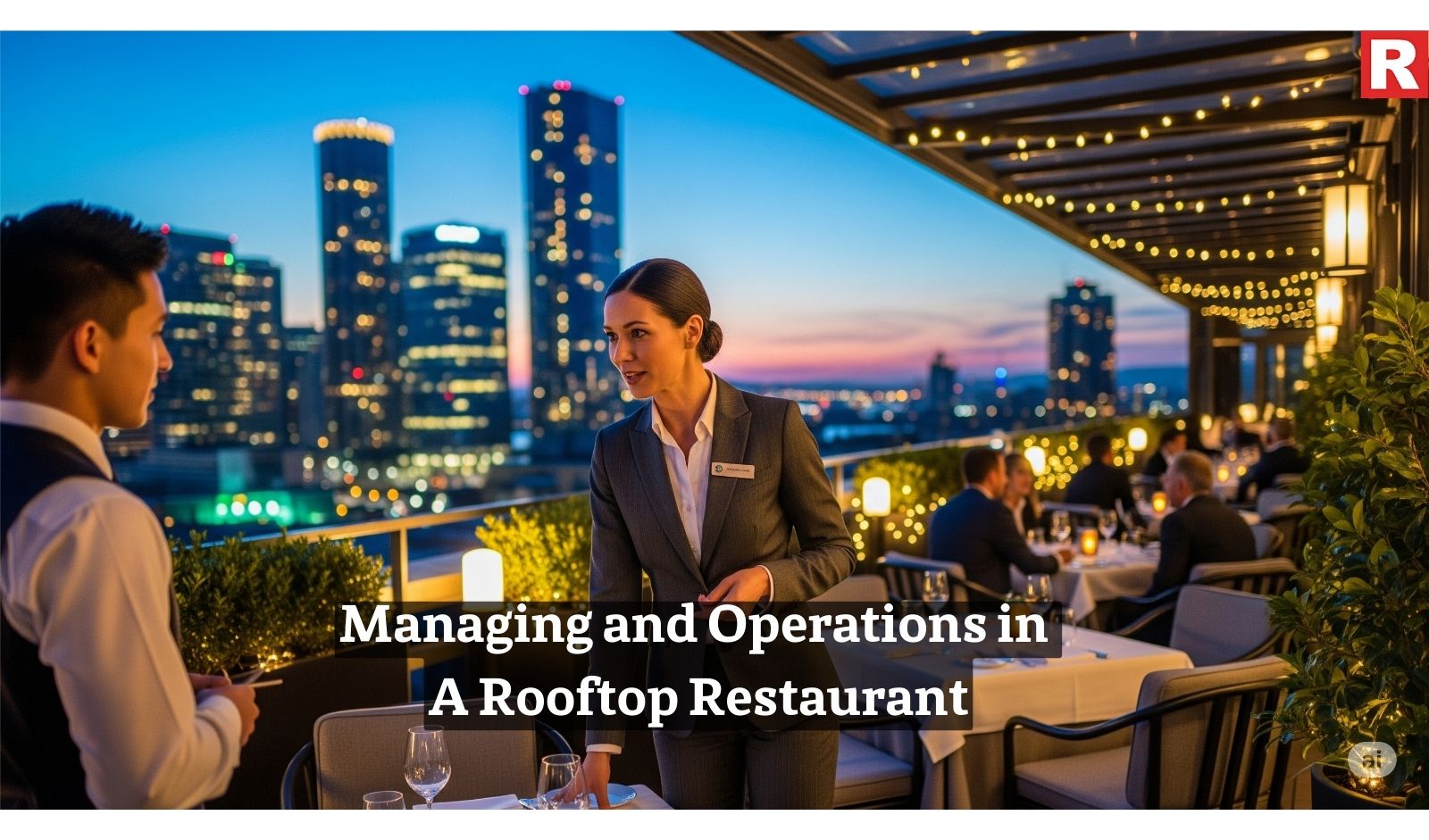
Careful preparation and attention to particular operational issues are necessary for the development and operation of a successful rooftop restaurant.
- Structural Integrity and Accessibility: The building's ability to sustain a rooftop restaurant is the first factor to be taken into account. Elevators and stairwells that are accessible to both employees and clients are also essential. Obedience to safety standards and construction rules is crucial.
- Weather Protection: if the area is subject to a variety of weather patterns, like sweltering summers, rainy monsoon seasons, and frigid winters. Having sufficient weather protection is crucial for year-round operation. Pavilions, heating lamps, adjustable shade structures, and even temporary shelters in severe weather are examples of this.
- Kitchen and Service Logistics: It might be difficult to transport supplies, food, and drinks to and from a rooftop kitchen. Separate service elevators or effective dumbwaiter systems are usually required. Careful preparation and skilled employees are necessary to maintain food temperature and service standards at a high level. To guarantee quality, think of setting up a smaller, dedicated kitchen on the roof for last-minute preparations.
- Sound Control: A rooftop restaurant's noise may affect nearby properties, particularly residential ones. Maintaining positive neighborhood relations requires the use of soundproofing measures and responsible music level management.
- Safety & Security: Strict security measures, such as railings, sufficient lighting, and trained staff, are necessary to guarantee the safety of visitors and employees on a rooftop. Plans for emergency evacuation are also crucial.
- Permits and Licensing: Compared to a ground-floor business, obtaining the required permits and licenses for a rooftop restaurant can be a more difficult procedure that frequently calls for approvals from several departments.
Check out: How Taglines and Slogans Affect Your Restaurant Business
How to Embrace International Flavors in an Indian Restaurant
The Impact of India's Diverse Weather

The weather has a big impact on how well a rooftop restaurant operates in a country as big as India, which has a lot of different climates. Businesses that want to succeed need to have a solid plan in place to deal with every season.
- Scorching Summers: An open-air rooftop can get intolerably hot during the day due to the extreme heat of the summers in North and Central India. To guarantee consumer comfort, efficient cooling solutions such as mist fans, powerful air coolers in covered areas, and evening-only operations are frequently required.
- Monsoon Challenges: The monsoon season's intense winds and heavy rains can cause closures frequently and make it difficult to maintain an outside area. Retractable canopies and other sturdy, dependable weather protection are essential. A robust drainage system is also necessary to avoid flooding.
- Pleasant Spring and Autumn: In most of India, these seasons provide the best weather for rooftop eating and draw the biggest crowds. These restaurants really come into their own at this time.
- Cool Winters: In many regions of the nation, evenings can get cold even though the days can be nice. By offering outdoor heating options like blankets or patio heaters, rooftop dining may be extended throughout the winter, and a warm, welcoming ambiance can be created. To maintain year-round viability, restaurateurs must carefully arrange their infrastructure and operating hours to accommodate these varying weather conditions.
Read this: A to Z List of Restaurant Operations
Shortcomings of Rooftop Dining
Rooftop restaurants have their own set of shortcomings despite their appeal, which restaurateurs need to be ready to deal with.
- Accessibility Issues: If there is little or no elevator access, it may be challenging for the elderly, those with impairments, or families with small children to get to a rooftop site.
- Weather Dependency: Severe weather occurrences, such as strong storms or intense heat, might require temporary closures, which can affect revenue, even though weather protection can help reduce some issues.
- Increased Operational expenses: Transportation difficulties, the possible requirement for specialist equipment (such as strong weather protection), and possibly higher insurance premiums can all lead to greater operational expenses.
- Restricted Space: Compared to ground-floor restaurants, rooftop venues may have less amount of space, which could limit the size of the kitchen and seating area.
- Noise complaints: As was already indicated, noise levels can cause serious issues for nearby residents, requiring strict control.
- Seasonal Changes: The popularity of rooftop dining may surge during specific seasons, depending on the local environment. In these cases, methods for continuing business throughout challenging weather periods are necessary.
Conclusion
More than just a passing trend, rooftop dining is a major shift in the restaurant business, motivated by customers' desire for exceptional experiences, sophisticated decor, and stunning views. Adopting this trend gives restaurateurs a significant chance to set themselves apart, draw in more customers, and produce unforgettable dining experiences. By carefully analyzing what rooftop dining involves, understanding the hype, leveraging the event potential, addressing the inherent shortcomings and weather-related challenges, strategically marketing the unique appeal, and fusing local flavors with global trends, rooftop restaurants are revolutionizing the culinary landscape one elevated dining experience at a time.

The alcohol license is more than just a piece of paper for Indian restaurateurs; it's a key component of the dining experience and a gateway to a significant cash stream. However, India's alcohol sales and service regulations are extremely complex, dynamic, and frequently the cause of significant challenges. It is a system that requires strict adherence to a maze of state-specific rules and an endless cycle of transition because of changes in governmental policy. A business can no longer afford to take an indifferent stance to these restrictions if it hopes to not just survive but flourish.
This full article will offer an in-depth analysis of India's changing alcohol regulations. We will examine the system's complexities, list the main obstacles and possibilities, and offer practical guidance to help restaurateurs successfully negotiate this complex environment. This is an approach for mastering the legal rules and creating a successful and legal beverage operation, not merely a guide for obtaining a permit.
Read more: 5 Reasons to Open Your Café Around College Campuses
Understanding the Legal Landscape
In India, each state has the authority to control the sale, service, and taxation of alcohol, as opposed to a single federal law. Because of this, the legal system is extremely diverse and scattered; for example, a rule that is applicable in Delhi can be quite different in Maharashtra or Haryana.
- State Taxation Departments: The state tax department is the main body in charge of regulating alcohol. License issuance, excise duty collection, and regulation monitoring fall under their authority. Every state has a distinct set of regulations, encompassing various license classifications, application processes, and associated costs.
- Prohibition and Dry Days: The sale of alcohol is prohibited in several states, including Gujarat, Bihar, and Mizoram, where it is either completely or partially prohibited. Furthermore, all restaurateurs are required to strictly abide by the mandatory "dry days" that are enforced by states throughout India on public holidays and religious festivals.
- Zoning & Location Restrictions: A restaurant's eligibility for a liquor license is subject to strict rules in several states. This can involve bans on alcohol service close to hospitals, schools, and places of worship. These regulations are frequently a point of disagreement and require thorough research before venue selection.
- The Judiciary's Role: Indian liquor laws have been greatly influenced by the judiciary. The industry has been greatly impacted by landmark rulings, such as the one that forbade the sale of alcoholic beverages close to state and federal roadways, which forced many businesses to close or relocate. It also highlights the importance of ongoing attention to detail.
Know more: How Profitable is the Restaurant Business in India?
The Licensing Process: From Application to Approval

In India, getting a liquor license involves a number of steps and can be costly and time-consuming. A well-prepared restaurateur needs to be patient and have a full understanding of the requirements when going through this process.
- Select the Correct License Category: Selecting the appropriate license category for your business is the first step. Typical classifications consist of:
- License for Restaurants (FL-2/FL-3): For businesses that sell food and beverages.
- Bar License (FL-4): Usually for businesses where the main product is alcohol.
- License for Beer and Wine: For restaurants that want to serve just wine and beer.
- Temporary Event Licence: For private parties or special occasions.
- Documentation is Key: The application process requires a lengthy amount of documentation, which can differ from state to state. A full floor plan of the restaurant, property records, No Objection Certificates (NOCs) from various government agencies (such as the police, fire department, and others), the business strategy, and proof of identification and residence for each partner or director are usually included. Serious delays may result from any error or missing document.
- The Inspection Phase: Following submission of the application, representatives from the Taxation Department, local law enforcement, and other relevant organizations carry out a number of inspections. They will examine the property, confirm that all supplied paperwork is accurate, and make sure that all rules are being followed.
- Fees & Charges: Be ready to pour out an ample amount of money. A one-time application fee, an annual renewal fee, and extra fees that differ from state to state are all included in the cost of a liquor license. It is a significant financial commitment because these costs might amount to lakhs of rupees.
What's new: How Taglines and Slogans Affect Your Restaurant Business
Key Challenges and How to Overcome Them

It's not easy to keep up with India's alcohol regulations. The first step to conquering these obstacles is realizing they exist.
- Complexity and Lack of Uniformity: The main obstacle is differences in laws between states. A restaurateur who operates restaurants in Delhi and Mumbai needs to be familiar with two distinct sets of rules.
Solution: Employ an agency that specializes in tax law for the state in which you operate, or hire a local legal expert. They can help you navigate the procedure and guarantee that you are fully in line.
- The "Grey" Area of Interpretation: Rules are frequently unclear and subject to various officials' interpretations. Unexpected requests and delays may result from this.
Solution: Continue to have a friendly and open relationship with local tax authorities. Maintain precise records of all conversations and transactions at all times.
- Unpredictable Policy Changes: Recently implemented changes in Delhi and other states demonstrate how quickly governments can alter their alcohol laws. Businesses that have made significant investments in their beverage programs may suffer greatly as a result.
Solution: Keep informed of all industry and governmental announcements. Join local restaurant associations, which frequently provide timely updates and advocate on behalf of the sector.
- Compliance and Enforcement: The restaurateur is in charge of making sure that regulation is maintained. Heavy fines, license suspension, or even closure may result from breaking the restrictions, such as supplying alcohol to minors or on dry days.
Solution: Educate your employees on all aspects of serving responsibly. Establish a strict ID verification procedure and a well-defined policy for dealing with guests who are drunk or children.
Check out: How to Embrace International Flavors in an Indian Restaurant
Understanding Joint Ownership in the Restaurant Industry
Building a Profitable and Strategic Beverage Program
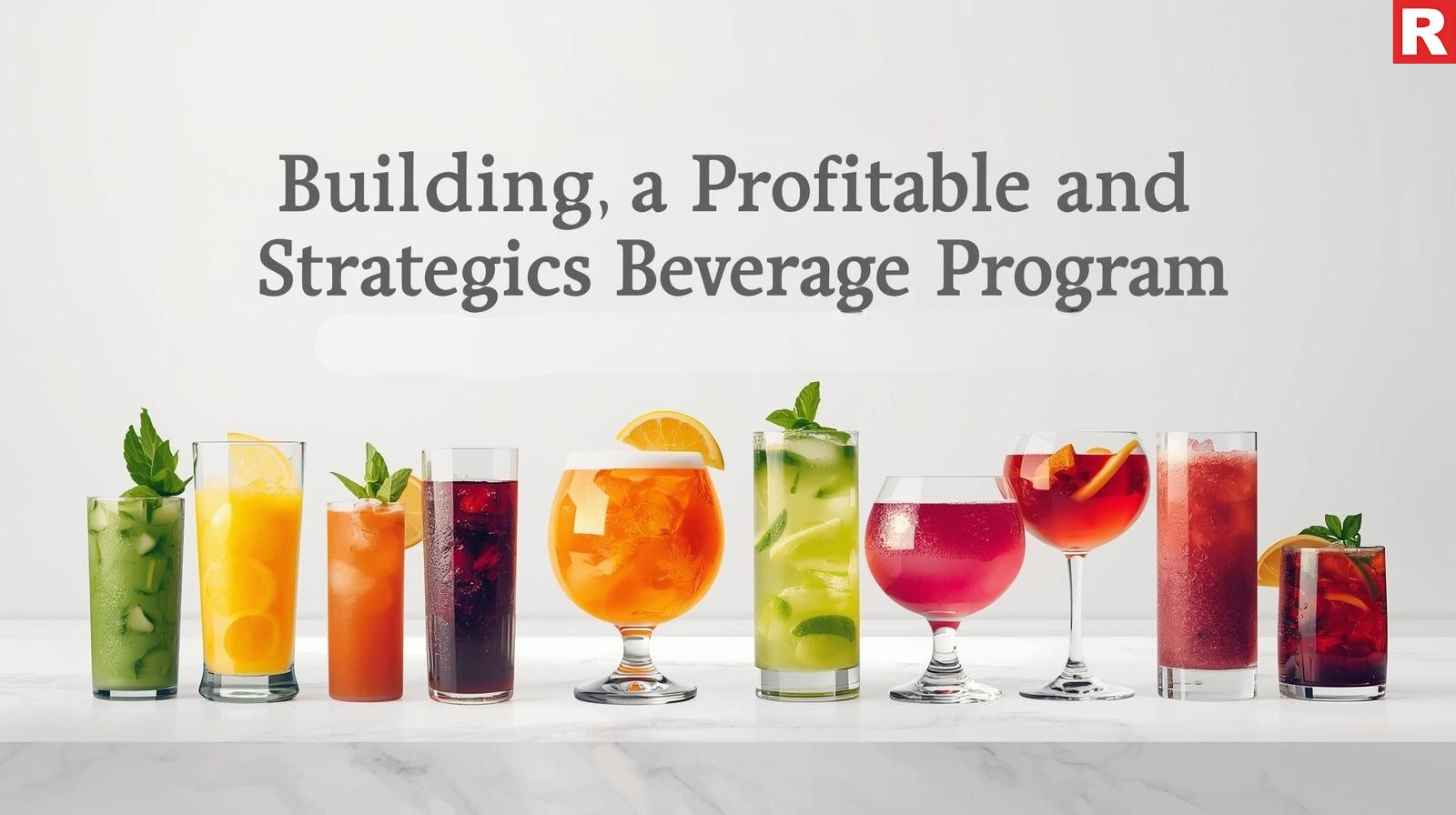
Despite the difficulties, a well-run beverage program has the potential to revolutionize a restaurant's profitability and reputation.
- Increasing Revenue: The profit margin on alcohol sales is usually higher than that on food sales. Your average customer spend and total income can both be considerably raised with a carefully chosen beverage menu.
- Differentiating Your Brand: Your beverage program could be a unique selling proposition (USP). You can differentiate yourself from the competition with a special lineup of craft brews, a well-chosen selection of premium wines, or an inventive cocktail menu.
- Creating a Social Hub: A well-managed bar can transform your restaurant into an enjoyable place for people, drawing them in for late-night parties or drinks after work in addition to supper.
Strategic Steps to Building a Profitable Program:
- Menu Engineering: Examine your sales information to determine which drinks are the most well-liked and profitable. Put them on the menu in a way that will boost sales.
- Staff Education: Invest in educating your waiters and bartenders about wine pairing, mixology, and appropriate serving techniques. A well-informed staff member can improve the visitor experience and upsell.
- Inventory Control: To monitor and control your liquor supply, put in place a strong inventory system. This aids in reducing expenses, waste reduction, and theft prevention.
- Strategic Alliances: Establish connections with brands and distributors of alcoholic beverages. They can provide staff training, tasting sessions, and marketing materials to promote your beverage program.
Read this: How to Find Good Staff for Your Restaurant
The Future of Liquor Regulation in India
India's liquor laws are gradually becoming more flexible, although this is not always the case. Some states are tightening regulations for social and political reasons, while others are loosening them to increase income and fight illegal alcohol.
- Digitalization of Licensing: A lot of states are switching to online application and renewal procedures, which should increase system efficiency and transparency.
- Emphasis on Responsible Serving: As governments and business associations work together to reduce underage drinking and drunk driving, there is an increasing focus on responsible serving and consumption.
- Growth of Craft Beverages: The flourishing craft whiskey, gin, and beer industries are advocating for more lenient laws that help small-scale manufacturers. Future licensing categories and regulations may result from this.
Conclusion
It takes a strategic approach, careful attention to detail, and a strong commitment to remaining educated to navigate India's changing liquor laws. A complicated, state-by-state legal system and unpredictable policy changes are just two of the major obstacles. However, there is a great chance to create a successful and profitable business for the smart restaurateur who takes an innovative approach to these restrictions. You may transform a regulatory obstacle into a major competitive advantage by investing in expert advice, encouraging a culture of responsible service among employees, and utilizing technology for adherence. A well-run beverage program is more than just an additional cost; it is a significant source of income and a crucial point of differentiation in a competitive industry. By taking a careful approach to regulations, you can protect your business and build a solid reputation for quality, which will guarantee that your restaurant's doors and its bar remain open and continue to serve customers for many years to come.

Every little detail counts in the fast-paced, cutthroat restaurant industry. Every component, from the well-chosen menu and welcoming atmosphere to the level of service, influences a diner's experience and, eventually, whether or not they choose to return. However, a restaurant's identity and success can be greatly impacted by a single, often-overlooked detail: the tagline or motto. A well-written slogan is more than simply a catchphrase; it is a potent marketing tool that can convey a brand's unique selling proposition, capture its essence, and establish an emotional bond with its target audience. In a bustling market, new businesses are always competing for customers' attention, and a catchy tagline can make the difference between a restaurant's success and failure.
This article will explore the strategic significance of restaurant taglines and slogans. We will examine the psychological effects they have on customers, present an overview for creating the ideal slogan, examine effective examples, and provide helpful suggestions for incorporating this effective technique into your restaurant's marketing plan.
Read more: 10 Ways the Restaurant Industry Impacted the Lifestyle of Indians
The Psychology of Slogans On Customers

An effective tagline automatically builds the brand of your restaurant in the minds of prospective customers. It acts as a mental shortcut, assisting customers in quickly remembering your brand and connecting it to a certain emotion or concept.
- Recall and Memory: Our brains are designed to store brief, memorable sentences. A short and witty tagline is far easier to remember than a lengthy restaurant description. Your tagline may be the secret to making sure that when a hungry customer is deciding where to dine, they think of your restaurant first. Consider the catchphrase of a well-known international chain: "I'm lovin' it." It's a straightforward statement that immediately conjures up feelings of contentment and joy, creating a powerful brand association.
- Emotional Connection: A strong slogan can awaken feelings of luxury, happiness, comfort, or nostalgia. A restaurant with the tagline "Your table, your story," for instance, implies a setting for private discussions and special occasions, forging a closer, more intimate bond with the business at hand. It conveys to the customer that the restaurant serves as a location for important life events in addition to being a place to dine.
- Trust and Authenticity: Trust is increased when a restaurant's motto precisely reflects its principles and offers. A restaurant's tagline strengthens its authenticity and establishes its reputation if it says it serves "The taste of home," and its food lives up to the promise. It lets the customer know what to anticipate from the experience.
The Blueprint for a Perfect Restaurant Slogan
Creating a catchy phrase is a skill that calls for careful consideration. It ought to combine brand intelligence, innovation, and clarity.
- Keep It Brief and Memorable: Try to use a phrase that is brief enough to be repeated and recognized with ease. Generally speaking, it should not exceed ten words. "Eat fresh" is a great example because it's brief, direct, and simple to remember.
- Emphasize your USP, or unique selling proposition: Why is your restaurant unique? Is it your farm-to-table foods, your innovative cuisine, your atmosphere, or your reasonable costs? This is what your slogan should convey. A restaurant that serves traditional Maharashtrian food, for instance, might employ a slogan like "The authentic taste of Maharashtra," which would instantly inform customers of its unique selling point.
- Speak to Your Target Audience: A fine-dining restaurant's motto should sound different from a family-friendly cafe's. The target audience should find resonance in the words you use. An elegant restaurant might have a tagline like "An unforgettable culinary journey," yet a cafe might have a more casual and friendly one like "Your daily dose of delicious."
- Evoke an Emotion or a Benefit: Explain how you make the customer feel rather than merely what you do. It is more expressive to say "Where happiness is served daily" than "We serve good food." Pay attention to the customer's advantage. "Fast food, without the guilt" shows that the restaurant offers a nutritious substitute.
Know more: How to Reduce Food Wastage in Your Restaurant
Taglines vs. Slogans: A Subtle Difference

Despite the fact that the terms are frequently used identically, there is a little but significant distinction that might guide your marketing approach.
Slogan
A short, catchy phrase frequently utilized in marketing campaigns. It can be modified for various promotions or campaigns. For a summer promotion, a restaurant might use the phrase "Cool off with our new shakes."
Tagline
A more permanent statement that establishes the identity of the brand. It is utilized regularly in all marketing materials and is ingrained in the brand's DNA. In the case of a restaurant, this is the key phrase that customers will remember for years to come. Consider a slogan such as "Pizza & Pasta perfection."
The majority of restaurateurs should concentrate on developing a catchy, enduring tagline that can serve as a vital element of their brand identity.
What's new: How to Embrace International Flavors in an Indian Restaurant
Analyzing Tagline Types: What Works for You?
There are many kinds of slogans and taglines, each with a different function. The brand identity and marketing goals of your business will determine which style is best.
- Descriptive taglines: These briefly state the services or products your restaurant provides. For startups or companies with a very particular niche, they are simple and tremendously successful. For instance, "The Finest Italian Cuisine" and "Authentic Seafood from the Coast." They eliminate any uncertainty for the client.
- Benefit-oriented taglines: These emphasize the feeling or value that the customer will experience. They are effective because they market the experience rather than just the item. The phrases "Where every meal is a celebration" and "Bringing families together since 1999" strike a deeper, more intimate connection.
- Funny or lighthearted taglines: These are effective for brands that are informal, quirky, or target young people. A memorable and approachable brand can be created with a catchy or humorous slogan. Consider a slogan such as "We're not fast food, we're real food" for a health-conscious cafe or "So good, it's criminal" for a dessert shop.
- Inspirational Taglines: These seek to relate to the ideals or goals of the target audience. They are frequently employed by businesses whose goals go beyond simply providing food. A socially concerned audience would find phrases like "Crafting a better world, one cup at a time" or "Sourced with purpose, served with passion" appealing.
Check out: How to Find Good Staff for Your Restaurant
How unique concepts have become a major hit among investors?
A Slogan's Impact Across Marketing Channels

An excellent tagline is a flexible tool that may be used in any aspect of marketing for your restaurant.
- Online Presence and Social Media: The homepage of your website, the bios of your social media accounts, and your online ads should all prominently display your motto. It draws in the correct audience and supports the message of your business.
- Print & Outdoor Advertising: With limited room to convey your message, a well-written tagline is crucial for print advertisements, brochures, and billboards. Someone walking by is more likely to remember a memorable phrase than a lengthy text passage.
- Inside-Restaurant Experience: Your phrase should be displayed on menus, coasters, napkins, or the walls of your restaurant. Customers' association with your brand is strengthened as a result of this, which reinforces the brand message while they are eating.
- Branded Products: Your phrase can be used to brand merchandise like coffee mugs and t-shirts, transforming customers into walking billboards for your restaurant.
Read this: Understanding Joint Ownership in the Restaurant Industry
Practical Steps to Crafting Your Tagline
Create a tagline that appeals to both your audience and your brand by following these easy steps.
- Brainstorming: Get your staff together, including managers, cooks, and even frequent customers, and come up with a list of words and phrases that best characterize your restaurant. Consider your fundamental values, your special dishes, and the emotion you wish to create.
- Describe Your Unique Selling Point: Clearly state what makes you different from your rivals. Are you an expert in a certain cuisine? Do you provide an unforgettable eating experience? Is your customer service very welcoming? Your motto is built around your USP.
- Draft and Test: Write down several different slogans. Say them aloud to test them. Are they easy to pronounce? Are they simple to recall? Get feedback from a few people you can trust after sharing them with them. Do they understand what you're attempting to say?
- Repeat and Finalize: Adjust your catchphrases according to the feedback. Select the one that most effectively conveys the core of your brand and appeals to your target market.
- Seek Expert Assistance: If you are having trouble coming up with the ideal phrase, think about working with a marketing firm or professional copywriter. They are skilled in turning the vision of your brand into a catchy phrase.
Conclusion
Customers have countless eating options, and a slogan or tagline is what differentiates them. It is the initial message that catches a customer's interest and the last one that stays with them. A strong slogan may convey the overall message of your business, establish credibility, and create an enduring emotional bond with your target audience. Putting time and effort into creating the ideal tagline is not just an advertising scheme for restaurateurs. It's a calculated move that lays the groundwork for long-term success. They are the few phrases that best capture your restaurant's essence, acting as both an icon that attracts customers and a treasured memory that keeps them coming back.

The Indian diner of today is a global citizen. They are no longer content with the traditional cuisine options alone because of their increased travel, exposure to digital media, and more adventurous palate. This change is a huge opportunity for restaurateurs all over India, from the busy streets to the urban centers. Embracing international cuisines in an Indian restaurant strategically and creatively is the key to being modern, drawing in a new customer base, and increasing your bottom line. Fusion is the art of making foods that surprise, delight, and attract customers to return for more. It's a delicate interaction between the familiar and the unfamiliar.
You can use this entire article as a guide to help you navigate this fascinating culinary zone. We will examine the strategic "why" of this movement, offer a useful "how-to" manual for execution, and offer advice on how to stay clear of typical pitfalls to make sure your journey into foreign flavors is a huge success.
Read more: Understanding Joint Ownership in the Restaurant Industry
Why an International Menu? The Shifting Palate of the Indian Diner
"Why would a diner choose an Italian pasta or a Mexican taco when they have an entire continent's worth of local specialties to explore?" is the most frequently asked question. The Indian consumer's fundamental shift holds the key to the solution. With a taste influenced by a variety of influences, the modern Indian diner, especially in urban and semi-urban areas, is a global citizen. They are looking for innovation, diversity, and the opportunity to experience a world of cuisines without having to travel outside of their city; they are not deciding between Indian and foreign cuisine. An international menu is an additional product that enhances the eating experience and satisfies a wider range of appetites, rather than taking the place of Indian food.
Causes for the Rise in Demand for International Food
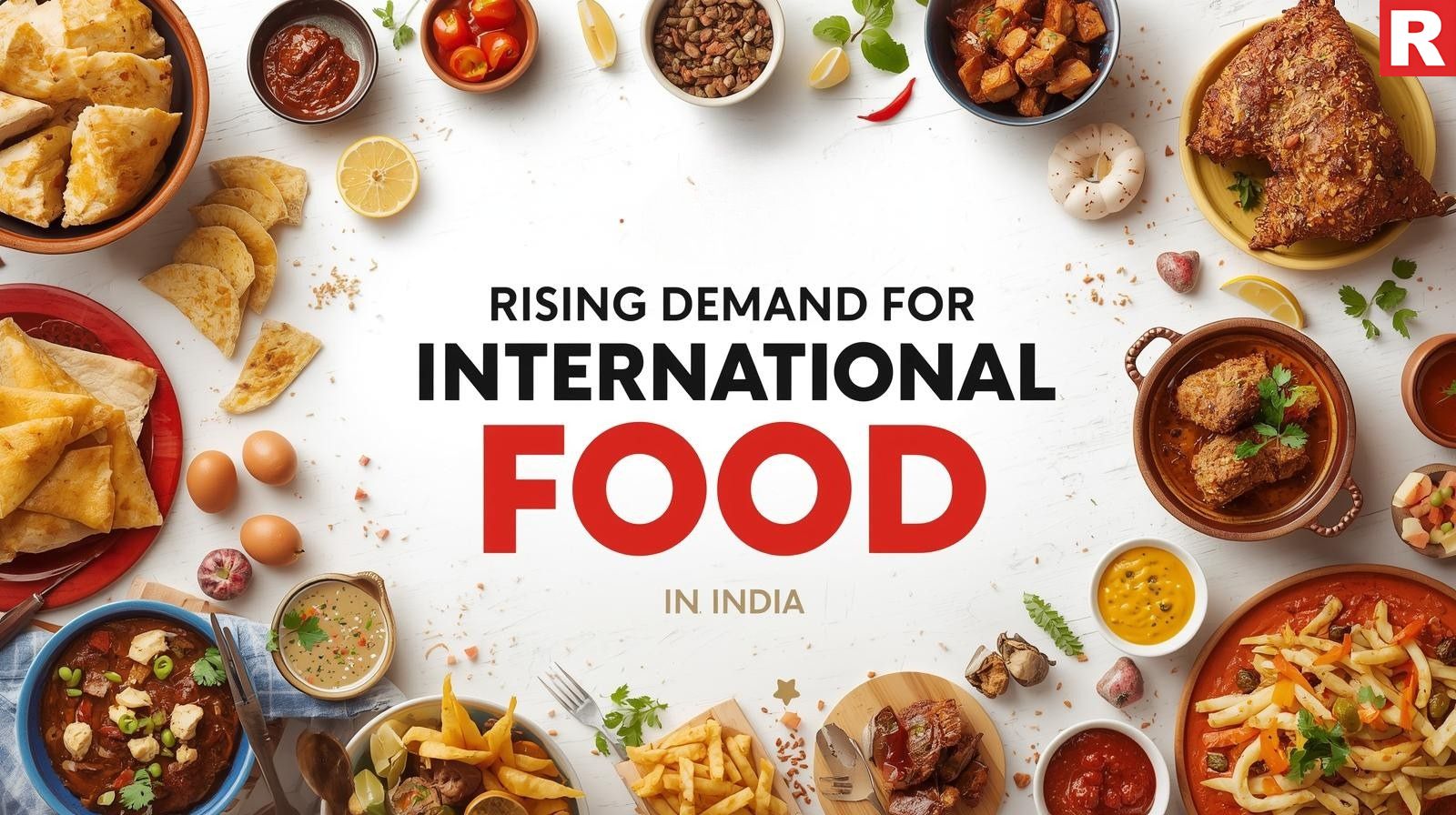
There is a reason why demand for international food has increased. The Indian consumer market has changed as a direct result of a number of significant socioeconomic and cultural changes.
- Increased Travel and Global Exposure: Travel abroad has increased as a result of rising disposable income. Indians are traveling to other nations, experiencing various cultures, and—above all—tasting new foods. There is a demand for real international food since they look for these same specialties when they return. Additionally, a sizable section of the population has direct exposure to foreign cuisine through friends, relatives, or personal experience due to the substantial Indian people who live and work overseas.
- The Digital Revolution: We now have access to the entire world thanks to the internet. International food trends, well-known chefs, and unique dishes are displayed on websites like Instagram, YouTube, and food blogs. A generation that may not have experienced delicacies like Korean kimchi, Japanese ramen, and Mediterranean hummus in their local area may now recognize them because of this digital exposure. As a result, there is a psychological and visual need for foods that were previously regarded as foreign.
- Changing Social Norms and Lifestyles: Younger generations, especially Gen Z and millennials, have a different perspective on eating. They see eating out as a social occasion and a kind of entertainment in addition to a way to get their nutrients. Trying a new overseas restaurant or a special meal turns into a social media-worthy experience. The desire for international menus is fueled by this ongoing quest for variety.
- Quick Service Restaurants' (QSRs') Impact: An important factor has been the development of global QSR franchises like McDonald's, Domino's, and Subway. They have effectively introduced and normalized formats like pizzas, burgers, and sandwiches, opening the door for more varied foreign concepts, even though their products tend to be unique.
Know more: How to Keep Track of Daily Restaurant Tasks
How to Make Your Restaurant International-Food Friendly

It takes more than simply a menu modification to make a move to incorporate international cuisine. From staff training to your supply chain, it demands a systematic reorganization of your business. A complete approach to making your restaurant really international food-friendly can be learned here.
Supply chain and sourcing
Ensuring the quality and authenticity of ingredients is the biggest obstacle. A knowledgeable customer will be let down by a sushi roll made with rice that isn't sushi-grade or a pasta dish built with inferior cheese.
- Locate Specialized Importers: Establish connections with food importers who specialize in foreign meat, dairy, and vegetables in large cities. Nowadays, a lot of them have internet portals that can ship to a variety of cities.
- Local Substitutes: Look for regional substitutes that can replicate the flavor character of foods that are difficult to get. For instance, a premium local cheese may be used in place of an expensive imported one, or a local chili pepper could be used in place of a particular type of Mexican chili.
Kitchen and Staff Training
Although your kitchen crew may be experts in Indian food, they might not be well-versed in foreign cooking methods.
- Hire a Consultant: If you want to offer a certain international cuisine, think about hiring a chef or consultant with expertise in that area. They may offer complete training in anything from flavor pairings to knife skills.
- Cross-Training: Teach your current employees the new methods and recipes if your Indian restaurant is adding some foreign foods. Make sure they understand the plating rules and flavor profiles.
Redefining the Menu and Ambience
The menu must guide the customer through this new food experience since it is your main means of communication.
- Dedicated Sections: Make an additional, clearly marked area on your menu just for international cuisine. This keeps things clear and makes it simple for customers to find what they're looking for.
- Clear Descriptions: Explain the food, its main components, and its history using colorful and detailed language. You can't presume that your customers are aware of what a "risotto" or "chimichurri" is.
- Complementary Ambience: The atmosphere of the restaurant shouldn't be overwhelming. To make the international cuisine feel genuine in your current environment, you can employ subtle clues like themes in music, a different set of silverware, or a different service style—all without totally altering your design.
What's new: A Guide to Keeping Your Restaurant Kitchen Bug-Free
The Financial Impact
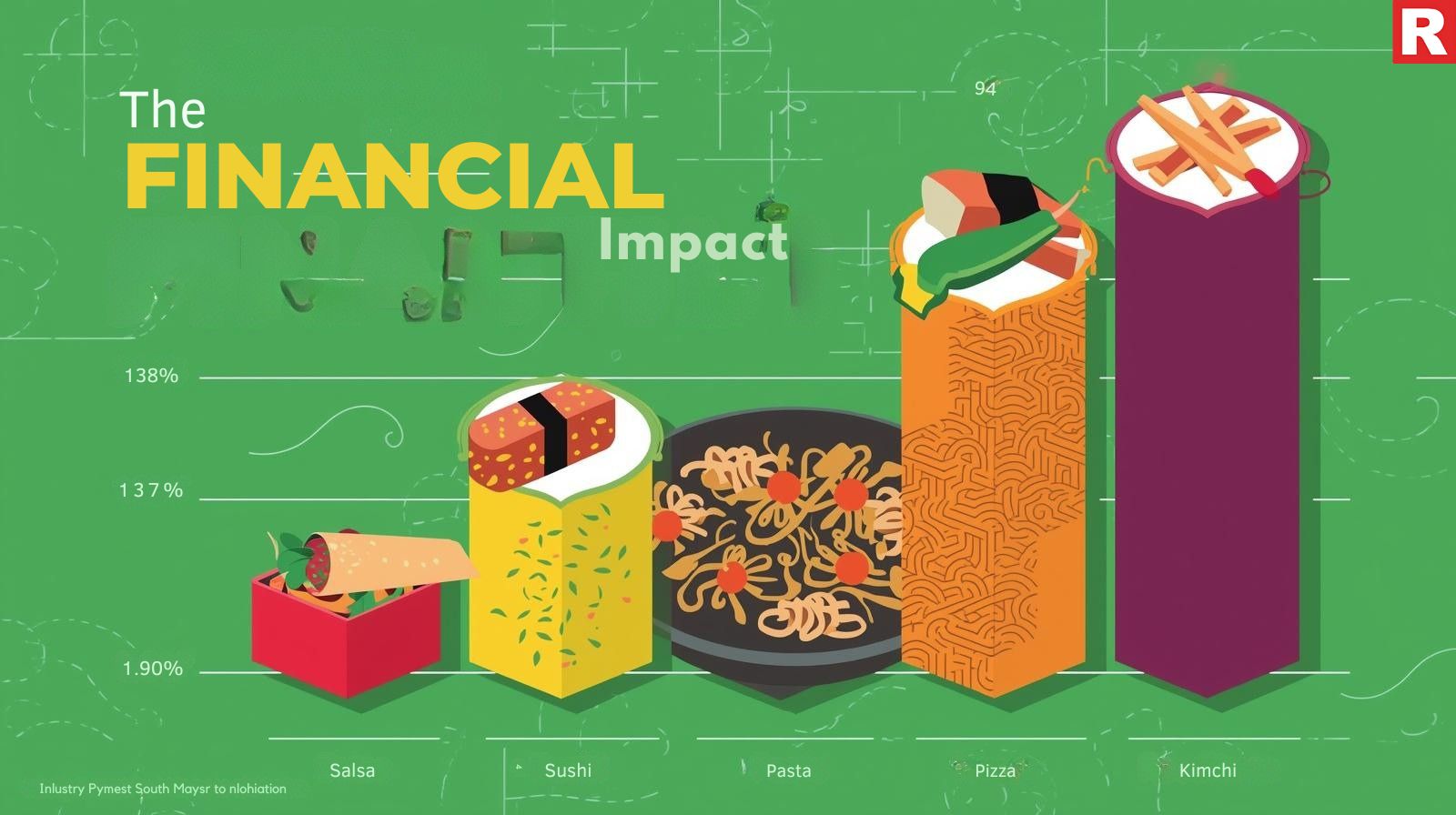
Including international cuisine on your menu is a big financial investment as well as a creative initiative. Success requires an understanding of the business parameters.
- Menu Pricing: You may have to pay more for foreign ingredients and specialized training. This needs to be reflected in your pricing. For any new meal, do a thorough cost-of-goods-sold (COGS) analysis, accounting for labor and possible waste in addition to ingredients.
- Profitability: Since international cuisine tends to be more expensive, there may be a larger profit margin. This is only the case, however, depending on whether your sales volume is sufficient to cover the original outlay. Determine which foreign meals are selling the best and generating the most revenue by routinely analyzing sales statistics.
- Return on Investment (ROI): Purchasing new machinery, receiving training, and sourcing can all be expensive. Tracking the addition of new customers, average guest spending, and the buzz created by your new menu will help you determine the return on investment. You can use this information to support your initial investment and make well-informed decisions about growing your global offerings.
Marketing Your Global Menu
The next stage after mastering your international dishes is to generate hype and share your story with others. The secret to making sure your new menu is recognized is strategic marketing.
- Social Media Showcase: Post high-quality images and videos of your new dishes on social media sites like Facebook and Instagram. Emphasize each dish's special ingredients, preparation method, and inspiration. Tell an engaging story that ties your brand to the global flavor.
- Collaborate with Influencers: Join partnerships with local influencers, food bloggers, and food critics who have a history of interacting with daring diners. Organize special events and tastings to encourage genuine reviews and word-of-mouth advertising.
- In-House Promotions: Teach your front desk employees to act as brand ambassadors for the international menu. They ought to be competent in making meal recommendations, describing the different flavors, and suggesting complementary drinks. Adding a personal touch can greatly increase sales.
- Themed Events: Plan pop-ups or unique events that are focused on a certain exotic cuisine. Events like "Pasta & Wine Night" or "Taco Tuesday" can draw in new clients and infuse your brand with enthusiasm and originality.
Check out: A to Z List of Restaurant Operations
Adoption of AI for Personalized Customer Experience In Restaurants
Typical Mistakes to Avoid: Handling the Obstacles

International cuisine has a lot of potential, but certain frequent mistakes might ruin your plans. The first step to conquering these obstacles is realizing they exist.
- Losing Brand Identity: The biggest error is allowing your foreign or fusion menu to overwhelm the main character of your restaurant. Your brand should still be recognizable to a consumer. A biryani-focused restaurant shouldn't turn into a Mexican cantina overnight.
- Inauthentic or Confusing Flavors: The foreign cuisine needs to make sense. A dish that is chaotic and unattractive can result from just combining random ingredients from various cultures. The flavors must complement each other in a way that is both surprising and harmonious.
- Low Quality Ingredients: Using poor ingredients can result in a bad customer experience, particularly when introducing new flavors. Quality and authenticity should never be sacrificed.
- Ignoring Customer Feedback: Keep a careful eye on how people are reacting to your new meals. Be ready to change a dish or take it off the menu if it doesn't work. Instead of forcing a concept that doesn't appeal to your audience, the goal is to innovate.
Read this: How to Find Good Staff for Your Restaurant
Conclusion
Adding international cuisine to your menu is a smart move that will pay off in a market where customers are always looking for new and exciting experiences. A fundamental change in your restaurant's identity, that is, from an exporter of regional cuisine to a collector of international flavors, is more important than simply adding a few new things. You may successfully navigate this new environment by comprehending the reasons behind the demand, carefully revising your menu, investing in staff training, and strategically obtaining ingredients.

A clean and bug-free kitchen is not only a question of hygiene in the dynamic and cutthroat Indian restaurant business; it is an essential component of your brand, a sense of security for your customers, and a key to long-term success. With its high temperatures and humidity, the nation's distinct tropical and subtropical environment makes it the perfect place for a wide variety of pests to breed. A single sighting of an unwanted visitor, such as a flying insect or a crawling cockroach, can quickly turn off customers, result in health code violations, and permanently harm a restaurant's reputation.
This article will give restaurateurs all over India the know-how and preventive strategies they need to set up and keep a restaurant kitchen that is completely bug-free. In order to safeguard your restaurant space and guarantee a secure, hygienic environment for your staff and your esteemed customers, we will explore the pests and diseases and describe efficient prevention and removal methods.
Read more: Delhi High Court Questions Legality of Restaurant Service Charges in India
Knowing Your Enemy: Common Pests Found in Kitchens

In addition to common pests, Indian restaurateurs need to be on the lookout for certain species and the health hazards they pose.
- Cockroaches: A typical sight in Indian kitchens, the German Cockroach (Blattella germanica) is a small but powerful breeder of cockroaches. Additionally, common is the common American Cockroach (Periplaneta americana). These pests transport and disperse a variety of diseases that cause typhoid fever and diarrhea, including Salmonella and E. coli. They thrive in the warmth and humidity and are drawn to food scraps and wetness.
- Flies: The fruit fly (Drosophila melanogaster) and house fly (Musca domestica) are common flies. Food poisoning-causing microorganisms are spread by flies landing on decomposing materials and later on your food. Their numbers increase during the monsoon, posing a serious risk to human health.
- Ants: The Pharaoh Ant (Monomorium pharaonis), which is renowned for its small size and capacity to contaminate food and infest food packaging, is one of the many ant species found in India. They can be famously hard to get rid of and are attracted to oily and sweet foods.
- Rodents: In Indian cities, the House Mouse (Mus musculus) and the Roof Rat (Rattus rattus) are common. They can chew through building materials, food packaging, and electrical lines. Their urine and droppings contaminate food and surfaces, increasing the danger of hantavirus and leptospirosis.
- Stored Product Pests: These insects, which include the Indianmeal Moth (Plodia interpunctella) and the Rice Weevil (Sitophilus oryzae), flourish in dry items that are kept in storage, such as flour, rice, and spices. They pose a continual risk to your pantry and, if not detected in time, can destroy a lot of stock.
- Viruses and bacteria: There are other dangers than pests. Warm, humid temperatures are perfect for an increase in microscopic diseases, which is a persistent worry. Serious infections caused by food can be brought on by bacteria such as Salmonella, Staphylococcus aureus, and Listeria. These infections are frequently transmitted by pests, poor personal hygiene, and cross-contamination.
Prevention is Key: Your First Line of Protection
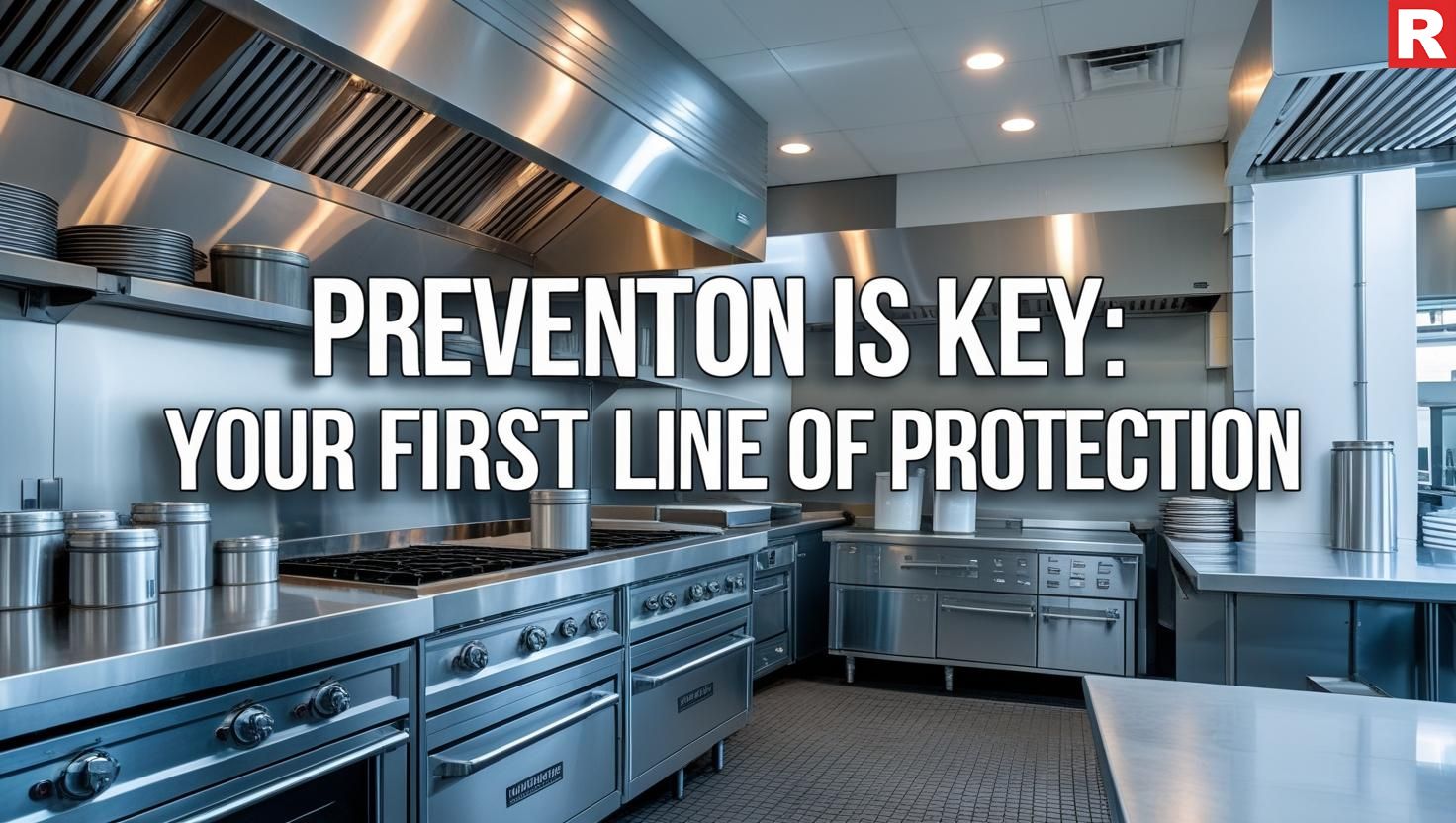
Prevention is the best approach to pest management. You can keep your kitchen safe and reduce the need for chemical intervention by creating a fortress against pests.
- Seal Off All Entry Points: Examine your kitchen thoroughly. Use sealant or other long-lasting materials to seal any gaps or cracks in pipes, walls, and flooring. Make sure the screens on all windows and doors are kept up to date, and install door sweeps.
- Strict Waste Management: The primary reason is food waste. Make sure to use trash cans with lids that fit tightly. Empty garbage cans often, particularly at the end of each shift. All trash cans should be routinely cleaned and sanitized. Keep trash cans out of the building's way and don't leave them there overnight.
- Weekly and Daily Cleaning Routines: Pests cannot find nourishment in a kitchen that is kept clean. Establish a strict cleaning routine:
- Every day: Mop and sweep floors, clean under and behind equipment, and wash down all countertops.
- Weekly or biweekly: Completely clean difficult-to-reach places, such as inside grease traps, behind ovens, and refrigerators.
- How to Store Food Properly:
- All grains, spices, and dry items should be kept in sturdy, airtight containers.
- To avoid spoiling, use the "First-In, First-Out" (FIFO) procedure for every ingredient.
- All food should be stored on shelves or pallets at least six inches off the ground.
- Spills in storage rooms should be cleaned up right away.
Know more: The Top Most Famous Dishes of the World by Country
Effective Elimination Techniques
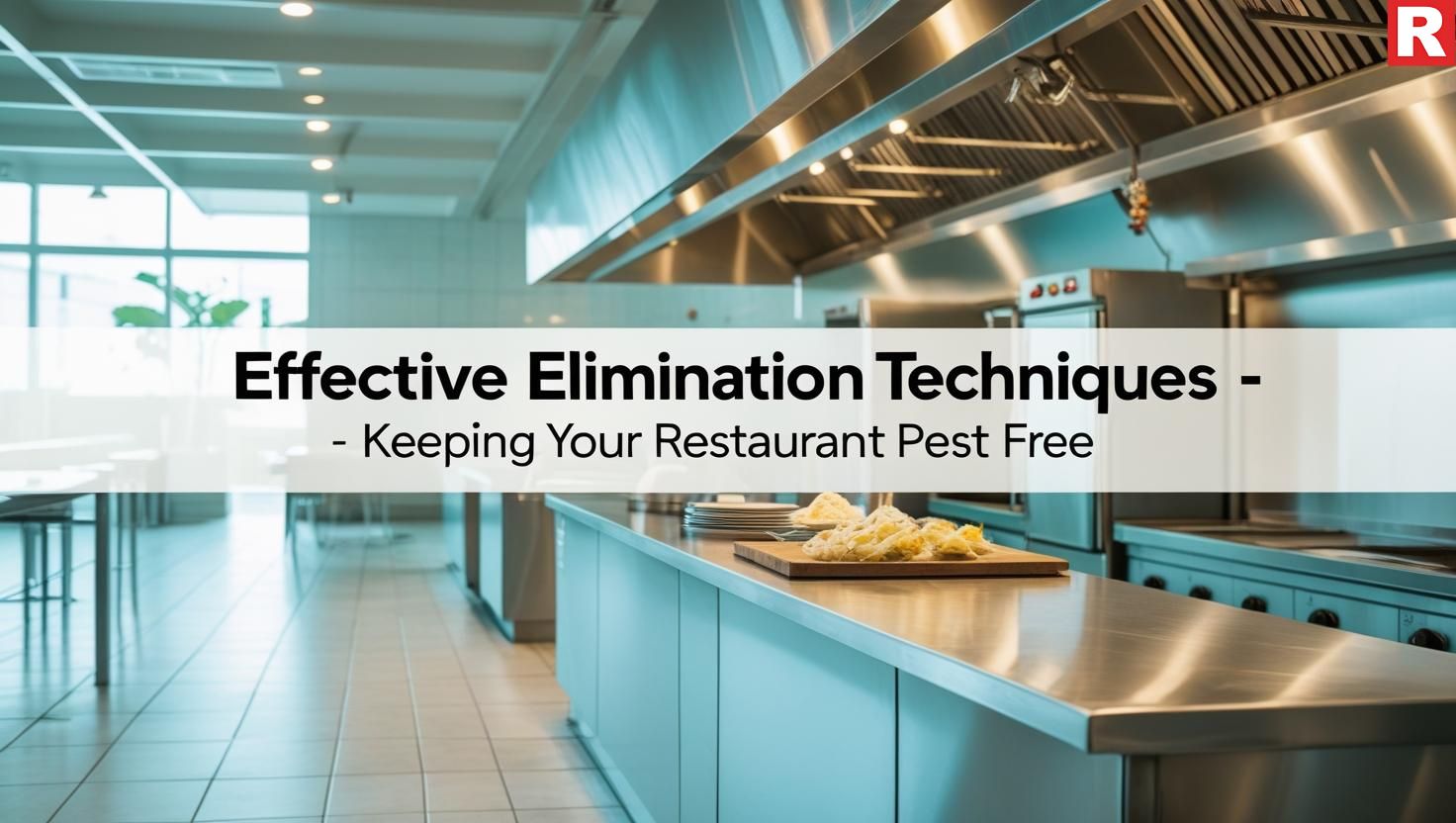
Occasionally, pests may enter your kitchen despite your best attempts to keep them out. To get rid of them before they become a serious infestation, quick and efficient intervention is essential.
1. Non-Chemical procedures: Give non-chemical procedures priority whenever you can, particularly in places where food is prepared:
- Traps: Cockroaches, ants, and rodents can be successfully captured using sticky traps, pheromone traps, and bait stations.
- Baits: You can use non-toxic baits for cockroaches and ants.
- Physical Removal: Ants, cockroaches, and their eggs can be eliminated with the use of a vacuum.
- Steam Cleaning: Insects and their eggs in cracks and crevices can be destroyed by high-pressure steam.
2. Chemical Methods (Use with Caution): Chemical treatments may be required when non-chemical methods prove inadequate. However, in a professional kitchen, these should be used rarely and strictly in accordance with safety regulations:
- Residual Sprays: When pests come into contact with the residue left by these insecticides, they may die. Apply carefully to crevices, cracks, and other hiding places for pests. Make sure that every surface used for food preparation is covered while in use and is cleaned completely afterwards.
- Chemical Baits: For cockroaches and ants, chemical baits are frequently more precise and efficient than sprays.
- Foggers/Bombs: While these are easily accessible, they may not be as effective since the insecticide may not reach pests that are lurking in gaps and crevices. Use it very carefully, make sure there is enough ventilation after usage, and wipe any surfaces that come into contact with food.
- Dusts: Vents and other hard-to-reach places where pests congregate can be treated with insecticidal dusts.
Crucial Points to Remember When Using Chemicals:
- Use goods that are properly labeled for use in commercial kitchens at all times.
- Carefully read and adhere to all label instructions.
- Pesticides should never be sprayed directly on surfaces used for food preparation.
- Before using any chemicals, cover or remove all food, utensils, and equipment.
- Make sure there is enough airflow both during and after application.
- Wash all treated surfaces thoroughly with soap and water after the prescribed waiting period.
- For chemical applications, especially for extensive infestations, think about working with a professional pest control company.
What's new: A to Z List of Restaurant Operations
Staff Training
The first line of defense against pests is your staff. Proper training in early detection and elimination of pests is crucial.
- Hygiene Procedures: Educate employees on the value of keeping things tidy, handling food correctly, and wiping up spills right away.
- Waste Disposal Procedures: Make certain that everyone is aware of and works with the appropriate waste management guidelines.
- Early Detection: Train employees to recognize common pests and the clear symptoms of infestation, such as droppings and sightings.
- Reporting Procedures: Provide a clear procedure that allows staff to notify management right away of any pest observations or issues.
- Personal Hygiene: Stress the value of maintaining good personal hygiene, including washing your hands, to stop the spread of pollutants.
The Importance of Professional Pest Control

Many restaurants find that working with a respectable, expert pest control service is a smart financial decision. These professionals possess the skills, resources, and background necessary to:
- To find possible entrance points and pest issues, and conduct comprehensive inspections.
- Create specialized treatment programs based on your unique requirements and the kinds of pests that are present.
- Employ pest control techniques that are safe and efficient for commercial kitchens.
- Continue to monitor and offer preventative services.
- Provide guidance and suggestions regarding the best ways to prevent pests.
- Keep track of treatment records and make sure rules are followed.
It's critical to pick a pest control business that follows integrated pest management (IPM) guidelines and is aware of the unique requirements of the food service sector. IPM prioritizes long-term prevention and only employs targeted, essential chemical treatments.
Check out: Understanding Joint Ownership in the Restaurant Industry
A Beginner’s Guide to Pairing Food with Whisky
Regular Monitoring and Follow-Up
Keeping your kitchen bug-free requires constant work. Establish a process for routine observation and follow-up:
- Regular Inspections: Keep an eye out for any indications of pest activity in the kitchen and storage rooms by doing your own routine inspections.
- Examine cleaning logs: Check every once in a while to make sure that regular cleaning schedules are being adhered to.
- Keep an eye on traps: If you're employing traps, make sure to check them frequently and replace them as necessary.
- Deal with Problems Quickly: Take prompt action to get rid of any pests you see.
- Talk to Your Pest Control Provider: If you have a contract with a pest control company, keep in touch with them frequently and arrange for follow-up appointments as required.
Read this: How to Keep Track of Daily Restaurant Tasks
Conclusion
Keeping your restaurant kitchen bug-free is a sign of your dedication to food safety, customer welfare, and brand integrity. You can create a clean, safe, and welcoming atmosphere for your team and consumers by putting in place an effective preventative strategy, learning about common pests, using efficient elimination procedures, training your personnel, and taking professional pest control's knowledge into consideration. This commitment to pest management is not only about preventing issues; it's also about establishing an excellent track record and guaranteeing the continued success of your restaurant business.

Managing a restaurant is both an exciting and challenging job. Culinary skills are combined with the requirements of hospitality, finance, marketing, and human resources in this high-stakes, high-reward industry. The secret to transforming a love of food into a successful and long-lasting business for both aspiring and seasoned restaurateurs is to understand the complex network of daily responsibilities and long-term plans. It's about a symphony of operations, each of which plays a crucial part in the harmony of a successful business. It's not just about what goes on in the kitchen.
This complete article breaks down the restaurant industry from A to Z, offering an extensive checklist and a strategic overview of each crucial task. This list is a valuable tool to help you manage both day-to-day operations and long-term planning for your restaurant, regardless of your level of experience.
A: Atmosphere and Ambiance
The essence of your restaurant is in its atmosphere. It is a crucial aspect of a diner's experience and the initial impression. This covers the temperature, lighting, music, décor, and seating arrangements. A well-designed ambiance can help you stand out from the competitors as diners seek out a unique place to relax.
Read more: The Top Most Famous Dishes of the World by Country
B: Business plan and Budgeting
A sound business plan and a thorough budget are the foundation of any successful restaurant. Your vision, mission, target market, financial predictions, and a detailed plan for reaching your objectives should all be included in this document. Maintaining cost control and profitability requires regular budget monitoring.
C: Client Support
Providing outstanding customer service is a must. It all comes down to providing visitors with a smooth and unforgettable experience from the moment they arrive until they depart. This involves a warm greeting, attentive staff members, precise order taking, and effective service. It is the single most effective method for creating positive word-of-mouth and fostering loyalty.
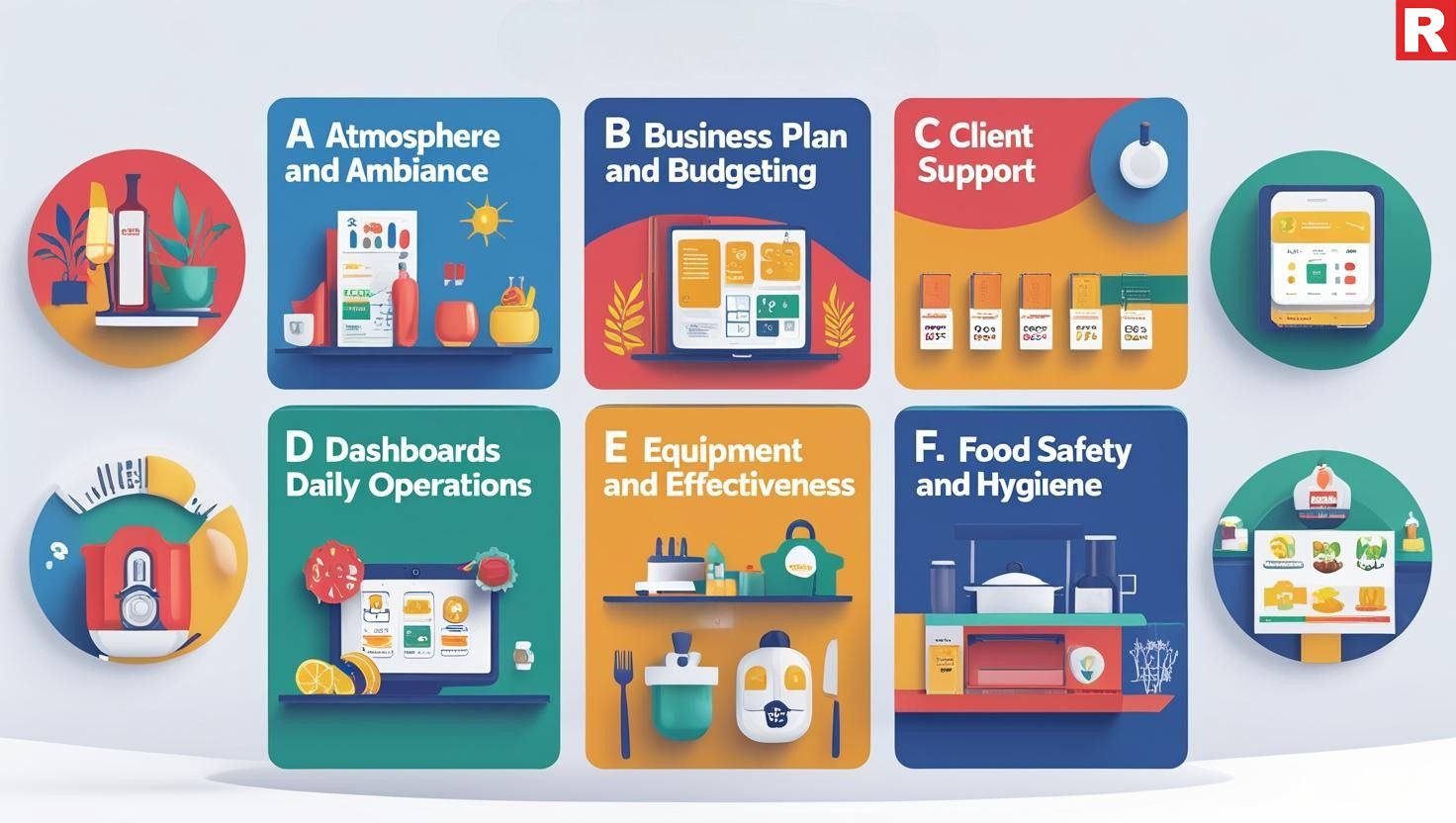
D: Dashboards and Daily Operations
Daily operations include all of the standard chores that keep the restaurant operating, such as closing procedures and opening checklists. To guarantee uniformity and responsibility throughout all shifts, it is essential to use a digital dashboard or an easy checklist to monitor these responsibilities.
E: Equipment and Effectiveness
Your most valuable possession is your kitchenware. Operational effectiveness depends on timely repairs, routine cleaning, and maintenance. Purchasing the appropriate equipment, such as dependable point-of-sale systems or high-quality ovens, can increase production, cut down on waste, and save time.
Know more: Vegan Food Revolution: 6 Dishes Everyone Should Try in 2025
F: Food Safety and Hygiene
Hygiene and food safety are crucial. This requires strict follow-up with all health and sanitation laws, appropriate food handling and storage, and frequent worker training. Your reputation and the trust of your patrons are built on a hygienic kitchen and a secure dining space.
G: Guest Relations and Feedback
Feedback and customer interactions must be actively managed. Customers should be encouraged to discuss both positive and negative experiences. Respond to any comments, particularly those found online, in a timely and professional manner to demonstrate your appreciation for your clients and your dedication to ongoing development.
H: Hiring and Human Resources
The core of your restaurant is your staff. Strategic hiring, thorough training, equal pay, and dispute resolution are all part of human resources. Attracting and keeping top talent requires a friendly and encouraging work environment.
I: Inventory and Supply Chain Management
Cost control and food waste reduction depend on effective inventory management. Put in place a "First-In, First-Out" (FIFO) system and monitor stock levels with technology. Establishing solid connections with a trustworthy vendor is essential to a steady supply chain.

J: Job descriptions and Jurisprudence
Clearly written job descriptions for every role ensure that each employee knows their obligations. Additionally, for legal compliance and moral business practices, a basic awareness of local labor laws and jurisprudence is necessary.
What's new: How to Keep Track of Daily Restaurant Tasks
K: Kitchen Management
The art of managing a kitchen effectively involves striking a balance between efficiency and creativity. It includes scheduling employees, arranging the menu, controlling costs, and making sure that orders flow smoothly during busy times.
L: Liquor and Beverage Program
A well-run liquor and beverage program can be a substantial source of income if you serve alcohol. This covers inventory management, appropriate serving procedures, and a well-chosen variety of drinks that go well with your menu of foods.
M: Marketing and Promotions
To draw in new clients and maintain the interest of current ones, strategic marketing is crucial. Social media marketing, regional ads, email newsletters, and exclusive offers catered to your target market are all included in this.
N: Niche and Concept
What makes your restaurant unique is its concept or specialization. Whether you run a specialty food truck, a casual café, or a fine-dining facility, your menu, atmosphere, and marketing plan are all guided by a distinct idea.
O: Online Ordering and Presence
Having a strong online presence is essential in today's digital environment. This consists of an interconnected online ordering system, a current website, and active social media accounts. Providing delivery and takeout choices can greatly increase your customer base and income.
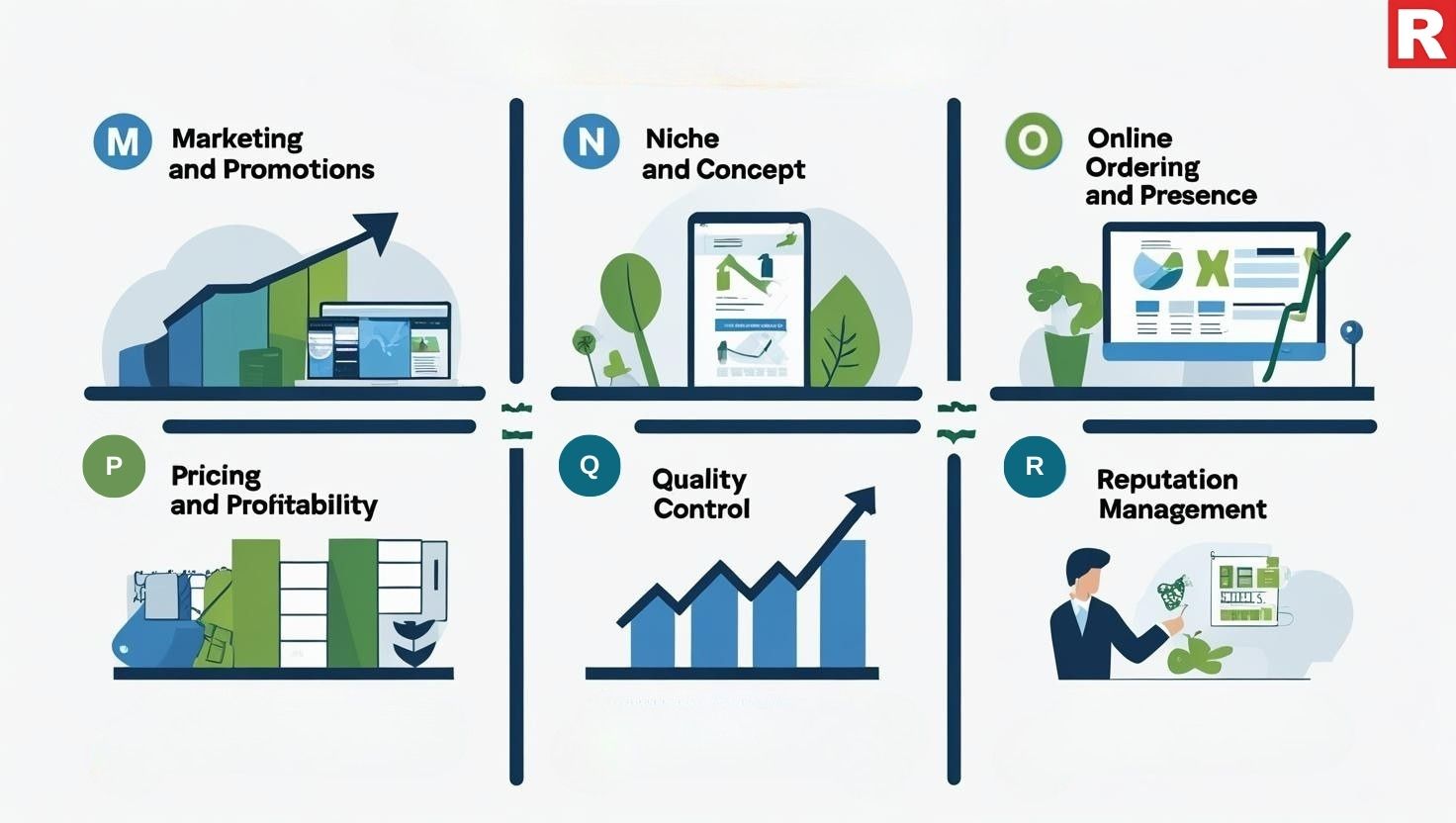
P: Pricing and Profitability
The secret to profitability is strategic pricing. Setting rates that are both competitive and profitable requires careful consideration of labor expenses, food costs, and operating overhead costs. It is important that you regularly analyze your profit and loss statements.
Q: Quality Control
You offer the consumer strict quality control. This holds for all elements of the dining experience, including the consistency of the service and the cleanliness of the plates, in addition to the meal.
R: Reputation Management
Your greatest asset is your reputation. Keep a close eye on social media and online review sites, and reply to all comments in a timely and professional manner. A good reputation can increase brand loyalty and draw in new clients.
S: Scheduling and Staff Training
A team that works well is one that has received proper training. Staff training needs to be a continuous procedure. Effective labor cost management and the proper number of employees on duty to handle consumer traffic are guaranteed by smart scheduling.
T: Trends and Technology
Staying competitive requires keeping updated on industry developments and restaurant technology. This involves installing new point-of-sale (POS) systems, investigating artificial intelligence (AI) for tailored experiences, and adjusting to shifting consumer preferences, such as the need for eco-friendly solutions.

U: Uniformity and Consistency
Building a trustworthy brand requires uniformity and consistency in all processes. Customers expect the same high standards each time they visit your restaurant, whether it's the quality of the service or the taste of the food.
V: Vendor Relationships
A reliable supply chain is built on solid vendor relationships. Consider your suppliers as partners since they may offer you better prices, insightful information, and a steady supply of premium ingredients.
W: Waste Management
Effective waste management is a financial decision in addition to an ethical one. Use techniques to cut down on food waste, like composting, a FIFO system, and clever menu planning, to save money and lessen your impact on the environment.
X: Xenodochia's Excellence (Hospitality)
Xenodochia, which translates to "friendly to strangers," is an ideal way to characterize the hospitality sector. The foundation of your business is your dedication to providing this level of service, that is, making each visitor feel appreciated and welcomed.
Check out: A Beginner’s Guide to Pairing Food with Whisky
Understanding Joint Ownership in the Restaurant Industry
Y: Yield and Profitability Analysis
It's critical to regularly assess your profitability per dish and yield (the amount of food product that may be used). Your menu strategy will be guided by this data-driven approach, which assists you in determining which of your menu items are the most and least profitable.
Z: Zeal and Zest
Lastly, the restaurant depends on your enthusiasm and zeal. The success of a restaurant in India or anywhere else in the world will ultimately depend on your love of cuisine, your commitment to providing excellent service, and your steadfast devotion to your staff and customers.
Advantages of Using This List
- Holistic Overview: The list offers a thorough, A-to-Z look at each aspect of restaurant administration, making sure that no crucial duty or functional area is missed.
- Structured Framework: It helps you transition your business from a reactive to a proactive state by providing a well-defined, well-organized framework for daily, weekly, and long-term responsibilities.
- Enhanced Efficiency: The guide assists you in identifying and putting into practice techniques that simplify operations and eliminate bottlenecks by addressing everything from kitchen workflow to technology adoption.
- Better Consistency: The checklist structure encourages uniformity among all team members and shifts, resulting in a consistently dependable and excellent client experience.
- Enhanced Profitability: The guide offers the resources to optimize revenue and profitability by emphasizing cost control, financial management, and strategic pricing.
- Improved Team Management: It emphasizes how crucial it is to hire, train, and communicate well in order to create a motivated and productive team.
- Reduced Risk: The guide assists you in reducing operational risks and protecting the reputation of your restaurant by going over legal requirements, food safety, and waste management.
- Competitive Advantage: In a congested market, focusing on unique aspects like ambiance, specific themes, and web presence helps you set your restaurant apart.
- Long-Term Planning: It prepares your company for long-term success by encouraging you to think beyond your everyday responsibilities. It includes sections on business planning, vendor partnerships, and exit options.
Read this: Your Guide to Influencer Marketing in Restaurants
A Recipe for Long-Term Success
From A to Z, navigating the complicated details of restaurant management requires constant learning and adjustment. Although this article offers an effective framework, the real secret to success is applying these ideas consistently. You can create a robust and successful restaurant by grasping the principles of atmosphere, budgeting, and customer service, as well as by adopting technology and a data-driven strategy. A restaurant that succeeds at every operational touchpoint stands out in a thriving culinary culture, not only for its food but also for its flawless and remarkable experience. The secret is to view every task, no matter how minor, as an essential part of the vision of your business's name. One flawlessly carried out operation at a time, you can transform a passion into a legacy with unwavering dedication, a commitment to your team, and an unrelenting focus on the consumer.

Partnership in businesses is not a new thing. This also applies to the restaurant business. In the ever-changing and demanding sector of the restaurant business, the idea of sharing responsibilities and workload can be quite appealing. Many aspiring restaurateurs start their journey with a partner. Joint ownership is a model that is both common and often successful. It combines different abilities, pooled resources, and a shared love of food and hospitality into one. However, every partnership, like a great dish, requires a lot of communication, a clear plan, and the correct combination of ingredients to work. Without a strong foundation, a collaboration that starts with great intentions may rapidly turn into a point of dispute, endangering the business as well as the partnership.
This article will delve into understanding what joint ownership actually means in the restaurant industry. We'll look at the main factors that influence partners' decisions, the important legal frameworks that support them, the typical problems they run into, and a workable plan for establishing a fruitful and long-lasting joint venture. These guidelines are universal and crucial for anyone thinking about a joint venture.
Read more: A Beginner’s Guide to Pairing Food with Whisky
The Appeal of Joint Ownership
Restaurateurs who decide to start a restaurant with a partner or partners do so for a number of strong reasons.
- Shared Financial Burden: It takes a lot of money to open a restaurant. Funds can be combined through a partnership, which makes it simpler to obtain an initial commitment, pay for ongoing expenses, and control financial risk. Additionally, it may provide access to a larger group of possible lenders and investors.
- Complementary Skill Sets: The restaurant industry is complex, needing knowledge in a variety of fields, from marketing, finance, and customer service to culinary arts and kitchen management. Diverse skills can be combined through collaboration. A well-rounded and successful management team can be produced, for instance, if one partner is a gifted chef and the other is an expert in marketing and business administration.
- Shared Workload and Accountability: Operating a restaurant comes with a lot of responsibilities, including long hours and ongoing stress. By allowing for the division of labor, a partnership makes sure that no one person is overburdened. Because both partners have a stake in the company's success, it also promotes a sense of shared accountability.
- Inbuilt Support System: Being an entrepreneur can have a big emotional and psychological cost. Sharing accomplishments, overcoming obstacles, and encouraging one another during difficult times are all made easier when you have a partner.
Know more: Marketing The Gen Z Way For Your Restaurant
Types of Joint Ownership

The most important step in a joint ownership business is selecting the appropriate legal structure. The decision affects everything, including taxation and personal liability, as well as the simplicity of capital raising and dispute resolution.
Partnership Firm: A typical and simple structure is the partnership firm. A partnership deed governs the relationship between partners, who agree to split earnings and losses. The rules of the partnership, including duties and obligations, capital contributions, profit-sharing ratios, and conflict resolution procedures, are outlined in this legally binding deed. A thorough and well-written deed is essential to preventing future disputes. One major disadvantage is that partners' personal assets may be at stake if the business fails due to their limitless personal liability.
Limited Liability Partnership (LLP): An LLP provides the benefits of a partnership while giving limited liability protection to the partners. This implies that a partner's private assets are typically shielded from the obligations and liabilities of the company. It is a more formal structure rather than a partnership firm. Therefore, it is seen as a popular choice for new ventures due to the balance between flexibility and legal protection.
Private Limited Company: A private limited company is a more complex and formal form of organization. The partners are shareholders in the restaurant, which is registered as an independent legal entity. Because the shareholders' liability is limited to the amount they invested in the business, this structure offers the highest level of liability protection. It also enables capital raising through issuing shares. For those with long-term expansion ambitions and the goal of opening a chain of restaurants, it is frequently the best option, even though it requires more paperwork and has a higher setup cost.
Crucial Elements of a Partnership Agreement (Deed):
No matter how it is structured legally, a formal agreement cannot be negotiated. The document ought to include:
- Capital Contributions: Each partner's share of funds, property, or services.
- Roles and Responsibilities: Each partner's daily responsibilities and areas of power should be clearly defined in terms of roles and responsibilities (e.g., one partner oversees the kitchen, the other handles marketing).
- Profit and Loss Distribution: The agreed-upon ratio for sharing profits and losses is known as the profit and loss distribution.
- Authority for Making Decisions: The process by which important choices will be decided (e.g., a simple majority or a unanimous vote).
- Dispute Resolution: A defined procedure, such as mediation or hearings, for resolving conflicts.
- Exit Strategy: What happens (e.g., buy-out clause, value technique) if a partner wishes to quit the business for good?
What's new: How to Keep Track of Daily Restaurant Tasks
How to Enter a Joint Ownership

- Seek a Partner with Similar Skills: Seek out a person whose knowledge complements yours. If you're a gifted chef, for instance, look for a partner who has experience in financial management, marketing, or business.
- Make a business plan: Create a thorough business plan that describes your target market, financial forecasts, operational strategy, and common vision and goals. Your road map will be this paper.
- Select a Legal Structure: To choose the ideal legal structure for your partnership, speak with a financial and legal counsel. The three most popular choices are a Private Limited Company, Limited Liability Partnership (LLP), or Partnership Firm. This choice affects management, taxation, and liability.
- Draft a Partnership Agreement: The first and most important stage is to draft a partnership agreement. A thorough partnership deed that outlines each partner's obligations, capital contributions, decision-making process, profit-sharing ratio, and exit strategy must be drafted by an attorney. Future disputes will be avoided thanks to this paper.
- Obtain Funding and Register the Business: After the legal framework is established, you may move ahead and obtain the money you need, whether from investors, loans, or personal savings, and finish formally registering your business with the appropriate government agencies.
Check out: Your Guide to Influencer Marketing in Restaurants
The Ultimate Guide to Food Photography for Indian Restaurants
The Challenges That Can Arise
Although a partnership has numerous benefits, there are drawbacks as well. Overcoming these obstacles requires early action and open communication.
- Conflict & Disagreements: There will inevitably be disagreements. They may result from disagreements about daily operations, personnel management, financial choices, or even menu modifications. These disputes have the potential to worsen and hurt the company if there is no established dispute resolution procedure.
- Imperfect Roles: Improper explanations of roles and duties can result in misunderstandings, duplication of labor, and a lack of accountability. Resentment may result from one partner feeling like they are putting forth all the effort.
- Financial Differences: Conflicts about money can arise from a variety of sources. Disagreements may arise from differences in capital contributions, different spending opinions, or unclear accounting practices.
- Unequal Commitment and Effort: For personal or professional reasons, a partner's level of commitment and effort may fluctuate over time. A sense of unfairness and imbalance may result from this, which could strain the partnership.
Read this: How to Shield Your Restaurant Business from Failing
A Recipe for a Successful Partnership: Best Practices
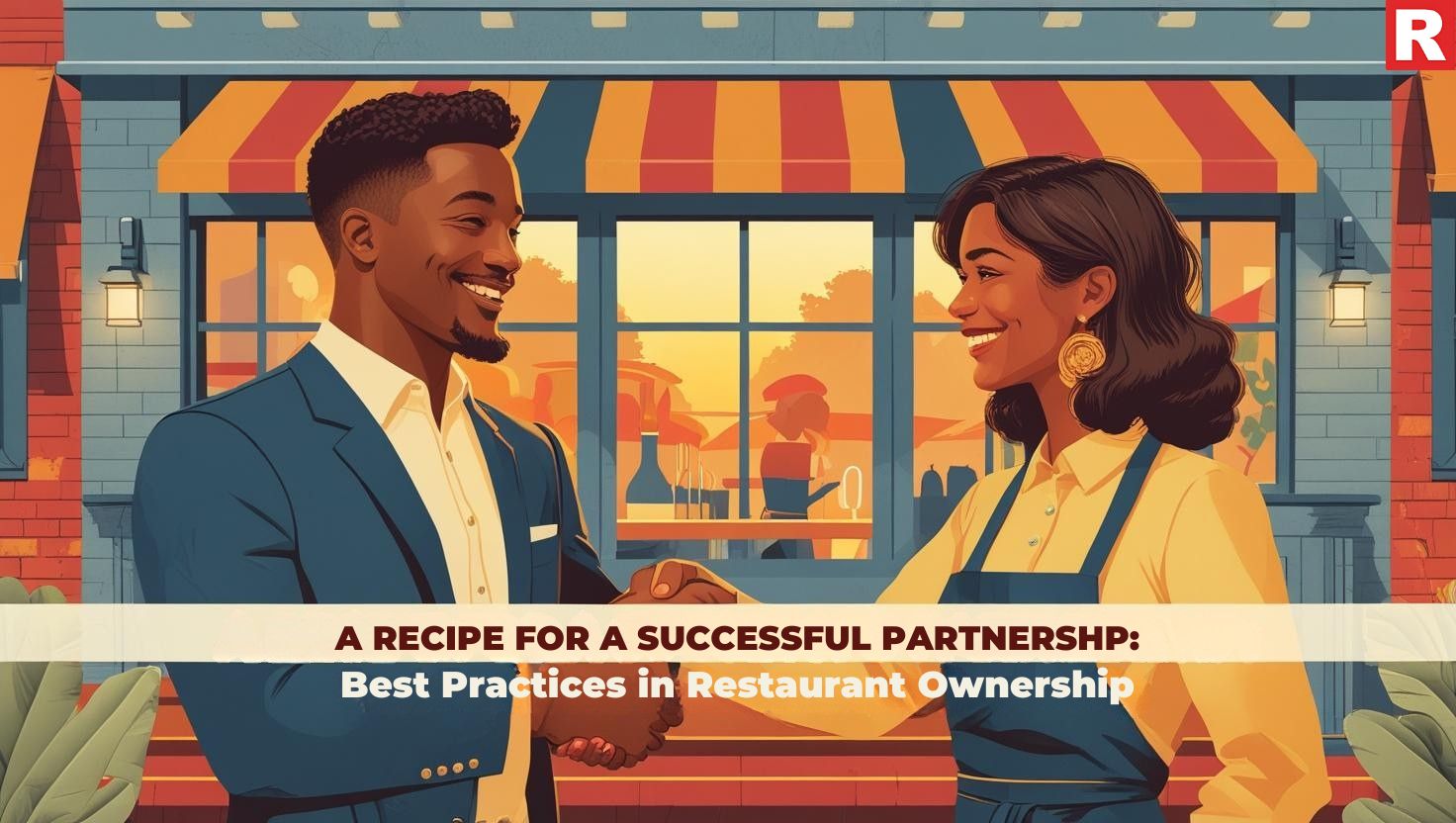
Use these important strategies to make sure your joint ownership business succeeds.
- Select the Correct Partner: Don't simply choose a friend or relative as your partner. Select a companion who shares your personality and skill set. Seek out someone who is dedicated to open and honest communication, has a strong work ethic, and shares your goal.
- Communicate, Communicate, Communicate: Frequent, well-organized meetings are crucial. Every week, set aside time to talk about finances, operations, and any problems that have come up. Before issues worsen and expand, deal with them directly.
- Clearly Define Roles: Make a thorough list of who is in charge of what right away. Write it down and consult it frequently. This keeps miscommunications at bay and guarantees that each partner has a feeling of direction and responsibility.
- Maintain Financial Transparency: Use an open and transparent accounting system to maintain financial transparency. Financial data should be fully accessible to both partners. Every significant financial choice should be addressed and decided upon by both parties.
- Hope for the Best, Prepare for the Worst: Talk about and record the outcomes of a "what if" scenario. What happens if one partner wishes to depart? What if there is a significant difference of opinion? Protecting the company and each partner's personal assets requires a well-thought-out exit strategy.
- Concentrate on the Common Goal: Recall the common goal and passion that united you when times were difficult. You can resolve conflicts and keep your restaurant on course by maintaining a shared focus on its long-term objectives and core values.
Conclusion
In the restaurant business, joint ownership is an effective strategy for success, but it takes more than simply a love of food. It requires a well-designed legal structure, open and honest communication, roles that are well-defined roles, and an up-front approach to problem-solving. You may build an excellent business that also serves as a testament to the power and endurance of a shared vision by selecting the proper partner, putting in place a strong legal foundation with a thorough partnership deed, and adhering to best practices. Aspiring restaurateurs throughout India may find that a fruitful collaboration is essential to transforming a common vision into a prosperous reality.

In the dynamic and challenging world of restaurants, the key to success is maintaining constant organization. The complex routine of food preparation, customer service, inventory control, cleaning, and administrative tasks makes up a restaurant's daily cycle. Even the most enthusiastic and talented culinary crew can fall into chaos in the absence of a strong system for managing these daily duties, which can result in mistakes, inefficiencies, and ultimately a lowered level of customer satisfaction and profitability.
This whole article is designed to provide you with a step-by-step guide to help manage daily restaurant tasks efficiently. We will take a look at the requirements and difficulties faced by restaurants, and to address these, we will investigate a range of approaches, from standard checklists to modern digital solutions. In addition to simplifying your everyday operations, putting in place an organized approach to task management will promote accountability, enhance teamwork, and create the groundwork for long-term success.
Read more: Your Guide to Influencer Marketing in Restaurants
The Importance of Tracking Daily Tasks
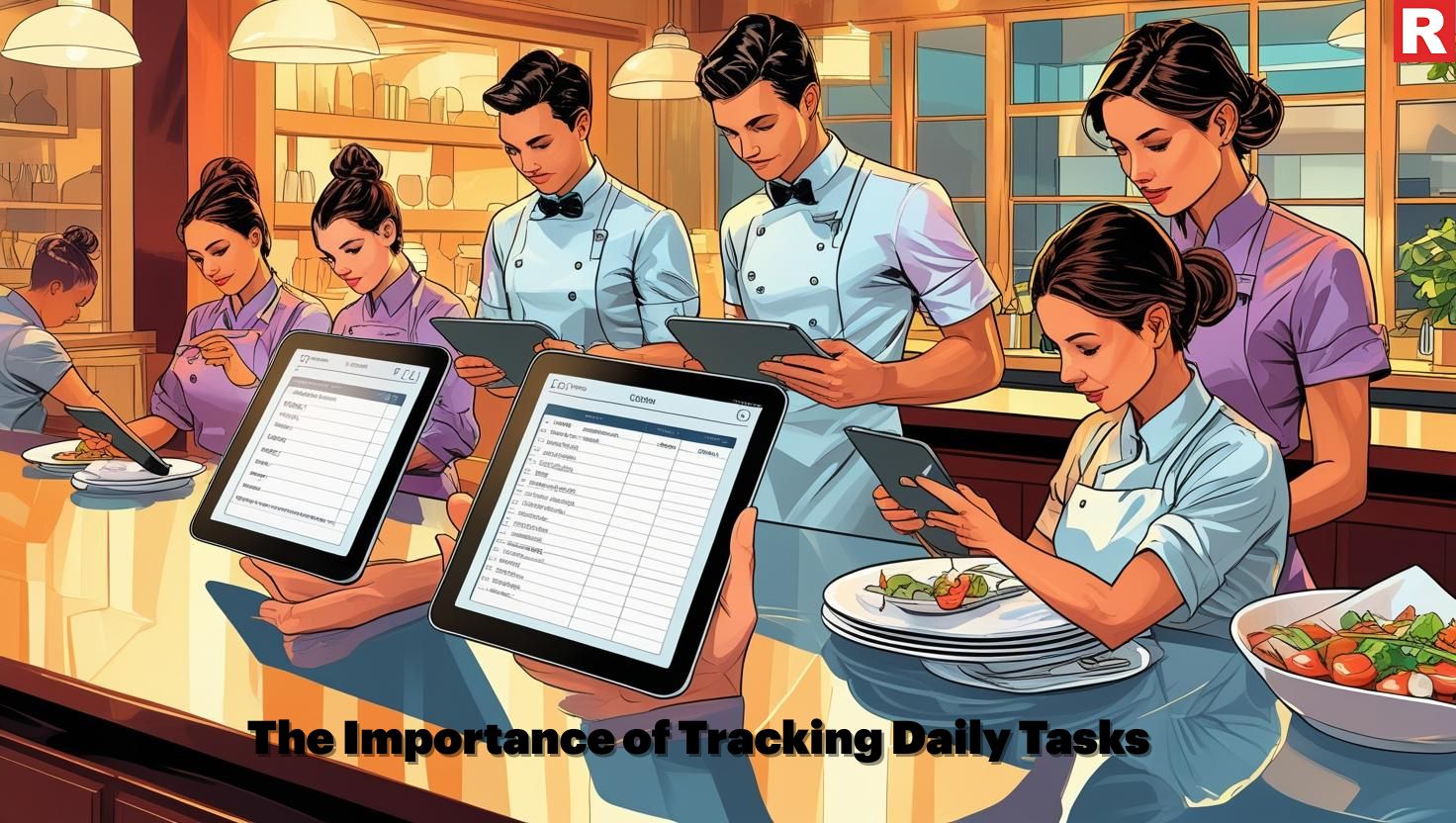
Before focusing on the "how," it is essential to fully understand the "why." Keeping meticulous records of regular restaurant tasks has several advantages:
- Increased Efficiency: Having a clear understanding of what must be done and when guarantees that tasks are finished on schedule and neatly, reducing obstacles and increasing output.
- Increased Consistency: Regular task lists make sure that important tasks are never missed, which results in consistently high standards for food quality, service, and hygiene.
- Enhanced Accountability: Staff members feel more accountable and take responsibility for their work when assignments are clearly assigned and have due dates.
- Better Communication: Tracking systems frequently facilitate communication across multiple teams and shifts, ensuring everyone is on the same page regarding accomplished work and continuing goals.
- Fewer Errors and Waste: You can limit errors, minimize food spoilage, and maximize resource usage by making sure that everyday duties like inventory checks and appropriate food storage are finished.
- Data-Driven Insights: Examining finished job logs on a regular basis can yield insightful information about operational challenges, areas for development, and your team's general effectiveness.
- Peace of Mind: In the cutthroat restaurant industry, a smoothly running business means less stress and the assurance that everyday tasks are being completed efficiently.
Check this: Marketing The Gen Z Way For Your Restaurant
Traditional Methods of Pen and Paper
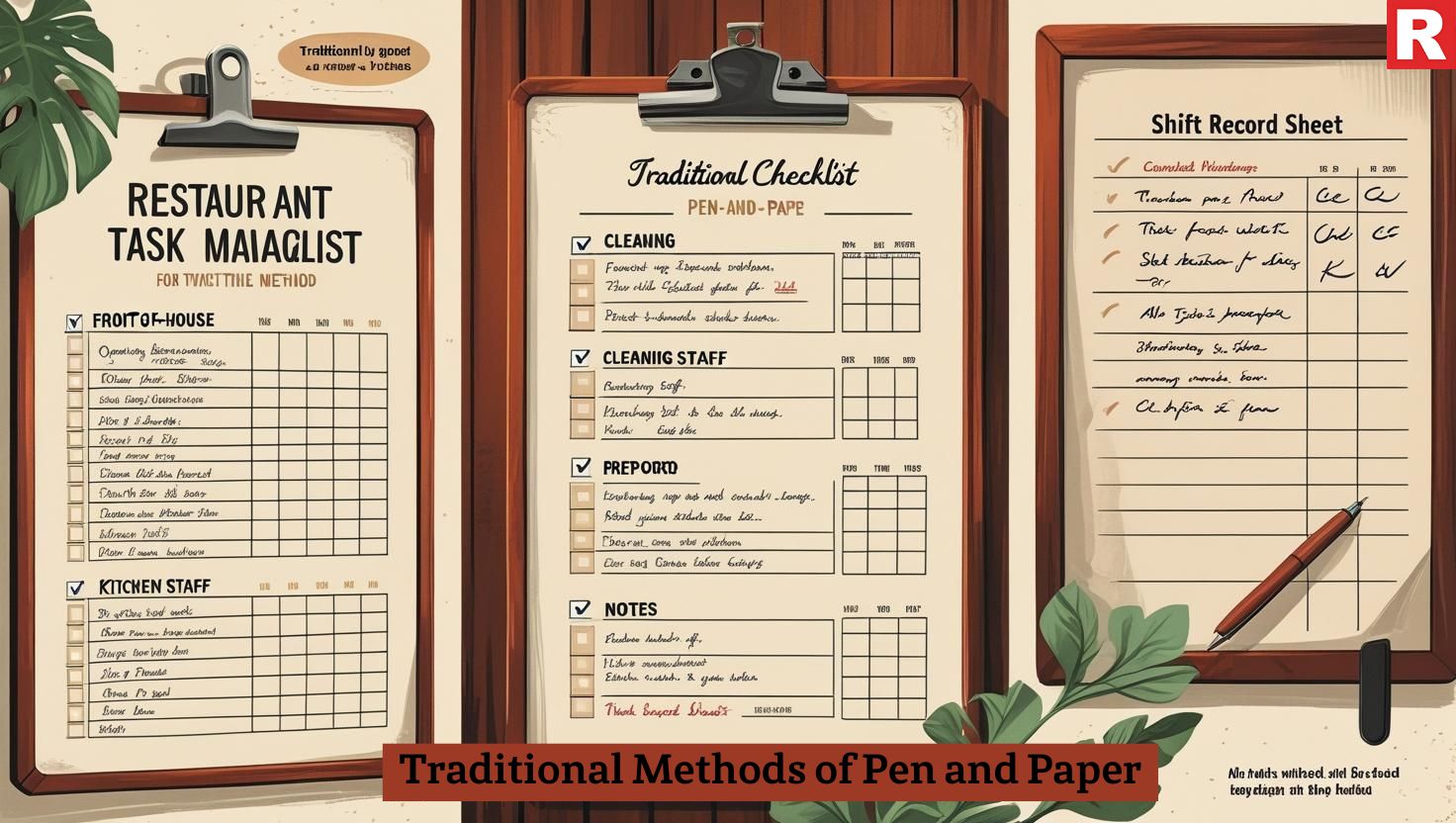
Traditional approaches are still useful for tracking daily restaurant tasks, especially for smaller or lesser-known businesses, even with the rise of digital alternatives.
Checklists: A straightforward, adaptable checklist is a very useful tool for keeping track of daily duties. Make separate checklists for the front of house (opening/closing tasks, table setup), cleaning personnel (floor sweeping, restroom checks), and the kitchen (prep work, cleaning). List every activity in detail, leaving room for a checkmark or initial when it is finished.
Whiteboards and Notice Boards: Visual task management tools can be created by carefully positioning whiteboards or notice boards in the staff areas and the kitchen. At the beginning of the day, team members can write down daily tasks and then mark them as finished or erased. This is a concise and convenient summary of the day's events.
Shift Records: Establish complete shift records in which employees mark finished work, problems they've encountered, and notes for the following shift. This guarantees a seamless transfer of duties and sustains continuous operation.
Best Practices for Traditional Methods:
- Don't Complicate: Create logs and checklists that are simple to use and comprehend. Stay clear of formats that are too complicated.
- Be Particular: Clearly outline every duty to prevent confusion. Use "wipe down all countertops," "sweep and mop the floor," etc., in place of "clean kitchen," for instance.
- Assign Responsibility: Clearly state on the whiteboard or checklist who is in charge of each task.
- Frequent Review: To make sure that activities are being finished completely and on schedule, managers should periodically review completed checklists and records.
Know more: Raising the Bar: How Restaurant Owners are Turning Trends into Triumphs
Digital Solutions for Efficiency
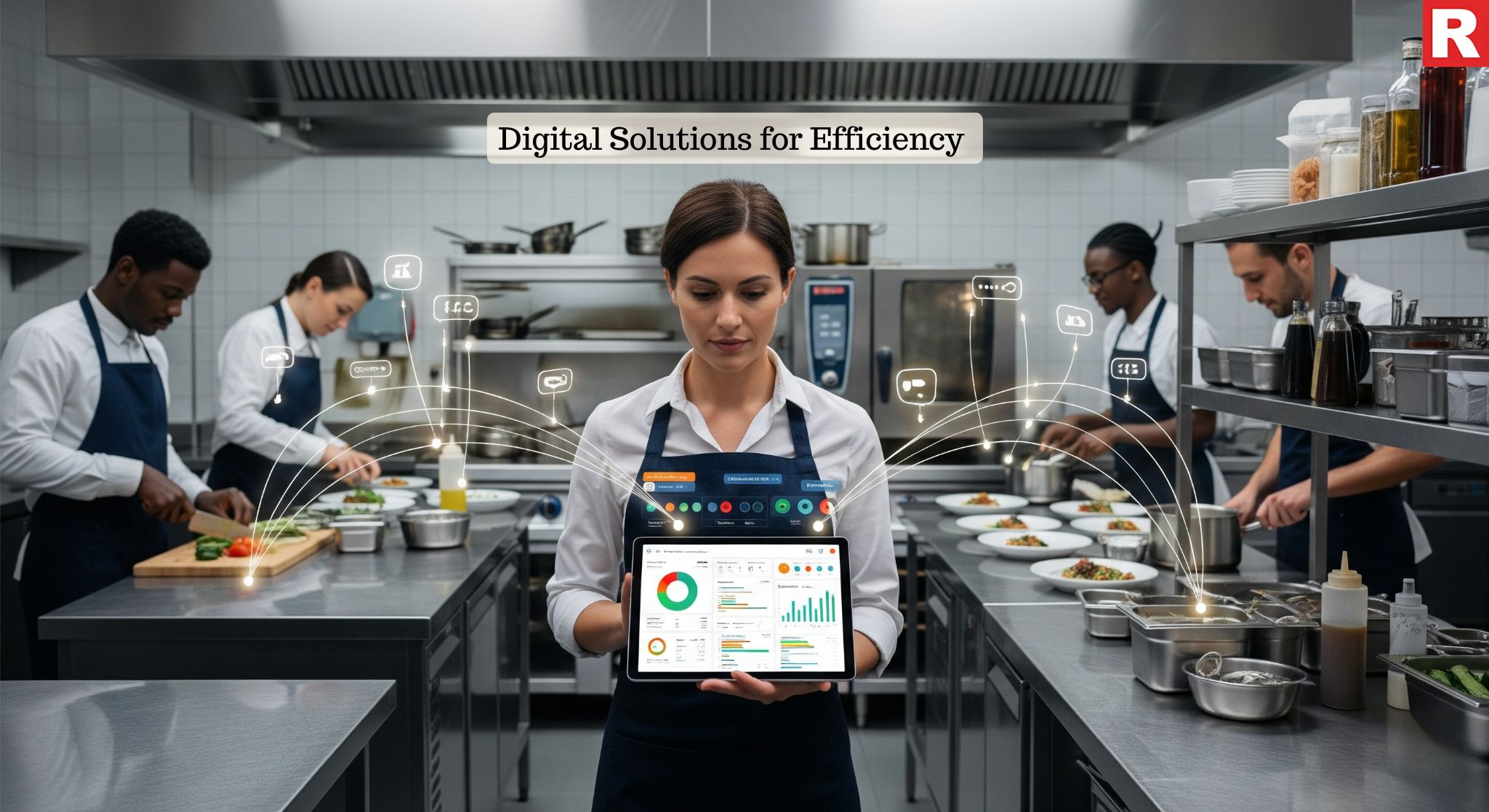
Digital task management systems for restaurants provide an efficient replacement or addition to traditional techniques for those seeking to improve efficiency and obtain more profound insights.
Restaurant Management Software: Task management functions are included in a lot of all-around restaurant management software packages. Creating recurring tasks, assigning them to particular teams or people, setting deadlines, monitoring progress in real time, and producing reports on task accomplishment are all frequently possible with these platforms.
Project Management Tools: Trello, Asana, and Monday.com are examples of general-purpose project management tools that may be tailored to monitor daily work at restaurants. For various sections of the restaurant, you can make boards or projects and assign tasks as cards with due dates and responsible parties.
Dedicated Task Management Apps: A variety of specialized task management applications, such as Google Tasks, Microsoft To Do, and Todoist, provide easy-to-use interfaces for making and keeping track of daily to-do lists. These applications frequently have task classification capabilities, collaboration tools, and reminders.
Digital Checklists and Forms: You may make digital checklists that are accessible on tablets and smartphones by using programs like Google Forms or specialized checklist applications. Checklists that have been completed can be automatically submitted and saved for later review.
Benefits of Digital Solutions:
- Real-time visibility: This allows managers to monitor the status of tasks at any time and from any location.
- Better Collaboration and Communication: Digital platforms frequently help team members communicate with one another about particular duties.
- Automated Notifications and Reminders: Employees can be reminded of impending assignments, which lowers the possibility that they will be neglected.
- Data Analysis and Reporting: Digital systems frequently offer useful information on task completion times, constant issues, and team productivity.
- Convenience and Accessibility: A variety of devices can be used to access and update tasks.
What's new: A Guide to Restaurant Management During Celebrations
Overcoming Common Challenges During Implementation
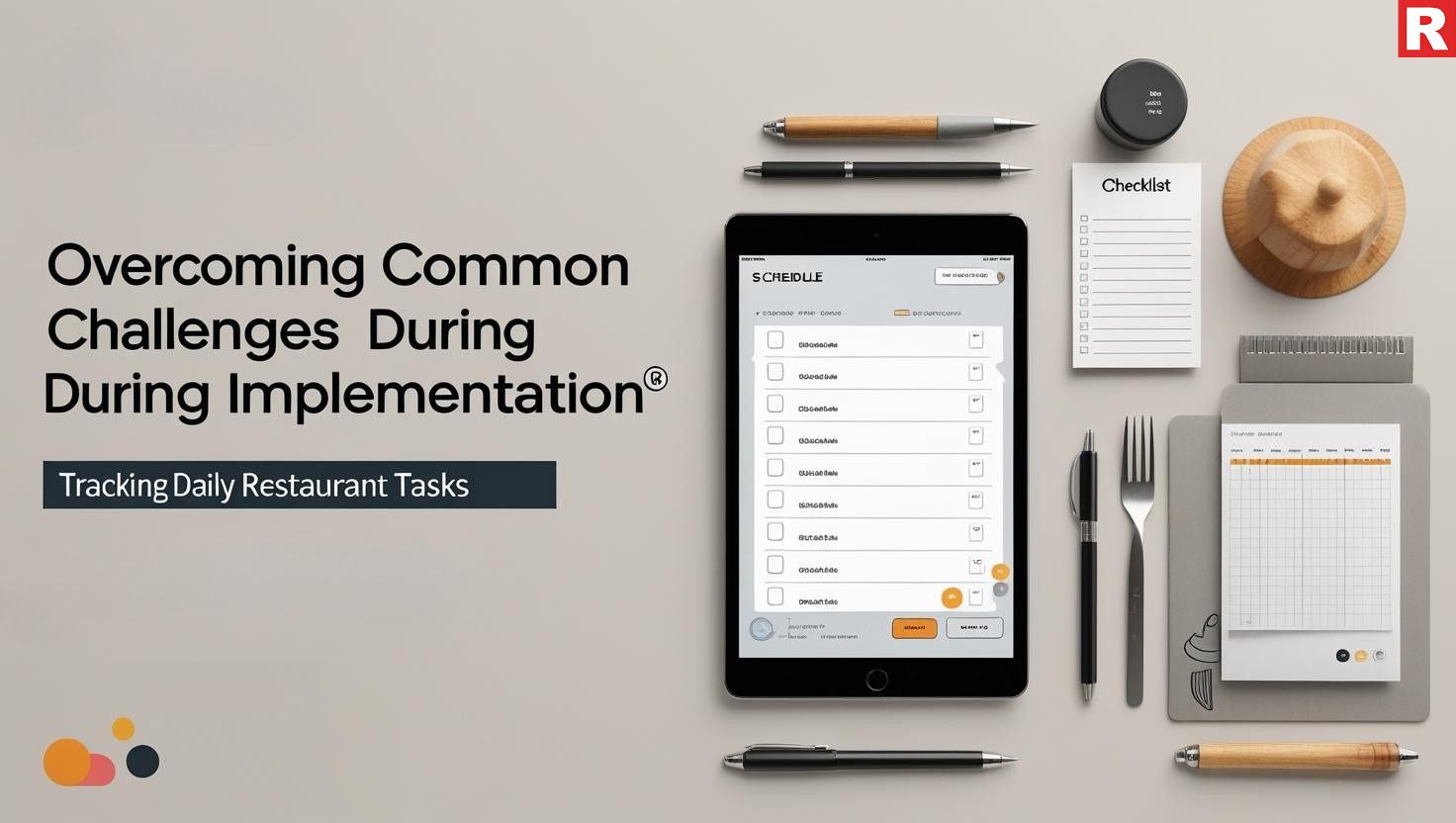
Even while keeping track of daily work has many advantages, putting a new system into place can be difficult at times. A successful shift depends on anticipating and planning for these challenges.
- Opposition to Change: Staff resistance is frequently the biggest obstacle. A new, enhanced tracking approach may be perceived by staff members used to an informal system as an unnecessary burden or an indication of mistrust. Communicate the "why" of the change clearly and consistently to combat this. Stress how the new system will simplify their work, lower stress levels, and increase productivity. To promote a sense of ownership, include your staff in the selection and design of the system.
- Initial Time Investment: During a hectic day, the time and effort required to implement a new system may seem like an extra burden. This covers staff training, template setup, and initial problem-solving. Be patient and set aside a certain time for this process. Reduced chaos and long-term efficiency will be the results of the short-term investment.
- Selecting the Incorrect Tool: Frustration and failure might result from choosing a system that is either too complicated, too simple, or doesn't meet the unique requirements of your restaurant. Investigate your options, consult with other restaurant managers, and think about implementing a new system in a small portion of your company before implementing it across the board.
- Lack of Accountability: The system will malfunction if duties are not given clearly or if no one is in charge of checking the completed records. To guarantee accountability, a clear chain of command and a designated individual to assess daily task accomplishment are essential.
Check out: How to Get A Government Loan for Your Restaurant Business
How to Grow Your Restaurant Into A Franchise
Tailoring Your System to Your Restaurant's Needs
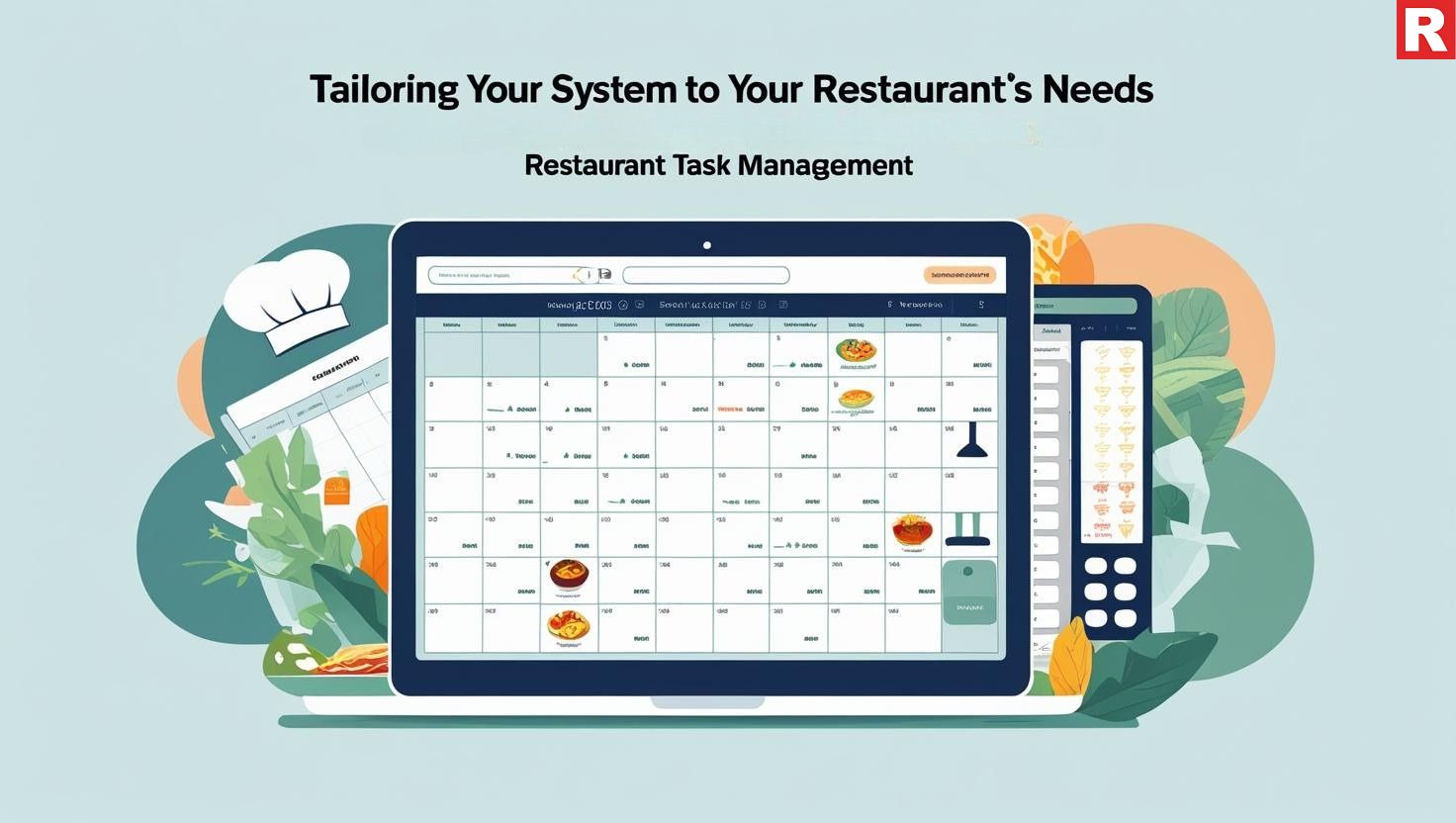
The size, design, and particular requirements of your restaurant will determine the most effective method for monitoring daily tasks.
- Small vs. Large Restaurants: While larger businesses with more intricate operations will probably benefit from the functionality and scalability of digital solutions, smaller restaurants may find that traditional checklists are enough.
- Restaurant Type: Digital checklists and automatic reminders may be given priority in a quick-service restaurant that handles a lot of repeated duties. To guarantee consistency in service and attention to detail, a fine-dining establishment may concentrate on keeping accurate shift logs.
- Team Size and Structure: When selecting a system, take into account the organizational hierarchy and the number of staff members. Digital tools are very useful for managing various departments and larger teams.
- Budget: While digital solutions may need upfront software purchases or subscription costs, traditional approaches are typically free. Assess your financial situation and select a method that best suits your requirements.
- Tech Skills of Your Team: When implementing digital solutions, take into account how comfortable your employees are with technology. To guarantee a seamless adoption, offer sufficient training and assistance.
Conclusion
Establishing a culture of teamwork, responsibility, and continual development in your restaurant is just as important as controlling processes when it comes to putting in place an efficient system for tracking daily tasks. You may improve client satisfaction, simplify processes, and eventually clear the path for long-term success in the cutthroat culinary industry by selecting the best strategies, outlining roles precisely, and regularly assessing results. The most important thing is to create a routine, empower your team, and incorporate task tracking into your everyday restaurant management procedures, regardless of whether you choose the ease of checklists or the strength of digital platforms.

The holiday season in India is a time of happiness, unity, and tremendous opportunity for the restaurant business. Celebrations are the essence of a busy restaurant, from Diwali to Christmas and New Year's, and from corporate parties to personal milestones like birthdays and anniversaries. This time is a test of elegance, efficiency, and preparation for restaurant managers. It's a high-stakes, high-reward setting where one mistake can ruin a hard-won reputation, while a well-executed plan can result in record-breaking earnings and a spike in customer loyalty. Understanding restaurant management during celebrations is not only advantageous but also essential in the cutthroat market of India, where customers have a wide range of options.
This detailed article will educate you on the key techniques for handling the stressful atmosphere of holiday seasons. We will explore important topics like marketing, operational excellence, menu design, staffing, and pre-planning to provide you with a clear road map for making sure your restaurant not only survives but also flourishes during these times of high demand and high volume.
Read this: 10 Ways the Restaurant Industry Impacted the Lifestyle of Indians
1. The Art of Pre-Planning: The Key to a Seamless Celebration

Effective planning is the key to a successful celebration. It starts weeks or even months beforehand.
- Project and Examine Historical Data: Begin by examining how well your restaurant has performed throughout previous holiday seasons or other periods of strong traffic. Examine sales information, foot traffic, popular menu items, and periods of high service demand. Your greatest advantage is this data, which tells you what to anticipate and where to concentrate your efforts.
- Establish Specific Financial Objectives: Determine both reasonable and challenging financial goals for the celebration based on your study. Establish your intended profit margin, typical customer expenditure, and target revenue. All of your future decisions will be based on these objectives.
- Establish a Master Calendar: Create an organized event calendar that includes all important dates, including public holidays and private gatherings that have been reserved in advance. For every activity, from scheduling employees to procuring supplies, assign roles and due dates. No detail will be missed thanks to this comprehensive plan.
- Examine and improve your relationships with suppliers: Make advance contact with your food, beverage, and other important providers. To prevent shortages at the last minute, make sure they are available over the holiday season and place large orders. Create a solid, dependable supply chain and bargain for lower pricing for greater quantities.
Know more: Street Food vs Fine Dining: What’s Trending in 2025
2. Strategic Staffing: Your Team is Your Greatest Asset

A great celebration is built on a foundation of a committed and well-prepared staff. Staffing decisions should be strategic rather than impulsive.
- Estimate Staffing Needs: Determine the precise number of employees required for each position, from kitchen workers to servers and hosts, based on your revenue forecasts and historical data. Take into account the requirement for extra assistance during busy times.
- Hire and Train Early: Avoid waiting until the last minute by hiring and training early. When hiring seasonal or temporary employees, start the hiring process well in advance. Put them through a demanding training program when they are employed. Before the first rush, they should be completely at ease with your restaurant's unique culture, POS system, menu, and service standards.
- Encourage and Empower Your Staff: Burnout can result from a high-pressure work atmosphere. Encourage a helpful and upbeat work environment. Provide incentives, including team-based awards, competitive hourly pay, and bonuses for hitting goals. A highly motivated workforce will go above and beyond to deliver exceptional service.
- Make an Adaptable Roster: Create a fair and adaptable work plan that accounts for worker availability and peak hours. To guarantee a smooth transition between service periods, schedule your shifts to be staggered. Short-term overstaffing is frequently better than understaffing and feeling overburdened.
What's new: Adoption of AI for Personalized Customer Experience In Restaurants
3. Menu Design and Operational Excellence

Efficiency is just as crucial as quality during a celebration. To manage large quantities without sacrificing the customer experience, a clever menu and efficient operations are crucial.
- Simplify Your Menu: A compact, high-efficiency menu is frequently the best approach for a busy holiday season, even when a wide variety may seem alluring. Concentrate on a carefully selected collection of your best-selling, easiest-to-make, and most popular foods. This guarantees quicker service, lowers food waste, and simplifies the kitchen.
- Provide Special Set Menus: For celebrations, provide à la carte or special set menus. This can be a customized festive menu with fewer options or a set-price menu for private gatherings. In addition to making ordering easier for the kitchen and the consumer, this method can improve inventory forecasting and management.
- Optimize Your Kitchen Prep and Layout: Set up your kitchen to be as functional as possible. Provide specific preparation areas and ensure that all supplies and materials are within easy reach. So that the kitchen crew just needs to handle final assembly and cooking, do as much prep work as you can ahead of time, such as chopping vegetables, making sauces, or marinating meats.
- Leverage Technology: Make an investment in a reliable Point of Sale (POS) system that can precisely handle large order volumes. To handle takeout and delivery without interfering with internal processes, think about utilizing online ordering platforms and digital reservation platforms.
4. Marketing and Promotions

A carefully considered marketing plan is essential, as many restaurants are competing for the festive customers.
- Targeted and Early Promotions: Start advertising your holiday products weeks in advance. Announce special menus, event reservations, and celebration discounts via social media, email newsletters, and local advertising. Make sure your promotions are tailored to the particular event.
- Leverage Social Media: Make the most of social media by producing eye-catching content for sites like Facebook and Instagram. To create excitement and buzz, post beautiful pictures of your special cuisine, display your holiday décor, and hold interesting competitions or giveaways.
- Form Alliances: To promote your services for private parties and corporate events, team up with nearby companies, corporate headquarters, or event coordinators. Offer exclusive deals or packages to persuade people to reserve their parties with you.
- Optimize Your Online Presence: Make sure your website and online directories (like Google Maps and Zomato) are updated with your special menus, reservation information, and festive hours. A customer's journey frequently begins with a flawless online experience.
Check out: The Secret Sauce to Building Tomorrow’s Restaurant: Lessons from the Pathbreakers
How to Reduce Food Wastage in Your Restaurant
5. Managing the Guest Experience: Beyond the Food

Customers are paying for an experience rather than just a meal at a celebration event.
- Establish a Welcome Ambience: Use festive décor to create a welcoming atmosphere in your restaurant. Create a cozy and welcoming ambiance with seasonal décor, music, and lighting to give customers a sense of belonging in the festivities.
- Control Expectations: Be open and honest with customers regarding wait times, particularly during busy times. Frustration can be avoided by taking a proactive approach to managing expectations, such as providing an expected wait time and texting when a table is ready.
- Go Above and Beyond: Teach your employees to add unique touches that will make the event unforgettable. A free cake for a birthday celebration or a modest, joyful memento for each visitor could be examples of this. These modest actions can leave a favorable impression that lasts.
- Collect Feedback: After the festivities are done, get your consumers' opinions. A quick survey or a straightforward request for a review on your social media platforms can be used for this. You can improve your operations and management for the upcoming festivities with the help of this feedback.
Read this: How to Find Good Staff for Your Restaurant
6. Post-Celebration Analysis: Learning for the Future

The work continues even if the festivities end. For long-term progress, an in-depth examination is necessary.
- Examine your finances: Examine your current profit margins and sales against your original targets. Examine the best-selling menu items, the most successful promotions, and the areas where you overspent and underspent. This will give you an idea of where to improve in the next festive season.
- Organize Staff Debriefs: Call a team gathering to talk about what worked and what needs improvement. This fosters a culture of continuous development and allows your team to share their firsthand observations. As the staff have firsthandly performed the operations and interacted with the customers, their opinion is most relevant.
- Respond to Consumer Input: Go over all of the comments you got, both good and bad. Determine common trends and utilize this data to implement concrete adjustments to your business processes or products.
Conclusion
Managing a restaurant well during festivities is a challenging but very rewarding task. It involves careful preparation, strategic hiring, effective operations, and a strong dedication to delivering a first-rate visitor experience. A restaurant that can execute its plan successfully will not only earn short-term advantages but also establish a loyal customer base that will return year after year with their families, friends, and coworkers searching for the ideal spot to celebrate. Even after the celebrations are over, your restaurant will be hosting customers paying repetitive visits as they are impressed with your restaurant. A time of intense pressure can be transformed into a season of unparalleled success if you approach each celebration as a special chance to highlight your business.

In today’s world, restaurant dinners have become not only a place to enjoy food, but also an unforgettable experience. Providing your customers with a personalised experience is a sure way to guarantee success in today’s culinary industry. Today's consumers want a dining experience that feels customized to their own likes, preferences, and habits. They are no longer content with a one-size-fits-all approach. This is the point at which artificial intelligence (AI) is becoming a game-changer and steps into the restaurant industry from the world of science fiction.
From the time a consumer considers making a reservation to their post-meal comments, artificial intelligence (AI) in all of its forms seamlessly incorporates itself into every aspect of the dining experience. AI can predict trends, comprehend personal preferences, and simplify tasks by analyzing large volumes of data. This frees up restaurant employees to concentrate on what they do best: providing authentic, human-centric hospitality.
This thorough guide will examine the significant effects of AI on customizing the dining experience, highlighting particular uses and proving that AI is more than a passing trend but rather a calculated tactic for promoting durable customer loyalty and pushing company expansion.
Read more: Pouring Culture, Craft, and Commerce in a Cup
1. AI-Powered Discovery and Recommendations
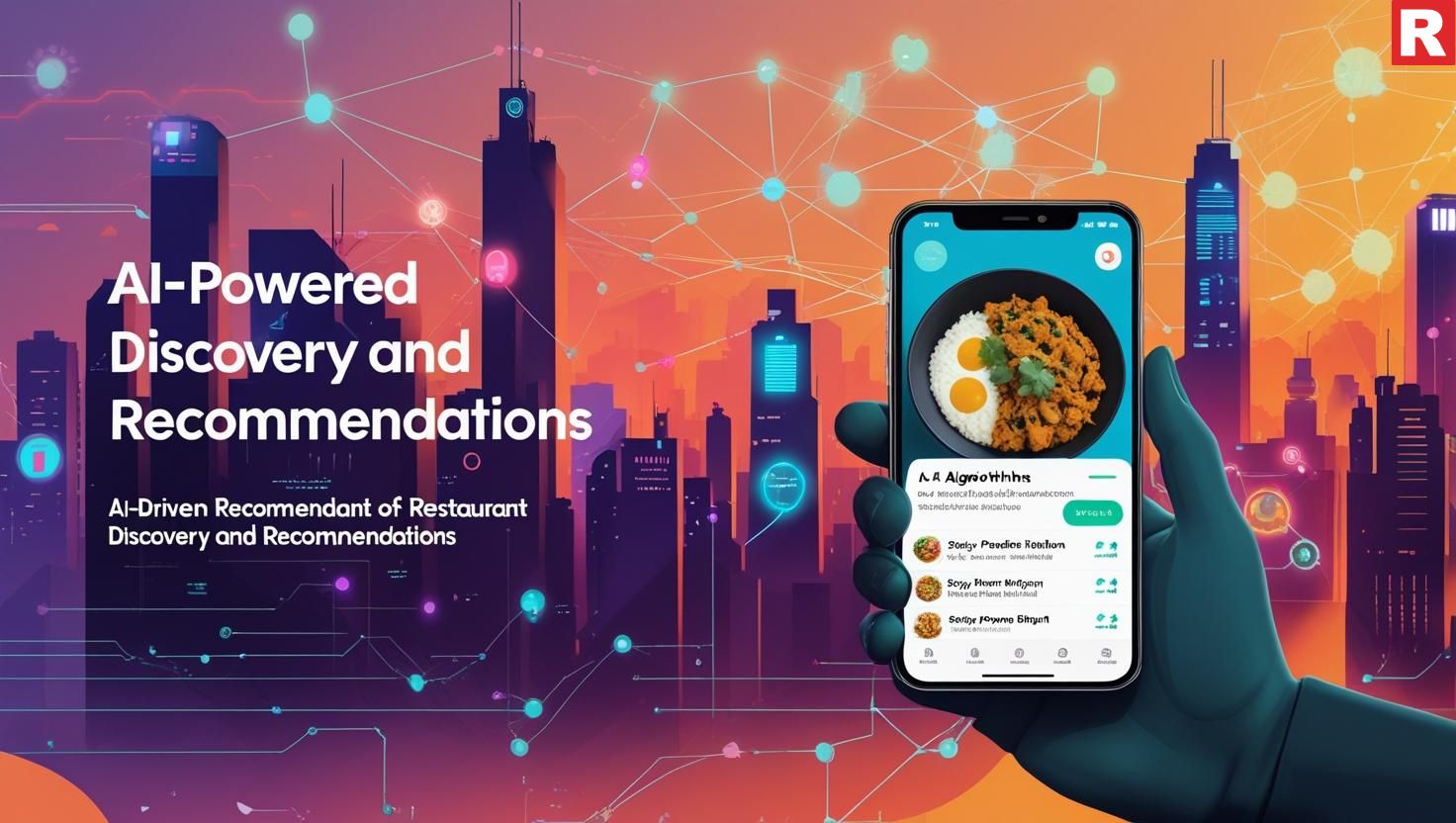
Long before the customer enters the store, the customized experience starts. AI is already in use, guiding prospective customers to your restaurant and luring them in with personalized suggestions.
- Ad Targeting and Predictive Search: AI-powered algorithms examine a user's location, social media activity, and previous search history to present them with highly relevant restaurant advertisements. When a customer searches for "vegan restaurants in the city," for instance, AI can make sure your advertisement for a new plant-based menu item shows up high in their feed.
- AI-Powered Reservation Systems: To help restaurants reach their full potential, advanced reservation platforms employ AI to handle reservations, optimize seating arrangements, and even anticipate cancellations. Based on a customer's previous behavior, many systems can even recommend the best times to eat.
- Personalized App and Website Experiences: AI examines user browsing patterns on your app or website to recommend menu items, special offers, or even table positions based on user preferences. The "Spicy Paneer Biryani" may be highlighted on their webpage for a regular customer who always gets it, coupled with a suggestion for a new, comparable dish.
2. The On-Premise Experience: From AI to A-Plus Hospitality
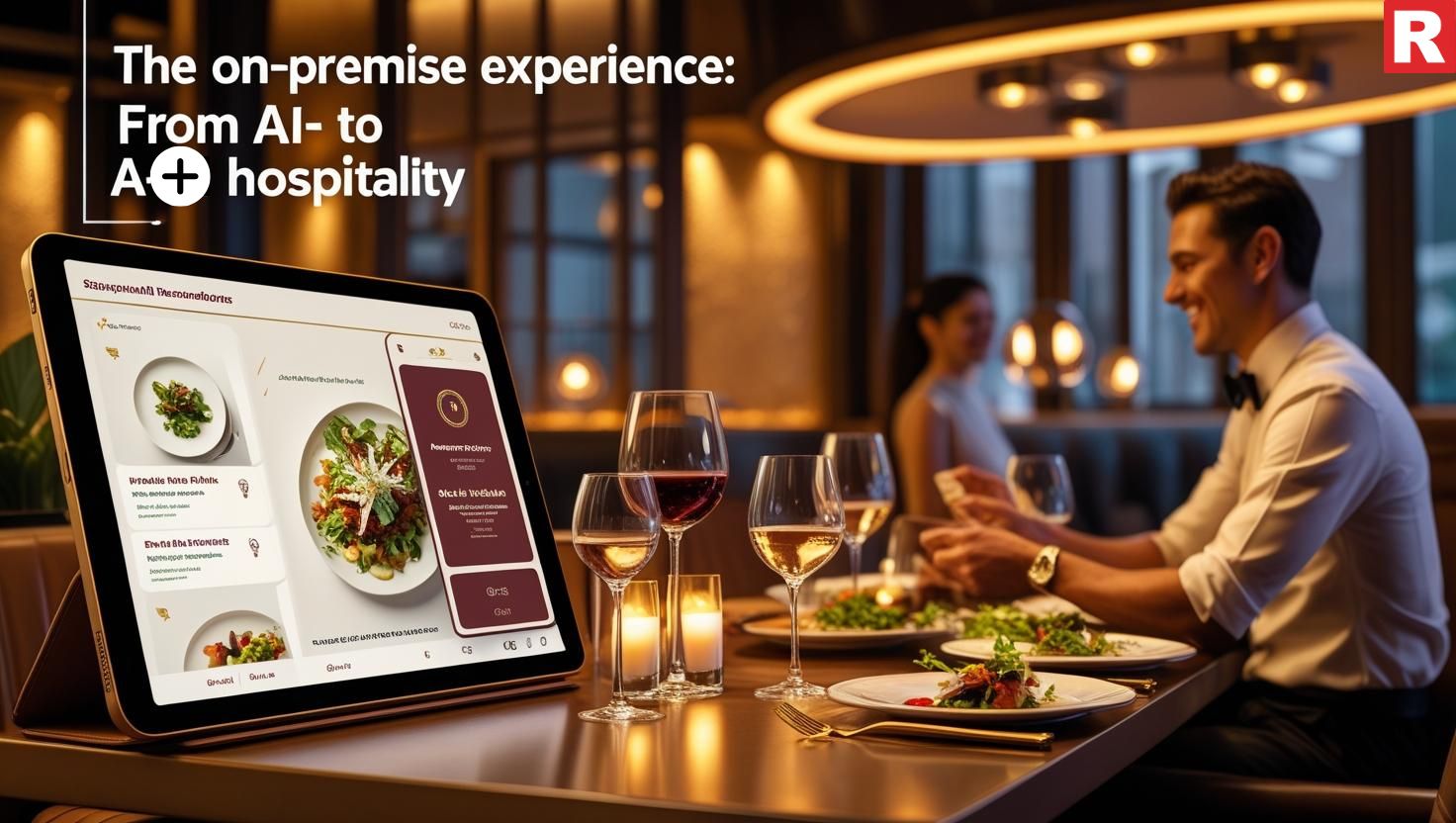
Once a customer arrives at your restaurant, AI improves their dining experience both in the background and in plain view.
- Intelligent Digital Menus: AI can be used to offer personalized recommendations through interactive digital menus on tablets or QR code connections. They can recommend a wine pairing, a new appetizer that a customer would enjoy, or even a dessert that they haven't tasted based on their past orders. This is a subtle yet effective upselling strategy that comes across as supportive rather than aggressive.
- AI-Powered Chatbots and Order Taking: Chatbots that are incorporated into your website or app can answer frequently asked client questions, such as whether a meal contains allergens or how long wait times are. AI-powered screens at certain restaurants let customers place orders, get tailored suggestions, and even pay, enabling up employees to work on more difficult jobs and provide direct customer service.
- Facial Recognition for a Customized Welcome: Although this technology is still in its early stages and raises privacy issues, several restaurants are using facial recognition software to recognize repeat customers. To create a genuinely unique, high-touch experience, a system may notify a host when a returning guest arrives, enabling them to welcome them by name and possibly offer their typical table or drink.
Know more: Street Food vs Fine Dining: What’s Trending in 2025
3. The Back-End Operations: Aiding Staff for Better Service
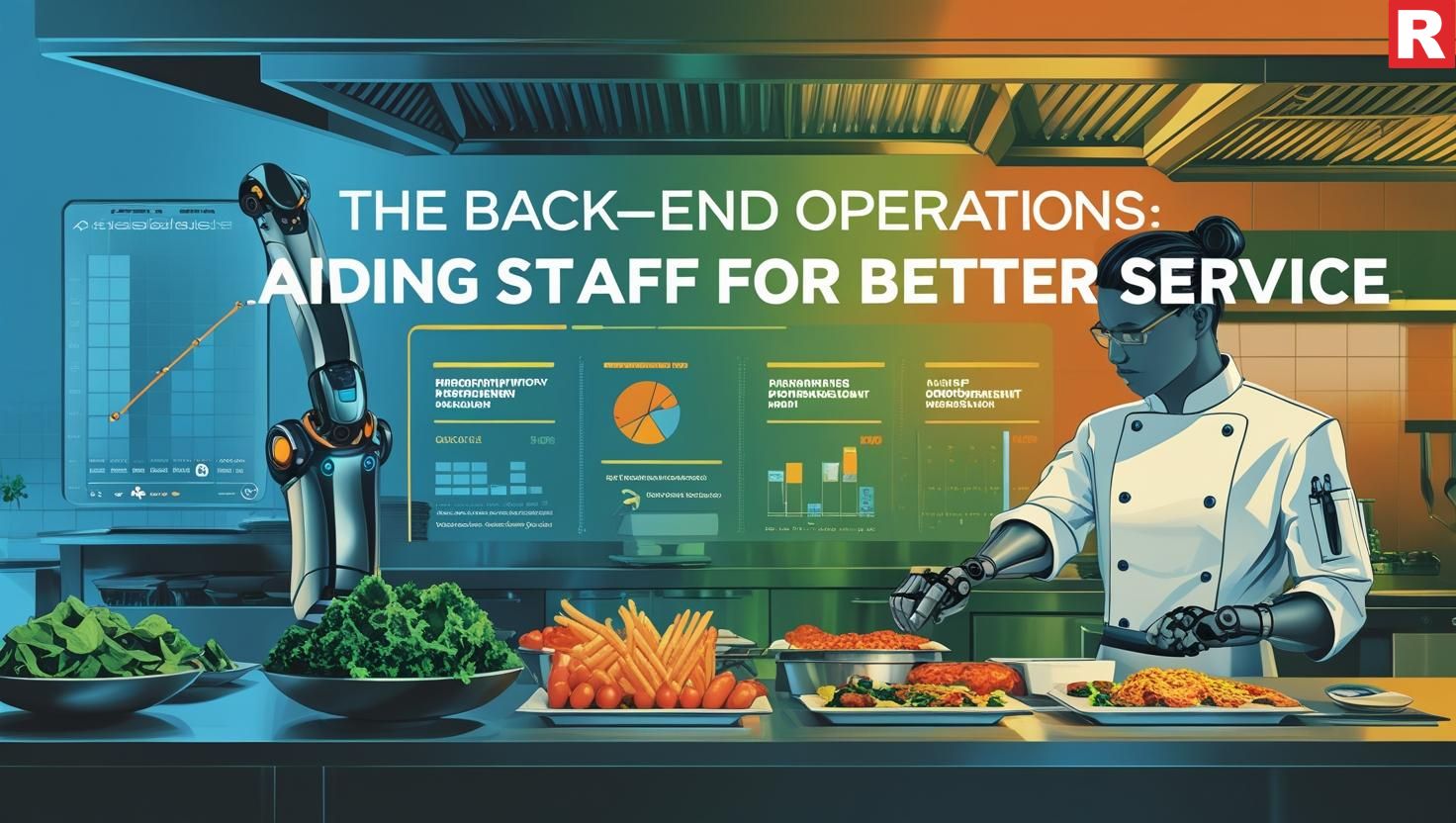
AI isn't just for customers; its most effective uses frequently take place in the background, enabling your employees to provide exceptional customer service.
- Predictive Inventory Management: AI predicts which ingredients will be in high demand by analyzing sales data. By doing this, kitchen employees may order more efficiently, wasting less food and guaranteeing that popular menu items are always available. By avoiding the disappointment of a sold-out dish, this convenience has a direct impact on consumer happiness.
- Automated Kitchen Assistants: These devices assist chefs and cooks in maintaining consistency and speed, ranging from robotic arms that can assist with monotonous activities like flipping burgers to AI-powered ovens that precisely time and temperature-control a dish. A great client experience is built on this uniformity.
- Staff Scheduling and Training: AI can improve staff scheduling by predicting customer foot traffic, which will guarantee that you are never overstaffed or understaffed during peak hours. Additionally, AI-powered training modules can offer new workers tailored guidance, accelerating and improving their understanding of the menu and service standards.
What's new: 10 Ways the Restaurant Industry Impacted the Lifestyle of Indians
4. The Post-Dining Experience: Maintaining the Connection
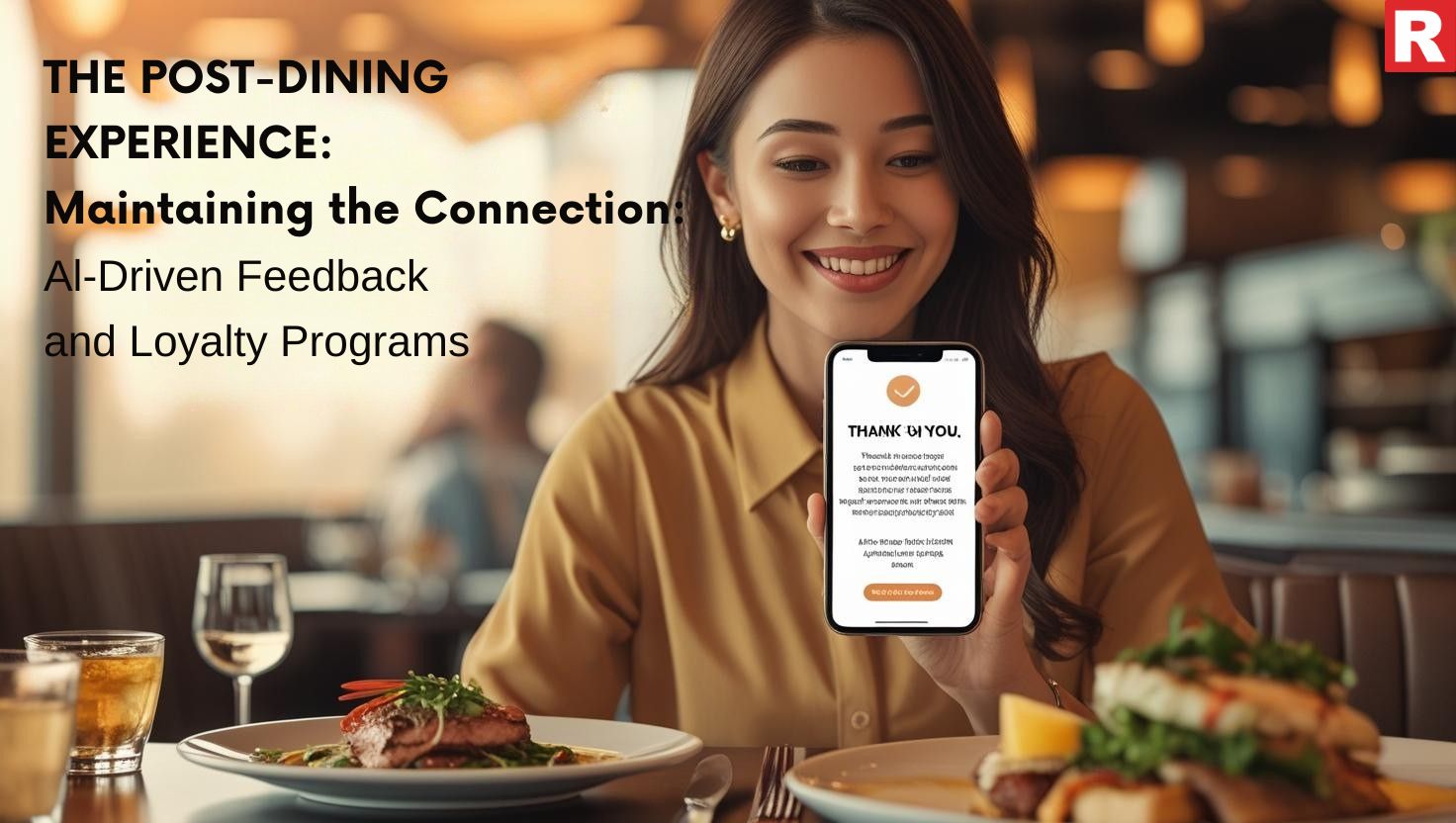
When a consumer leaves your restaurant, the personalized experience continues. AI promotes repeat business by preserving and enhancing the relationship.
- Automated and Customized Feedback Systems: After a customer's visit, AI can send them automated but customized thank-you notes or feedback requests. The contact will feel more meaningful if the messages are customized according to what they ordered or who served them.
- Data-Driven Loyalty Programs: AI generates highly customized rewards by analyzing consumer data from your loyalty program and point of sale system. A customer who often orders coffee might be offered a free latte instead of the typical "buy 10, get one free," while a customer who likes desserts would be given a discount on a new sweet dish. As a result, the incentives seem more worthwhile and significant.
- AI-Driven Customer Service: Systems with AI capabilities are able to examine consumer input to find recurring problems and patterns. In the end, this results in a better experience for potential customers by enabling management to promptly resolve issues, enhance service, and even teach staff on areas that require development.
Check out: How to Reduce Food Wastage in Your Restaurant
Nothing Before Coffee Hits Century, Opens 100th Outlet in Vadodara
Overcoming Implementation Challenges and Ensuring ROI in the Restaurant Scene

Even while AI has enormous promise to provide individualized client experiences, restaurants may have particular difficulties when putting it into practice. These include securing the dependability of internet infrastructure, which is essential for many AI applications, the initial investment cost, and the requirement for employee training to use new AI-powered tools efficiently. Additionally, it might be challenging to integrate new AI systems with pre-existing CRM and Point of Sale (POS) systems. Restaurants should do the following to get beyond these obstacles and guarantee a high Return on Investment (ROI):
- Start with Specific Use Cases: Rather than attempting to apply AI to every aspect of the business at once, pinpoint the main areas where customization may make the biggest difference, such as loyalty programs or online ordering recommendations. This makes it easier to measure the benefits.
- Give User-Friendly Systems Priority: Select AI platforms with user-friendly interfaces that require less technical know-how from your employees. In-depth instruction and continuous vendor support are also crucial.
- Pay Attention to Data Implementation: Verify that the AI solutions you have selected can be easily integrated with your current technological setup. Working with suppliers who have experience connecting with well-known POS systems may be necessary for this.
- Key Performance Indicators (KPIs) should be measured: Monitor data like recurring business, customer satisfaction ratings, conversion rates from targeted advertisements, and consumer interaction with tailored recommendations. You can use this information to evaluate the return on your AI efforts and make the required corrections.
- Seek Local Support and Expertise: Collaborate with technology suppliers or consultants who are familiar with the unique opportunities and difficulties facing the area's restaurant sector. Throughout the implementation phase, they can offer customized guidance and assistance.
Read this: How to Find Good Staff for Your Restaurant
The Evolving Role of Human Connection in an AI-Enhanced Restaurant
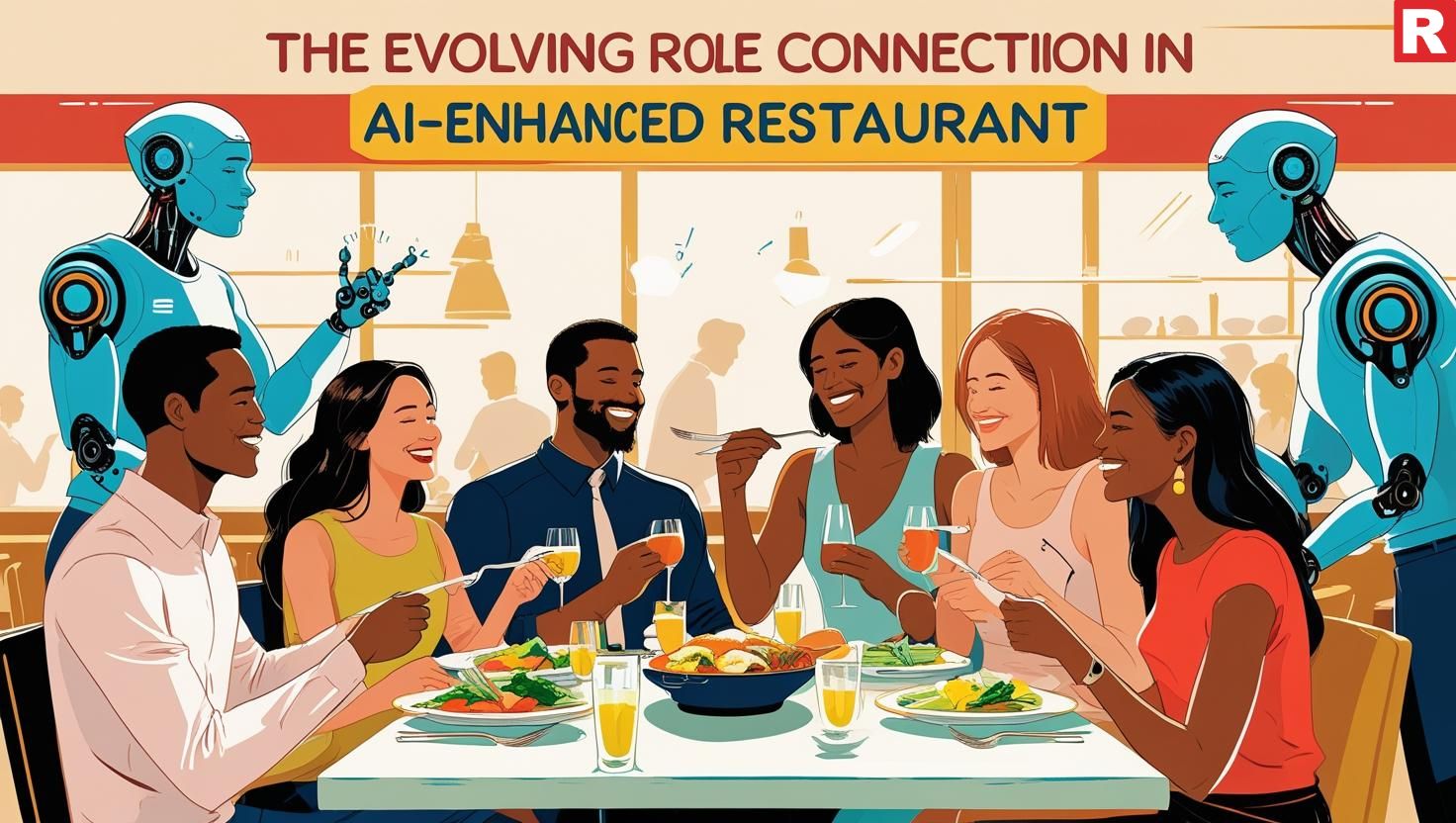
The human aspect is still essential to producing a genuinely remarkable dining experience, even with the growing incorporation of AI. By relieving employees of repetitive duties, AI can actually improve human connection by enabling them to concentrate on developing relationships with customers. Restaurants ought to concentrate on:
- Giving Staff AI Insights: Teach your hosts and servers to use the information AI provides to customize their interactions. For instance, a waitress can make more intelligent recommendations and have a more customized conversation if they are aware of a customer's previous orders.
- Maintaining Genuine Interaction: Remind employees that AI is a tool to help them, not to replace them, to preserve genuine interaction. Encourage them to treat each visitor with warmth, friendliness, and genuineness. Information can be provided by AI, but empathy and real concern cannot be replicated.
- Managing Exceptions and Special Demands: While AI is capable of managing a large number of routine encounters, human staff members are essential for dealing with particular circumstances, efficiently managing complaints, and satisfying specific client demands. What distinguishes a restaurant is its capacity to go above and beyond.
A Collaboration Between Humans and AI
The restaurant industry's adoption of AI is not about substituting computer efficiency for human interaction. Rather, the goal is to establish a strong human-AI collaboration. AI takes care of the data, the forecasts, and the monotonous work, allowing your front desk staff to focus on being more involved, attentive, and truly welcoming. It enables them to remember a customer's preferences, anticipate their wants, and deliver a level of service that was previously unattainable.
Using AI is a smart way for a restaurant to differentiate itself in a crowded market. It enables you to establish a reputation for offering a distinctive, smooth, and highly customized dining experience that converts first-time guests into devoted, repeat customers, in addition to having excellent food.

For many generations, the traditional recipes and fragrant spices that were passed down through family kitchens dominated India's cooking scene. Meals were made with care and shared in the cozy embrace of home as part of their daily life. Eating out was a rare occurrence, usually associated with celebrations, vacations, or pilgrimages. But the growing restaurant industry, from the modest roadside dhabas that line the highways to the upscale cafes and fine-dining restaurants that thrive in the city's center, has brought about a significant change in how Indians eat, interact with one another, and even view their own culture.
This article looks into the multiple ways the restaurant sector has permanently impacted the lifestyle of Indians, with a particular emphasis on the shifting dynamics witnessed in metropolitan locations, but also reflecting broader national patterns.
Read more: Street Food vs Fine Dining: What’s Trending in 2025
1. Redefining the Social Norm: Eating Out as a Lifestyle
The transformation of dining from a largely family affair to a major social activity is arguably the most significant effect of the restaurant sector. Restaurants are becoming the standard location for a wide range of social interactions in Indian cities:
- Family Get-Togethers and Festivities: Forget about the laborious chore of preparing lavish dinners at home. Families celebrating birthdays, anniversaries, and promotions increasingly fill restaurants. A hassle-free approach to remembering memorable occasions is provided by the celebration atmosphere, varied menus that cater to a wide range of tastes, and convenience. A new custom of family connection outside the home has been formed as a result.
- Business & Professional Networking: In developing business areas, restaurants are serving as unofficial corporate settings. Strategic dinners and business lunches at reputable restaurants have become essential for business networking, closing deals, and building relationships in a laid-back yet elegant environment.
- Courtship and Dating: The romantic scene has also changed dramatically. Dining out has been a staple of contemporary Indian romance in major cities, offering a neutral and stimulating venue for developing relationships. This includes stylish restaurants that set the tone for deeper connections as well as quiet cafés ideal for first dates.
- Friendship and Recreation: For many Indians, socializing with friends over coffee at a café or having a laid-back dinner at a family restaurant has become a regular part of life. Restaurants provide a fun and practical setting for relaxing, interacting, and making memories.
2. Expanding Palate and Global Awareness
Regional and global barriers have been broken down by the restaurant sector, which has served as a potent catalyst for culinary research and the introduction of new cuisines to the Indian palate:
- Investigating Regional Indian Cuisines: Locals can now travel around India's culinary landscape without ever leaving the city. A deeper understanding of India's diverse culinary heritage is fostered by dining at restaurants that specialize in South Indian dosas, Punjabi butter chicken, Gujarati thalis, and Bengali sweets.
- The Allure of Global Cuisine: The Restaurant industry reflects how Indian tastes are becoming more and more international. Restaurants are offering American burgers, Chinese noodles, Italian pasta, and even more exotic dishes like Thai, Mexican, and Japanese. International cuisines are now more approachable and recognizable due to this exposure, which has also expanded culinary boundaries.
- The Rise of Fusion and Innovation: Fusion cuisine is an exciting trend that is the result of the interaction of local customs and international influences. In order to appeal to a more daring and urban audience, restaurants are increasingly experimenting with creative combinations, fusing Indian ingredients and techniques with international trends.
Know more: The Secret Sauce to Building Tomorrow’s Restaurant: Lessons from the Pathbreakers
3. The Convenience Culture: Adapting to Modern Lifestyles

The restaurant business has grown to be an essential component of the economy in a fast-paced metropolitan setting, where time is of the essence:
- Catering to Busy Professionals: Making complex meals at home every day can be difficult due to the rising number of dual-income households and hectic work schedules. For daily meals, restaurants and the rapidly expanding food delivery services provide a quick and easy option.
- The On-Demand Cuisine Ecosystem: The way people receive restaurant food has been completely transformed by food delivery applications. With only a few smartphone touches, one can now order a wide range of cuisines, revolutionizing dining patterns and enabling people to enjoy restaurant-caliber meals in the convenience of their own homes, workplaces, or other locations.
- Different Price Points: The Restaurant industry offers a wide range of prices, from mid-range restaurants and high-end fine-dining establishments to inexpensive street food vendors and family-friendly restaurants, guaranteeing that convenience and culinary diversity are within the reach of a large segment of the population.
4. Shifting Social Norms and Etiquette
In Indian society, the growing popularity of eating out has also gradually changed cultural customs and manners:
- Dress Codes and Occasions: Going to select restaurants frequently requires following a dress code, which influences wardrobe choices and changes eating out into a sense of occasion.
- Table manners and dining customs: Although eating with one's hands is a common part of traditional Indian dining, exposure to a variety of cuisines and restaurant formats has made the use of cutlery more common, resulting in a mix of dining customs depending on the situation.
- Public Conduct and Conversation: Compared to private meals at home, dining in a public setting such as a restaurant frequently involves different conversational dynamics, with discussions frequently focusing on the cuisine, atmosphere, and overall surroundings.
5. Economic Empowerment and Entrepreneurship
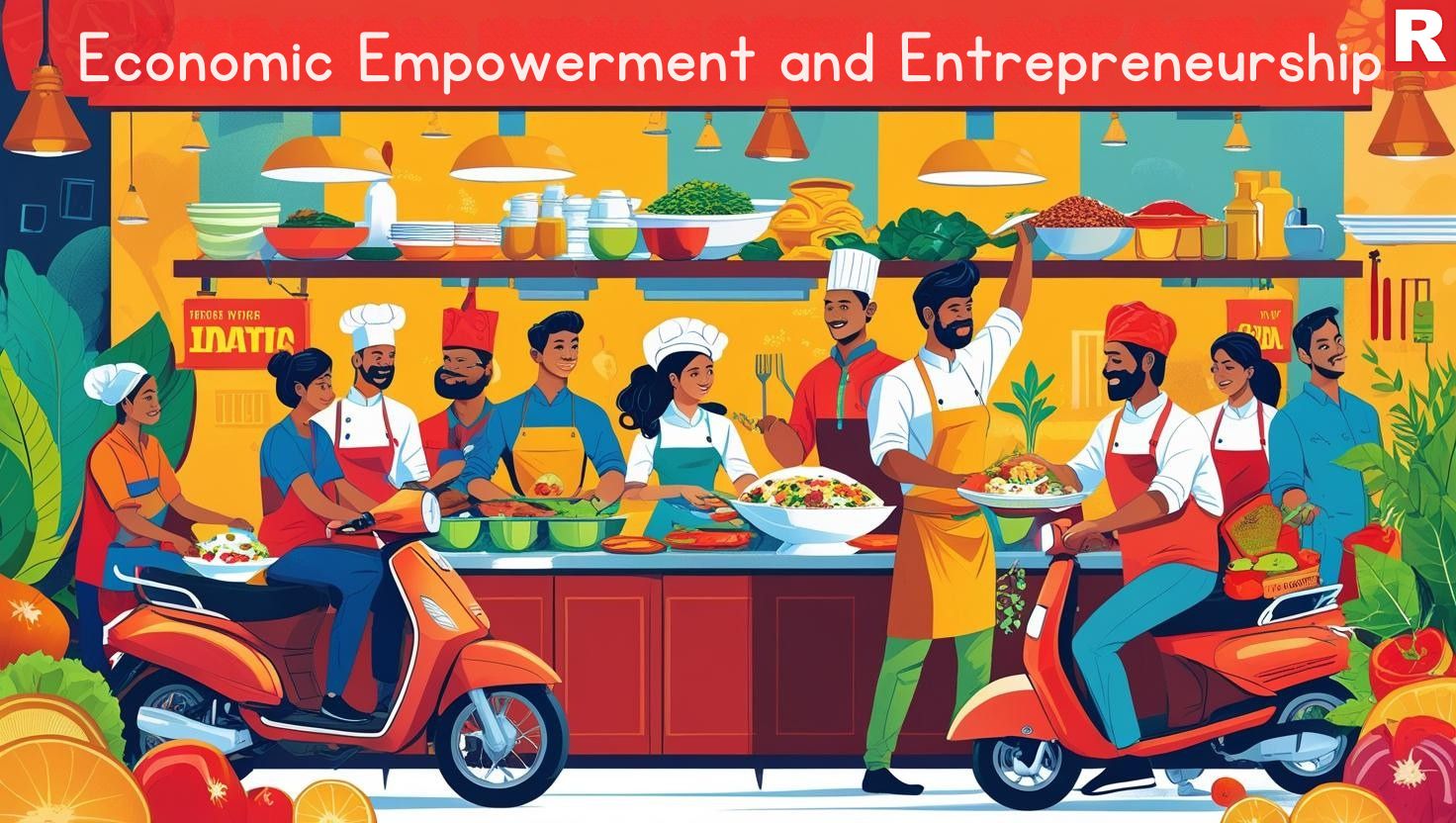
In India, the restaurant sector is a major source of entrepreneurship and economic growth:
- Job Creation: The industry supports a wide range of skill levels and makes a significant contribution to the local economy by offering work opportunities to a large number of people, including managers, delivery riders, kitchen workers, chefs, and waiters.
- Support for Allied Industries: A network of connected businesses, such as food suppliers, farmers, packaging makers, and transportation services, is fueled by the success of restaurants, which multiplies the economy.
- Promoting Entrepreneurial Spirit: The restaurant industry is a desirable path for prospective business owners due to its comparatively lower entry obstacles when compared to some other industries. This has resulted in a thriving and varied culinary scene that is driven by passion and innovation.
6. Sustainability and Health Consciousness
The restaurant sector is being impacted by the evolving standards of Indian customers, especially the younger generation:
- Growing Sustainability Awareness: Demand for restaurants that use eco-friendly packaging, reduce food waste, and source local ingredients is rising. Restaurants are slowly adjusting to this increased awareness.
- Better Menu Selections: As health consciousness has grown, a lot of restaurants are now providing vegetarian, vegan, and low-calorie menu alternatives to accommodate a greater variety of dietary requirements and preferences.
What's new: How to Reduce Food Wastage in Your Restaurant
7. The Rise of the "Foodie" Culture and Social Media Influence
- Creation of the "Foodie" Identity: A new cultural identity has emerged as a result of the wide variety of dining options available: the "foodie," an enthusiastic explorer in the world of food.
- Social Media as a Platform: With customers posting pictures of visually appealing food and restaurant décor, social media platforms have emerged as the main resource for recording food explorations.
- Symbiotic Relationship: In order to draw in this new generation of customers, restaurants are concentrating on producing "Instagrammable" content, which in turn generates free, buzz-generating advertising.
8. Fostering Entrepreneurship and Innovation
- Reduced Barriers to Entrance: The restaurant industry is a beehive of entrepreneurship due to the comparatively low barriers to entrance for small-scale businesses.
- Diverse company Models: As a result, new and creative company models such as food trucks, cloud kitchens, and distinctive themed cafes have emerged.
- Alternate Career Paths: By encouraging a culture of innovation in technology, service, and cuisine, the sector offers a new generation of workers an alternate career route.
Check out: How to Find Good Staff for Your Restaurant
5 Foods to Avoid for Better Cholesterol
9. A Catalyst for Cultural Exchange and Acceptance
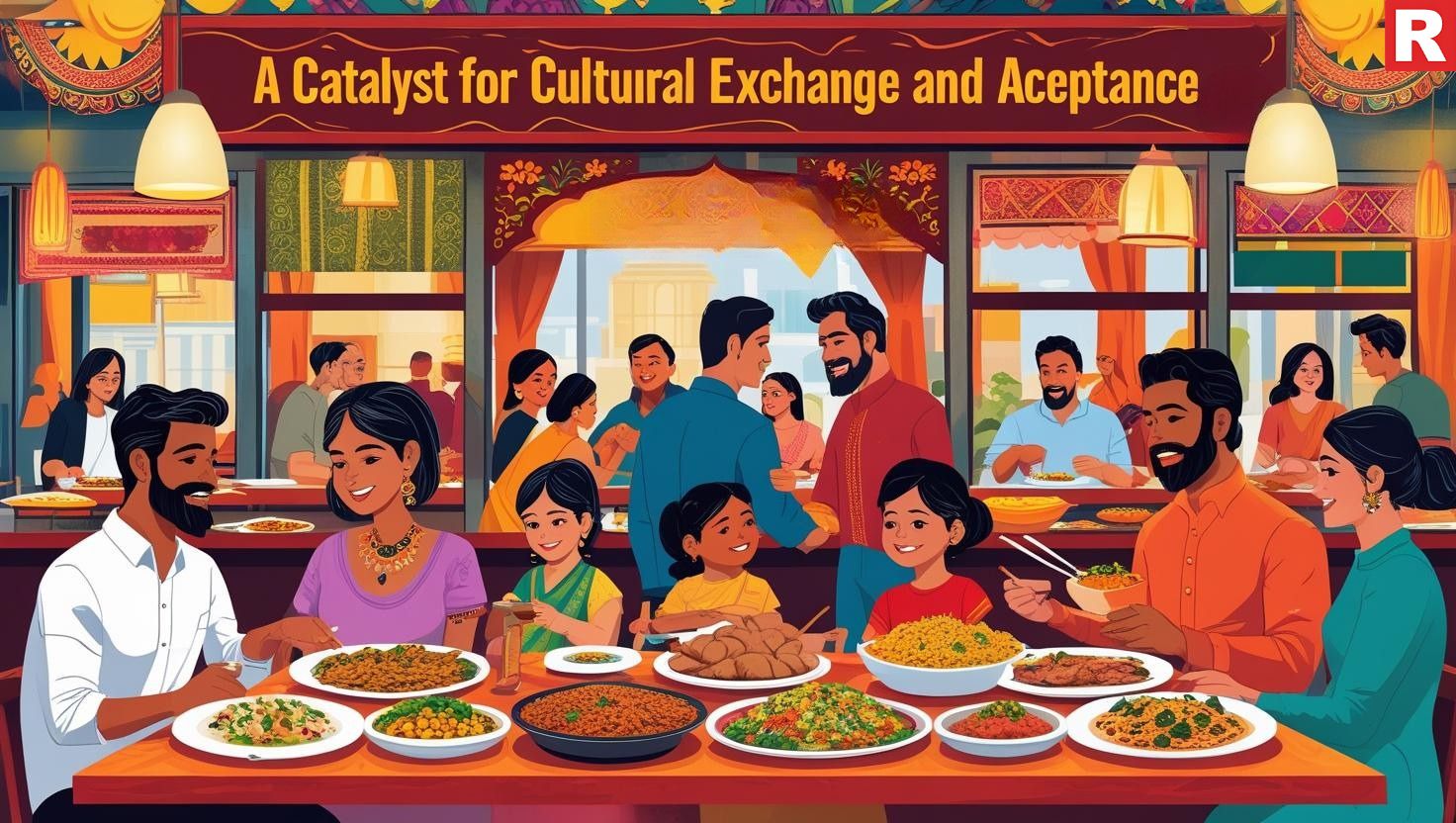
- Informal Centers for Exchange: Since sampling foods from throughout the world frequently draws interest in the cultures that produce them, restaurants have evolved into unofficial hubs for cross-cultural interaction.
- Taking Down Barriers: Being exposed to a variety of cuisines and dining traditions promotes a more international perspective and aids in the removal of cultural barriers.
- Expanding Cultural Acceptability: One sign of this expanding cultural acceptability is the rising appeal of specialized culinary events and international food festivals.
10. The Changing Role of Women in Society
- Professional Culinary Avenues: Women can now follow their cooking passions professionally, surpassing their traditional household role, thanks to the expansion of the restaurant business.
- Economic Independence: The sector gives women new chances to advance their careers and achieve financial independence.
- Enhancing the Culinary Scene: As more women take up leadership roles and run restaurants, they are challenging gender stereotypes and contributing a variety of skills and viewpoints to the culinary scene.
Read this: GST Registration for A Restaurant Business: How It Works
Conclusion
Without a doubt, the restaurant business has become an essential component of Indian culture, especially in cities. Beyond merely supplying food, it is now an essential component of economic activity, cultural interchange, social connection, and the adjustment to contemporary values and lifestyles. One mouthwatering dish at a time, restaurants have transformed the way Indians live, connect, and experience their world through everything from family get-togethers to professional meetings, from discovering international cuisines to embracing convenience. Without a question, the thriving restaurant scene will continue to have a big influence on how its citizens live as it develops and grows.

In the big food sector of the country, success is not only measured by delicious food and packed dining rooms. Rather, one also needs to consider the cons that are affecting the profitability and success of the business directly or indirectly. And food wastage is such a silent, yet significant issue. Food wastage is a problem that is faced by every establishment, from small food trucks to big restaurants or hotels. It is a problem that can affect every aspect of restaurant operations and even impact the profit margins or brand reputation.
Not only is cutting down on food waste a morally right thing to do, but it's also a wise financial move. Reducing waste can directly result in more revenues, cheaper operating expenses, and a more sustainable business model that appeals to today's eco-aware consumer in a world where every rupee matters.
This article will provide you with a detailed plan on how to cut down on food waste in your restaurant. In order to turn what was before a liability into a crucial component of your restaurant's success, we will look into achievable techniques for the kitchen, the dining room, and the business overall.
Read more: Nothing Before Coffee Hits Century, Opens 100th Outlet in Vadodara
1. The Financial and Ethical Case for Waste Reduction

Food waste's financial impact is frequently underestimated. The money invested in labor, preparation, and sourcing is directly lost for each kilogram of food that is thrown away. According to one estimate, food waste can cost an ordinary restaurant up to 10% of its revenue. That might amount to hundreds of thousands of rupees annually or thousands of rupees per month for a small restaurant.
There are ethical and environmental responsibilities in addition to financial ones. In addition to wasting important resources like water, energy, and human labor used in food production, food waste also contributes to climate change through methane emissions in landfills. Your brand's reputation can be improved by taking an up-front approach to trash reduction, positioning you as a leader in environmentally friendly procedures and drawing in a new generation of environmentally concerned consumers.
2. The First Line of Defense in the Kitchen
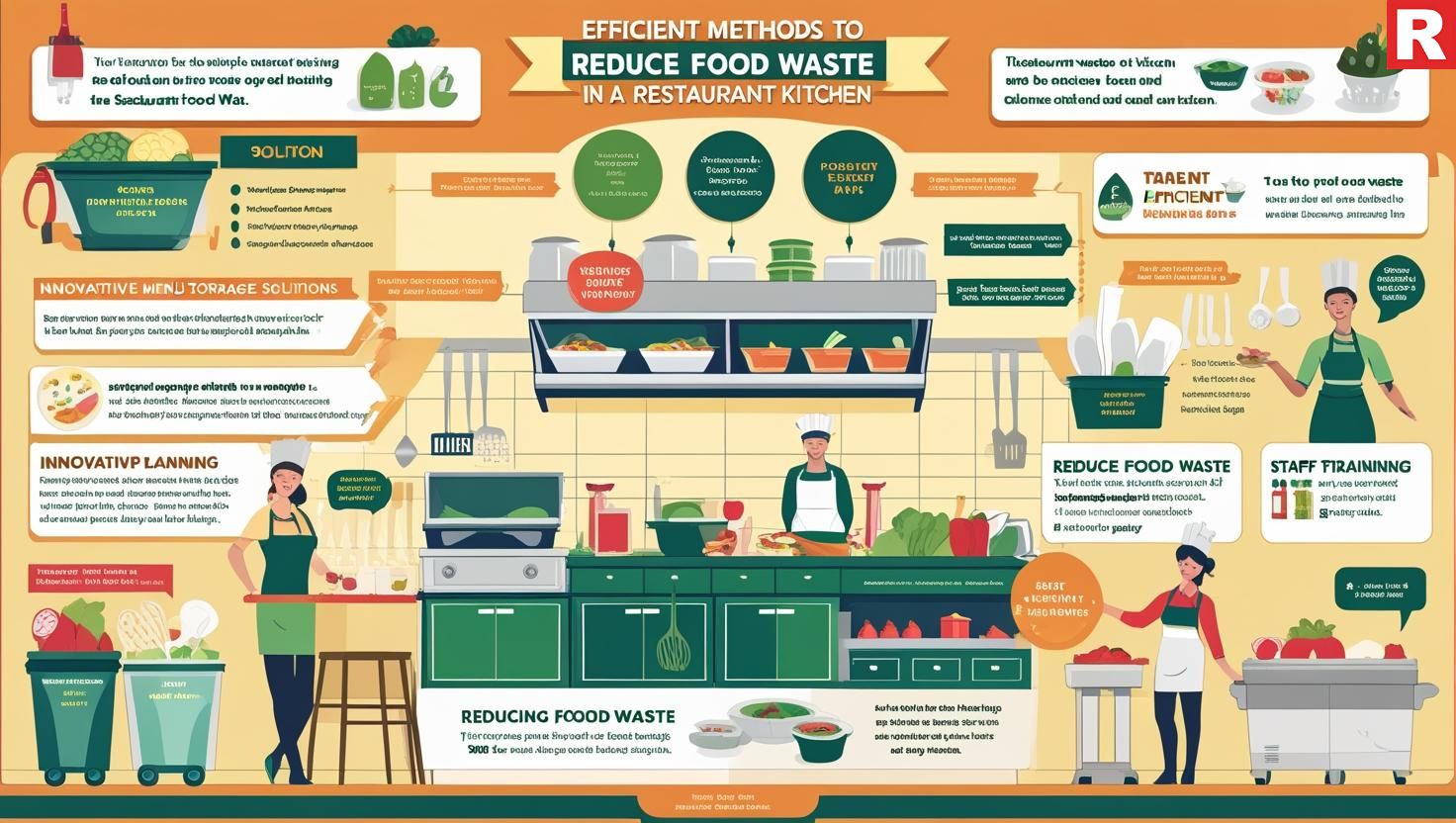
The majority of your food waste comes from the kitchen, but it's also where you can make the biggest changes. Here, implementing a clever and methodical strategy in practice is essential for long-term success.
Know more: GST Registration for A Restaurant Business: How It Works
a. Master Your Inventory: The "First In, First Out" (FIFO) Rule
The key component of waste reduction is a well-managed and ordered inventory.
- Implement a FIFO system: Use ingredients that have been purchased before using more recent supplies by putting in place a FIFO system. To make this simple, mark the delivery date on all containers.
- Perform Frequent Audits: Assign a team member to inspect your inventory once a week or even every day. This enables you to create specials or daily menus to utilize up products that are getting close to expiration.
- Track Everything: Keep an accurate log of every inventory coming in and going out. Understanding your usage habits and avoiding overordering are made possible by this data.
b. Smart Menu Planning
Your menu serves as a practical instrument for waste management and is more than just a list of meals.
- Cross-utilize Ingredients: Create a menu that allows you to utilize one item in several different dishes. For instance, one chicken breast can be used to make spaghetti, biryani, and grilled chicken salad. This reduces the possibility that leftover ingredients will deteriorate.
- Provide Seasonal Specials: Arrange your menu to highlight fresh, locally sourced, and less likely to spoil seasonal items. Additionally, this lowers your food expenses and helps out local farmers in the area.
- Review Your Best and Worst Sellers: Examine your sales data regularly. Think about redesigning or eliminating a dish from the menu if it often has a high food waste rate or isn't selling well.
c. Proper Food Storage
One of the main reasons for early spoiling is improper storage.
- Air-Tight Containers: To preserve freshness and shield ingredients from moisture and impurities, store them all in airtight, sealed containers.
- Proper Refrigeration: Verify that the temperature in your freezers and refrigerators is appropriate. Consistency can be maintained with the aid of a temperature log. To avoid cross-contamination, keep various kinds of food in separate locations.
- Use Freezing: To increase the shelf life of items that won't be used right away, like stocks, purees, or additional slices of meat, freeze them.
What's new: How to Find Good Staff for Your Restaurant
d. From Scraps to Specialties
Utilizing items that would otherwise be thrown away is one of the most creative approaches to waste reduction.
- Vegetable Scraps: To create savory stocks and broths, use vegetable trimmings, stems, and peelings.
- Stale Bread: Use stale bread as a base for a bread pudding, as breadcrumbs for cutlets, or as croutons for salads.
- Leftover Rice: Make tasty crispy rice fritters or fried rice with leftover rice.
e. Accurate Portion Control
Food waste frequently occurs after the dish is served.
- Standardized Portions: To guarantee that each piece is the same, use standard measurement equipment such as scoops or digital scales. This helps you keep food expenses under control while also decreasing waste.
- Educate Your Workers: Teach your kitchen workers the value of portion control and the consequences of serving too much food for waste.
3. Front of House: Engaging Customers in Waste Reduction

A partnership exists between you and your customer during the eating experience. Involving them can help you cut down on plate waste.
- Flexible Menu Options: To accommodate a range of appetites, provide alternative serving sizes, such as a full and a half plate. Provide a "create your own" option with a smaller serving size for dishes that are usually enormous, like platters or thalis.
- The Takeaway Box's Power: Motivate patrons to take their leftovers home. To actively inquire if they would like to box their leftover food, staff members should receive training. To complement the sustainable message of your company, make sure your take-out containers are environmentally friendly.
- Staff Training: Teach your servers to be waste-conscious. They can gently advise a child to have a smaller portion or inform a customer that a dish is considerably large before they place their order.
Check out: How to Create a Restaurant Business Card
Capturing the Craze: How Celebrity Restaurants are Winning the Game
4. Technology in Waste Management
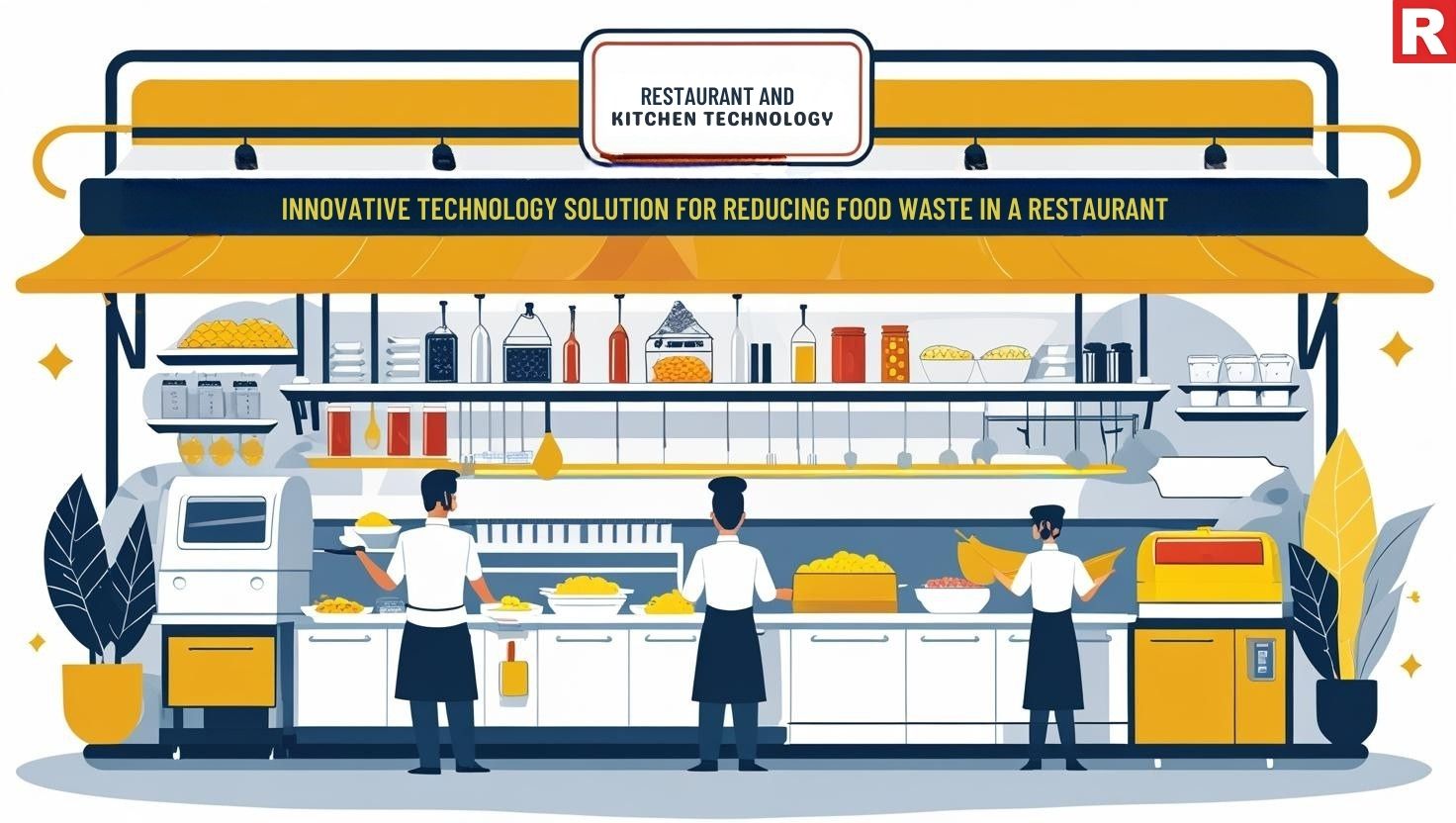
In the current digital era, technology provides an effective means of preventing food waste.
Smart Inventory and POS Systems: Use an integrated point of sale (POS) and inventory management system for smart inventory and POS systems. This software tracks what you sell and what you waste, giving you useful information about how well your menu is performing and assisting you in spotting waste issues.
Waste Management Applications: You can now track, measure, and analyze your food waste in real time with the use of specialist applications. You can use this information to set clear waste reduction objectives and monitor your success over time.
5. Community and Sustainability
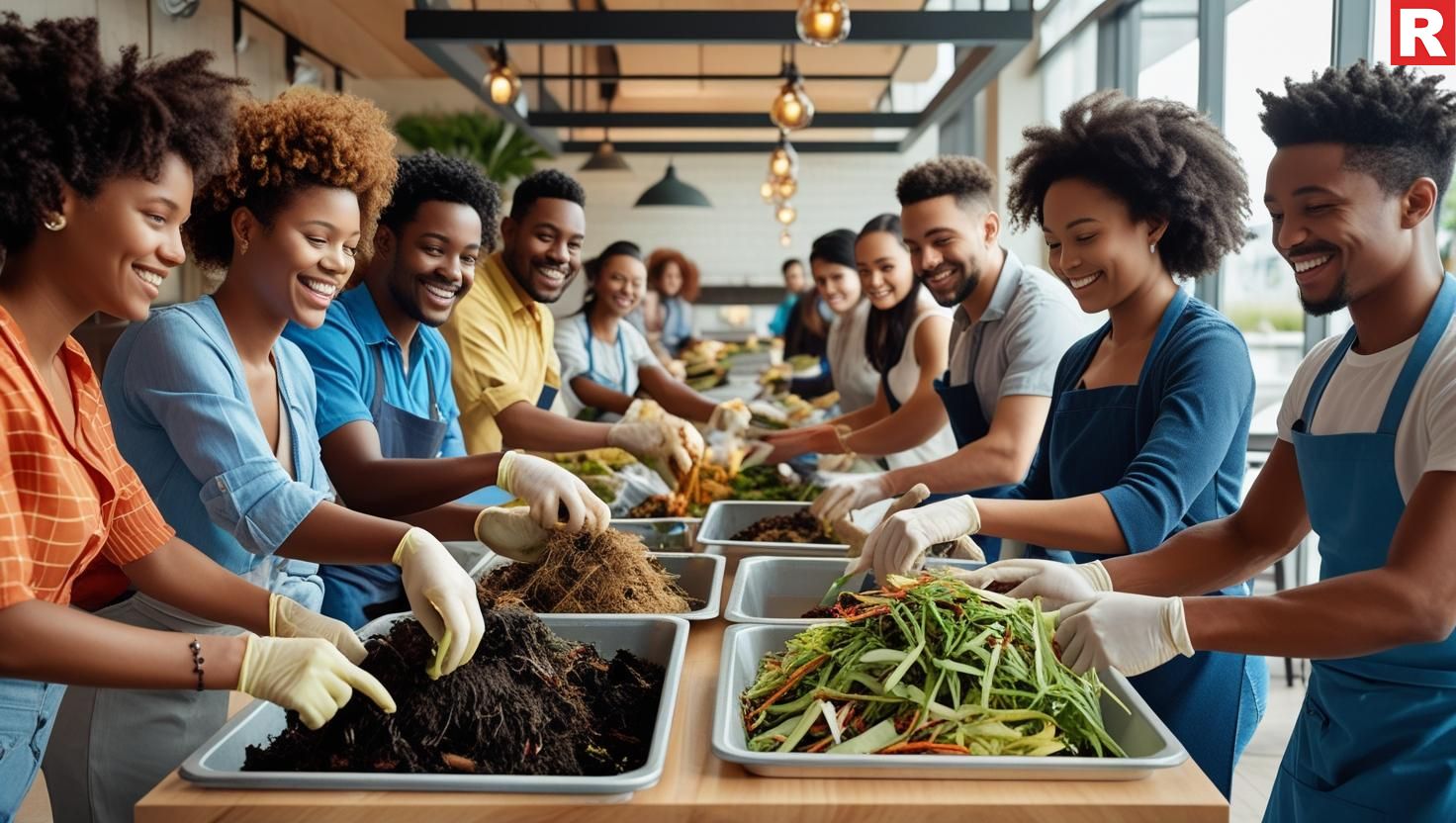
By reducing food waste, your restaurant can improve its reputation and benefit the community at large in addition to its own operations.
- Food Donation Programs: Donate extra edible food by collaborating with neighborhood food banks, NGOs, or community kitchens. This enables your business to be a force for good in the community in addition to helping individuals in need.
- Composting and Recycling: Put in place a strong composting and recycling program for inevitable food leftovers and non-edible trash. Keep organic garbage apart from other types of waste. This lessens your environmental impact and keeps rubbish out of landfills.
- Communicate Your Efforts: Use your website and social media to highlight your dedication to sustainability. Tell your followers about your experience reducing trash. Being transparent builds trust and has the potential to be an effective marketing strategy that draws in customers who align with your principles.
Read this: Marketing The Gen Z Way For Your Restaurant
6. Staff Education

Every team member needs to be actively involved in your waste reduction initiatives if you want to see a real impact. Communication and education are the first steps to achieving this.
- Training from Day One: Include waste reduction concepts in the training procedure for every new staff member, including those working in the front of house and kitchen. Describe how trash affects the economy and the environment, and how their position helps find a solution.
- Establish a "Waste Champion": Designate a "Waste Champion" who will take turns. Tracking discarded things, keeping an eye on trash cans, and reporting results to the team are the responsibilities of this individual. In addition to giving a staff member more authority, this also increases awareness of the different kinds of waste that are produced.
- Have Open Discussions: Schedule frequent meetings to go over waste reduction objectives, celebrate achievements, and generate fresh concepts. Since they are on the front lines and frequently have the best knowledge of where waste is happening, ask your employees for their opinions. Instead of giving orders from above, make it a team effort.
Conclusion
Every team member, from the kitchen to the front door, must be dedicated to the comprehensive effort of reducing food waste in your restaurant. It is a smart tactic that not only boosts profitability and helps you save money, but it also establishes your business as a sustainable and ethical one. You may have a big influence on the environment and your bottom line by adopting clever inventory management, imaginative menu planning, and consumer engagement. At the end of the day, a restaurant that values its ingredients and reduces waste is designed to last.

The aroma of perfectly cooked dishes and the ambiance of a restaurant are what bring the customers in. However, these are not the only factors that contribute to a restaurant's success. A restaurant is a business that cannot run with the efforts of a single person, especially a dine-in restaurant. Having a good and capable staff is essential for the proper functioning of your business. From greeting the customers, to the chefs cooking in the kitchen, they are all a team that is also the engine of your business. So, finding and recruiting such team members will contribute to delivering exceptional customer service, maintaining operational efficiency, and ultimately to the long-term success of your restaurant.
In this article, we will guide you through the essential strategies and practical tips that will help you recruit the best staff members in the culinary society of India. We will explore the effective sourcing methods, highlight the importance of a strong hiring process, and provide tips to create a positive work environment for your team members.
Read more: Brewing Change: How Cafés Are Re-Shaping India’s Culinary Future
Why Finding the Right Staff is Crucial for Your Restaurant
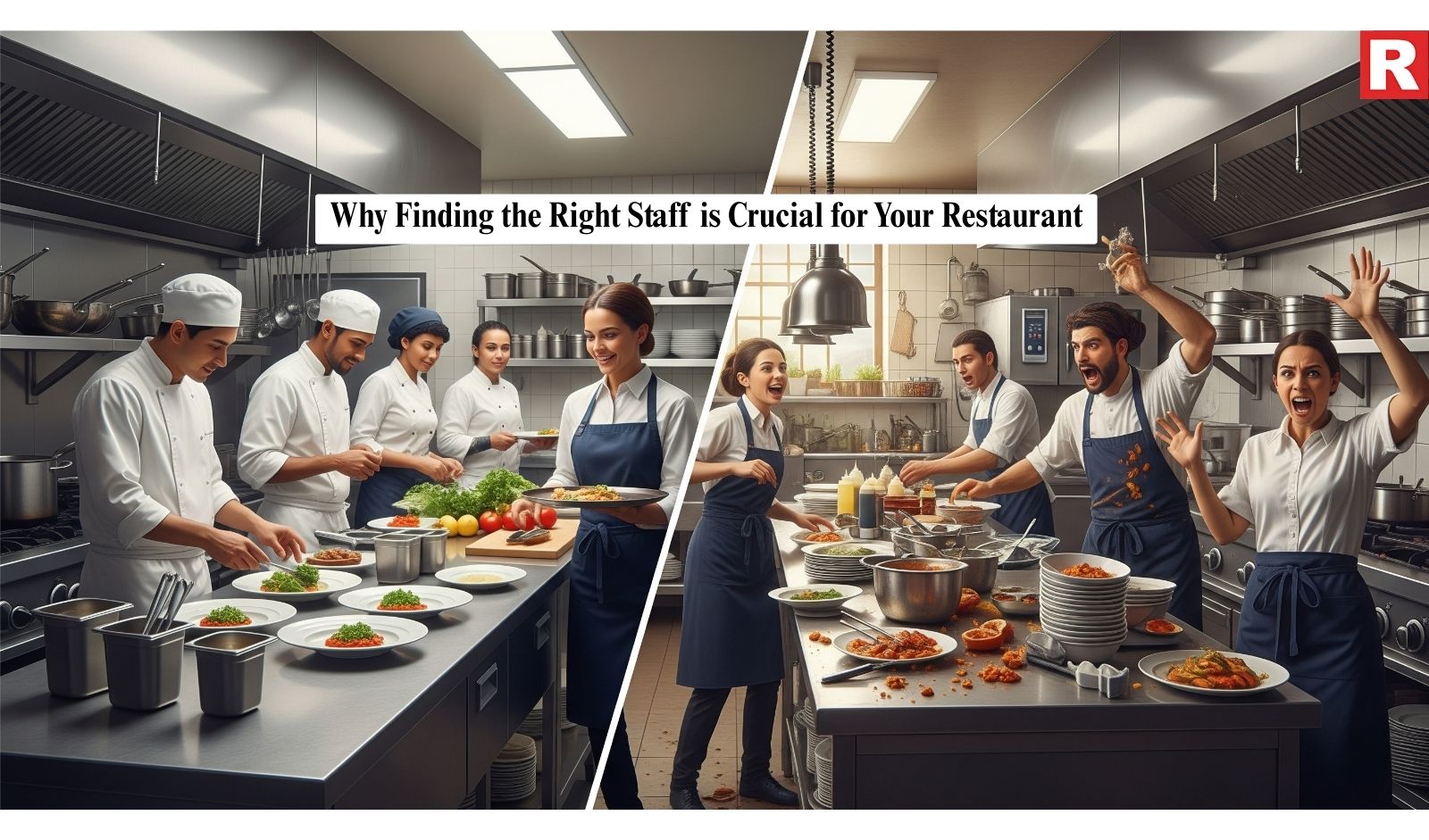
In a customer-centric establishment like a restaurant, the staff has a great impact on every aspect of the business. Here are some points that show why finding good staff is crucial for your restaurant:
- Customer Experience: Good eating experiences are achieved by kind, effective, and informed employees, which results in happy customers, repeat business, and good word-of-mouth—all of which are essential for expansion.
- Operational Efficiency: By reducing errors and increasing productivity, well-trained and motivated staff guarantee seamless and effective operations in the kitchen, during service, and in every other department of the restaurant.
- Food Quality and Consistency: The key component of your culinary reputation is the quality and consistency of your dishes, which can only be maintained by skilled kitchen employees, from chefs to line cooks.
- Collaboration & Teamwork: A harmonious and cooperative team environment boosts morale, creates a favorable work environment, and increases overall productivity.
- Brand Reputation: Your staff members serve as the main representatives for your business. Their interactions with customers have a direct impact on the reputation and image of your business in the surrounding area.
- Decreased Turnover Costs: The expenses associated with recruiting, employing, and training new hires are among the major drains on resources caused by high staff turnover. These costs are reduced by hiring and keeping qualified employees.
Effective Strategies for Sourcing Restaurant Staff
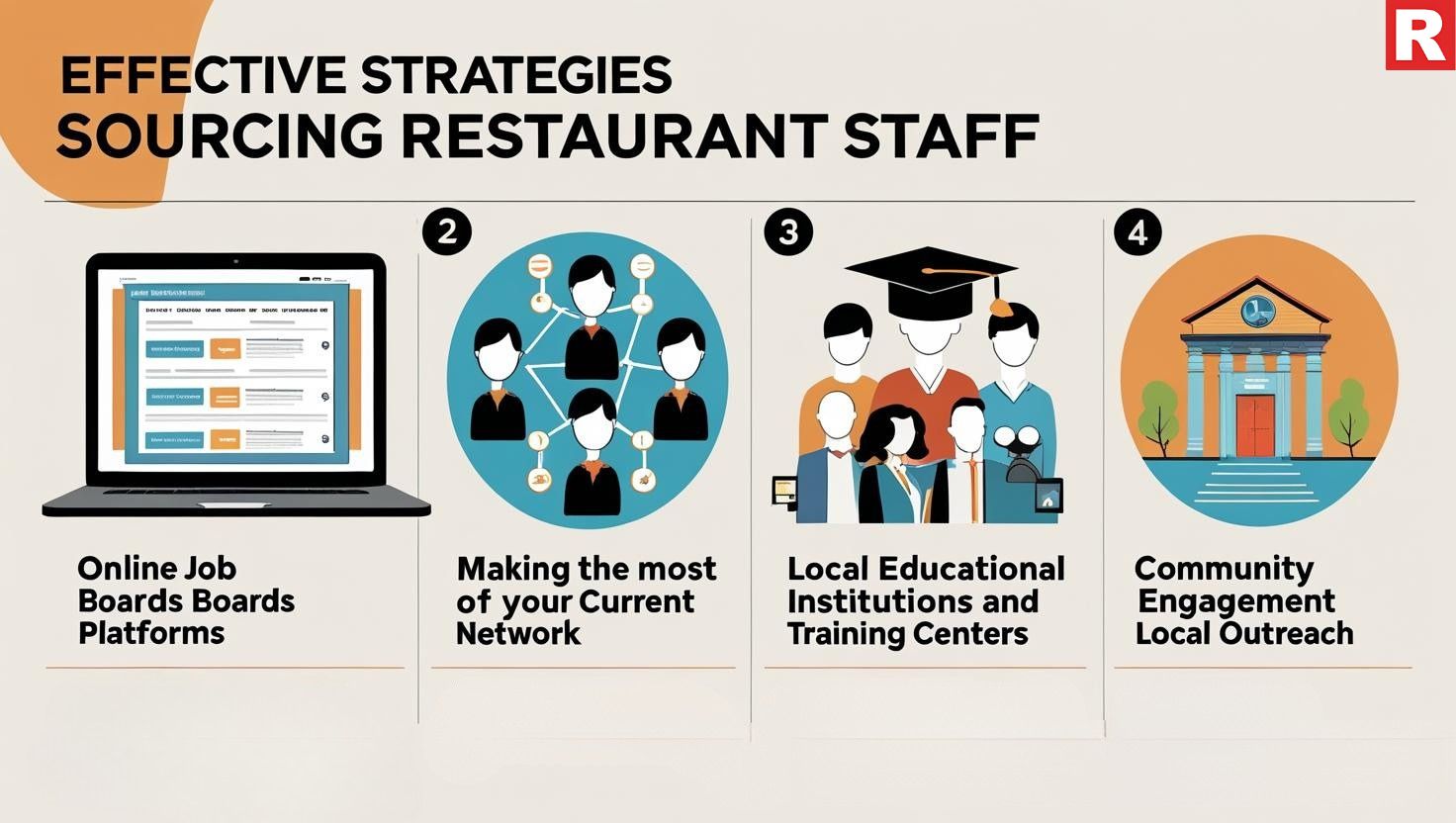
There are several key strategies to recruit staff members for your restaurant. Finding the right candidates is a broad approach that requires the use of multiple sourcing channels:
1. Online Job Boards and Platforms:
- Popular Indian Job Portals: Use well-known Indian employment portals, such as Indeed India, LinkedIn, Shine.com, and Naukri.com. By posting detailed job postings on these sites, you can connect with a lot of people who are actively looking for work in your area.
- Hospitality-Specific Job Boards: Look at job boards that focus on the food service and hospitality sectors. Candidates with specialized knowledge and an interest in the restaurant industry are frequently drawn to these platforms.
- Social Media Recruitment: Use Facebook, Instagram, WhatsApp groups, and other social media sites to recruit new employees. Post eye-catching job openings and invite current employees to spread the word to their networks. Focus on local communities and groups.
Know more: 7 Pure Raw Honey Varieties That Offer Exceptional Taste and Natural Healing Benefits
2. Making the Most of Your Current Network:
- Employee Referrals: Motivate your present employees to recommend suitable candidates from their networks. Give rewards for referrals that result in successful employment. Your current staff members are familiar with the culture of your restaurant and are likely to suggest people who might fit in.
- Industry Relationships: Speak with your contacts in the local hospitality sector, including other restaurant owners, suppliers, and culinary schools. They might know of gifted people searching opportunities.
3. Local Educational Institutions and Training Centers:
- Vocational Training Facilities: Make contact with facilities that provide courses in hospitality, food service, and customer service. These facilities frequently house a pool of competent job seekers.
- Hotel Management Institutes and Culinary Schools: Make connections with hotel management institutes and culinary schools. Provide entry-level jobs, internships, or apprenticeships to fresh graduates who are seeking to obtain real-world experience.
4. Community Engagement and Local Outreach:
- Local Job Fairs & Events: To meet potential candidates face-to-face, take part in local job fairs and community gatherings.
- Notice Boards and Local Advertisements: Take into account posting job openings on notice boards in neighborhoods, community centers, and marketplaces that potential employees frequent.
- Partnerships with Local Organizations: Work together with NGOs or local community organizations that might have programs supporting job seekers in the hospitality industry.
5. Walk-in Applications:
Your business can attract locals looking for work by prominently posting a simple "Now Hiring" sign. Be ready to take walk-in applications and evaluate them.
Effective Job Descriptions To Attract the Right Applicants

To find potential candidates, you need to let them know about the job description. A job description should be clear, concise, and compelling so it attracts the right candidates.
- Job Title: Make sure your job title accurately reflects the duties of the position and is clear and specific.
- Restaurant Overview: To help candidates understand your brand, briefly outline the concept, food, atmosphere, and values of your restaurant.
- Responsibilities: Clearly state the main obligations and tasks of the role.
- Qualifications and Experience: List the necessary education, training, and experience. Be reasonable and stay clear of unnecessary criteria that could turn off qualified applicants.
- Benefits and Compensation: Be open and honest about your hourly rate or compensation as well as any perks you provide, such as health insurance, paid time off, employee discounts, and tips.
- How to Apply: Give interested prospects precise details on how to apply.
What's new: GST Registration for A Restaurant Business: How It Works
Implementation of a Sturdy Hiring Process

A well-structured hiring process is essential for selecting the best candidates:
- Application screening: Give each application and CV a thorough examination in order to identify applicants who fit the job requirements in terms of experience and basic qualifications.
- The initial Phone Screenings: Before scheduling an in-person interview, conduct quick phone interviews to further evaluate candidates' availability, communication abilities, and qualifications.
- In-person interviews: Create a list of structured questions that evaluate applicants' abilities, backgrounds, personalities, and compatibility with your restaurant's culture.
- Practical Assessments: To assess kitchen employees' culinary skills, think about administering a practical cooking exam. You can evaluate service employees' customer service skills by having them participate in role-playing activities.
- Reference Checks: Get in touch with the references that the shortlisted applicants provided to confirm their prior employment history and performance.
- Background Checks: You might think about performing background checks, depending on the position and the rules of your business.
Check out: How to Create a Restaurant Business Card|
5 Delicious Sago Desserts to Enjoy This Monsoon
Fostering a Culture of Growth and Development

In addition to identifying and employing the best candidates, investing in their professional development is a crucial tactic for keeping top talent in a cutthroat culinary market. Your restaurant should be seen as a location where employees can develop their careers rather than just a job.
Internal Training Programs
Create and carry out internal training programs for a range of positions, from advanced culinary skills for your kitchen workers to basic food safety and cleanliness for new hires. Provide upselling, wine pairing, and dispute resolution training to your service staff. This improves their abilities and gives them a sense of worth.
Mentoring and skill development
Assign seasoned employees to new hires or future leaders. A structured mentorship program can offer a clear path for growth and foster a sense of community among new hires. Promote cross-training so that a host may learn how to handle reservations or a server can learn the fundamentals of the kitchen. Their skill set is expanded, and they become more valuable members of your squad.
Clear Career Paths
Establish a clear and straightforward career ladder at your restaurant. Show your employees what they must accomplish to advance from a line cook to a sous chef or from a junior position to a senior one. Acknowledging and elevating internal talent is a great way to inspire employees and make it clear that your restaurant values its staff.
Read this: Marketing The Gen Z Way For Your Restaurant
Creating a Positive Work Environment

Hiring skilled staff members is only half the fight; keeping them on board is just as crucial. The secret to increasing loyalty and lowering turnover is creating a nice work environment:
- Fair Pay and Benefits: Provide competitive salaries and perks that are consistent with industry norms.
- Respectful and Inclusive Culture: Establish a welcoming and respectful workplace culture where all workers, regardless of their roles or backgrounds, feel appreciated, respected, and included.
- Clear Expectations and Communication: Clearly explain to your employees their duties, responsibilities, performance standards, and any modifications to rules or processes.
- Possibilities for Growth and Development: Within your restaurant, offer chances for skill improvement, career progression, and training.
- Acknowledgment and gratitude: Consistently acknowledge and value the efforts and contributions of your staff members. This can be accomplished through tiny incentives, staff recognition programs, or direct praise.
- Work-Life Balance: Try to establish fair and realistic schedules while keeping in mind the work-life balance of your staff members.
- Handle Concerns and Feedback: Establish a way for employees to express their worries and offer suggestions, and pay attention to what they have to say.
Building a Strong Team
Finding and keeping talented staff members is a continuous process that calls for commitment, hard work, and a people-centered mindset. You may create a solid and committed staff that will serve as the foundation for your restaurant's success in the thriving culinary scene by putting into practice efficient sourcing tactics, carrying out extensive hiring procedures, and creating a happy and encouraging work atmosphere. Keep in mind that your employees are your most precious resource, and that investing in them is an investment in your business's future.

There are several areas a restaurateur needs to look out for while managing their restaurant business. One of the key areas related to the success of your restaurant is managing tax, and mainly GST. Goods and Services Tax (GST). The GST, a destination-based, multi-stage tax, has completely changed the indirect tax system in India. In addition to being required by law, obtaining GST registration for a restaurant opens the door for building a reputation, guaranteeing a smooth supply chain, and conducting business openly in the marketplace.
If your restaurant is still new and not registered for GST, then you should apply for it as soon as possible. In this article, everything you need to know about GST registration for a restaurant business will be covered. Including the basic tax rates, mandatory registration limits, the detailed procedure, legal requirements, and the often confusing idea of Input Tax Credit (ITC).
Read more: Chutney: Taste of the Land
Understanding the GST Landscape for Restaurants
You must understand the two main GST rates for restaurants and the conditions in which they apply before beginning the registration process:
- 5% GST without Input Tax Credit (ITC): The most common tax rate for the majority of restaurants, including cafés and food trucks, is 5% GST without Input Tax Credit (ITC). A restaurant selling food and drinks is subject to a flat 5% GST charge under this composition scheme. It cannot, however, claim Input Tax Credit, which means that it cannot get a refund for the GST spent on purchases such as equipment, rent, or raw materials. Because of its straightforward design and ease of implementation, this scheme is a desirable choice for the majority of small and medium-sized restaurants.
- 18% GST with Input Tax Credit (ITC): Restaurants located within hotels with room rates exceeding Rs. 7,500 are subject to the higher 18% GST rate with Input Tax Credit (ITC). Restaurants and bars that chose to use the standard GST plan are also affected by this. The possibility to claim Input Tax Credit, which can lessen the tax burden on business expenses and possibly boost profitability, is the main benefit here.
The 5% plan is the most sensible and uncomplicated option for the great majority of independent restaurants, yet the decision between these two plans will rely on your turnover and business strategy.
When Is GST Registration Mandatory For Your Restaurant?
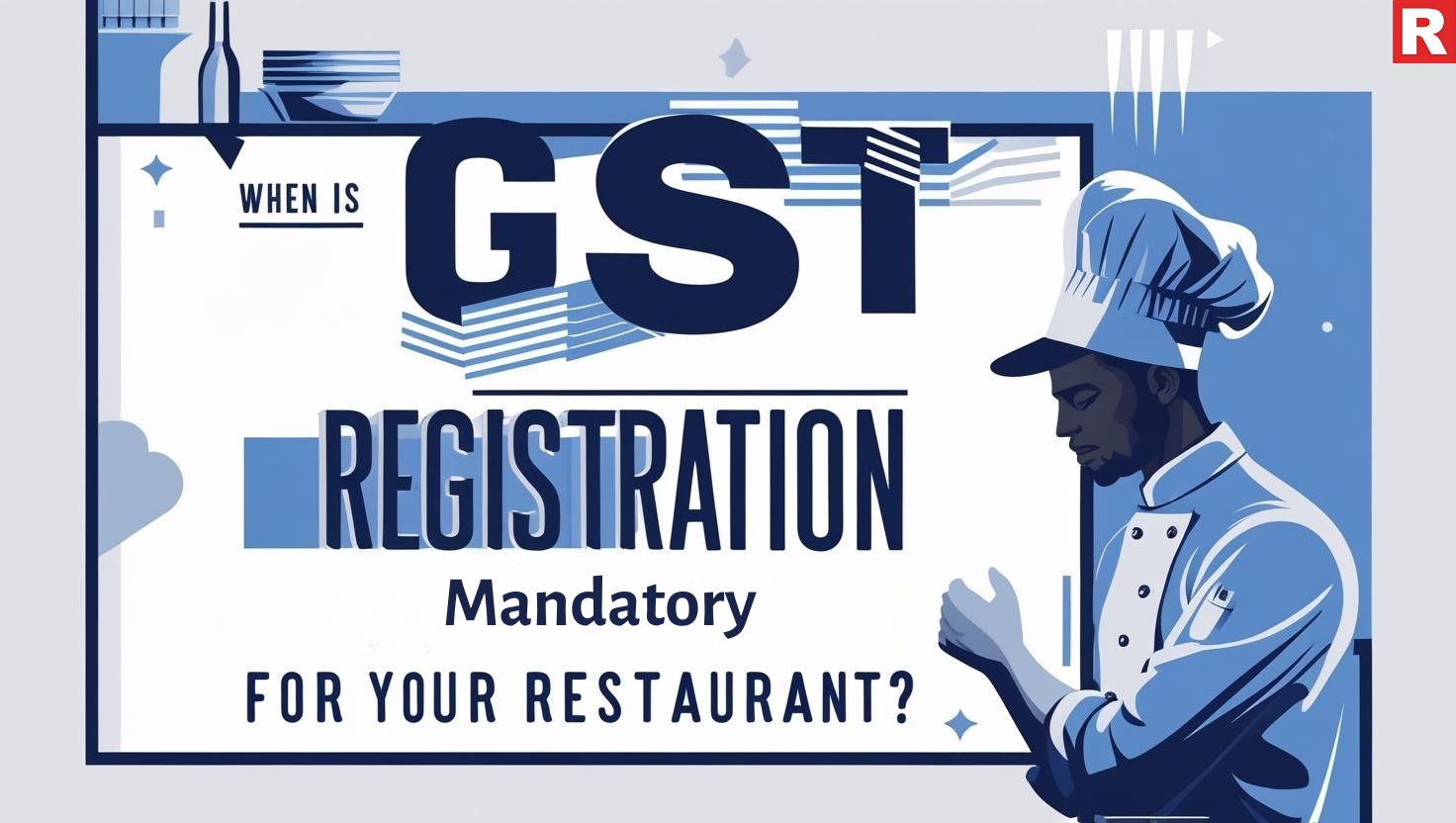
The first important step is knowing when to register for GST. The law specifies certain requirements for restaurants to register for GST:
- Standard Turnover Threshold: Any business, including restaurants, with an annual turnover of more than Rs. 40 lakh is required to register for GST. The barrier is Rs. 20 lakh for companies that operate in a Special Category State, which includes states like Arunachal Pradesh, Assam, Jammu & Kashmir, etc.
- Inter-State Supply: GST registration is required if you sell products or services from one state to another, even if your revenues fall below the threshold. For instance, you have to register if your restaurant provides catering for an event in a nearby state.
- E-commerce Operators: Regardless of your turnover, you must register for GST if your restaurant sells food via an e-commerce platform such as Swiggy or Zomato.
Obtaining a Permanent Account Number (PAN) and a GSTIN (Goods and Services Tax Identification Number) is legally required if your restaurant fits into any of these categories. There may be serious consequences and legal issues if this isn't done.
Know more: Marketing The Gen Z Way For Your Restaurant
The Step-by-Step Guide to GST Registration

The GST registration process is entirely online and can be completed through the official GST portal. Here’s a detailed, step-by-step guide to get you started:
Step 1: Get Your Documents Ready
To prevent any delays, collect all required paperwork before you start. These include:
- The authorized signatory and the business's PAN card.
- The authorized signatory's Aadhaar card.
- Partnership deed or document of business incorporation.
- Evidence of business address, such as a utility bill or rental agreement.
- Details of a bank account (a bank statement or canceled check).
- A passport-sized photo of the directors or partners.
Step 2: Access the GST Portal
Go to the official site of GST registration (www.gst.gov.in) and click on the "Services" tab, then "Registration," and finally "New Registration."
Step 3: Fill Out the Application Form
A multi-part form (Parts A and B) will be sent to you to fill out your business details.
Part A: Enter your mobile number, email address, business name, and PAN. For verification, the system will issue an OTP to your email address and mobile number.
Part B: A Temporary Reference Number (TRN) will be issued to you following a successful verification process. Log in using this TRN, then complete Part B's comprehensive application form. All of your documents will be uploaded here, along with details about your company and its approved signatories.
Step 4: Submission and Verification
You will apply after completing all the fields and attaching the necessary files. The TRN allows you to monitor the progress of your application.
What's new: How to Create a Restaurant Business Card
Step 5: Receiving Your GSTIN
Your application will be examined by the tax officer. Within a few working days, your GSTIN will be generated if all the information is accurate. For GST purposes, your company is uniquely identified by its 15-digit GSTIN.
Advantages of GST for Restaurant Owners
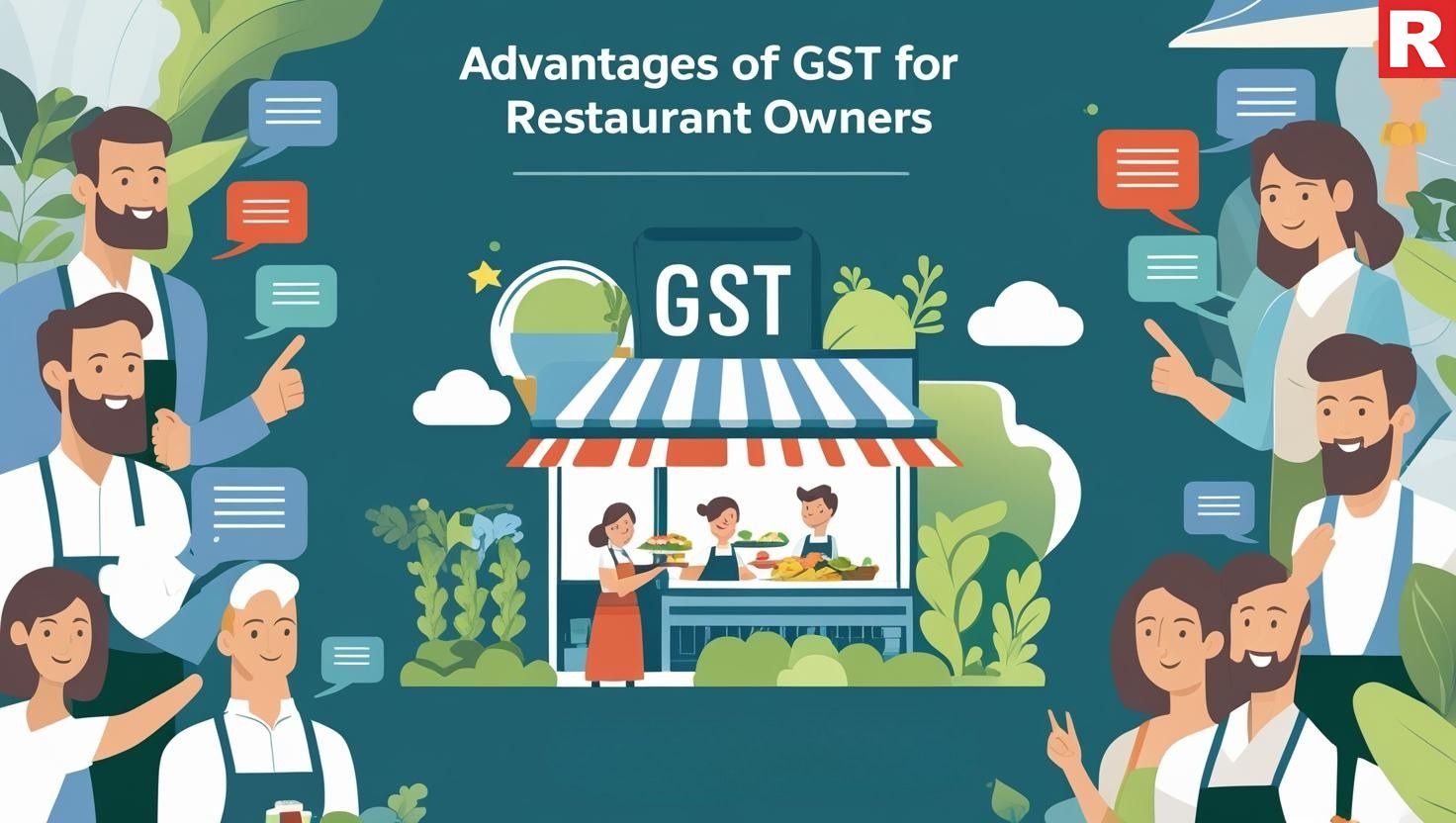
Even though managing GST compliance can appear difficult, restaurant operators can benefit from a number of important features that make their operations more efficient and legal.
- Simplified Tax Structure: The main advantage is that a single, unified tax will replace several other taxes, including the Value Added Tax (VAT), Service Tax, and other state and federal taxes. In addition to lowering the administrative load and saving time and money that would have been required to file separate returns for various taxes, this significantly simplifies the taxing procedure.
- Enhanced Credibility and Transparency: For clients and suppliers, having a GST registration instantly conveys credibility. Business partners can confirm your adherence to regulations, and customers can rest easy knowing they are paying a standardized, government-regulated tax. This openness builds confidence and might raise your market position.
- Development of an Orderly Supply Chain: The Goods and Services Tax (GST) promotes an orderly and structured supply chain. Dependence on the unorganized sector is decreased when you buy goods and services from other GST-registered suppliers because the entire transaction is recorded. This gives your business operations greater structure and gives you a complete record of all your expenses.
- Expands the Taxpayer Base: Many small and medium-sized restaurants have entered the formal economy as a result of the need for businesses with annual sales above a particular limit to register, which has led to a better-structured industry and a larger tax base.
- Simple Online Procedure: Compared to the previous tax system, the GST registration, filing, and payment procedures are all completed online, which increases efficiency and reduces time.
Check out: Top 20 Trendy Whiskeys You Must Try Once
Your Guide to Influencer Marketing in Restaurants
Understanding Input Tax Credit (ITC) for Restaurants
One of the main areas that remains unclear for the majority of restaurants on the 5% GST program is the Input Tax Credit. Let's explain how it operates:
- No ITC on Goods and Services Used: You are not eligible to receive a credit for the GST you pay on your purchases under the 5% program. This implies that the GST paid on kitchenware, rent, other company services, and raw ingredients (such as flour, vegetables, and meat) cannot be written off.
- Why the Government Did This: In order to avoid tax evasion and simplify the tax system for the restaurant industry, the government implemented this rule. Small businesses find it easier to keep up with the 5% rate, which is a final tax on the food's worth, because they don't have to deal with the ITC.
- The Bottom Line: You shouldn't worry about claiming ITC if your restaurant is covered by the 5% GST plan. Your purchases' entire GST cost is a business expense.
Billing and Compliance: Creating a GST-Compliant Invoice
A GST-compliant invoice is required for each transaction in a restaurant that is registered for GST. This is a legal document, not merely a bill, and it needs to contain:
- The GSTIN of your restaurant and, if applicable, that of your customers.
- The date and invoice number.
- The recipient's and supplier's names and addresses (your restaurant).
- A thorough explanation of the meals and drinks offered.
- The entire amount of GST and the tax rate (e.g., 5%).
- The transaction's entire value.
- The authorized signatory's signature, either digital or real.
Accuracy and a smooth process can be achieved by using billing software that is GST-compliant.
Read this: The Ultimate Guide to Food Photography for Indian Restaurants
Conclusion
An essential component of managing a profitable restaurant business in India is navigating the GST environment. Understanding the fundamentals of GST registration for a restaurant business, the distinction between the 5% and 18% tax rates, and the need for timely compliance can help you run your business efficiently and lawfully, even though it may seem complicated. More than just a number, your GSTIN is an indication of a legitimate, professional, and legal business that is prepared to succeed in the modern Indian market.

In the era of social media and digital marketing, a physical business card may seem like an outdated means of connecting with customers. This is different from reality, where we think that restaurant cards are just a phone number. If the restaurant card is designed properly, then it will not only invite past customers for future invitations, but it can also become a piece of your brand and an effective, affordable marketing tool. The business card given at the end of the customer’s dining experience is the last physical interaction you have with them. After that, your business card can become a big factor in creating regular customers or attracting new ones.
To design a business card that is both aesthetically beautiful and a marketing tool, we must have a proper plan. In this article, we will take you through a step-by-step guide that will help you with the entire process of designing a powerful business card. From completing its goal to perfecting the art of design and using it to its fullest potential for marketing.
Read more: Capturing the Craze: How Celebrity Restaurants are Winning the Game
The Qualities of A Physical Business Card

Even if your restaurant has a strong online presence, it still needs to have a physical card. This provides a direct connection that digital interactions cannot recreate.
- A Tangible Reminder: A physical card, whether it is in a customer’s wallet or on a kitchen counter, will subtly remind them of your restaurant. Unlike an email that can get lost in an inbox, it serves as a reminder for a future visit or order.
- Networking and B2B Relationships: Your restaurant is not just an establishment to sell food to customers. It is an entity in itself and a proper business model. So you, as the owner, need a physical card that can properly represent your business to food suppliers, local event planners, or other business owners. A high-quality card conveys seriousness and professionalism.
- Customer Loyalty: A business card can serve dual purposes by serving as a loyalty card for the customer. This offers clients a reason to remain involved with it and promotes repeat business.
- Offline Marketing: To draw in prospective customers who might not be looking for you online, leave your business cards at neighborhood businesses, community centers, or hotels.
The Essential Elements of a Great Restaurant Business Card
A business card needs to be concise, clear, and packed with all the important details. The following should always be included:
- Restaurant Name and Logo: The most important component is the restaurant's name and logo. Your brand's visual identity is represented by your logo, which should be clearly visible on the card.
- Contact Details: This includes your email address, phone number, and website URL. Make it simple for clients to contact you.
- Physical Address: An in-person restaurant's address cannot be negotiated. Clients must be able to locate you.
- Social Media Handles: Provide a list of your primary social media accounts, including Facebook and Instagram. This turns a one-time diner into a devoted social media follower.
- A Catchy Slogan or Tagline: There should be short, memorable phrases that can effectively convey the vibe of your brand and help people remember the card.
Know more: 5 Delicious Sago Desserts to Enjoy This Monsoon
Branding and Aesthetics to Create an Impact
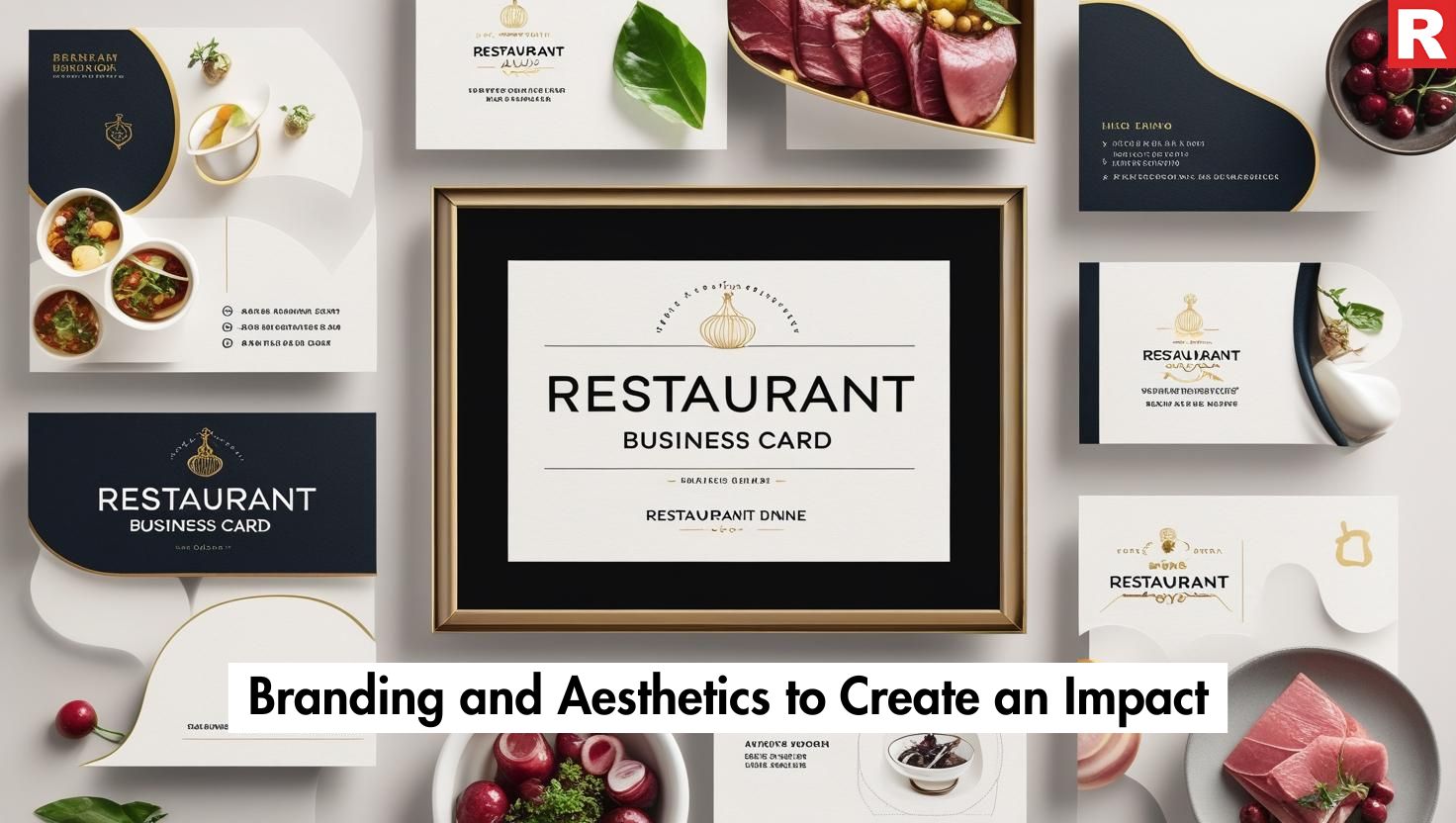
A business card is a small billboard for your restaurant, so the design must be flawless.
- Brand Consistency: Your restaurant's brand identity should be reflected in the design of your business cards. Make use of the same color scheme, font styles, and general design as your menu, website, and interior design. This produces a unified and polished image.
- Typography & Readability: Select fonts that are both aesthetically pleasing and simple to read. Stay clear of eye-straining small or excessively fancy fonts. Whether it's a quirky, handwritten font for a casual cafe or a traditional serif for a fine-dining business, the font should represent the personality of your restaurant.
- The Power of Color: Color creates mood and stirs up moods. While earthy tones could suggest a farm-to-table or organic theme, a strong red might suggest passion and energy for an Indian restaurant.
- White space and layout: A cluttered card is hard to read and appears unprofessional. To allow your important content to breathe, make good use of white space. For further information or a loyalty offer, the reverse of the card is a great location.
- Paper Quality and Finish: A business card's physical feeling says a lot about your company. Don't cut corners on this. A thick, premium paper material has a strong, lavish feel. Think about a glossy coating to bring out the colors or a matte finish for a timeless, elegant appearance. A brand's dedication to sustainability or a rustic feel can also be communicated through textured or recycled paper.
- Unique Shapes and Die-Cuts: A unique method to stand out is with a card shaped like a coffee bean, a pizza slice, or a chef's cap. A personalized die-cut card is much more memorable, but it costs more.
What's new: Marketing The Gen Z Way For Your Restaurant
A Step-by-Step Guide to Creating Your Card
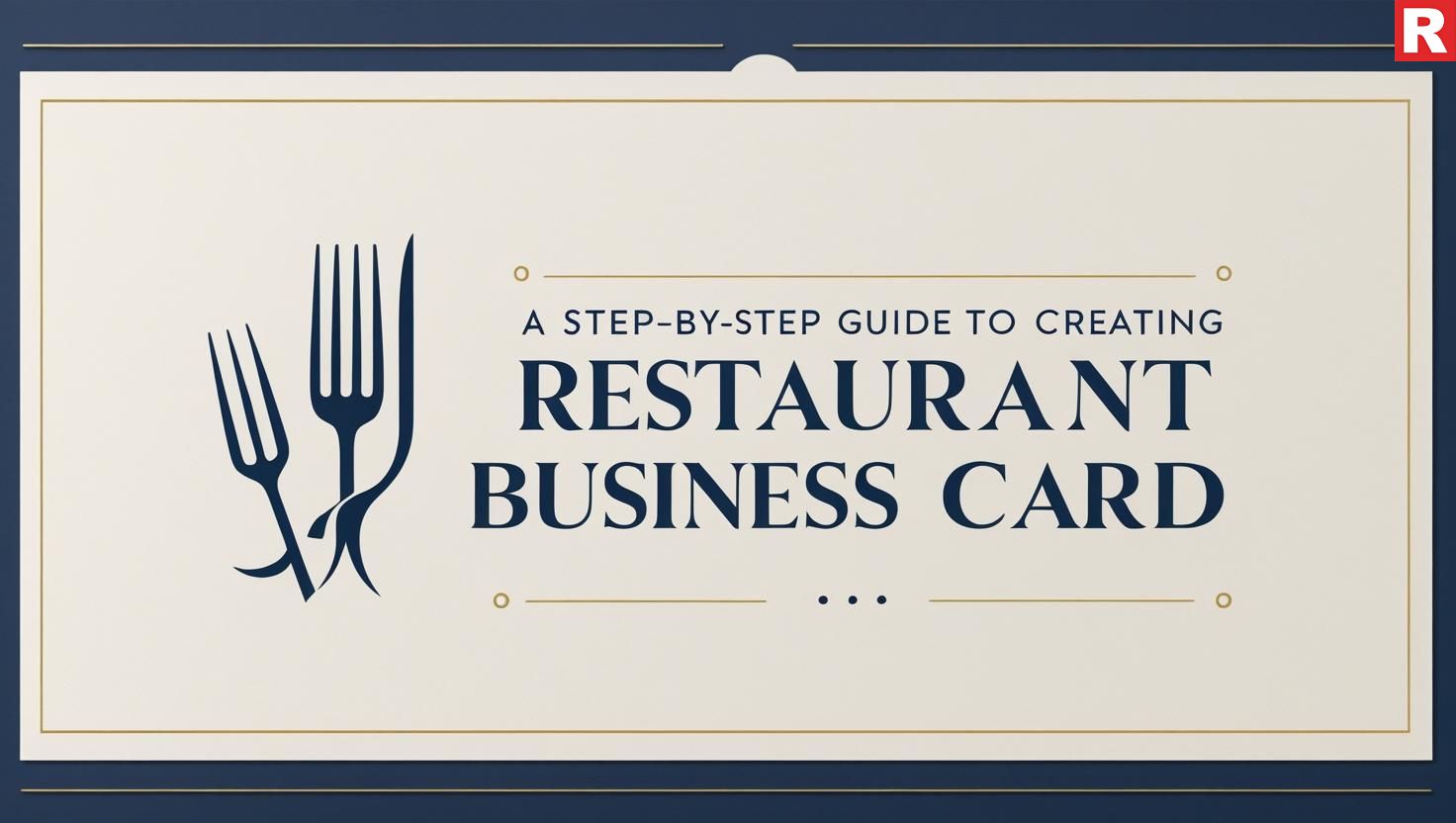
- Collect Your Brand Assets: Make sure you have all of your branding resources ready before you begin developing. This contains the names of your brand fonts, the hex codes for your brand colors, and a high-resolution copy of your logo.
- Select Your Design Tool: There are several choices available to you.
- Canva and other online platforms are excellent for beginners. You can modify thousands of their editable templates to fit your brand.
- Professional software, such as Adobe Illustrator, provides the greatest creative freedom and is reserved for seasoned designers.
- If you have the funds, hiring a freelance designer is your best bet. A skilled designer can create a unique, improved card that precisely captures your brand.
- Draft Your Content and Layout: Create a draft of your layout and content by drawing the design you want on the card's front and back. Put the most crucial information on the front and make use of the back for social media handles, a QR code, or a loyalty reward.
- Review and Proofread: This is an important step. A single error can give the impression that your business is not professional. Verify all addresses, phone numbers, and spelling one last time. Before sending it to print, get a second and third opinion.
- Pick a Printer and Paper Supply: Look at nearby and online printers. While local printers can offer a more personalized touch and let you physically feel the paper type before making a decision, online firms can offer lower pricing. Request samples and discuss various finishes.
Common Mistakes to Avoid
- Cluttering the Card: When too much information is crammed onto a little card, it loses its readability and serves no useful purpose. Sometimes negative space can be useful, and it can make the card look prettier.
- Illegible Fonts: Customers become frustrated when they see fonts that are too small, thin, or overly stylized.
- Low-Resolution Images: A logo that is pixelated or fuzzy appears amateurish and unprofessional. A high-resolution vector file should always be used.
- Ignoring the Back: Your card's back is a precious piece of space. Don't leave it empty; use it for your social media accounts, a QR code, or a loyalty program.
- Faint Paper Stock: A cheap, flimsy card can give the wrong impression and feel fragile. Durability and quality are represented by a thicker, sturdier paper type.
Check out: Top 20 Trendy Whiskeys You Must Try Once
Your Guide to Influencer Marketing in Restaurants
Using Your Business Card to Promote Your Brand
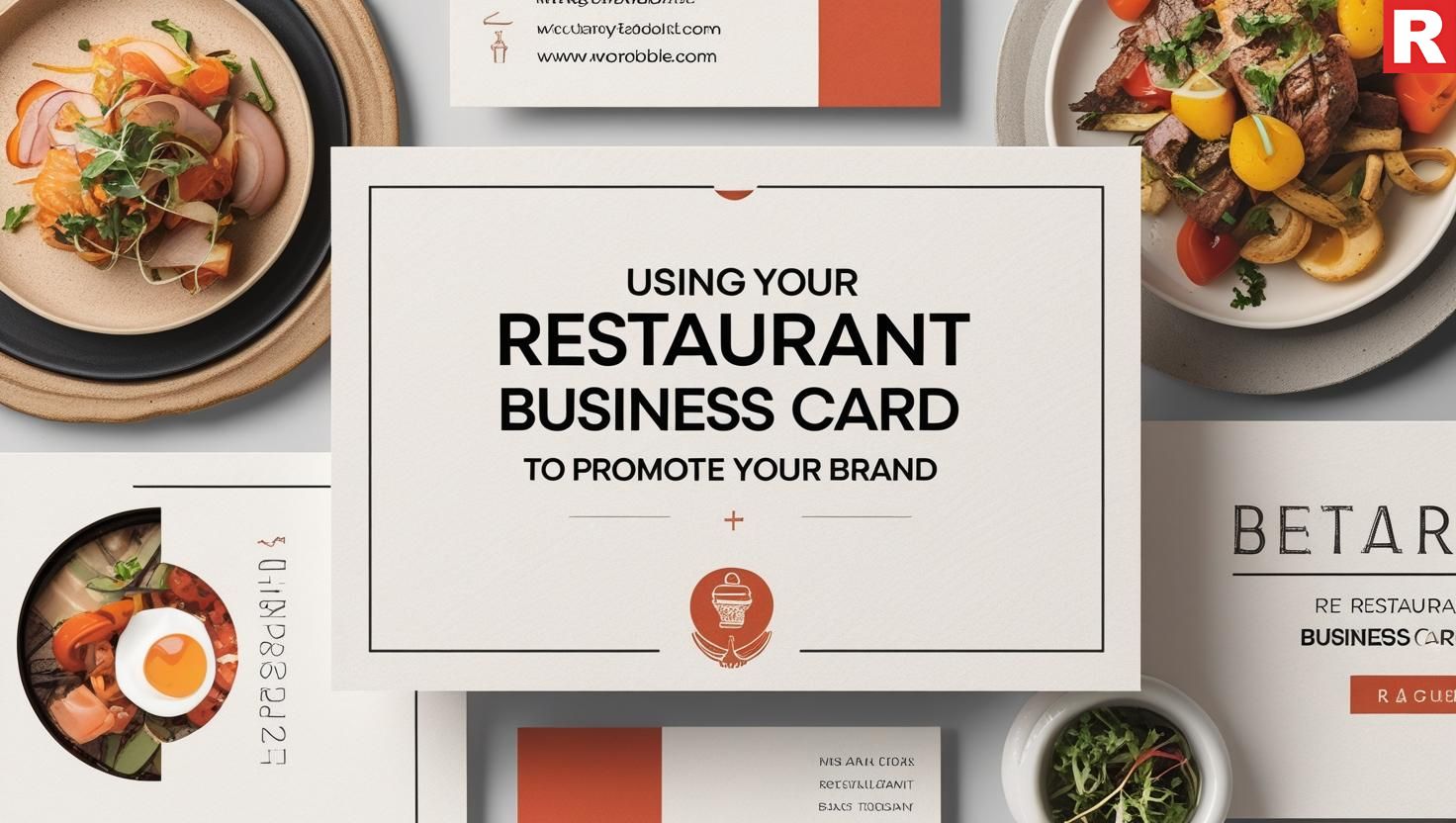
There is much more to a business card than merely a contact card. Here are some clever strategies to make the most of it as a marketing tool:
- The Loyalty Punch Card: This is a traditional and successful strategy. A basic pattern of a punch-hole stamp can be created on the back of the card. After a predetermined number of visits, customers can receive a complimentary item, such as coffee or a starter. It's a low-cost method of measuring customer engagement and promoting repeat business.
- The Mini-Menu Card: Highlight a specialty dish, daily special, or new seasonal item on the back of your business card. This acts as a mouthwatering reminder and invites the customers to visit and sample the meal.
- The Revolution of QR Codes: A QR code serves as a strong link between your online image and your physical card. It can be scanned to:
- Provide a direct link to your reservation system online.
- Redirect clients to your online menu.
- Direct them to your website's special offer page.
- Encourage them to become your social media followers.
- Allow them to post a review on Zomato or Google.
- Connect them to your Wi-Fi password.
Read this: 10 Facts You Should Know About Frozen Desserts
Conclusion
By no means is the restaurant business card a thing of the past. It is a strong, affordable tool that can strengthen your brand, increase your customer base, and close the gap between your online and offline presence when used carefully and properly. You may make a business card that not only reflects your restaurant but also leaves a lasting impression by emphasizing a clear message, premium materials, and a clean design. In a market that is highly competitive, a tiny investment can provide significant returns.

Born roughly between the mid-1990s and the early 2010s, Generation Z is a demographic group that possesses significant purchasing power and influence. Having grown up in the era of social media and the internet, this generation takes a completely different approach to dining and brand interaction than the previous generations. Therefore, restaurateurs need unique marketing ideas to appeal to Gen Z people. Understanding and successfully marketing to Gen Z is not an option for restaurants hoping to prosper in the years to come; rather, it is an essential element of sustainability and long-term success.
This in-depth article will explore the thoughts, digital habits, and expectations of Gen Z customers with regard to restaurant businesses. In order to create a Gen Z-centric marketing strategy that connects honestly, nurtures loyalty, increases foot traffic (and online orders), and establishes your restaurant as a destination for this important age group, we will provide you with practical techniques and creative tactics.
Read more: Top 20 Trendy Whiskeys You Must Try Once
Understanding the Gen Z Population
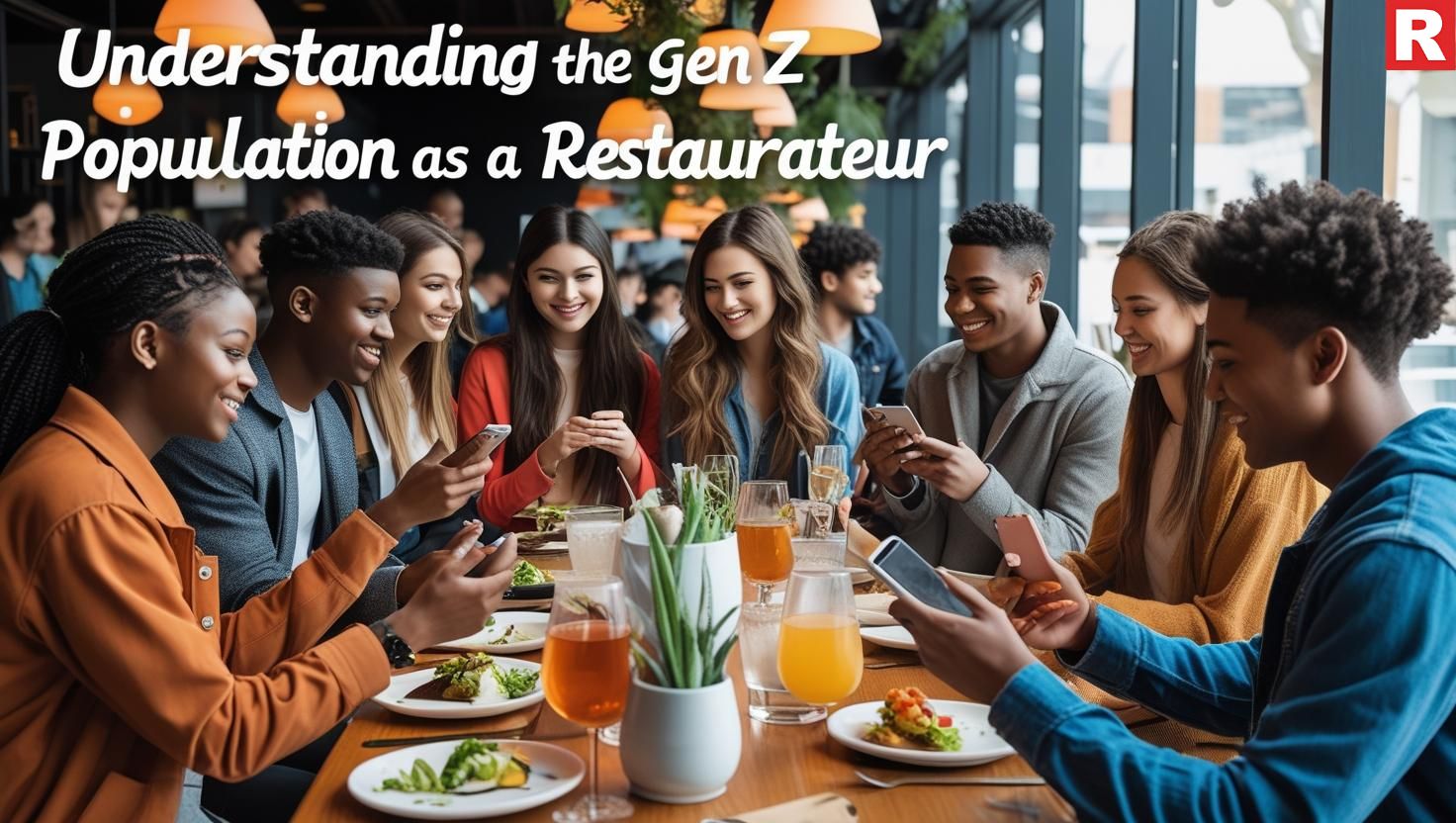
When marketing to Gen Z, it's critical to get beyond the common stereotype that casts them as only "tech-savvy." Here is a closer examination of their main behaviors and values:
- Digital natives: Gen Z are those who have never known a world without smartphones and the internet. Their main source of social connection, entertainment, and information is and has always been digital platforms.
- Value Honesty and Transparency: Gen Z has a keen sense of perception and can recognize overly professional or fake marketing with ease. They are drawn to businesses that are sincere, open, and have a vision.
- Socially Conscious: Social and environmental issues are very important to this generation. They frequently decide to back businesses that share their beliefs and show a dedication to making a positive impact.
- Visual Learners and Content Consumers: They use YouTube, Instagram, Twitter, and other sites to absorb a lot of visual content, such as videos, pictures, and memes.
- Seek Customization and Personalization: Gen Z expects brands to be aware of their unique tastes and provide experiences that are tailored to them.
- Value Efficiency and Convenience: Having grown up in an on-demand society, they expect easy online ordering, quick customer support, and easy ways to make payments.
- Value-Driven yet Price-Conscious: Although Gen Z is budget-conscious, they are prepared to pay for experiences and quality that reflect their views.
- Influenced by Peers and Creators: Rather than traditional advertising, they mainly rely on referrals from friends, family, and reliable internet creators or influencers.
The Gen Z Marketing for Restaurants: Strategies for Success

Now that we somehow understand Gen Z’s preferences and values, let’s take a look at the strategies to attract this population:
1. Dominate the Digital Landscape
Mobile-First Strategy: Make sure your online ordering system and website are completely responsive for mobile devices. Gen Z mostly browses and makes decisions on their smartphones.
Having a vibrant and active social media presence:
- Instagram: Put an emphasis on aesthetically pleasing content, such as crisp images and brief, captivating videos showcasing your cuisine, atmosphere, and behind-the-scenes activities. Engage your followers by using essential local hashtags.
- YouTube: Post longer-form videos, such as restaurant vlogs, cooking lessons, or chef interviews.
Smooth Online Ordering and Delivery: Collaborate with well-known food delivery services and make sure your online ordering platform is easy to use, effective, and customizable.
Apply User-Generated Content (UGC): Give your restaurant a special hashtag to encourage customers to post images and videos of their eating experiences. Reposting and interacting with user-generated content fosters authenticity and community.
Employ Location-Based Marketing: To reach Gen Z in particular neighborhoods, make use of social media's location-based features and look into local collaborations.
Know more: What’s Brewing: Importance of Customer Feedback
2. Embrace Authenticity and Transparency
Don't Just Tell, Show: Give a behind-the-scenes look at your kitchen, showcase your staff, and explain the origins of your dishes. Gen Z finds immense value in authenticity.
Be Open About Foods and Sourcing: Emphasize in your marketing that you use sustainable or locally sourced foods whenever possible. Gen Z is concerned about the origins of their food.
Own Your Errors: If you make a mistake, be upfront and honest about it on the internet. Transparency demonstrates accountability and builds confidence.
Encourage Social Causes: Assist with projects that have a beneficial effect on the community and align your business with environmental or social causes that appeal to Generation Z.
3. Leverage the Power of Influencers and Creators
Collaborate with nearby Gen Z food bloggers and micro-influencers: Work together with real voices in your area who genuinely connect with their audience.
Provide Special Experiences and Partnerships: Rather than merely providing complimentary meals, think about collaborating with influencers to co-create content, organize events, or provide special menu items.
4. Create Shareable Experiences
Visually Appealing Food Presentation: Make sure your food looks as good as it tastes on Instagram. Be mindful of appearance and plating.
Unique Ambiance and Decor: Make your space visually captivating and appealing so that Gen Z will want to take pictures and post them.
Interactive Features: Take into account adding interactive features to your restaurant, like picture booths or eye-catching menu displays.
Conduct Giveaways and Contests: Plan giveaways and contests on social media to promote involvement and sharing.
What's new: Your Guide to Influencer Marketing in Restaurants
5. Personalization and Customization
Offer Personalized Menu Options: Let clients alter their orders according to their dietary needs or preferences.
Use Data to Learn About Preferences: If you have an online ordering platform or loyalty program, use data to understand client preferences and provide tailored recommendations. This should be done with the consent of the customer.
Communicate Directly: Answer messages and comments on social media in a timely and considerate manner.
6. Meeting Their Expectations
Provide Competitive Pricing and Value for Money: Although Gen Z is not mainly driven by cost, they believe in a good deal. Emphasize exclusive deals and promotions.
Simplified Ordering and Payment Procedures: Make sure your in-restaurant payment and online ordering processes are safe, quick, and simple. Provide a variety of payment methods, such as digital wallets.
Loyalty Programs with Relevant Rewards: Create loyalty programs that provide Gen Z with observable and useful rewards, including early access to new menu items or exclusive discounts.
7. Stay Ahead of Trends
Track Social Media and Internet Trends: Keep a careful eye on what's popular on Gen Z-friendly platforms.
Try Out New Platforms and Technologies: Be open to experimenting with new digital marketing tools and social media platforms.
Modify Your Menu and Offerings: Keep up with changing dietary requirements and culinary trends, and be prepared to modify your menu as necessary.
Check out: 10 Facts You Should Know About Frozen Desserts
The Ultimate Guide to Food Photography for Indian Restaurants
Building a Community, Not Just a Customer Base
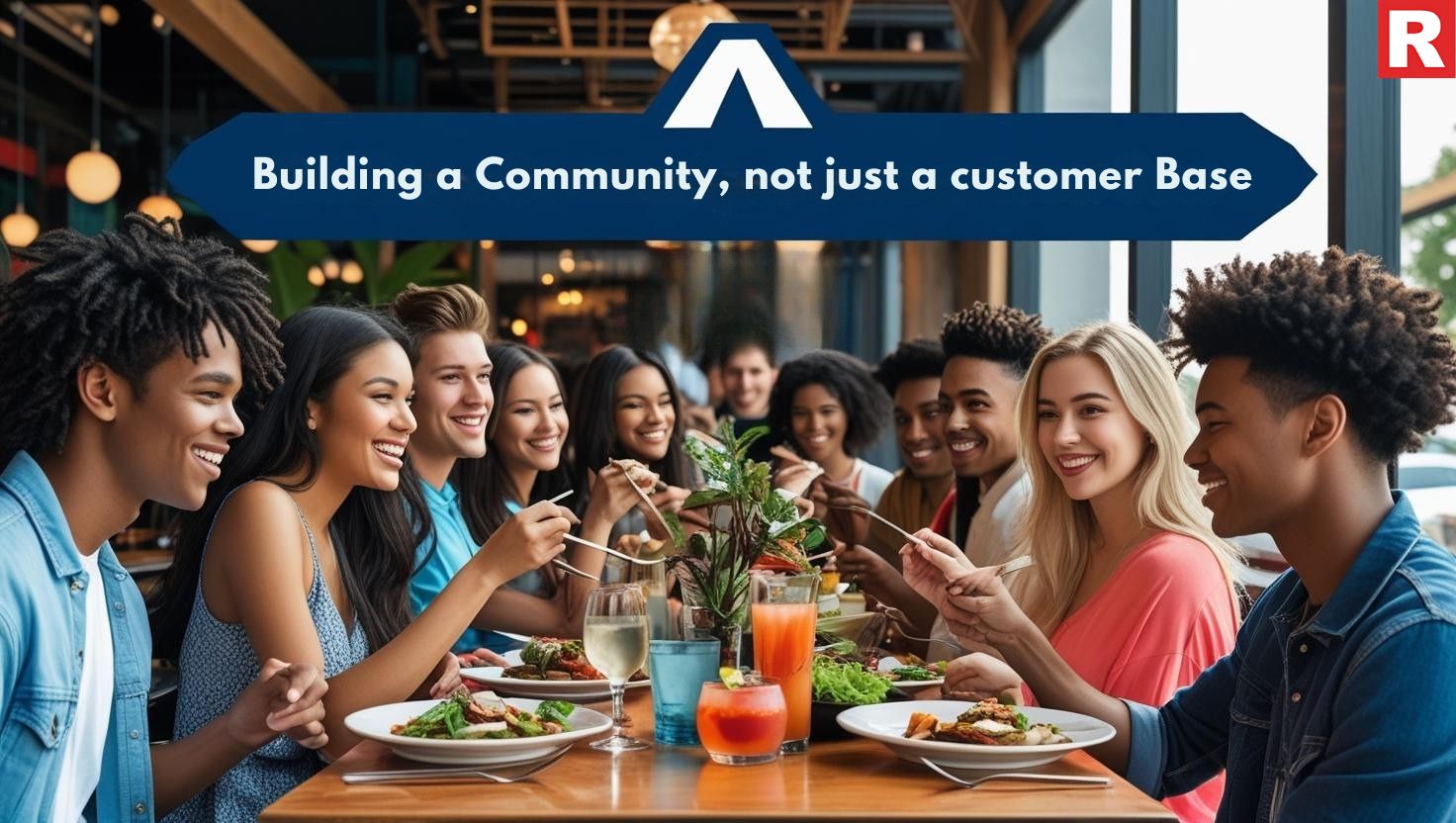
Loyalty for Gen Z goes beyond enjoying delicious meals; it also involves a sense of community and belonging. By actively developing a community around your brand, your restaurant can promote this:
- Specialized Nights and Events: Plan frequent specialized evenings that appeal to particular hobbies of the Gen Z population. These could include open mic nights, quiz nights centered around pop culture or popular subjects, live music events with local Gen Z musicians, or even joint ventures with other Gen Z-focused local companies (e.g., gaming). cafes, clothes boutiques). Actively publicize these events on social media to generate excitement and give Gen Z a cause to visit your business.
- Exclusive Online Forums and Groups: Create private groups on social media sites like Instagram or even Discord so that devoted Gen Z customers can communicate with your restaurant staff and one another. Give members-only discounts or early access to events, seek comments, conduct surveys on possible offerings, and share exclusive first looks at new menu items. This increases their bond with your brand and gives them a feeling of insider status.
- Collaborations with Local Gen Z Creatives: Collaborate with up-and-coming singers, artists, or other creatives to display their work in your restaurant. This may be putting on acoustic performances, showcasing artwork, or working together to create limited-edition goods. In addition to giving local talent exposure, this establishes your restaurant as a promoter of the innovative spirit of the Gen Z community.
- Interactive In-Restaurant Experiences: Include design features in your restaurant that promote conversation and build a sense of community. A "share your dish" photo wall where customers may tag your restaurant, conversation-friendly communal seating spaces, or even interactive screens with food and local culture-related quizzes or polls could be examples of this.
- React and Participate Authentically: Take an active part in discussions on your online forums and social media platforms. Answer messages and comments on time and with sincerity. Demonstrate your appreciation for their thoughts and your attention to their input. In order to gain Gen Z's trust and loyalty, this human touch is essential.
Measuring Your Success: Tracking Gen Z Engagement
Monitoring the success of your Gen Z marketing initiatives is essential:
- Monitor Social Media Metrics: Keep an eye on your social media metrics, including follower growth, reach, and engagement rates (likes, comments, and shares).
- Examine Website and Online Ordering Traffic: Track online order rates and keep an eye on social media traffic.
- Monitor Brand Emotion and Mentions: Find out what Gen Z is saying about your restaurant on the internet.
- Obtain Gen Z Customers' Input: Ask younger consumers directly for their opinions to find out what appeals to them.
- Use Unique Promotion Codes: To monitor the effect of campaigns aimed at Gen Z on sales, provide them with unique promotion codes.
Read this: Top 10 Foods to Boost Your Mineral Intake Naturally
Conclusion
Marketing to Gen Z requires a mentality change and a readiness to accept the digital-first, genuine, and socially concerned ideals of this significant generation. In order to secure a tasty and prosperous future, restaurants can successfully attract the attention, loyalty, and spending power of Gen Z by learning about their preferences, utilizing the appropriate digital channels, emphasizing authenticity, producing shareable experiences, and consistently adjusting to trends. Keep in mind that the secret to creating enduring relationships with this vibrant and demanding group is to connect authentically and offer value.

Marketing is an important part of any restaurant’s operations, whether it be a small mobile restaurant or a big dining establishment. The restaurant has to use many marketing strategies to get the attention of as many customers as they can. Influencer marketing is one of them. It is a digital marketing strategy to bring in customers through trusted social media influencers. The world of traditional advertising has essentially declined with the rise of the internet. Therefore, you should consider influencer marketing if you want more people to know about your business.
Understanding and using influencer marketing effectively is now a strategic necessity for restaurant owners who want to stand out from their competition, increase brand recognition, draw in fresh customers, and cultivate customer loyalty. With practical advice and insights designed especially for the restaurant sector, this in-depth article will help you understand the complex world of influencer marketing and even help you use the power of influence to achieve success.
Read more: 10 Facts You Should Know About Frozen Desserts
Why People Trust Influencers?
- Authenticity and Relatability: Influencers create trust by producing content that isn't a business advertisement but rather feels real and intimate. Their followers regard them as real people with similar interests.
- Sense of Community: A strong sense of community and connection is created when followers interact with influencers in both directions. Because of this, their suggestions seem like advice from a reliable friend.
- Specialized Knowledge: Whether it's technology, fitness, or food, a lot of influencers are regarded as authorities in their fields. Their audience values their viewpoints because of their specific knowledge and regular content.
- Social Proof: Influencers' promotion of a good or service acts as social proof. Their followers are inspired to follow suit after realizing how appealing and worthwhile the product is.
- Visual and Captivating Content: Influencers frequently create excellent, eye-catching content that captivates readers. Compared to a static, traditional commercial, this kind of material is significantly more memorable and interesting.
Why Restaurants Need Influencer Marketing

The restaurant industry is competitive and diverse. It takes more than simply mouthwatering food to stand out; you also need to connect with your target audience and communicate effectively. Influencer marketing provides a special means of doing this:
- Establishing Credibility and Trust: Influencers have built a devoted fan base by being genuine and knowledgeable about a certain subject, usually food and lifestyle. The advice of these trustworthy individuals is more credible than traditional advertising.
- Reaching a Targeted Audience: To make sure your message reaches the appropriate individuals, you may carefully collaborate with influencers whose followers are similar to the target demographic for your restaurant.
- Producing Real Content: Influencers provide authentic and captivating content (pictures, videos, narratives, and reviews) that presents your restaurant in an approachable and alluring manner. Consumers might find this user-generated content to be more genuine and reliable.
- Increasing Brand Awareness and Visibility: Working with influencers can help your restaurant reach a larger audience so that your brand is widely known.
- Increasing Customer Traffic and Online Orders: Influencers' positive reviews and eye-catching content can greatly boost both online delivery orders and visitors to your physical store.
- Creating Social Proof: Influencers who talk about their satisfying dining experiences at your restaurant serve as social evidence, confirming your excellence and luring new customers.
Know more: Top 10 Foods to Boost Your Mineral Intake Naturally
Finding The Right Influencer For Your Restaurant
Finding the right influencer to collaborate with is essential to the success of any influencer marketing campaign. To find your ideal influencers, follow these steps:
- Identify Your Target Market: Know exactly who you're attempting to reach. What are their internet habits, hobbies, and demographics? This will assist you in finding influencers with similar audiences to your own.
- Look for Local Food Critics and Bloggers: There are probably YouTubers, Instagrammers, and food bloggers who are enthusiastic about the region's food culture.
- Evaluate Their Content Style and Niche: Examine their content to make sure it reflects the style and ideals of your business. Do they specialize in a particular cuisine, street food, casual eating, or gourmet dining?
- Examine Their Engagement Rate: The high follower count doesn't create a high-level influencer. Popularity isn't always connected with the number of followers. Examine their follower numbers with their engagement rate (likes, comments, and shares). An audience that is truly engaged is one that is interested and active.
- Verify Their Credibility and Authenticity: Seek out authentic evaluations and stay clear of influencers who appear to blindly support every good or service. Being genuine is essential for gaining the audience's trust.
- Think About Micro-Influencers: Don't just concentrate on influencers that have large fan bases. Micro-influencers, or those with a more specialized, smaller following, can be more affordable and frequently have higher engagement rates.
- Use Influencer Marketing Services: Depending on your location and criteria, a number of internet services can assist you in finding and managing influencers.
The Strategic Approach to Restaurant Influencer Marketing

Apply the following three steps to develop an effective influencer marketing strategy for your restaurant:
- Set Your Budget and Goals: Start by laying out your goals in detail, such as raising online sales or brand recognition. Determine a reasonable budget while keeping these objectives in mind. This budget could include cash payment, complimentary meals, or a mix of incentives for the influencer.
- Describe the Messaging and Campaign Goals: Clearly state the goals of the campaign. Describe the steps you want the influencer to take, such as organizing giveaways and producing content. To maintain brand consistency, create a clear tone that emphasizes your restaurant's special features and overall dining experience.
- Have Clear Guidelines and Disclosure: Establish clear guidelines for brand portrayal to protect both your brand and the authenticity of the influencer. This involves deciding which recipes to highlight and making sure the influencer appropriately notifies their audience about the partnership.
What's new: The Ultimate Guide to Food Photography for Indian Restaurants
Reaching Out and Collaborating with Influencers

- Tailored Appeal: To demonstrate your genuine appreciation for the influencer's work and your belief that their audience would be interested in your restaurant, research their material and modify your message accordingly. Stay clear of basic marketing messages.
- Provide Value: Clearly outline the advantages of working with your restaurant. This could be a financial salary, a free meal, or exposure to a new audience.
- Create a Sincere Connection: Treat the cooperation as a partnership as opposed to a business deal. Pay attention to their suggestions and feedback.
- Give the Influencer a Wonderful Experience: Make sure the influencer has a satisfying and unforgettable meal at your restaurant. Present your best meals and provide outstanding service.
- Allow Them Creative Freedom: Have faith in the influencer's ability to produce interesting content for their followers. It's important to offer guidelines, but don't be too restrictive.
- Talk about Deliveries and Timelines: Clearly state the content you expect, the platforms on which it will be shared, and the deadlines that have been agreed upon.
- Track Performance and Measure Outcomes: Utilize analytics tools to monitor website traffic, social media engagement, and online orders as indicators of the influence of your influencer partnerships.
Check out: How to Get A Government Loan for Your Restaurant Business
How to Shield Your Restaurant Business from Failing
Different Types of Influencer Collaborations for Restaurants
- Free Lunch Reviews: Provide influencers with a complimentary lunch in return for an honest blog or social media review.
- Sponsored Posts: Pay influencers to produce videos or posts that highlight particular features of your restaurant and draw attention to them.
- Social Media Takeovers: Allow an influencer to take over your restaurant's social media accounts for a day in order to share live updates or behind-the-scenes photos.
- Giveaways and Contests: Collaborate with influencers to organize giveaways or contests that motivate their followers to interact with your business.
- Collaborations on Events: Invite influencers to your restaurant's special events, such as tastings or menu launches.
- Long-Term Partnerships: If you want to make a lasting impression, think about forming long-term relationships with important influencers who sincerely love your business.
Read this: How to Grow Your Restaurant Into A Franchise
Measuring the Success of Your Influencer Marketing Efforts
To determine the results and return on investment (ROI) of your influencer marketing programs, you must monitor their performance:
- Track Social Media Engagement and Website Traffic: Keep an eye out for any spikes in social media followers, likes, comments, shares, and website visits both during and after an influencer partnership.
- Track Online Reservations and Orders: If increasing sales is your aim, keep an eye out for any increases in online reservations or orders that may be related to influencer activity.
- Use Special Discount Codes or Tracking Links: Give influencers special discount codes or tracking links so you can immediately credit their work for sales or website traffic.
- Get Customer Input: Find out how new customers found your restaurant. Keep track of this information if they name an influencer.
- Calculate Your ROI: Determine Your ROI by weighing the money you made from your influencer partnership against the expenses incurred (such as salary or complimentary meals).
Conclusion
Restaurants have a great chance to engage and establish a genuine connection with their target audience through influencer marketing. You can use the power of influence to increase brand awareness, drive customer traffic, and ultimately serve up long-lasting success in the cutthroat culinary market by knowing the local influencer landscape, developing a strategic approach, forming sincere partnerships, and regularly measuring results. Accept this modern marketing tool, and you'll see your restaurant's reach and reputation grow.

Do you know what makes a dish appealing to a restaurant's customers? Of course, the aroma, spices, and price are the biggest factors. But it can only work if the customer is already familiar with the dish. If a customer ordered a dish only based on its name, they would be puzzled. For example, if a dish is called “Dal Espresso,” the customer will be confused about whether it is a lentil dish or a coffee. In such cases, a picture of the dish becomes more important. The most special dish of your restaurant can look dull if it doesn't have a picture of it. This makes food photography even more important for the restaurant.
With food photography, a restaurant can grab the attention of customers in an instant. Therefore, in this article, we will look at the art and science of taking wonderful food images that not only look great but also communicate your restaurant's story, promote your brand, and ultimately increase reservations and online orders. This article will teach you everything you need to know about lighting and composition, as well as how to master style approaches that highlight the unique appeal of Indian cuisine.
What is Food Photography?
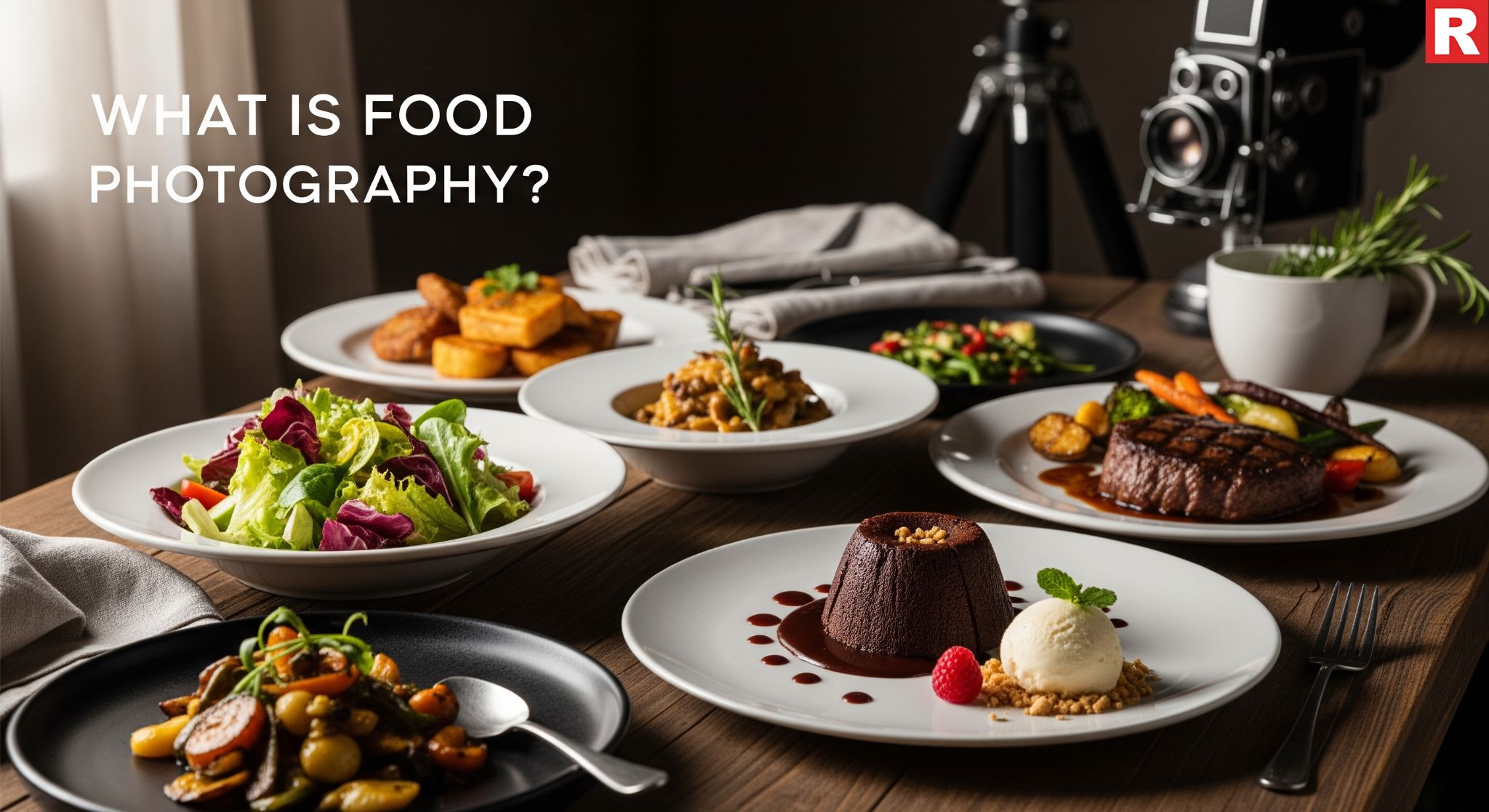
Read more: 10 Facts You Should Know About Frozen Desserts
Food photography is the art of capturing photos of food in such a way that it appears as appetizing and tempting as possible. It's a type of still-life photography that highlights a dish's textures, colors, and details through lighting, styling, and arrangement. The idea is to create a want or craving for the meal, transforming a basic visual into an effective marketing tool. In today's digital age, food photography is critical for restaurants to attract customers and establish a strong brand identity on social media and other online platforms. Food photography is ultimately used for the following purposes:
- To show photos of the dish in the physical menu to the dine-in customers.
- To show photos on websites like food ordering platforms or a digital menu of the restaurant.
- Various food bloggers or influencers use food photography in their work.
Why Food Photography Is Non-Negotiable for Restaurants
Food photography has multiple benefits for your restaurant in a visually overwhelmed digital world. So it is non-negotiable for restaurants not to use food photography.
- First Impression Matters: For potential customers looking through Instagram or online delivery platforms, your food images are frequently their first impression of your business. Visually appealing content can influence whether people click to learn more or scroll past.
- Showcasing Your Culinary Skills: Indian cuisine is a brilliant mix of colors, textures, and subtle details. High-quality photography allows you to demonstrate the skill and artistry that goes into making your meals.
- Building Brand Identity: Consistent and visually appealing photographs help to create a strong and recognizable brand identity for your restaurant. Your picture style can convey your restaurant's atmosphere, cuisine focus, and general personality.
- Driving Engagement and Traffic: Delicious food photos are easily shared and engaging on social media. They can generate likes, comments, and shares, boosting your restaurant's visibility and bringing visitors to both online and physical locations.
- Increasing Online Orders: For restaurants that provide online delivery, captivating food photographs on your website and delivery partner applications can have a major impact on customers' ordering decisions.
- Creating a Visual Menu: High-quality photographs act as a visual menu for your online audience, allowing people to better grasp what you have to offer and make rational choices.
The Essential Elements of Great Food Photography

Food photography can capture the essence of the dish and make it more appealing to the public.
1. Lighting
Lighting is undoubtedly the most important aspect of food photography. It sets the tone, reveals textures, and accentuates the colors of your dishes.
- Natural Light: When possible, use natural lighting. Position your food near a window to take advantage of the soft, indirect sunlight. Avoid direct sunlight, which can cast harsh shadows and produce unpleasant highlights.
- Side Lighting: Placing your food to the side of a light source (natural or artificial) frequently produces beautiful shadows that add depth and richness to the shot.
- Diffusing Light: If natural light is excessively bright, use a diffuser (a thin white cloth or paper) to soften it and reduce the appearance of harsh shadows.
- Artificial Light: If natural light is unavailable, consider purchasing steady LED lights with diffusers. Avoid using your camera's built-in flash, as it often produces harsh and unpleasant effects.
- Understanding Shadows: Pay close attention to the shadows in your frame. Soft shadows can create depth; however, strong or distracting shadows should be avoided.
Know this: Top 10 Foods to Boost Your Mineral Intake Naturally
2. Composition
Composition is how you organize the items in your frame. A well-composed photograph draws the viewer's attention and produces a visually appealing image.
- The Rule of Thirds: Consider splitting your frame into nine equal portions using two horizontal and two vertical lines. Placing your theme or important pieces along these lines or at their intersections frequently results in a balanced and compelling composition.
- Leading Lines: Use lines (such as a row of kebabs or a swirl of sauce) to guide the viewer's eye through the image and towards the main subject.
- Negative Space: Don't be afraid of the space in your frame. Negative space can help you highlight your subject while also creating a sense of a state of balance.
- Angles & Perspectives: Experiment with various shooting angles. Overhead (flat lay) pictures are ideal for highlighting the entire dish and its components. Eye-level images can provide a closer and more realistic experience. 45-degree angles provide an appropriate balance of showing the top and front of the dish.
- Layering and Depth: Create interest in your image by layering items in your frame. This could include arranging garnishes on top of the main dish, putting objects in the background, or using props to add depth.
What's new: How to Get A Government Loan for Your Restaurant Business
3. Styling
Food styling involves setting up the food and adding props to make the dish as appealing as possible.
- Fresh Ingredients Are Key: Use only the freshest, most visually pleasing ingredients. Wilted or bruised pieces can belittle the image.
- Garnishes with a Purpose: Place garnishes strategically to enhance color, texture, and visual appeal. Choose garnishes that enhance the food without overpowering it. Fresh herbs, edible flowers, a sprinkling of spices, or a drizzle of sauce can make a significant difference.
- Plating Matters: Pay close attention to how the food is plated. Arrange the ingredients cautiously to prevent cluttering the platter. Wipe away any smudges or spills.
- Props That Create a Story: Use props (such as flatware, plates, bowls, linens, and ingredients) to provide context and create a story about your restaurant and the dish. Select props that complement the decor and food of your restaurant. You might make a rustic Indian dish with ceramics and natural materials.
- Creating Texture: Emphasize the various textures in your meal. This could include demonstrating the crispiness of fried foods, the smoothness of a sauce, or the fluffiness of rice.
- Color Harmony: Be aware of the colors in your frame. Contrasting colors will make your subject stand out, while complementary colors will provide a design that is stronger. Indian cuisine provides a rich palette to work with.
Check out: How to Shield Your Restaurant Business from Failing
Obbattu Recipe – Authentic Karnataka Sweet for Festive Menus & Dessert Lovers
4. The Finishing Touches
While capturing a stunning image in-camera is vital, post-processing can help to improve and polish your photos.
- Use Editing Programs Wisely: There are numerous user-friendly mobile editing programs (such as Snapseed, VSCO, and Adobe Lightroom Mobile) that can help you change brightness, contrast, saturation, sharpness, and white balance.
- Subtle Enhancements Are Best: Avoid overediting your images, which can make the meal appear fake and unappealing. The idea is to bring out the natural beauty of the meal.
- Maintain Consistency: Create a consistent editing style for all of your photographs to ensure that your brand's visual content looks harmonious.
- Cropping and Straightening: Crop your photographs to improve composition and keep horizontal and vertical lines straight.
Specific Tips for Photographing Indian Cuisine
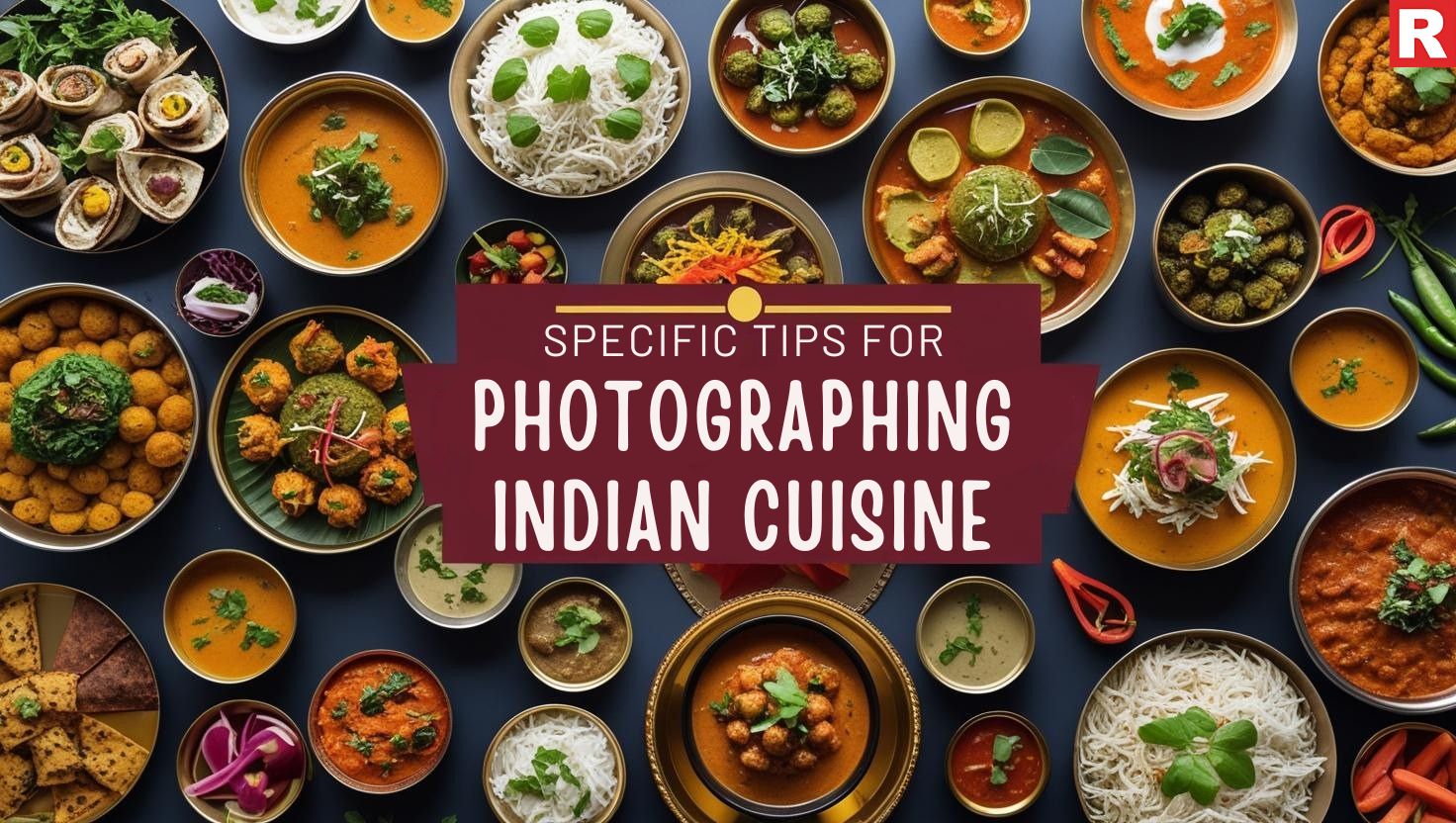
Indian food offers different possibilities as well as challenges for photography.
Embrace the hues: Indian cuisine is typically filled with vivid colors. Use lighting and editing to really make these colors stand out.
Highlight the Textures: From the crispy outside of a samosa to the creamy texture of dal makhani, emphasize the various textures in your food.
Don't Be Afraid of Spice: A sprinkle of red chili powder or a few whole spices can give visual appeal and hint at the flavor.
Highlight the Gravies and Sauces: Rich gravies and sauces are frequently the standouts of Indian food. Use angles to highlight their deliciousness.
Capture the Steam: Dishes that are gently steaming might appear to be very appealing. Capture the steam rising as you take the photograph.
Use Traditional Indian Props: Props such as serveware, spices in miniature bowls, or patterned fabrics can be used to offer authenticity and cultural context.
Read this: Picante Cocktail Recipe: The Spicy-Sweet Drink Taking Over Cocktail Menus
Conclusion
In a competitive dining environment, impressing your audience visually is equally crucial to appealing to their taste sensations. Mastering the foundations of food photography, such as light, composition, style, and post-processing, will allow you to transform your meals into tempting visual material that draws guests, grows your brand, and eventually adds to the success of your Indian restaurant. Embrace the art of displaying your luxurious delicacies, one breathtaking shot at a time, and watch your restaurant's internet appeal grow.

As Independence day is around the corner, savour patriotism with tricolour specials and menus that pay tribute to India’s rich culinary heritage. Restaurants are serving up special menus, tricolour-themed delights, and patriotic dining experiences that pay homage to India’s rich culinary legacy. From timeless regional favourites with a modern twist to cocktails infused with bold desi flavours, these 15th August picks offer more than just indulgence—they’re a delicious tribute to the nation’s unity in diversity.
1. ITC Maratha , Mumbai
This Independence Day, ITC Maratha’s Peshwa Pavilion invites guests to savour ‘A Celebration of Flavour, the Indian Way’—a special lunch showcasing regional classics, aromatic spices, and homely ingredients. On August 15th, from 12:00 PM to 3:00 PM, enjoy a vibrant culinary journey across India for ₹3000 + taxes per person, featuring time-honored recipes and reimagined dishes.
Where: Sahar, Andheri East
2. Zaatar W Zeit, Mumbai
Zaatar W Zeit, the beloved Lebanese brand, marks Independence Day with its first-ever Indian-inspired menu—a year-round tribute to the country it now calls home. The “India Rolls” lineup blends ZWZ’s fresh Lebanese essence with bold Indian spices, featuring wraps like Shish Chicken Tikka, Shish Kabab, Butter Chicken, Shish Paneer Tikka, and the indulgent Zaatar Malai Paneer and Chicken Skillets. Available at Bandra and the new Andheri outlet, as well as via Zomato and Swiggy, this menu celebrates Indian flavours while staying true to ZWZ’s heritage.
Where:
• Bandra: Pali Naka, Bandra, Shop no 2, opp Jai Hind Lunch Home, Pali Naka Bandra (West)
• Andheri: B, Unit no 1 and 101, Boolani Estate Owner's Premises Co-Op Society Ltd, 41, New Link Rd, opposite Citi Mall, Andheri West
3. Sheraton Grand Pune Bund Garden Hotel, Pune
Celebrate India’s rich culinary heritage with a feast that journeys from north to south, east to west. Relish Mumbai’s Vada Pav with coconut chutney, regal Shahi Paneer Tikka Masala, Lucknow’s Awadhi Malai Kofta, and crisp South Indian Pesarattu. Indulge in Diwani Paneer Handi, Mutton Rogan Josh, and end on a sweet note with Kesar Pista Kulfi, Chhena Jalebi, Shrikhand, and Jalebi with Rabri. Refresh with Masala Chaas or Lemon Mint Cooler—a true tribute to the flavours of India. It’s available from 12.30pm to 4.30pm.
Where: Feast, Sheraton Grand Pune Bund Garden Hotel, Pune
4. 1932 Trevi, Jaipur
Celebrate freedom at 1932 Trevi—a serene garden escape in Jaipur where Indian heritage blends with Italian elegance. Sip gemstone-inspired cocktails, savour Lamb Pinwheel Lasagna, Smoked Caprese Pizza, and Truffle Porcini Ravioli, and enjoy timeless flavours, warm conversations, and the quiet luxury of marking the day your way.
Where: Ground Floor, Santha Bagh, Narayan Singh Circle, Jaipur
5. Eve, Santacruz
With chic interiors and cozy charm, Eve invites you to savour comfort food and monsoon-inspired cocktails. Enjoy bites like Baked Vada Pav, Kung Pao Cottage Cheese, and Lamb Seekh Kebabs, or dig into Burrata Saag with Makai Roti and Smoked Chicken Curry. Raise a toast with Tamarind Takedown or Mango Magic Potion, and soak in a festive, heartwarming experience. The Monsoon Menu runs till 7th September.
Where: 3RGQ+842, Willingdon, Santacruz (West)
6. Easy Boba
Easy Boba, India’s fastest-growing bubble tea sensation, is serving up more than just freedom—it's serving flavor, fun, and a full menu at just Rs.99. On August 15, bubble tea lovers across Mumbai and Gujarat can enjoy any drink from the Easy Boba menu for a flat Rs.99. Whether you're a Boba newbie or a die-hard fan, this is your moment to sip big, spend small. The celebration doesn’t stop there. Starting this August, the Rs.99 menu magic returns on the 15th of every month
Where: All Outlets in India
7. Courtyard by Marriott Bengaluru Hebbal
Courtyard by Marriott Bengaluru Hebbal invites you to celebrate Independence Day with a vibrant brunch at The Hebbal Café. Curated by Executive Chef Rajeev, the multi-cuisine buffet blends India’s culinary diversity with global flair, paired with live music and tricolour-themed cocktails. The flag-inspired décor sets a festive mood, while a dedicated kids’ area ensures fun for all ages. A perfect blend of flavour, culture, and celebration awaits this 15th August.
Where: The Hebbal Cafe, Courtyard by Marriott Bengaluru Hebbal
8. Sheraton Grand Bengaluru Hotel at Brigade Gateway
Sheraton Grand Bengaluru Hotel at Brigade Gateway invites you to savour August with a curated mix of seasonal cocktails, Japanese-inspired pours, botanical infusions, and Middle Eastern delights. Celebrate the monsoon at High Ultra Lounge with bold, refreshing drinks, panoramic city views, and the soothing rhythm of the rain.
Where: Sheraton Grand Bengaluru Hotel at Brigade Gateway
9. Noormahal Palace, Karnal at Haryana
This Independence Day, Brown Sugar at Noormahal Palace, Karnal, presents a special buffet inspired by the colors of the national flag. Relish starters like Tiranga Paneer Tikka, Azadi Murgh Malai Kebab, and a vibrant Freedom Chaat Platter, followed by mains such as Shaan-e-Hind Biryani, Subz Tiranga Kofta, Murg Handi Lazeez, and Deshbhakti Dal Tadka, paired with Indian breads and Tricolor Pulao. End on a sweet note with Tiranga Barfi, Kesari Rasmalai, Freedom Phirni, and Tricolor Mousse Cups, complemented by Jaljeera Shots, Saffron Lassi, and Nimbu Pudina Cooler—a true feast for the spirit of freedom.
Where: Brown Sugar, Noormahal Palace, Noormahal Crossing, National Highway 1, Sector 32, Karnal, Haryana 132001
10. SALT (Pan India)
SALT Indian Restaurant presents ‘Flavours of Freedom’, a special Independence Day cocktail and mocktail menu available across all outlets. Showcasing India’s vibrant flavours, the line-up blends tradition with innovation—like Agaaz, a bold mix of charred pineapple, black pepper, and lime; Agni Mora, a fiery blend of roasted red chilli, raw mango, and lime; Gul Bahar, a floral infusion of rose and cardamom; and Hari Saaz, a refreshing cucumber, coriander, and botanical gin creation. Available all month in Koramangala, Kalyan Nagar, UB, and Pune, each drink is a modern tribute to India’s culinary heritage in every sip.
Where: Salt (all outlets)
11. Andaz Delhi by Hyatt, New Delhi
Andaz Delhi, by Hyatt, rolls out a vibrant August line-up blending regional flavours, inventive cocktails, and interactive dining. At AnnaMaya, savour a Rajasthani-inspired Pan-to-Plate menu by Chef Mahendra Jakhar—featuring Laal Maas, Kabuli Pulao, Malai Ghewar, and more—available till 30th August (₹2,499++ lunch / ₹2,999++ dinner). From 15th–30th August, sip on the Himalayan Infusion cocktail (₹1,150++), a herb- and spice-forward creation inspired by mountain landscapes. At Soul Pantry, weekends come alive with Mamma Mia Mini Chefs!—a playful pizza-making class for kids (₹1,500++), where young bakers craft and bake their own creations.
Where: Andaz Delhi by Hyatt, New Delhi

Many people dream of owning and running a profitable restaurant in India. However, the initial investment required to start or expand a food business can be an important barrier. You see, opening and managing a restaurant requires a huge amount of investment. Fortunately, the Indian government provides a range of loan schemes and initiatives to help small and medium-sized businesses (SMEs), including restaurants.
Understanding the world of government loans can be difficult due to their complex processes and eligibility requirements. This article is specifically intended for interested and existing restaurant operators in India. We'll go over the most important government loan programs, explain the qualifying requirements, walk you through the application process, and give you valuable advice to improve your chances of getting the money you need to pursue your restaurant's dreams.
Read more: Picante Cocktail Recipe: The Spicy-Sweet Drink Taking Over Cocktail Menus
Why Government Loans are Crucial for Indian Restaurants
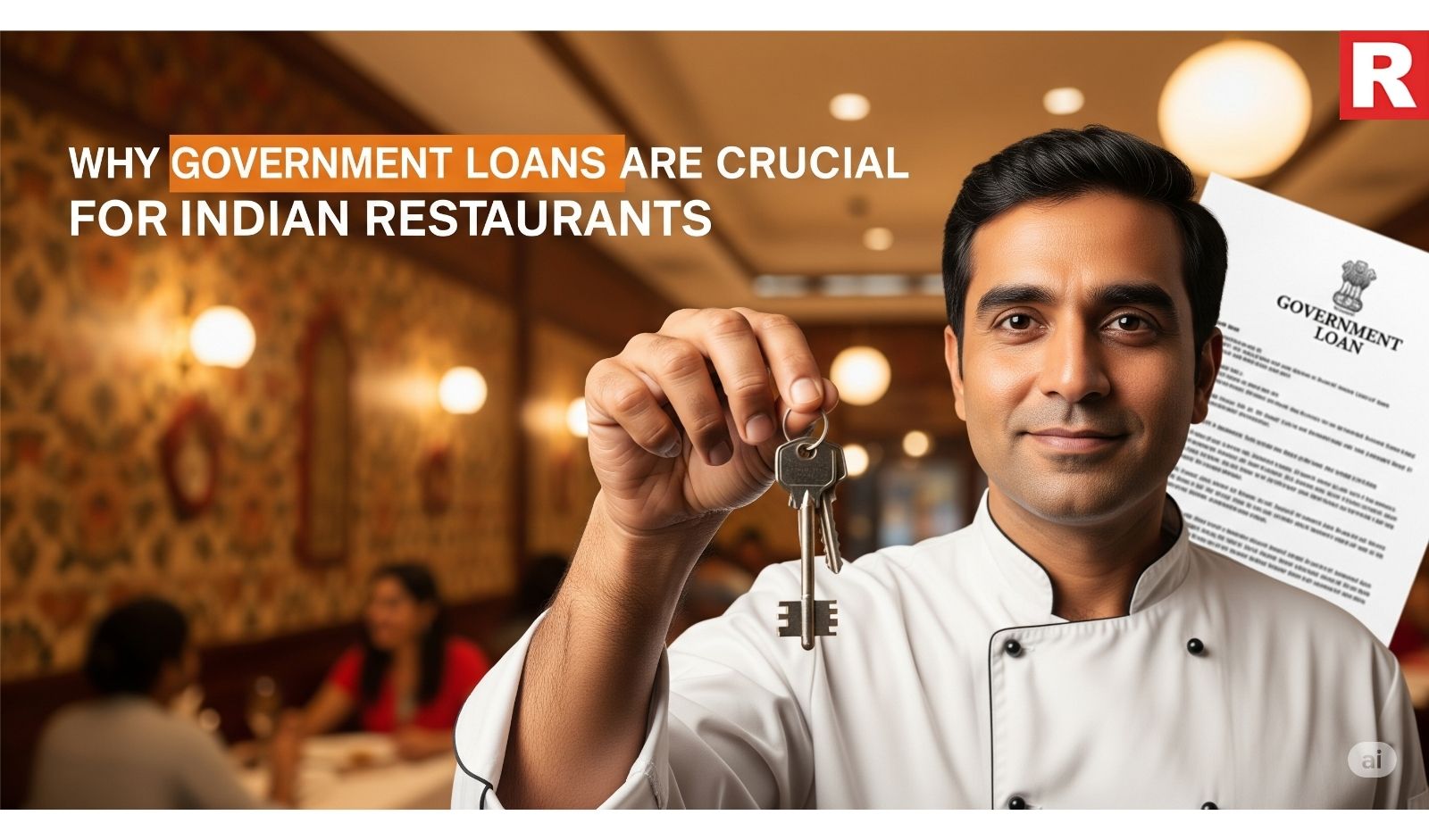
The food service sector in India is an important contributor to the economy, and the government acknowledges the need to promote its growth. Government loans provide various benefits to restaurant businesses:
- Lower Interest Rates: Government-backed schemes frequently offer lower interest rates than typical bank loans or private lenders, lowering the overall cost of borrowing. This is good for small restaurant owners.
- Easier Collateral Requirements: Some government schemes have simpler collateral requirements, making them more accessible to businesses with few financial assets.
- Focus on Certain Sectors: Many plans are designed to help certain sectors, such as SMEs (small and Medium Enterprises), the food processing industry, which directly benefits restaurants.
- Encouraging Business: Government loan efforts aim to promote entrepreneurship and generate job possibilities in the country, which nicely aligns with the interests of restaurant owners. After all, a single restaurant can provide employment to many people.
Key Government Loan Schemes for Restaurant Businesses in India
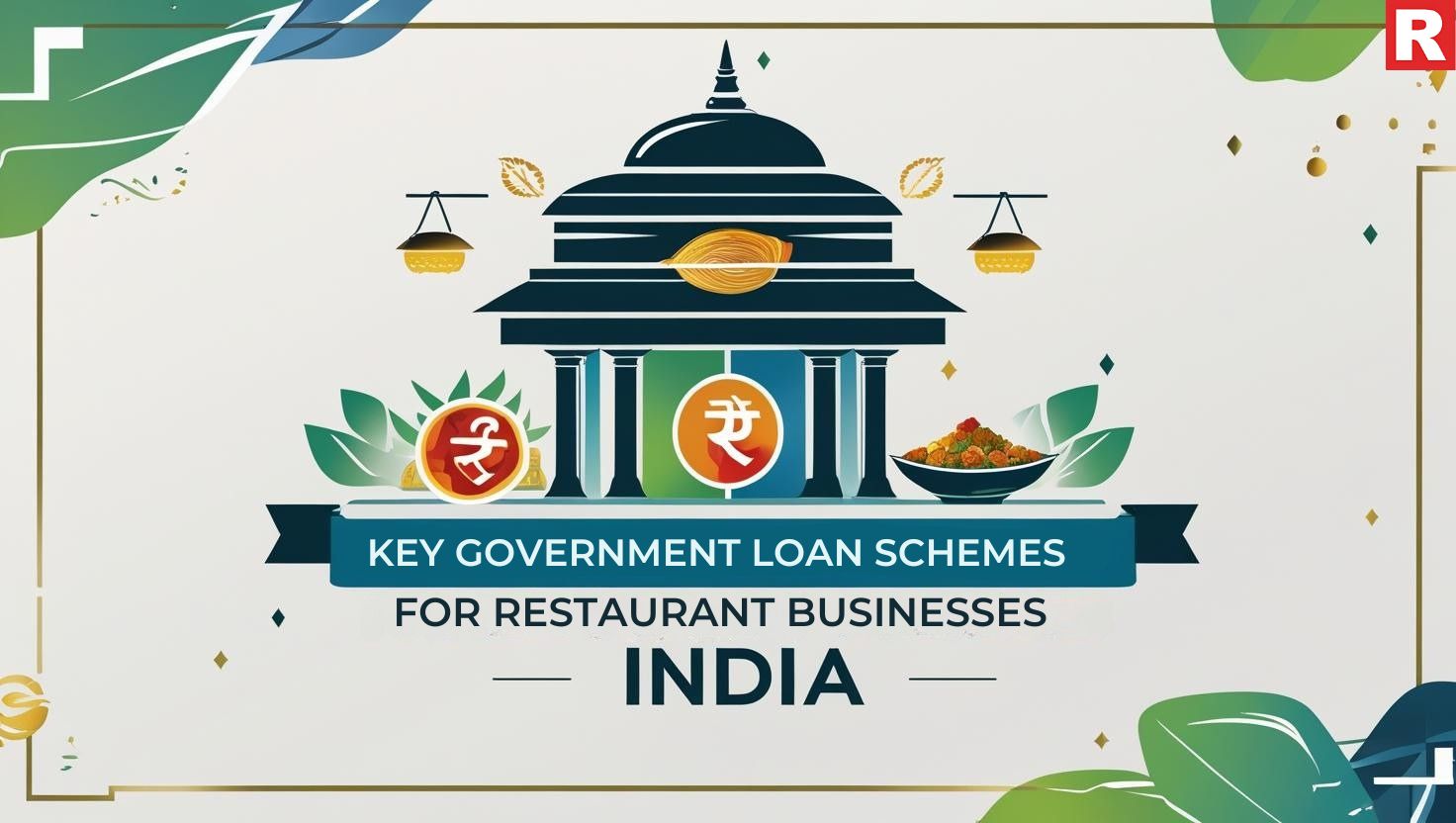
Several major government loan schemes can be beneficial for restaurant owners in India. Here are a few of the more relevant options:
1. Pradhan Mantri Mudra Yojana (PMMY)
PMMY is a major plan that aims to give financial assistance to non-corporate, non-farm small and micro enterprises. PMMY loans are grouped into three types:
- Shishu (up to ₹50,000) is ideal for launching a small restaurant or food stand.
- Kishore (₹50,001 to ₹5 lakh) is ideal for established small restaurants seeking to grow or upgrade equipment.
- Tarun (₹5 lakh to ₹10 lakh) is ideal for established restaurants seeking considerable expansion or remodeling.
- Tarun Plus (₹10 lakh to ₹20 lakh) is ideal for opening new restaurants.
Eligibility criteria: Indian citizens with a credible business proposal. Existing and new restaurants are eligible. Loans of up to ₹10 lakh under PMMY often do not require collateral.
How to Apply: You can apply to any Scheduled Commercial Bank, Regional Rural Bank (RRB), Small Finance Bank (SFB), Micro Finance Institution (MFI), or Non-Banking Financial Company (NBFC) that participates in the Mudra Yojana. You must submit an application form, a business plan, KYC documents, and other essential financial information.
Know more: How to Grow Your Restaurant Into A Franchise
2. Credit Guarantee Fund Trust for Micro and Small Enterprises (CGTMSE)
The CGTMSE provides assurances to banks and financial organizations for loans made to qualifying micro and small businesses, including restaurants. This decreases lenders' risk and encourages them to issue loans without strict collateral requirements.
Eligibility criteria: New or existing micro and small enterprises (as defined by the MSMED Act of 2006). Restaurants are often eligible for the service sector category. The CGTMSE scheme covers loans up to ₹2 crore.
How to Apply: You cannot apply directly to the CGTMSE. You must contact a CGTMSE-approved bank or financial institution. The lender will review your loan application and, if approved, secure CGTMSE guarantee cover.
3. Pradhan Mantri Employment Generation Programme (PMEGP)
PMEGP is a credit-linked subsidy program designed to provide job opportunities by aiding entrepreneurs in establishing new micro-enterprises. It is managed by the Ministry of Micro, Small, and Medium Enterprises (MoMSME).
Eligibility criteria: Individuals over the age of 18, Self Help Groups (SHGs), Registered Trusts, Educational Institutions, etc. Setting up a manufacturing unit costs ₹50 lakh, whereas a service sector unit (including restaurants) costs ₹20 lakh. The subsidy component varies depending on the beneficiary's category and the location of the unit (urban or rural).
How to apply: Prepare a project report and apply online through the Khadi and Village Industries Commission's PMEGP portal. Your application will be sent to the administering agency (KVIC/KVIB/DIC) in your district. After examination, you may be invited to an interview before the bank approves the loan.
4. National Small Industries Corporation (NSIC) Schemes
NSIC provides a variety of schemes to help the growth of small and medium-sized enterprises, including financial aid. Their programs frequently focus on technology upgrades, marketing assistance, and credit assistance.
Eligibility criteria: Micro, small, and medium-sized businesses, both existing and new. Restaurants wishing to modernize their culinary equipment or expand their facilities may find NSIC schemes useful.
How to Apply: To learn about individual schemes and the application process, go to the NSIC website or contact a branch in your area. In most cases, you must produce a complete project report as well as financial documents.
What's new: How to Shield Your Restaurant Business from Failing
5. Stand-Up India Scheme
The Stand-Up India Scheme is designed to encourage entrepreneurship among women, Scheduled Caste (SC), and Scheduled Tribe (ST) businesspeople. The scheme offers bank loans ranging from ₹10 lakh to ₹1 crore to at least one Scheduled Caste or Scheduled Tribe borrower and one woman borrower per bank branch for starting a greenfield firm (new venture).
Eligibility criteria: Entrepreneurs over the age of 18 who are women or SC/ST. The company should operate in the manufacturing, service, or trading sectors. Restaurants come under the service sector.
How to Apply: You can apply online through the Stand-Up India portal or go directly to a bank branch. The scheme also offers handholding assistance and credit guarantees through the Credit Guarantee Fund for Stand-Up India (CGFSI).
The Application Process: A Step-by-Step Guide for Restaurateurs
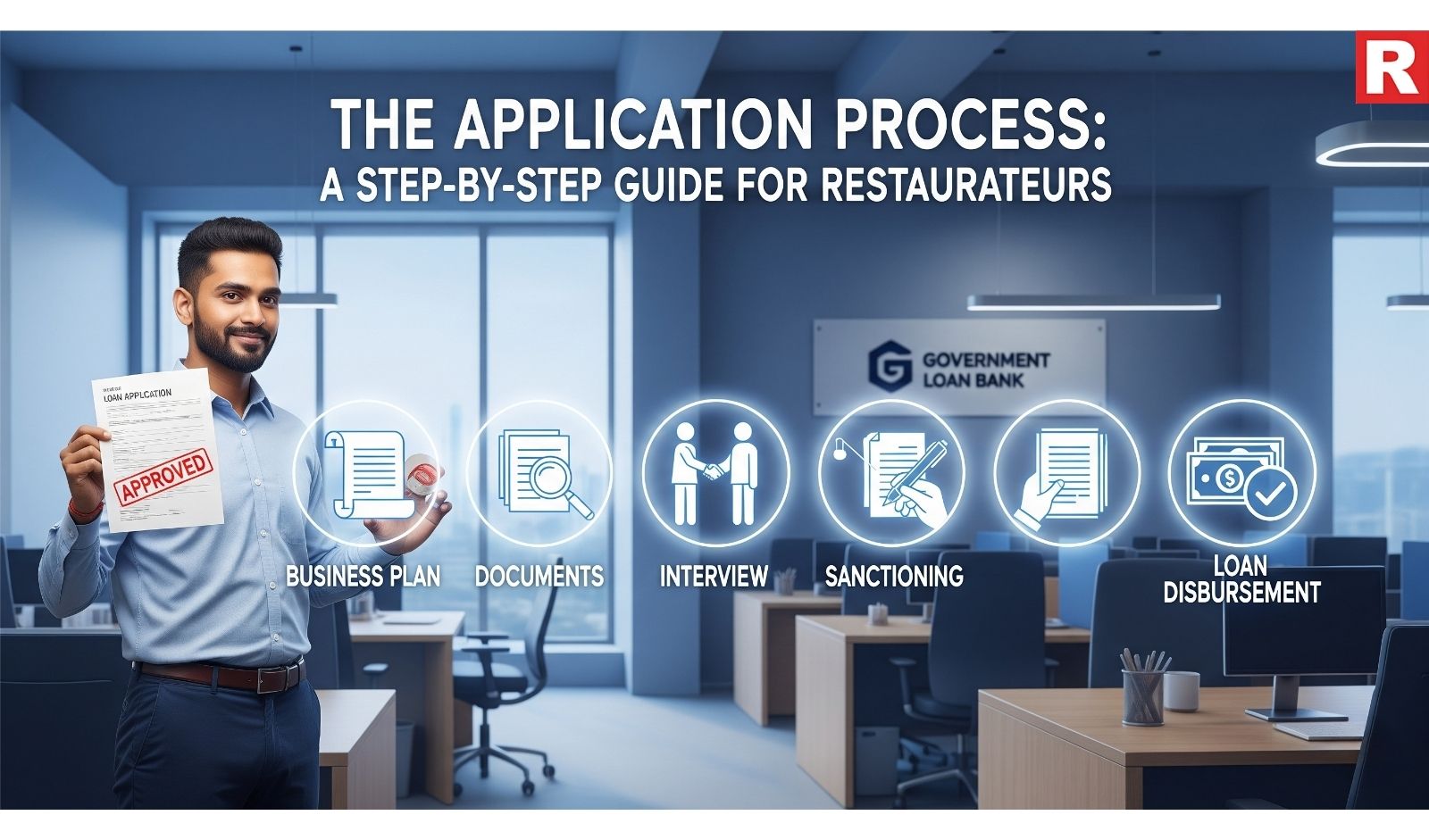
While the requirements may differ based on the plan and the lending group, here is an overall overview of the application process:
- Research and Select the Right Scheme: Carefully consider the eligibility criteria, loan amount, interest rates, and other parameters of several government programs to determine which one is most suited to your restaurant's needs and stage of development.
- Prepare a Comprehensive Business Tactic: A well-written business plan is essential. It should include information about your restaurant concept, target market, marketing strategy, operational plan, budget estimations (including revenue forecasts, cost analysis, and profitability), and the loan amount needed for the intended use.
- Gather the necessary documents: Prepare all necessary documentation, which usually includes:
- Application form (provided by the lending institution or online site)
- KYC paperwork (identification and address proof) for the applicant(s) and promoters
- Business registration evidence (if applicable)
- Partnership agreement or Memorandum and Articles of Association (if necessary)
- Business plans and project reports
- Financial statements (for an existing firm)
- Bank Statements
- Quotation for machinery or equipment (if appropriate)
- Caste certificate (if applying for schemes such as Stand-Up India)
4. Approach the lending institution: Visit the bank, NBFC, or government body that manages the scheme you've chosen. Please submit your application form and all supporting papers.
5. Scrutiny and Due Diligence: The financing institution will assess your application and perform thorough research, which may include site visits and verification of your documents and business plan.
6. Interview and Authorizing: You may be called for an interview to go over the business's strategy and financial projections. If the lender is satisfied, your loan will be approved. So keep yourself prepared for the interview process. You should know every minute detail of your business plan.
7. Payment: Once the loan is approved, funds will be transferred to your bank account following the scheme's terms and conditions.
Check out: Using Gaming to Boost Your Restaurant Business: How does it work?
Tips for Increasing Your Chances of Securing a Government Loan
- Have a Well-Structured Business Plan: A detailed and realistic business plan demonstrating your restaurant's long-term viability and profitability is essential.
- Maintain a Good Credit History: A good credit score boosts your reputation and improves your chances of loan acceptance.
- Offer Accurate Financial Information: Ensure that all financial information you offer is accurate and transparent.
- Highlight Your Restaurant's Unique Selling Point: Clearly define what distinguishes your restaurant and why it is likely to flourish in the market.
- Be prepared to answer questions: Prepare to address all questions from the lending institution concerning your business plan, financial projections, and management team.
- Follow Up Regularly: Stay in touch with the lending institution to monitor the status of your application.
Read this: Top 10 Essential Technology Systems for any Restaurant
Conclusion
A government loan can give the financial encouragement you need to start, expand, or modernize your restaurant business. Understanding the many programs available, carefully completing your application, and following the necessary processes will considerably boost your chances of receiving this vital financial assistance. With the appropriate capital and a good business strategy, you can serve up success and turn your culinary dreams into a tasty reality. Remember to stay up-to-date on the newest government efforts and seek advice from financial specialists to efficiently manage the process.
Copyright © 2009 - 2025 Restaurant India.






